Settings are used to set global system variables. These settings are applied on the entire system if not otherwise specified on a lower level.
For example: 'Settings: Voicemail: Send Attachment'='Yes' will set 'Set Attachment' for all local and remote extensions. But each extension can override this rule by setting 'Extensions: Edit: Advanced Options: Attach'='No'
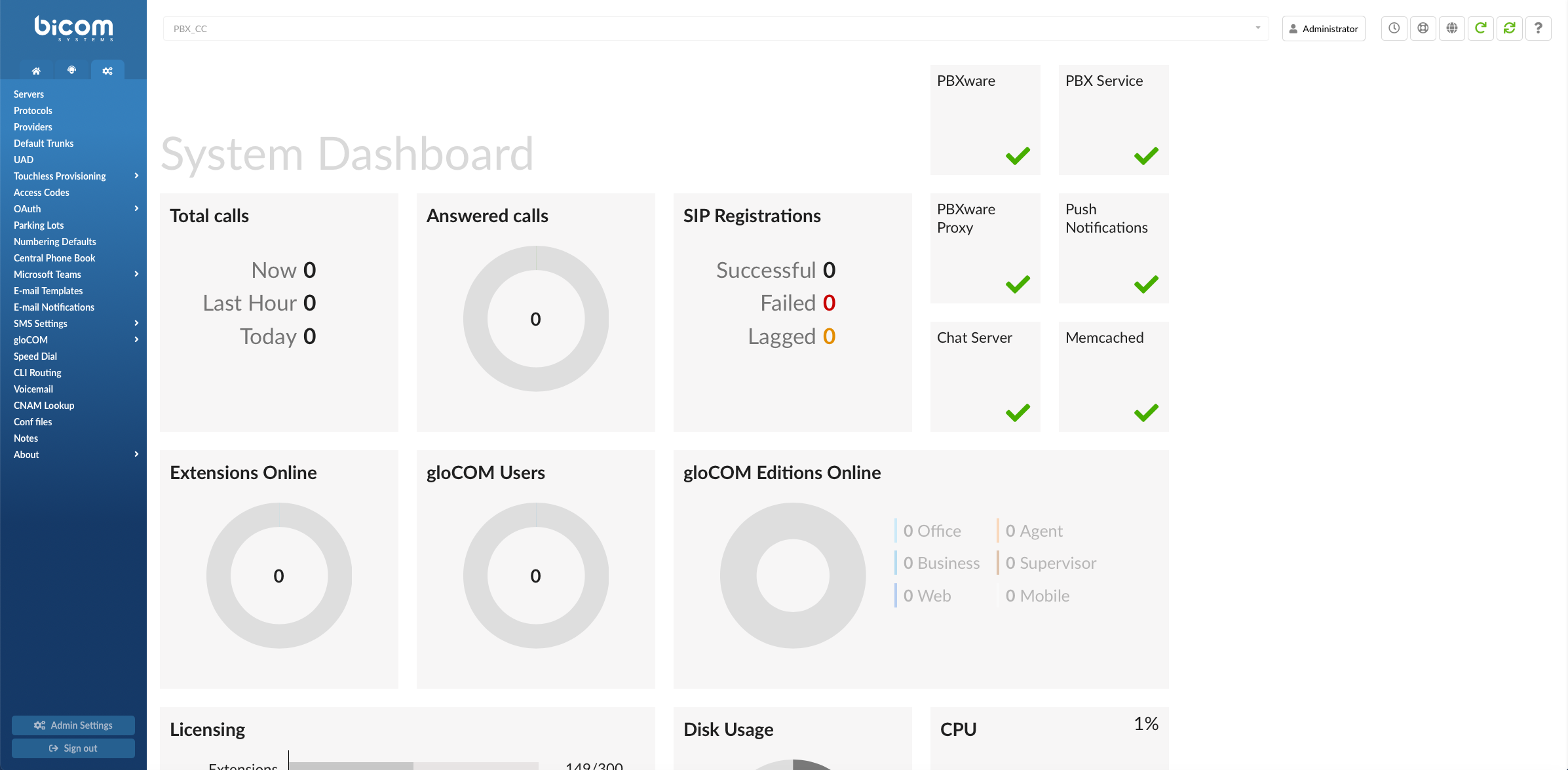
¶ Servers
The PBXware system administration allows for an unlimited number of servers to be administered from a single administration interface. The system servers can work in the following modes:
- Server Name:
Unique, custom set, server name on the network
(E.g. system@domain.com)
(Display)
- PBXware Address:
IP address that PBXware daemon is running on. As PBXware deamon will always be running on the same server this IP can't be changed and it is always 127.0.0.1
NOTE: The IP address 127.0.0.1 is a special purpose address reserved for use on each computer. 127.0.0.1 is conventionally a computer's loopback address.
Network software and utilities can use 127.0.0.1 to access a local computer's TCP/IP network resources. Messages sent to loopback IP addresses like 127.0.0.1 do not reach outside to the local area network (LAN) but instead are automatically re-routed by the computer's own network adapter back to the receiving end of the TCP/IP stack
 Edits the server configuration
Edits the server configuration
(E.g. Click to edit the server configuration)
(Button)
 Deletes a server from the system
Deletes a server from the system
(E.g. Click to delete a server from the system)
(Button)
¶ Server Edit
¶ Network Info
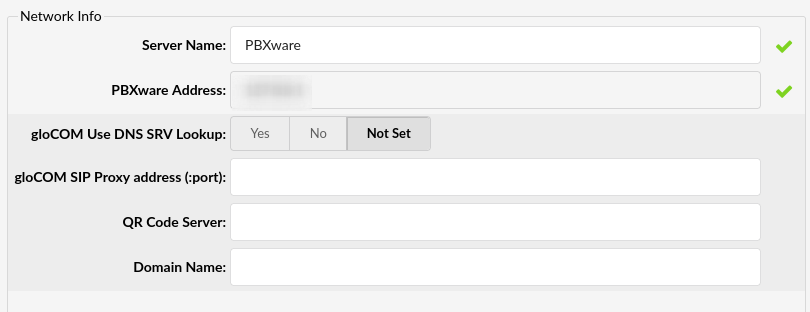
- Server Name:
Enter the custom server name (occasionally used in system notifications)
(E.g. domain.com)
([a-z][0-9])
- PBXware Address:
Enter the IP address that PBXware daemon is running on. As PBXware deamon will always be running on the same server, this IP can't be changed and it is always '127.0.0.1'
(value 127.0.0.1)
(Display)
- gloCOM Use DNS SRV Lookup
Select whether gloCOM will use DNS SRV Lookup or not
(E.g. Yes)
(Options button)
- gloCOM SIP Proxy address (:port):
Enter the Public IP address/domain of gloCOM SIP Proxy
(E.g. voip.domain.com or 192.168.1.59)
([a-z][0-9])
NOTE: In case users utilize SIP proxy for registration to PBXware, please set its address here and gloCOM will use value from this field for registration.
- QR Code Server:
Enter the public address of PBXware
(E.g. voip.domain.com or 192.168.1.59)
([a-z][0-9])
NOTE: In order to set up gloCOM Mobile with QR Code scanning, users have to enter the public address of their PBXware in this field, otherwise, the address information will not be inserted in the QR code and the mobile application will not know to what address it should register.
- Domain Name:
Provide the full domain name of this server
(E.g. voip.domain.com)
NOTE: Because several PBXware services require the Domain Name field to be populated in order to work, from PBXware v6.7.3 Domain Name field is mandatory. In case your PBXware only has an IP address, you can enter the IP address in the Domain Name field, but please note that some PBXware services will not work correctly, while others might not work at all.
¶ Auto Provisioning
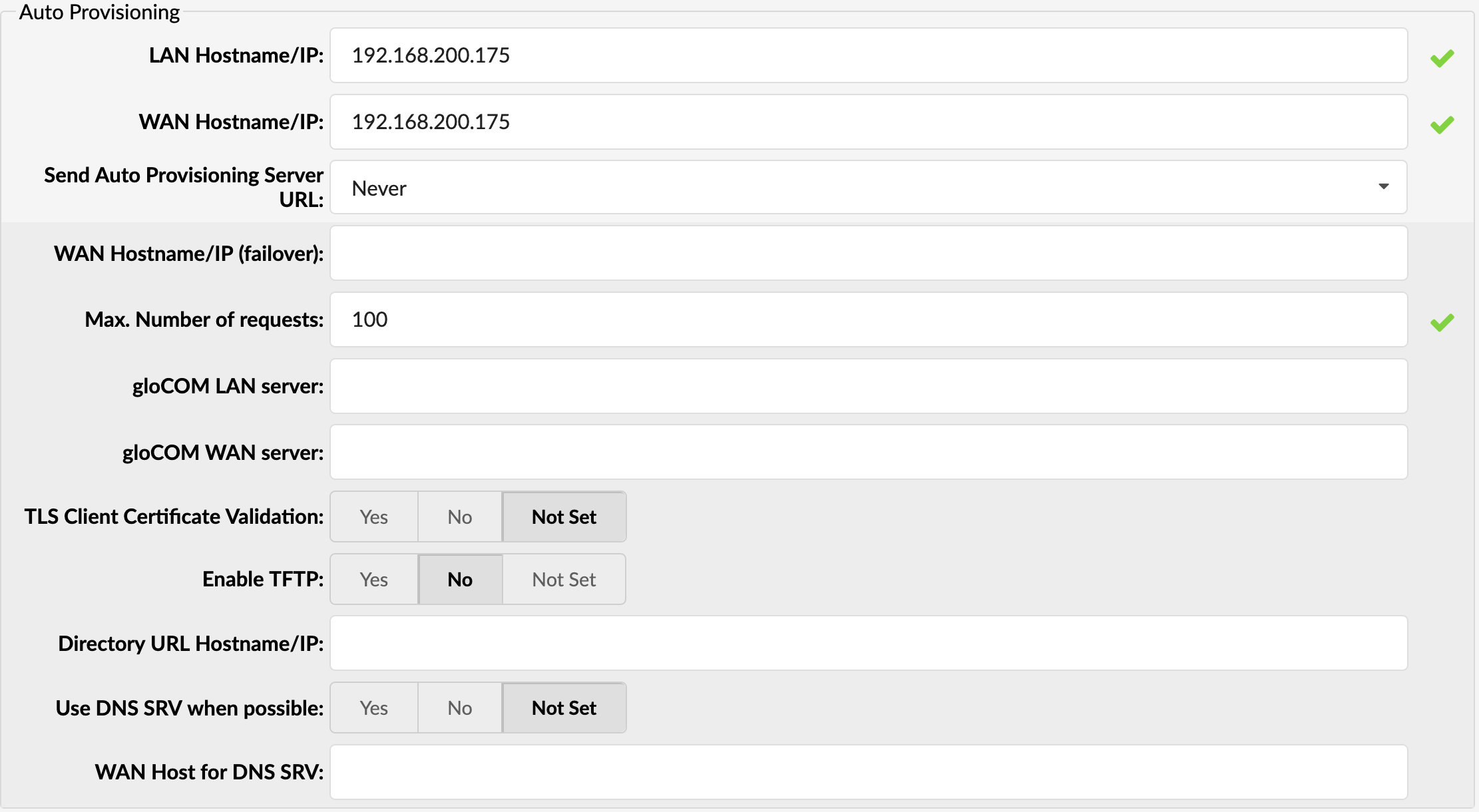
Auto-provisioning sets values to be used for the auto-provisioning system in order to create auto provisioning files correctly depending on the UAD locality (local/remote).
- HTTP username
Username for HTTP auto provisioning. Required for authentification of auto provisioning requests with the PBXware server.
- HTTP password
Password for HTTP auto provisioning. Required for authentification of auto provisioning requests with the PBXware server.
- LAN Hostname/IP:
Local area network IP address used to auto provision local UADs.
(E.g. 192.168.1.2)
(IP address)
- WAN Hostname/IP:
Wide area network IP address used to auto provision remote UADs.
(E.g. 192.168.1.2)
(IP address)
- WAN Hostname/IP (failover) (7.3)
This option allows you to configure a failover address for gloCOM applications, Yealink, and Polycom devices. If the primary server is not available, this address will be used, in which case the devices will connect to the failover server and continue normal operation.
NOTE: This option will only be applied to devices registering to extensions configured as Remote.
- Max. number of requests
The value presents the maximum number of requests for auto provisioning requests accepted by PBXware in a 1 minute period.
If the number of requests is larger than the number defined, the provisioning request IP address will be blocked for a period of 5 minutes.
The user will still be able to access the PBXware GUI.
(E.g. 100)
- gloCOM LAN server:
PBXware LAN IP address that users, connecting to PBXware from LAN, will use to register their gloCOM clients.
(E.g. voip.domain.com)
- gloCOM WAN server:
PBXware WAN IP address that users, connecting to PBXware from WAN, will use to register their gloCOM clients.
(E.g. voip.domain.com)
- TLS Client Certificate Validation
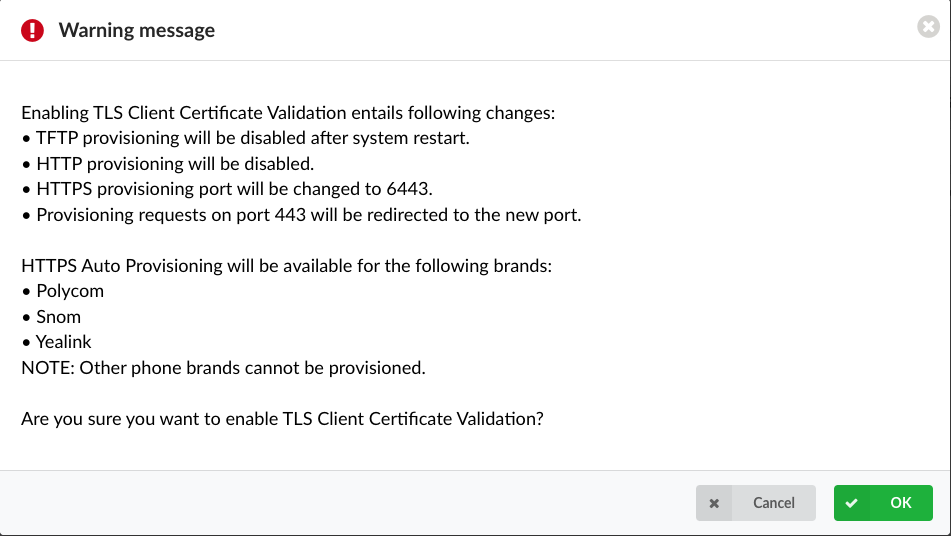
NOTE: Please note that this feature is part of the beta release and is only visible to beta testers. Once the stable version is released, it will be available for general use.
Enable TLS Client Certificate Validation
(E.g. Yes/No/Not Set)
(Option buttons)
NOTE: Please note that enabling TLS Client Certificate Validation entails the following changes:
- TFTP provisioning will be disabled after system restart.
- HTTP provisioning will be disabled.
- The HTTPS provisioning port will be changed to '6443'.
- The provisioning requests on the '443' port will be redirected to the new port, which is '6443'.
HTTPS Auto Provisioning will be available for the following brands:
- Polycom
- Snom
- Yealink
NOTE: Other phone brands cannot be provisioned.
- Enable TFTP:
TFTP service is disabled by default. To enable TFTP set this option to Yes and then start the service manually from the Services page.
(Option buttons)
- Directory URL Hostname/IP (7.3)
To customise the Directory URL Hostname/IP please enter the preferred hostname or IP address in this field. In earlier PBXware versions the Directory feature could only be hosted on the PBXware and this address was not customisable.
- Use DNS SRV when possible:
Whether phones should use DNS SRV records to find out SIP port from the DNS server, if the phone supports it.
(Option buttons)
- WAN Host for DNS SRV:
WAN IP address/domain for the DNS SRV host.
(E.g. dnssrv.domain.com)

System during its operations sends email notifications and alerts to various users and administrators. These emails can be sent using a built-in 'local mail server' or remote SMTP server.
- From E-mail:
Used to set the From: field in emails.
¶ Locality
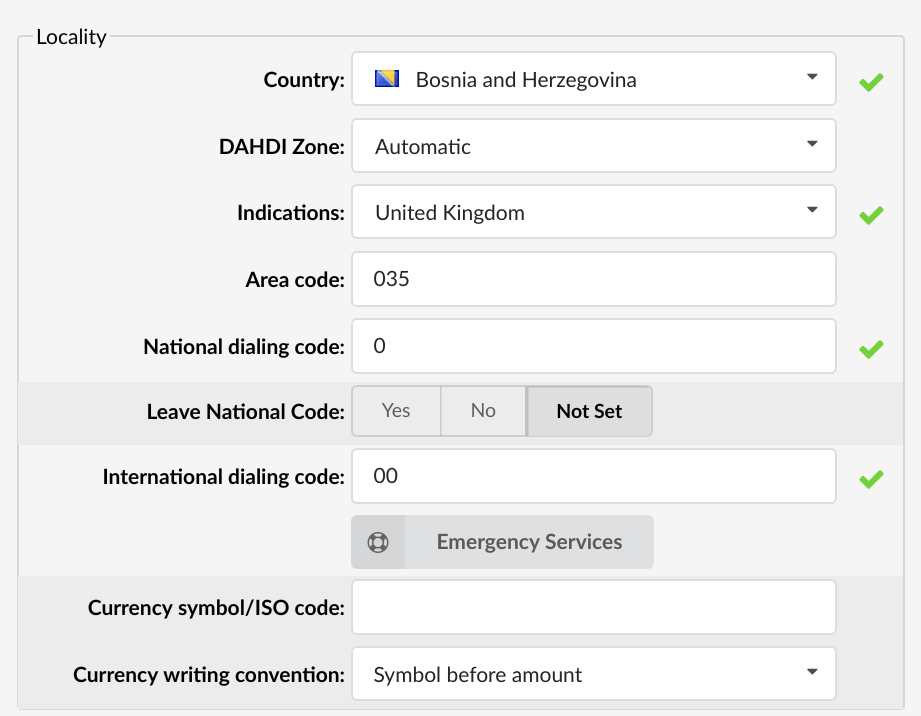
Locality sets where the system is operating.
- Country:
Country from which the server is operated.
(E.g. If PBXware is located in the USA, set USA here)
(Select box)
- DAHDI Zone:
Overrides Automatic Country Detection
It is recommended to keep this setting always set to 'Automatic'.
(Select box)
- Indications:
Which indications (Ringing, Busy, etc sounds) are to be used by the PBXware
(E.g. If the system is located in the USA, set USA here, otherwise select the closest country to yours)
(Select box)
- Area Code:
Area code that the system is located in or operating from.
(E.g. If the system is located in New York, set the New York area code here (212)).
([0-9])
- National Dialing Code:
Code needed for dialing national destinations.
(E.g. 1 for USA, 0 for United Kingdom and Germany)
([0-9])
- Leave National Code:
In some countries, the national code is stripped automatically. If set to 'Yes', the national code will not be stripped from the dialed number.
(E.g. 035123456 will not be striped of 0)
(Option buttons)
- International Dialing Code:
Code needed for dialing international destinations
(E.g. 011 for USA, 00 for United Kingdom and Germany)
(Option buttons)
- Currency symbol/ISO code:
Country's currency symbol where the server is located in
E.g. ( $ for USA)
- Currency writing convention:
- Symbol before amount - The currency symbol will be shown before the amount.
- Symbol after amount - The currency symbol will be shown after the amount.
- Prefix
Value added to all dialed numbers going over the trunk.
(E.g. Prefix 5 + Dialed number 123 = System dials 5123)
- Set Prefix for Emergency Calls (7.1)
With Yes selected, the Prefix field entry will be applied to emergency calls as well, as by default, this will not be the case. With No or N/A selected, the prefix should not be used for calls to emergency service numbers.
NOTE: Calls to Special Routes numbers set as Emergency will have Prefix applied to them without Set Prefix for Emergency Calls option set to Yes.
- Dialed number minimum length (6.6.1)
Set a minimum number of digits dialed for a call to leave the system
The value has to be greater than 0 for this to have an effect. The dialed number minimum length set on a Trunk has priority over the Dialed number minimum length set on the system.
The dialed number length will be matched just before dialing through the trunk. The length will also include all the required prefixes and codes that are added to the dialed string.
Ex. If a user dials number 70, the national and international codes will be added to the number and we get 00170. The dialed number length is then 5 and that number will be matched to the option value.
¶ Emergency Services
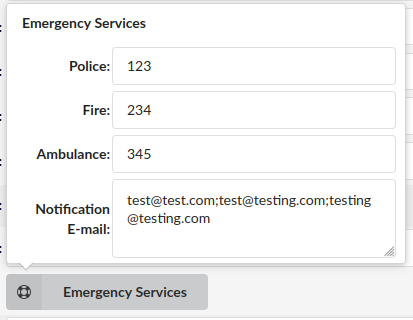
Upon clicking the 'Emergency Services' button, a pop-up window will appear where users can enter 'Police', 'Fire', and 'Ambulance' emergency numbers.
- Notification E-mail:
After dialing one of the emergency numbers, an e-mail will be sent to the address provided in this field. Users can enter one or multiple e-mail addresses depending on their preferences and needs.
If adding multiple addresses, they can be separated by using a new line or semicolon ';'.
NOTE: If the e-mail field is left empty, no e-mail will be sent.
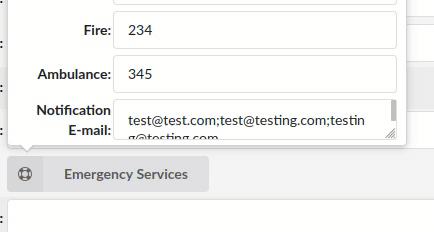
The box is resizable, which makes the usage more convenient.
For more information, please refer to the screenshots.
¶ Numbering Defaults
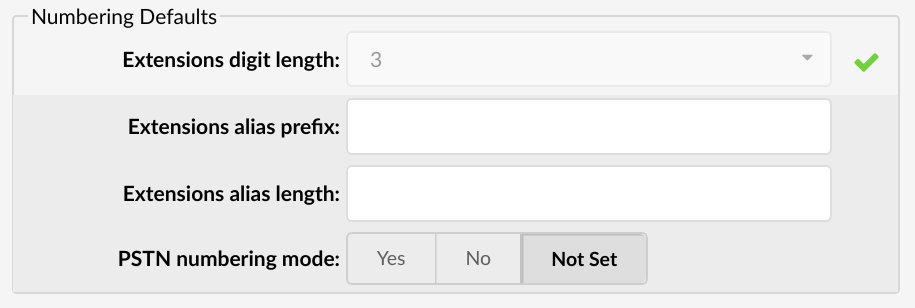
Numbering default is set during the initial system set up in order to set how many digits the system will use as default. You can select any value between 2 and 16.
- Extensions digit length:
Number of digits used by the system to create local extensions, IVRs, Queues, Voicemail boxes, Conferences, etc. This option is available for settings only during the setup wizard install process. In order to change the number of digits after the setup wizard, you will have to remove all the Extensions, Ring Groups, DIDs, Conferences, IVRs and Voicemail boxes. The recommended value for this field is 4.
(Select box)
- Extensions alias prefix:
Digit assigned before the dialed number on systems that have switched from 3 to 4 digit extensions, for example
(E.g. If your old system has used 3 digits and you wish to switch to 4, for example, set '1' here to assign '1' as a prefix to all system extensions. This way, the old 300 extension becomes 1300).
([0-9])
- Extensions alias length:
Length of the old numbering system.
(E.g. If your old system used 3 digits type 3 here)
([0-9])
- PSTN numbering mode:
If this option is turned on, when a number is dialed there is no need for DID, the system calls that extension automatically.
(Option buttons)
¶ LDAP
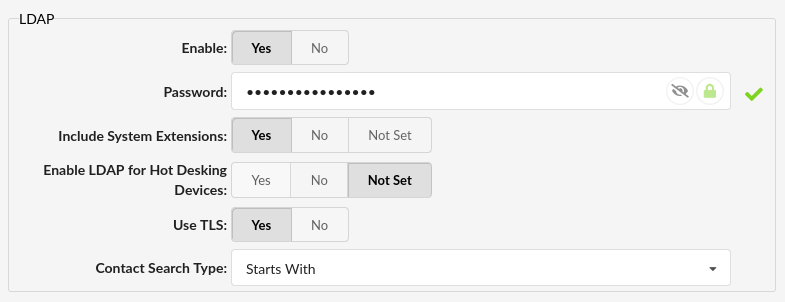
If enabled, instead of the system extensions, the auto provisioned phones will be served the Central Phone Book contacts. Currently, this feature is applied only on Yealink, Polycom and Cisco phones. Phones from other manufacturers will ignore this option and will use the directory as before.
- Enable:
Enables/Disables the LDAP Central Phone Book feature.
- Password:
Password sent to the phones with the auto provisioning configuratio and is used to authenticate the phone with the PBXware when searching/fetching contacts.
- Include system extensions:
By default, when LDAP is enabled, the phones are server only the contacts defined in the Central Phone Book. If this option is set to Yes then the contact list will include System extensions as well.
- Enable LDAP for Hot Desking Devices:
By enabling this option, LDAP will be available on Hot Desking devices as well. If an extension is not logged in yet, the directory will display contacts configured in the tenant’s Central Phone Book.
- Use TLS:
If 'Use TLS' is set to 'Yes', the TLS port for LDAP will be sent instead of the TCP port when sending provisioning info to UADs.
Note: The “Use TLS” feature is currently supported for Yealink, Polycom, and Grandstream phones only.
- Contact Search Type:
The Contact Search Type dropdown provides users with the ability to customize how contacts are searched within the directory with two options:
Starts with
This option filters results to show only contacts whose names or phone numbers begin with the entered search criteria.
Contains
This option allows for a broader search, returning contacts that contain the search term anywhere within their information. It is especially useful for users who may not recall the full name or exact starting point of the contact, offering more inclusive results based on partial matches.
¶ STIR/SHAKEN
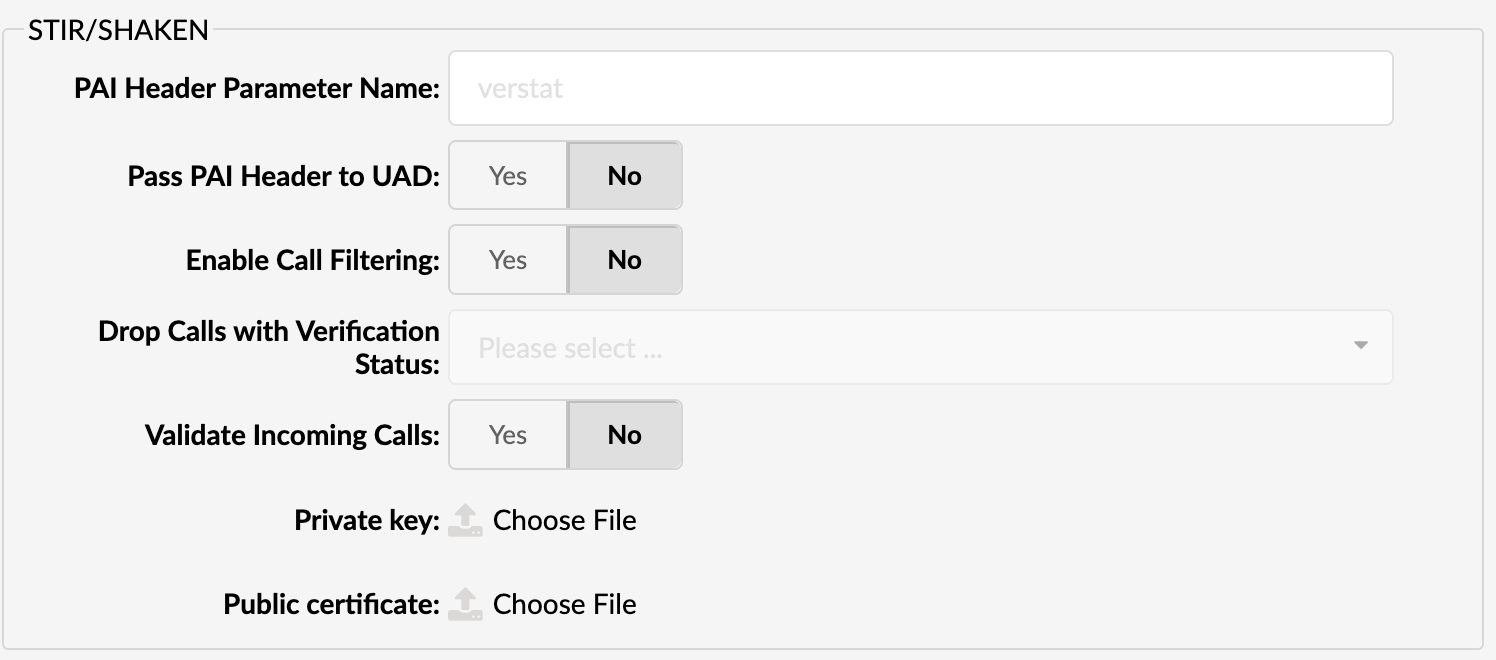
This will only work for calls from Trunks.
- PAI Header Parameter Name
Set this field to a desired value
(E.g. 'verstat')
([a-z][0-9])
NOTE: This parameter is parsed for the caller ID validation and it is generally named 'verstat'. Other variations depend on the Trunk provider.
- Pass PAI Header to UAD
Set this option to 'Yes' in order for Polycom phones to perform STIR/SHAKEN Caller ID Validation
(E.g. Yes/No)
(Options button)
- Enable Call Filtering
Enable PBXware STIR/SHAKEN Call Filtering
(E.g. Yes/No)
(Options button)
- Drop Calls with Verification status
Select for which verification status calls will be dropped
(E.g. 'TN-Validation-Failed')
(Select box)
Additional Information:
Example: "P-Asserted-Identity: <sip:+1234567890;verstat=TN-Validation-Passed@xx.xxx.x.xxx:xxxx>
P-Attestation-Indicator: B"
Please note that the additional header check is added for STIR/SHAKEN. 'P-Asserted-Identity' can have one of the following values: 'TN-Validation-Passed', 'TN-Validation-Failed', or 'No-TN-Validation', while the level can be seen in a new header, for example: 'P-Attestation-Indicator: B'.
In case a user selects 'TN-Validation-Failed-B' and 'No-TN-Validation' as values for 'Drop Calls with Verification Status', the call will be dropped as it matches 'TN-Validation-Passed' plus 'B'.
However, if there is no indicator provided, an exact match of the verstat value in the PAI header and the value specified in the 'Drop Calls with Verification Status' field is expected: "P-Asserted-Identity: <sip:+1234567890;verstat=TN-Validation-Passed-B@xx.xxx.x.xxx:xxxx>".
NOTE: Please note that this feature is part of the beta release and is only visible to beta testers. Once the stable version is released, it will be available for general use.
STIR/SHAKEN is a framework that helps reduce fraudulent robocalls and illegal phone number spoofing. STIR/SHAKEN is implemented in PBXware to be in compliance with the FCC STIR/SHAKEN rules. PBXware added its implementation of STIR/SHAKEN which allows signing and validating calls with valid STIR/SHAKEN certificates that customers own.
Please note that we do not provide any certificates.
- Validate Incoming Calls
Select whether incoming calls will be validated or not
(E.g. If set to 'Yes', the Identity header will be checked for incoming calls, and STIR/SHAKEN validation will be done. If the Identity header is not present or is invalid, the call will be dropped.)
The default value is 'No'.
- Public Certificate
Upload the public certificate
(Button)
- Private Key
Upload the private key
(Button)
¶ Dispatchable Location Setup (7.1)

- Send Location
When this option is set to Yes, PBXware will attach the previously verified location information to the SIP INVITE whenever calls to emergency services numbers are made. Added information will help first responders get the necessary information about the caller’s location, even in a situation where the caller is prevented from providing the address.
If No is selected, location information will not be added to the SIP INVITE.
NOTE: This option is developed to meet the legal demands in the United States and will not work in the other regions because trunk providers will not check the location-related information attached to SIP INVITE.
- Default Deskphone Location
If a company has a main office location most deskphones are connecting from, the office address can be assigned as the default address for all the deskphones on the system.
For deskphones connecting from different locations, Deskphone Users Configuration, located in the Dispatchable Locations section, can be used to assign MAC addresses of devices to a specific location.
¶ Authentication
2FA Expiry Time (7.1)
To configure a 2-factor authentication expiry time for the extension, an administrator can use this option to select the period, after which the user will have to repeat the 2FA process to be able to log in to their gloCOM app and OSC portal.
Settings available in the drop-down selection list are 1 day, 3 days, 1 week, 1 month, and 3 months but if 2FA Expiry Time is not configured, the default period of 7 days will be used.
NOTE: When 2FA Expiry Time is configured on the extension level, that selection will have priority over the tenant-level settings.
2FA Max Inactivity Time (7.1)
This option allows you to set the maximum inactivity time frame which would reset user’s 2FA in case user does not log in to gloCOM app for period longer than what is configured here.
Available options are: 1 Month, 3 Months, 6 Months, 9 Months and 1 Year.
Enforce SSO Auth (7.5)
If the server is forced to use Single Sign-On, the individual extensions will not have the SSO Enable option because SSO is configured on the server level.
By default, it is set to 'No'.

SSO Token Expiry Time
This is where the Single Sign-On token expiration is set. Expiration time can be set from one (1) up to three (3) months.
¶ General Settings
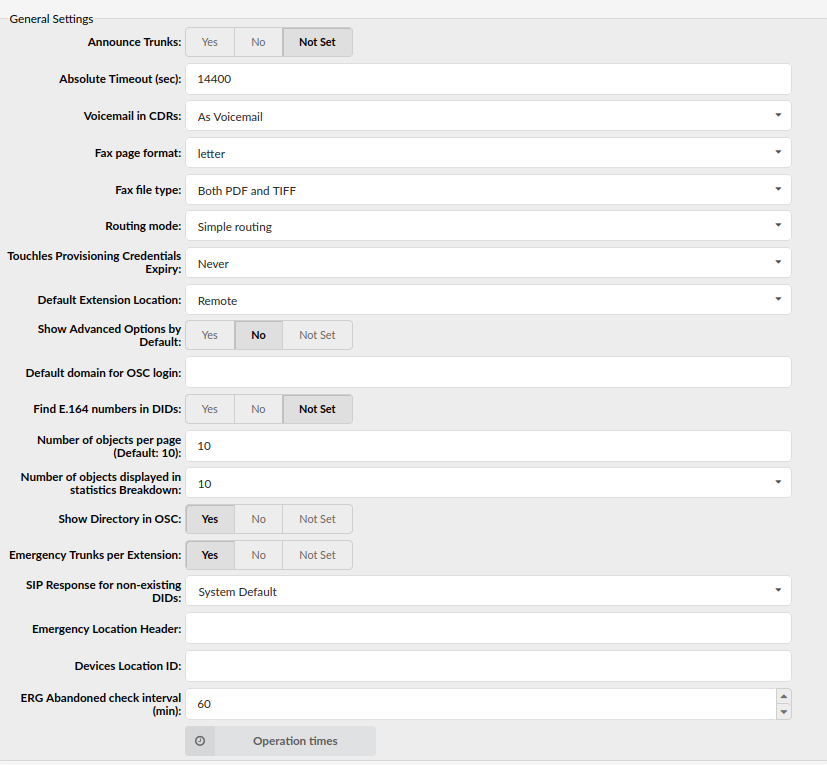
- Announce Trunks
Set whether to announce over which Trunk the call goes
(E.g. John dials '55510205' and this call goes over the secondary default system Trunk. John will hear the following message: "Using the secondary Trunk to terminate your call.")
(Option buttons)
NOTE: This announcement will not be played if the primary Trunk is working fine. It will be used only in case the primary (or secondary) Trunk is not working so the system needs to use secondary (or tertiary).
- Absolute Timeout (sec)
Set the maximum time in seconds that a call can last
(E.g. If '3600' is set in this field, all calls will end after one hour.) [1 hour = 3600 seconds]
([0-9])
- Voicemail in CDRs

Set how the unanswered calls and the ones which were redirected to voicemail are displayed in the CDR
(E.g. 'As Voicemail')
(Select box)
The options are as follows:
- As Answered calls: When a call gets redirected to voicemail, it will show as "Answered" in the CDR.
- As Not Answered calls: When a call gets redirected to voicemail, it will show as "Not Answered" in the CDR.
- As Voicemail: When a call gets redirected to Voicemail, it will be shown as "Voicemail" in the CDR.
NOTE: The default value is "As Answered calls".
- Fax page format
Select the page format when downloading fax as a PDF
(E.g. 'letter')
(Select box)
The options are as follows:
- letter
- legal
- A4
- Auto
NOTE: The default value is "letter".
- Fax file type
Select the type of file used when downloading
(E.g. 'Only PDF')
(Select box)
The options are as follows:
- Both PDF and TIFF
- Only PDF
- Only Tiff
NOTE: The default value is "Both PDF and TIFF".
- Routing mode
Select what type of routing mode will be used for Routes
(E.g. 'Simple routing')
(Select box)
The options are as follows:
E.164 routing: Defines the routing mode where routes are set using the E.164 numbering rules
Simple routing: Defines the routing mode where users set routes manually to fit their needs
- Touchless Provisioning Credentials Expiry (6.6.1)
Set a time period in hours or days after which the touchless provisioning credentials will expire
(E.g. If the user sets TLP Credentials Expiry to '1 hour', this means that after the Registration request is sent, the user has one hour to reset the device to factory settings and pick up the configuration.)
- Default Extension Location
Select whether the default Extension location will be 'Remote' or 'Local'. Once selected, it applies to the whole system when creating new Extensions.
(E.g. 'Local')
(Select box)
NOTE: The default value is 'Local'.
- Show Advanced Options by Default
Set whether to show 'Advanced Options' by default
(E.g. If set to Yes, all pages that have advanced options will display them automatically; without having to click the button on every page.)
(Option buttons)
- Default domain for OSC login
Set the default domain used for Online Self Care (OSC) login
(E.g. http://pbx.domain.com/)
([a-z][0-9])
- Find E.164 numbers in DIDs
Enable or disable the E.164 matching of numbers like set in the E.164 fields in DIDs
(Option buttons)
- Force-E.164 CallerID (7.1)
When this option is set to Yes, PBXware will try to ensure that the Caller ID used for outbound calls is in E.164 format.
If the extension tries to make an outbound call with the Caller ID that is not in full E.164 format, the system will first check the entry for the trunk’s Outbound Caller ID.
If no Caller ID in E.164 format is detected on any of these locations, the system will not drop the call and the original Caller ID in non-E.164 format will be used, although this might result in the call being dropped by the trunk provider.
- Number of objects per page (Default 10):
Set the number of objects displayed per page
(E.g. If a user sets this value to '20', they will see the maximum of 20 Extensions on the Extensions page, 20 CDR entries on one page, and so on.)
([0-9])
- Number of objects displayed in statistics Breakdown
Set the number of objects that will be displayed in statistics Breakdown [IVR, Agent, Queue, and Dialer statistics]
(E.g. If users set this value to '50', this number of objects will be displayed in statistics Breakdown.)
(Select box)
NOTE: The default number is 10.
- Show Directory in OSC:
Set whether to show Directory in Online Self Care (OSC)
(E.g. Extensions visible in Directory will be the ones that have the 'Show in Directory' option set to Yes.)
(Option buttons)
- Emergency Trunks per Extension:
If the 'Show Directory in OSC' option is set to Yes, then under Extensions page, users will see a new group called 'Emergency Trunks'. These Trunks will override the Trunks set on the main Trunks page.
(E.g. 'Yes')
(Option buttons)
- SIP Response for non-existing DIDs
Select which SIP response will be sent to a provider if a DID that was called does not exist on the system
(E.g. System Default)
(Select box)
The following options are as follows:
- System Default
- 403 - Call Rejected
- 404 - Not Found
- 408 - Request Timeout
- 410 - Gone
- 480 - Temporarily Unavailable
- 484 - Address Incomplete
- 486 - Busy Here
- 488 - Not Acceptable Here
- 500 - Internal Server Error
- 501 - Not Implemented
- 502 - Bad Gateway
- 503 - Not Implemented
NOTE: Please note that if 'System Default' is chosen, PBXware will behave as if this option was never set. Additionally, the option set on 'Trunk' overrides the option set on 'Servers' if something else but 'System Default' is chosen. In case 'System Default' is set on 'Trunk', the option set on 'Servers' is applied.
- Emergency Location Header
Set an emergency location header
(E.g. Geolocation)
NOTE: When set on the Master Tenant, then that header name will be used in case there is no header name provided for the Tenant level. The option on the Master Tenant can be used to set a header name globally for the whole system. If the emergency location header is not set on the Trunk or Tenant level, then no location header will be sent.
- Devices Location ID
Set a device's Location ID that is provided by the Trunk providers by provisioning the E911 endpoint. The process of provisioning E911 endpoints is different for each provider.
([a-z][0-9])
NOTE: To get the location IDs, please contact your provider and refer to their documentation.
- Default Call Forwarding Timeout
This option allows you to change the default call forwarding timeout from 30 seconds to a different value, when enabling Call Forwarding using access code *71+[CF-Destination-Number]
For example, with the Call forwarding timeout set to 45 seconds, when call forwarding is activated using the access code *71 1001, to turn on call forwarding to extension 1001, call forwarding timeout of 45 seconds will be in effect.
You can override Default Call Forwarding Timeout by enabling call forwarding using *71+ [CF-Destination-Number] *60 (I.e. *71 1001 *60), which would forward the calls from your extension to extension 1001, with a preferred call forwarding timeout of 60 seconds.
- ERG Abandoned check interval (min) (6.6.1)
Enter the check interval in minutes after which the mail will be sent to all defined notification e-mails containing information about abandoned calls.
The default value is 60 minutes.
- Operation Times:
Clicking this button will open a page where users can configure the system's operation times.
¶ Operation Times
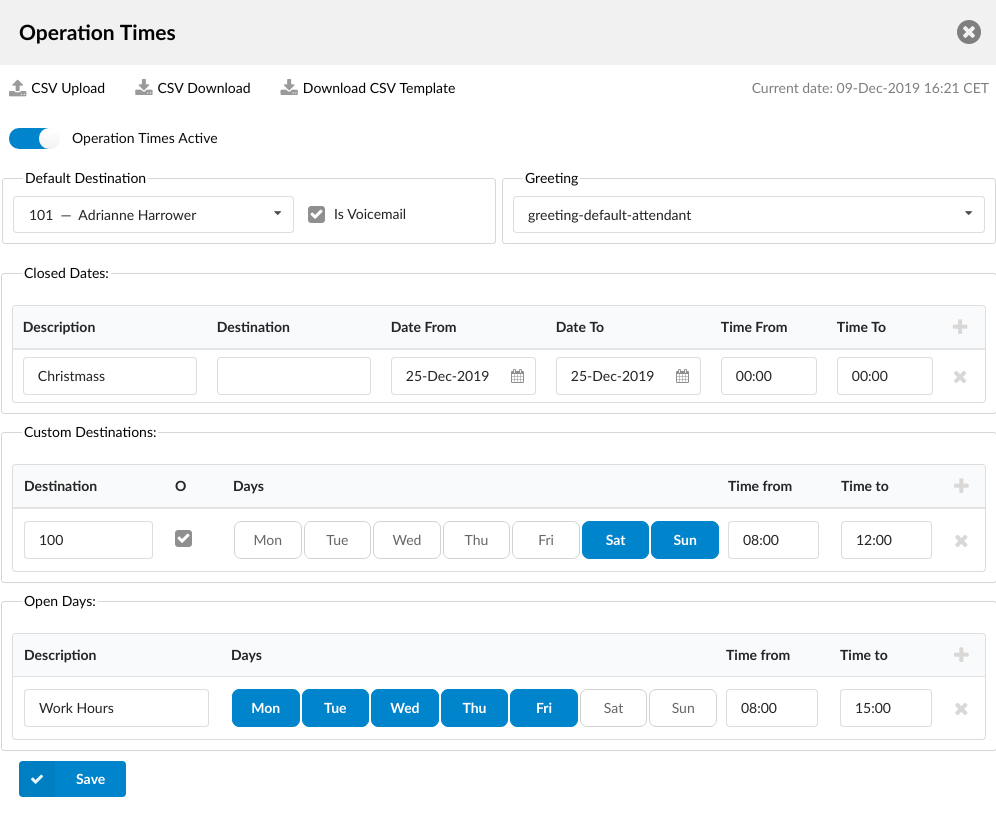
Set the system open/closed times. Depending on the time when the call is received, the call can be redirected to different destinations.
- CSV Upload
Click on this button to upload Operation Times configuration from a csv file.
To see which fields need to be set download the CSV template by clicking on the "Download CSV Template" button.
(Button)
- CSV Download
Click on this button to download Operation Times configuration as a csv file.
(Button)
- Download CSV Template
Download CSV Template button will present you with a file that already contains necessary headers which should help you create the CSV file easier.
(Button)
- Enable operation times
Operation Times Active
If Enabled, then Operation Times rules will be applied on the system level.
If Disabled, then system level Operation Times rules will not be applied and the calls will be going through, if not defined otherwise.
(Checkbox)
- Default Destination
PBXware extension to which all calls are redirected during the closed time hours.
(E.g. 1000)
([0-9])
- Is Voicemail
Choose if the call for the Default Destination should go to the voicemail or not.
(Checkbox)
- Greeting:
Greeting sound file played to callers during the closed times.
(E.g. greeting-***)
(Select box)
- Closed Dates
Sets the specific date/s when all calls are redirected to the 'Default Destination'. If the 'Destination' field in the Closed dates is set, calls will go to the set destination instead of the default one.
- Custom Destinations
Redirects all calls received during set days/hours (E.g. weekend) to the extension provided as destination.
- Open dates:
Sets the system's working hours. If any call is received during the hours not set here the call is redirected to 'Default Destination'.
Note: Operation Times rules priority is the same as seen in the GUI. First, the Closed Dates section will be checked. If for the current time a rule from this section can be applied, then that rule will be used and other sections will not be checked. If no rules can be applied then the Custom Destinations section is checked. If no rules can be applied here either then the Open Days section will be checked as the last one. If a rule in Open Days can be applied then the system is in open hours and the call will go through, otherwise, the call will go to the Default Destination.
¶ Call Recordings
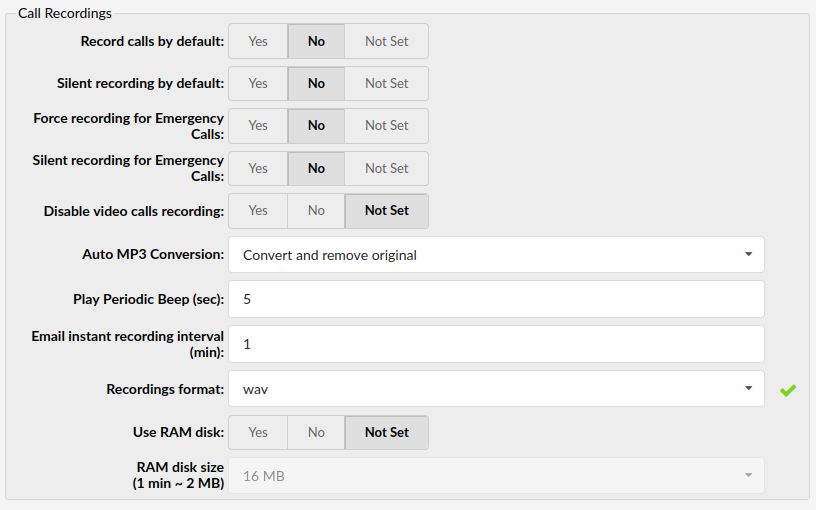
- Record calls by default:
Set this option to 'Yes' and enable call recordings on the system level
(Option buttons)
NOTE: This option will be used in case it is not set on Extensions.
- Silent recording by default:
Enable silent recording by default
(Option buttons)
NOTE: This option will be used in case it is not set on Extensions.
NOTE: If 'Record calls by default' is set to 'Yes' and 'Silent recording by default' set to 'No', then the "Recorded" message will be played to users before the call is connected informing them that the call is being recorded. Also, a beep sound will be played in intervals to notify that the call is being recorded. If set to 'Yes' or 'Not Set', no message will be played and the beep sound will not be heard.
- Force recording for Emergency Calls:
If set to 'Yes' recording will be forced for emergency calls.
(Option buttons)
- Silent recording for Emergency Calls:
If set to 'Yes', recordings on emergency calls will be silent (no sound, no beep denoting that a call is being recorded).
(Option buttons)
- Transmit silence during recording (6.7.1)
When set to Yes, this will transmit silence to the caller in cases where there is no other audio sources. This includes call recording, voicemail, and the Wait() family of dialplan applications, among other things. This might help to prevent call drops by the remote end when no RTP is being sent.
The default setting for this option is no.
- Disable video calls recording (6.6)
If set to 'Yes', large and unnecessary files will not be created when a video phone leaves a voicemail message
(Option buttons)
- Auto MP3 Conversion:
Convert recording files to mp3. This will apply to system-wide recordings.
- Convert and remove original
Convert all recording files to MP3 and delete original files.
- Convert and keep original
Convert all files to MP3 and keep original files.
- Convert on Listen/Download
Recordings are left in their original format and only converted to mp3 when requested for listening/download, leaving behind both the original and the mp3 version of the recording after listen/download.
- Do not convert
Will leave files in the original format without conversion. (recordings can't be played from GUI).
(Select box)
- Play Periodic Beep (sec):
Interval of the beep sound when the recording is not silent. If empty or set to 0 then no beep sound will be played.
(E.g. If this field is set to 5 then while a call is being recorded every 5 seconds a beep sound will be heard)
([0-9])
- Email instant recording interval (min):
Instant recordings are not e-mailed immediately after they are recorded, but rather periodically. This field will set how often PBXware will send recordings out.
(E.g. 3)
([0-9])
- Recordings format:
Format used for saving the system call and voicemail recordings. You can read more details about disk space usage at the bottom of this chapter
Choose one of the following formats: gsm, wav, wav49, or ogg. If wav is selected, all call recordings and voicemail recordings will be saved in wav format).
(Select box)
- Use RAM disk:
To speed up the process of recording, you can turn on the RAM disk which practically records all calls to RAM memory before storing them on the disk
(Option buttons)
- RAM disk size:
Amount of memory used for call recording. This value can only be changed if "Use RAM disk" is set to "Yes".
(Select box)
TIP
Disk Space Used By Call Recording:
With continuous tone for 60 seconds:
- wav49 = 84.5kb
- wav = 833.0kb
- gsm = 85.0kb
With continuous silent tone (without sound) for 60 seconds:
- wav49 = 84.0kb
- wav = 827.0kb
- gsm = 84.0kb
TIP
Disk Space Used By Voicemail Recording
With continuous tone for 60 seconds:
- wav49 = 91.0kb
- wav = 863.0kb
- gsm = 91.0kb
With continuous silent tone (without sound) for 60 sec:
- wav49 = 0.38kb
- wav = 3.0kb
- gsm = 0.32kb
¶ Administration
This section enables remote administration of the system.

- Daemon username:
Username which PBXware uses to connect to Asterisk Manager.
(E.g. admin)
([a-z][0-9])
- Daemon password:
Password which PBXware use to connect to Asterisk Manager. The password is randomly generated during installation and can not be changed.
(E.g.GTaXfgtR)
([a-z][0-9])
- Port:
PBXware daemon connection port.
Default value 10001)
([0-9])
- AGI Port:
Agi connection port.
(E.g. 4573)
([0-9])
- Asterisk HTTP Session Limit:
The default session limit is 1024, but it can be configured manually. Any value entered in this field will be automatically written and applied to the HTTP configuration file.
- Allow LDAP username:
This tells PBXware to accept registrations from gloCOM when it is using a Windows® username for this.
(Option buttons)
¶ Localization

- Audio Language:
Sets the language in which the sound files are played.
(E.g. en)
¶ Enhanced Call Parking

While on an active user can dial ‘#800’. The call will be parked and the ‘Announce Extension’ will ring for a set number of seconds.
- Timeout (sec):
Extension which will receive a call from PBXware and will be notified on which parking lot the call is being parked. If this extension doesn’t pick up a call after a timeout, the call will be directed to Timeout extension.
(E.g. 5)
([0-9])
- Announce Extension:
Extension which will receive a call from PBXware and will be notified on which parking lot the call is being parked. If this extension doesn’t pick up a call after a timeout, the call will be directed to Timeout extension.
(E.g. 1001)
NOTE: From version 6.7.1 Announce Extension field will work as a drop-down selection and an input field. This will allow you to select extensions (SIP, IAX, custom), Ring Groups, and Enhanced Ring Groups from the drop-down list. Although only Extensions, Ring Groups, and Enhanced Ring Groups will be on the list, you can still manually enter other destination numbers, for example, IVR. Still, entry will be limited to a number of digits selected for extension numbers.
If a number of digits exceed the number of digits set for extension, a warning message will appear, and the input field will revert to the previous value. Shorter values will be accepted.
- Timeout Extension:
Destination where the call will be directed if the call is not answered after parking timeout.
(E.g. 1002)
NOTE: From version 6.7.1 Timeout Extension field will work as a drop-down selection and an input field. This will allow you to select extensions (SIP, IAX, custom), Ring Groups, and Enhanced Ring Groups from the drop-down list. Although only Extensions, Ring Groups, and Enhanced Ring Groups will be on the list, you can still manually enter other destination numbers, for example, IVR. Still, entry will be limited to a number of digits selected for extension numbers.
If a number of digits exceed the number of digits set for extension, a warning message will appear, and the input field will revert to the previous value. Shorter values will be accepted.
¶ Extensions channel limit notification

Extensions channel limit notification
Here you can set whether there will be any notification when users exceed their outgoing limits on calls. These options apply to all extensions.
- Play Sound:
This option tells the system to play a notification sound when any extension exceeds its outgoing call limit.
(Option buttons)
- Send E-mail:
Whether or not to send a notification mail when exceeding the limit.
(Option button)
- Notification e-mail:
E-mail address to which notification mail should be sent to if the number of calls exceeds the limit.
(E.g. user@domain.com)
([a-z][0-9] @)
¶ Channels
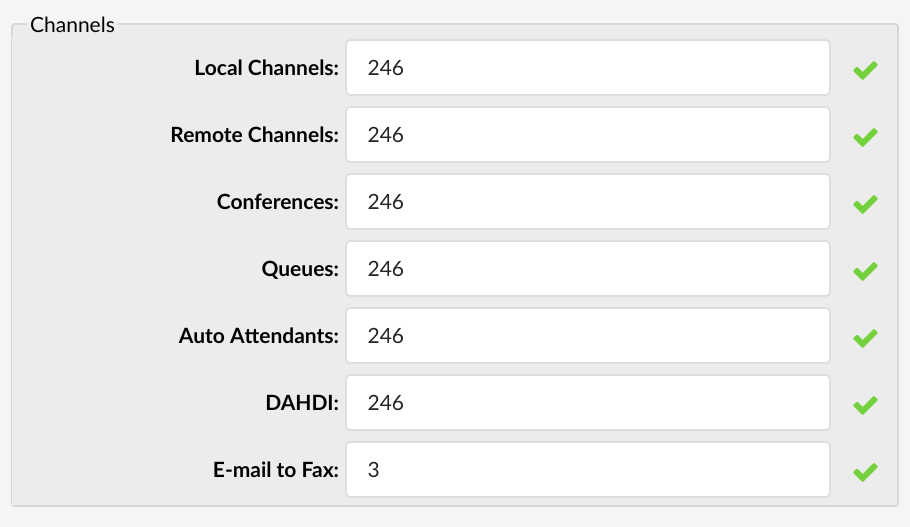
Depending on the CPU power of the server, a custom limit for channels can be assigned for various channel types.
- Local Channels:
Total number of all channels used by local UADs
(E.g. 12)
([0-9])
- Remote Channels:
Maximum number of active inbound or outbound channels for the server.
(E.g. 12)
([0-9])
- Conferences:
Total number of all system conferences.
(E.g. 8)
([0-9])
- Queues:
Total number of all system ACD queues.
(E.g. 8)
([0-9])
- Auto Attendants:
Total number of all system IVRs.
(E.g. 8)
([0-9])
- DAHDI:
Total number of all system trunks using DAHDI protocol.
(E.g. 8)
([0-9])
- E-mail to Fax
The maximum number of concurrent fax calls via the Email to Fax application.
(E.g. 3)
([0-9])
TIP
The System will limit the number of channels in order to achieve and maintain excellent call and other services quality.
¶ DIDs Missed Call Notifications

Missed calls on DIDs will be logged and sent as a digest e-mail. Here you can define where that mail will be sent, how the call entries will be ordered and the interval of sending the notification.
- Notification E-mail:
Recipient of the notification e-mail
- Order By:
How the calls are ordered in the e-mail
- Date: All entries are presented as one table ordered by call date.
- DID: Entries are split into multiple tables (one table per DID) and sorted individually by date in each table.
- Notification Frequency (in minutes):
Indicates how often (in minutes) the notification e-mail will be sent. If in this time no missed calls happened then no e-mail will be sent. E-mail is sent only if there was at least one missed call.
¶ Jitter Buffer

-
Jitter buffer:
-
Fixed - Set a fixed jitter buffer on the channel.
-
Adaptive - Set an adaptive jitter buffer on the channel.
-
Disabled - Remove a previously set jitter buffer from the channel.
-
-
Max lenght (ms):
Length in milliseconds for the buffer. By default it is 200 ms.
(E.g. 200)
([0-9])
- Re-sync threshold:
The length in milliseconds over which a timestamp difference will result in resyncing the jitter buffer. By default it is 1000ms.
(E.g. 1000)
([0-9])
- Target extra:
This only affects the adaptive jitter buffer. It represents the amount of time in milliseconds by which the new jitter buffer will pad its size. By default it is 40.
(E.g. 40)
([0-9])
¶ Default Codecs
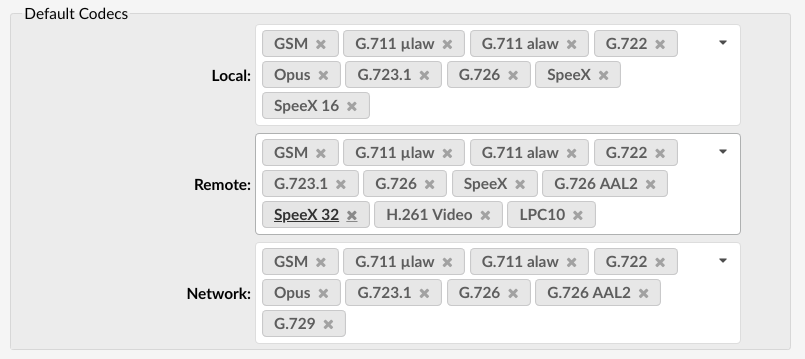
Default codecs can be set for the following groups:
- Local
Local extensions
- Remote
Remote extensions and Trunks
- Network
PBXware network (two or more servers)
TIP
Once a local/remote extension or a network is added/edited, only the codecs allowed here will be available for the extension/network usage.
Available Codecs:
- ITU G.711 ulaw - 64 Kbps, sample-based, used in US
- ITU G.711 alaw - 64 Kbps, sample-based, used in Europe
- ITU G.722 - 64 Kbps,
- Opus - 6-510 Kbps, 2.5 ms - 60 ms frame size
- ITU G.723.1 - 5.3/6.3 Kbps, 30ms frame size
- ITU G.726 - 16/24/32/40 Kbps
- ITU G.729 - 8 Kbps, 10ms frame size
- GSM - 13 Kbps (full rate), 20ms frame size
- iLBC - 15Kbps,20ms frame size: 13.3 Kbps, 30ms frame size
- Speex - 2.15 to 44.2 Kbps
- LPC10 - 2.5 Kbps
- H.261 Video - Used over ISDN lines with resolution of 352x288
- H.263 Video - Low-bit rate encoding solution for video conferencing
- H.263+ Video - Extension of H.263 that provides additional features that improve compression over packet switched networks.
- H.264 Video - Offers great balance between quality and size
Note: If the H.264 codec is used for video calls, ensure that the H.264 Payload type on your UAD is set to 99 to match the Asterisk Payload type. Otherwise, you could encounter issues with video decoding.
¶ Monitoring
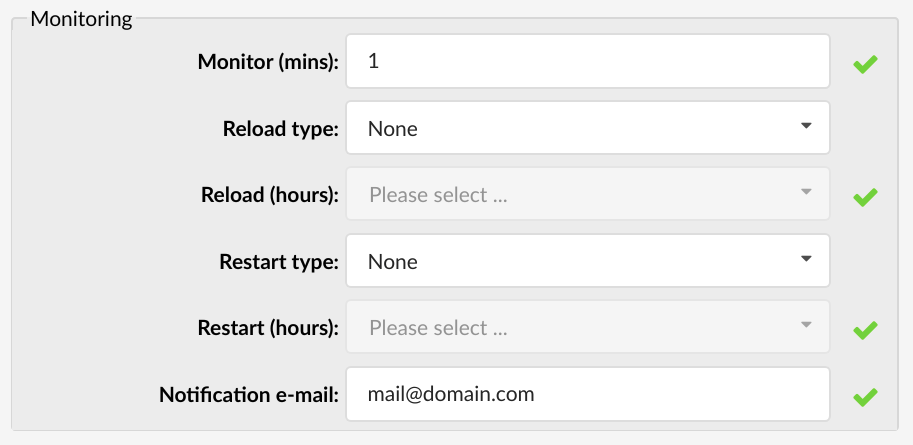
Monitoring sets alarms and notifications with which the system will monitor itself. Also, monitoring sets where notifications will be sent if alarms are triggered.
TIP
Reloading the system will not interrupt any services while restarting the system does stop and starts all system services.
- Monitor (mins):
Time interval at which the system should check if Asterisk is down. If down, the system will try to start it and will send a notification email about the stop/start action.
(E.g. 15)
([0-9])
- Reload Type:
Select whether to reload the system at some specific time of a day or in regular time intervals (hourly)
(E.g. Setting this option to 'Time of the day' and 'Reload (hours)' to '2' will reload the system every day at 02:00 hours.
Setting this option to 'Regular Interval' and 'Reload (hours)' to '2' will reload the system every two hours)
(Select box)
- Reload (hours):
This field is active only when the 'Reload Type' option is selected
(E.g. Setting 'Reload Type' = 'Time of the day' and this option to '2' will reload the system every day at 02:00 hours. Setting 'Reload Type' = 'Regular Interval' and this option to '2' will reload the system every two hours)
(Select box)
- Restart Type:
Select whether to restart the system at some specific time of a day or in regular time intervals (hourly)
(E.g. Setting this option to 'Time of the day' and 'Restart (hours)' = '2' will restart the system every day at 02:00 hours. Setting this option to 'Regular Interval' and 'Restart (hours)' = '2' will restart the system every two hours)
(Select box)
- Restart (hours):
This field is active only when the 'Restart Type' option is selected
(E.g. Setting 'Restart Type' = 'Time of the day' and this option to '2' will restart the system every day at 02:00 hours. Setting 'Restart Type' = 'Regular Interval' and this option to '2' will restart the system every two hours)
(Select box)
- Notification e-mail:
Email address to which the reload/restart notification will be sent.
(E.g. email@domain.com)
([a-z][0-9])
¶ Hot Desking
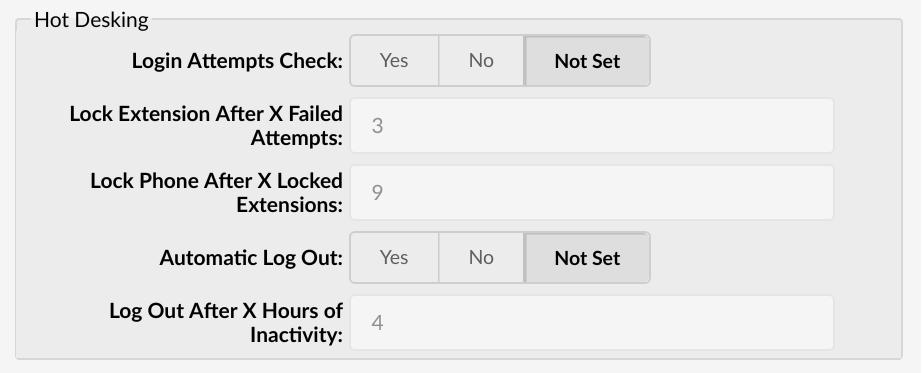
Here you can set Hot Desking security details.
- Login attempts check
Login attempts check option will turn on/off hot desking login attempts checking. When set to yes, users will be able to set two additional options: Lock Extension After X Failed Attempts and Lock Phone After X Locked Extensions.
- Lock Extension After X Failed Attempts
This option enables the user to set the maximum number of unsuccessful attempts before the extension is locked. The default value is 3, so if the phone operator makes 3 unsuccessful login tries in a row during the same day, the extension will be locked.
- Lock Phone After X Locked Extensions
This option will define after how many locked extensions phone (device) should be locked. The default value is 9, which means that after nine extensions are locked from on same device, the device will be locked.
- Automatic Log Out
When set to yes, this option will allow automatic logout feature. When turned on, hot desking phones will log out after X hours of inactivity.
This option can also be set per extension, under extensions Advanced options -> Hot Desking, and in that case, it will override this setting and use the value set in the extensions Hot desking section.
- Log Out After X Hours of Inactivity
In this field user can set inactivity time required for the phone to reboot, in hours. The default value is 4 hours.
On each login, the system will check if the number of blocked extensions per device is equal or greater than what is set on settings/servers page. This way you can unblock the phone just by increasing values on this page. For example, if “Lock Phone After X Locked Extensions" is set to 3, and there are 3 locked extensions for that day, the phone (device) will be blocked, and nobody will be able to log in from this device until an administrator unlocks the extensions.
Now, if someone sets “Lock Phone After X Locked Extensions" to 4, the phone will be available until one more extension is locked.
¶ Features
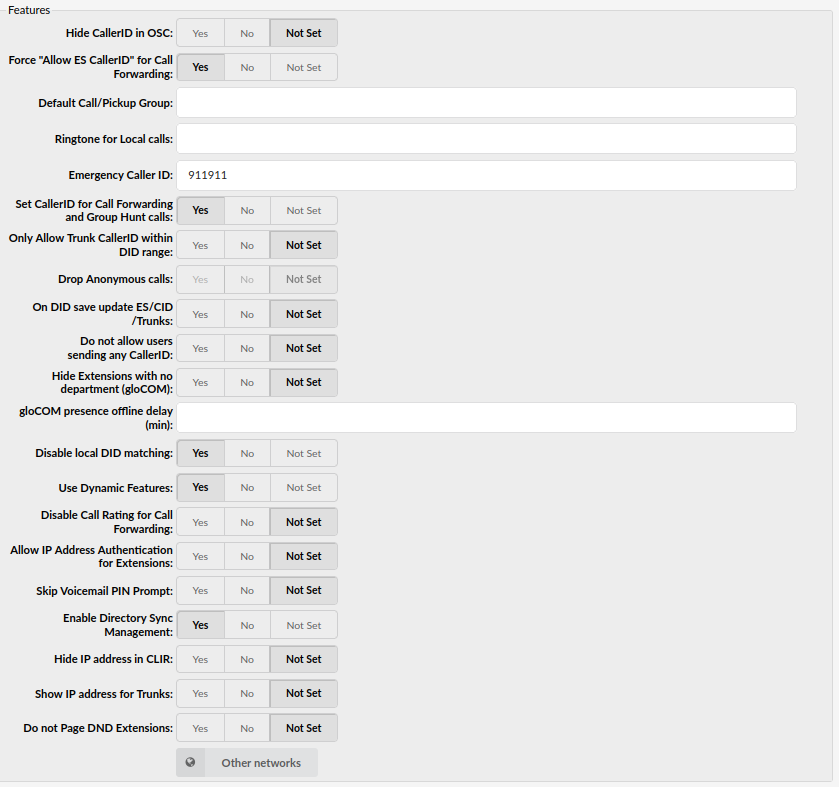
- Hide CallerID in OSC
Select whether to hide Enhanced Services 'Caller ID' in Online Self Care. Set this option to 'Yes' to prevent users from changing their Caller IDs.
(E.g. Yes/No/Not Set)
(Options button)
- Force "Allow ES CallerID" in Call Forwarding
Force showing CallerID of the user who forwarded the call.
(E.g. John calls Michael and Michael forwards call to Steven. Steven will see that Michael is calling him instead of seeing John.)
NOTE: If this option is set to ‘Yes’, the aforementioned scenario will occur. Otherwise, Steven will see that John is calling.
(E.g. Yes/No/Not Set)
(Options button)
- Default Call/Pickup group
Set which Call/Pickup group will be set by default for Extensions.
(E.g. 2)
([0-9])
- Ringtone for Local calls
Set a default Custom Ringtone for local calls
(E.g.)
([a-z][0-9])
- Emergency Caller ID
Caller ID entered here will be used only for calls to the Emergency Services' numbers.
(E.g. 123)
([0-9])
NOTE: In case an 'Emergency Caller ID' is not set on the Extension, an 'Emergency Caller ID' set on a system will be used.
- Set CallerID for Call Forwarding and Group Hunt calls
If numbers set in 'Call Forwarding and Group Hunt' have one or more remote numbers, those numbers will receive a different Caller ID on the call. That Caller ID is the one from the original caller set in its Enhanced Services 'Caller ID' for the Trunk where the call was going through.
(E.g. Yes/No/Not Set)
(Options button)
- Only Allow Trunk CallerID within DID range
If the calls from some other server are going through this system's Multi-User Extension, and the Caller IDs from the other server are matching DIDs on this server, they are properly shown to callees. Otherwise, the Caller ID is shown as 'Anonymous'.
(E.g. Yes/No/Not Set)
(Options button)
- Drop Anonymous Calls (6.6)
Enable this option to drop calls that have anonymous CallerID
(E.g. Yes/No/Not Set)
(Options button)
NOTE: In order for this option to be enabled successfully, the 'Only Allow Trunk CallerID within DID range' option must be set to 'Yes'. This ensures that calls that do not have CallerID within the allocated DID range for the Multiuser Extension in question, are considered 'anonymous', and when the 'Drop Anonymous Calls' option is set to 'Yes', such calls will be dropped on the system.
- On DID save update ES/CID/Trunks
When this option is turned on and a user saves a DID, it will set a number as a Caller ID on the Extension to which it points. The DID number will also be set for the Trunk where it is assigned, on the Extensions' Enhanced Services Caller ID.
(E.g. Yes/No/Not Set)
(Options button)
- Do not allow users sending any CallerID
Do not allow users to send any Caller ID when making a call. When this option is set to 'Yes', users will not be able to send Caller IDs when making a call.
(E.g. Yes/No/Not Set)
(Options button)
- Hide Extensions with no department (gloCOM)
If an Extension does not have a department assigned, (for example, the Department is set to 'None'), then this Extension will not be shown in gloCOM.
(E.g. Yes/No/Not Set)
(Options button)
- Disable local DID matching
If set to 'Yes', the system will disable local DID search and will, in turn, go through a trunk to search a match on another system.
(E.g. Yes/No/Not Set)
(Options button)
- Use Dynamic Features
Asterisk allows users to define custom features mapped to Asterisk applications.
By using dynamic features, a user can send a DTMF to activate a specific dial plan. For example, when set to 'No', a user will not be able to pause recordings, and s(he) will be able to use direct media.
(E.g. Yes/No/Not Set)
(Options button)
- Disable Call Rating for Call Forwarding
Select whether Call Rating will be disabled or enabled for the part of the call after it has been forwarded.
(E.g. Yes/No/Not Set)
(Options button)
- Log IVR Calls
Select whether IVR calls logging should be enabled. By default, the IVR calls are not logged, but if a user wants to use the IVR Statistics, s(he) needs to enable IVR Calls logging.
(E.g. Yes/No/Not Set)
(Options button)
- Allow IP Address Authentication for Extensions
Allow IP Address Authentication for Extensions and force the IP based authentication.
When this field is set, the following fields are enabled per Extension:
-
Incoming IP Addresses
-
Insecure
(E.g. Yes/No/Not Set)
(Options button)
- Skip Voicemail PIN Prompt
By default, when entering Extension's voicemail (by dialing *123), a user will be prompted to enter his/her PIN number. If this option is set to ‘Yes’, the system will not ask for the PIN and the user will immediately go to the Voicemail.
(E.g. Yes/No/Not Set)
(Options button)
- Enable Directory Sync Management
Set 'Yes' to enable Directory Sync Management. If 'No' or 'Not Set' is selected, Directory Sync Management won't be visible anywhere on the system including E-mail templates, Reports, and Settings.
(E.g. Yes/No/Not Set)
(Options button)
- Hide IP address in CLIR
Select whether the IP address will be hidden in CLIR or not
(E.g. Yes/No/Not Set)
(Options button)
NOTE: By default, this option is set to show the IP address on every call except for Trunk calls. To enable it for Trunk calls as well, please select the 'Show IP address for Trunks' option to 'Yes'.
- Show IP address for Trunks
Select whether the IP address will be shown for Trunks
(E.g. Yes/No/Not Set)
(Options button)
NOTE: You cannot edit this option, if the 'Hide IP address in CLIR' option is set to 'Yes'.
¶ Other Networks

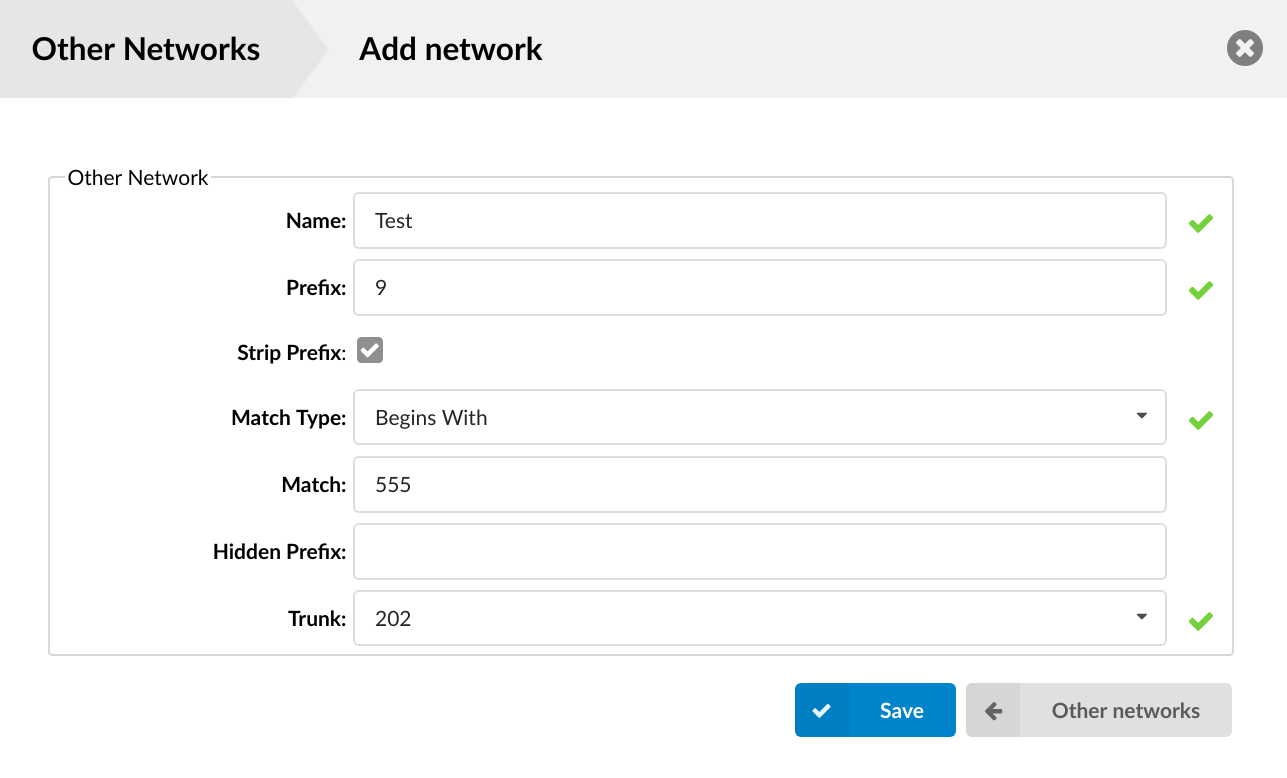
The system can be part of the 'default' PBXware network where all extensions share the same unified dial plan. This is achieved by selecting the PBXware network that the system belongs to from the select box.
Clicking on 'Other network' will open the following options:
- Mode:
Sets the way other PBXware networks are dialed
- With Access Code - Access code + network number + extension
(E.g. *18881000)
- Without Access Code - network number only + extension
(E.g. 8 1000)
(Select box)
- Name:
Other network's name.
(E.g. Network London)
(Display)
- Prefix:
Shows the other network's set prefix.
(E.g. 1)
(Display)
- Strip prefix:
Shows which value is chosen for the Strip prefix option when adding/editing the other network.
(E.g. Yes)
(Display)
- Match Type:
Shows which matching type is set for the Match Type option.
(E.g. Range)
(Display)
- Match:
Shows the value which will be used for matching.
(E.g. 555)
(Display)
- Hidden Prefix:
Shows the Hidden Prefix value.
(E.g. 555)
(Display)
- Trunk:
Trunk used once the other network number is dialed
(E.g. 2554433)
(Display)
 Click here to edits the other network configuration
Click here to edits the other network configuration
(Button)
 Click here to delete the other network connection.
Click here to delete the other network connection.
(Button)
In order for users to use prefixes that are 2 or 3 digits long, you will have to enable "Mode: * With Access Code" 2 or 3-digit dial prefix. After you set this up, you must dial *188 XXX YYYYYYY, where XXX is 3-digit prefix and YYYYYY is the phone number you want to dial.
In case you have "Mode: * Without Access Code" (1 digit dialing) enabled, users will be able to dial the numbers that are set with your single digit prefixes without using *188 access code, simply typing X YYYYYYY, where X is your 1-digit prefix and YYYYYYY is number you would like to dial.
¶ Add/Edit Network

- Name:
Custom Other Network name/identifier
(E.g. London FO/7)
([a-z][0-9])
- Prefix:
Number used to access Other Networks (Up to 3 digits allowed)
(E.g. If this field is set to '7', dial '*188 7 {NETWORK NUMBER}')
([0-9])
- Strip Prefix:
Should the 'Prefix' number be stripped when dialing the Other network
(E.g. If the 'Prefix' field is set to '7' and this field is enabled, once the user dials *188 7 55510205 the system will dial 55510205. If this field is disabled, 755510205 will be dialed).
(Option buttons)
- Match Type:
Number range allowed to be dialed after the *188 Other Network Access Code
Different match types can be chosen:
- Range: Select the range of numbers allowed to be dialed in this network.
(E.g. 55510000-55599999)
- Begins With:
All numbers that begin with the entered digit(s) will be allowed to pass through the network.
(E.g. 555)
- Regex:
The type of an entry in the Match Type field must be a regular expression. Let's say we want to enter '7' as our Prefix number. In this case the correct input with prefix 7 is: [0-9]{3}. The first part of an expression [0-9] represents one digit from 0 to 9. And {3} represents quantity (3 digits from 0 to 9). The correct solution is also: [0-9][0-9][0-9]. It’s important to mention that the prefix number has to be excluded from the regular expression, since it’s already included by entering a number in the Prefix field.
- Match:
The value for which the Match Type rule will be applied. It can be one of the following:
- A range of numbers for the Range Match Type.
(E.g. 200000-200999)
- Starting digits for numbers for the Begins With Match Type.
(E.g. 555)
- A regular expression for the Regex Match Type.
(E.g. [0-9]{3})
- Hidden Prefix:
Prefix number added before dialed number
(E.g. If this field is set to 212 and we dialed *188 7 55510205, 21255510205 will be dialed. This is useful if the provider requires a certain code before dialing the destination, area code inserted automatically, etc.)
([a-z][0-9])
- Trunk:
Select the trunk that will be used for calls through in this network.
(E.g. London FO Trunk)
(Select box)
¶ Emergency Call Notifications

When an emergency number, such as 911, is dialed, an automated call goes out to a specified number or an extension or a ring group, playing an announcement that 911 was dialed from this extension.
- Enable:
Choose whether you want to enable or disable notifications for emergency calls.
- Notify First Only:
Select whether you want only the first destination to be notified when there's an emergency call. (If set to 'No', every configured destination will get the playback individually, if answered.)
- Notify Destinations:
Fill in the destinations you wish to be notified when there's an emergency call.
- Notify CallerID:
Add a custom callerID to be used for emergency calls (will show on the configured destination).
Example: Extension 101 dials 911. Automated call goes out to extensions 102, 103, and 104. Whoever answers will hear “9-1-1 was dialed from extension 1-0-1”.
¶ File Sharing

Options for file sharing service used by desktop and mobile applications.
- Maximum File Size (MB):
The maximum allowed file size when sending files with desktop and mobile applications.
¶ Call Recording Transcription (7.5)
- Disable Transcription On-Demand:

If set to YES, this option will remove the Request transcription button/function, which means that users will not be able to request a transcription of the recording if it is not transcribed yet. However, all transcriptions with valid recordings will be transcribed in the next iteration when the transcription service is active.
If Disable Transcription On-Demand is set to 'NO,' the Request transcription option will be available. The transcription can be triggered manually for the selected recording.
NOTE: The request transcription button can be triggered manually on the Reports > CDR > Transcription page.

NOTE: Disable On-Demand Transcription can also be restricted per user. Admin settings > Groups > Reports section, Disable On-Demand Transcription can be selected or de-selected, which will decide if the Request transcription button/function will be available for those Users specifically.

- Provider:
Select a provider which will be used for transcriptions from the dropdown. Current options are: OpenAI and Hosted Whisper.
¶ OpenAI
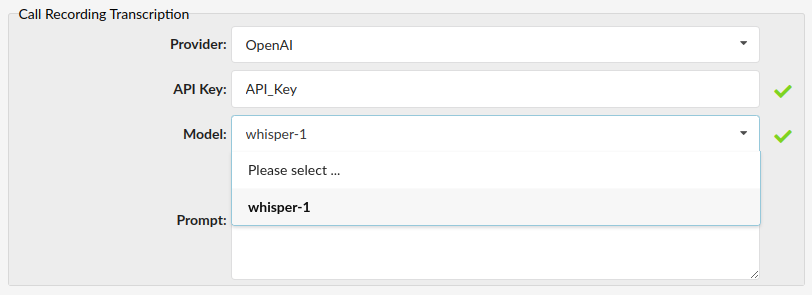
-
API Key:
Enter the API key provided by the selected transcription service provider -
Model:
Select the transcription model from the dropdown menu. Currently for OpenAI there is only one available option: whisper-1 -
Prompt:
This prompt is forwarded to OpenAI to guide the transcription model, ensuring transcriptions are tailored to the expected conversation type.
¶ Hosted Whisper
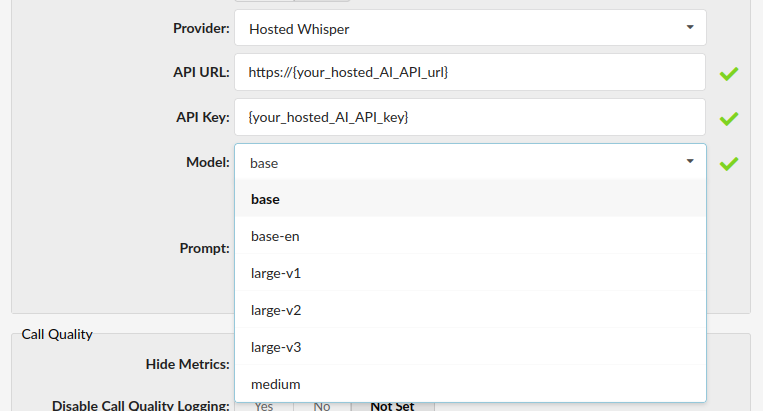
-
API Url
The endpoint URL used to interact with the transcription service API. -
API Key
Enter the API key provided by the selected transcription service provider. -
Model
Select the transcription model from the dropdown menu. Current available options for Hosted Whisper are: base, base-en, large-v1, large-v2, large-v3, medium, and medium.en. -
Prompt
This prompt is forwarded to Hosted Whisper to guide the transcription model, ensuring transcriptions are tailored to the expected conversation type.
NOTE: Transcription must be enabled in the License. Otherwise, it will not be available in the PBXware Graphical Interface.
¶ Call Quality (7.5)
Options for managing call quality tracking.
-
Hide Metrics
Controls the visibility of the "MOS" (Mean Opinion Score) column on the Reports > CDR page. When set to "Yes", this column, which represents call quality, will be hidden. The default setting is "Not Set", which means the "MOS" column will be visible by default. -
Disable Call Quality Logging
This option enables/disables MOS score logging for the entire system. By default ( “Not Set” ), the MOS score will be logged and saved to the database. By setting this option to “Yes”, it will be disabled and call quality will not be logged at all. MOS data saved prior to disabling logging will still be present in the database, but will not be visible in the GUI.

NOTE: When call quality logging is disabled, API requests will not return the MOS score.
¶ Text to speech (7.6)
This section is used to enable/disable the TTS Service. By default, TTS is disabled.

- Enable TTS
Allows enabling and disabling the TTS service. The default value is 'No'. When 'Yes' is selected, the 'Provider' field becomes available.
- Provider
Specifies which provider will be used for the TTS feature. Currently, only OpenAI is available. After selecting a provider, additional fields such as 'API Key' will become available.
- API Key
Used to enter the API key for the selected TTS provider.
¶ Additional Proxy Config
Users can here add custom/hidden proxy configuration parameters.

¶ Protocols
Protocol is a set of rules that allows UAD, systems, networks, etc. to communicate using a set standard.
Supported protocols are:
- SIP
- IAX
- RTP
NOTE: PBXware 5.1 does not support Woomera / BRI any more.
¶ SIP
SIP (Session Initiated Protocol, or Session Initiation Protocol), is a signaling protocol for Internet conferencing, telephony, presence, events notification, and instant messaging. The protocol initiates call setup, routing, authentication, and other feature messages to end points within an IP domain.
¶ General
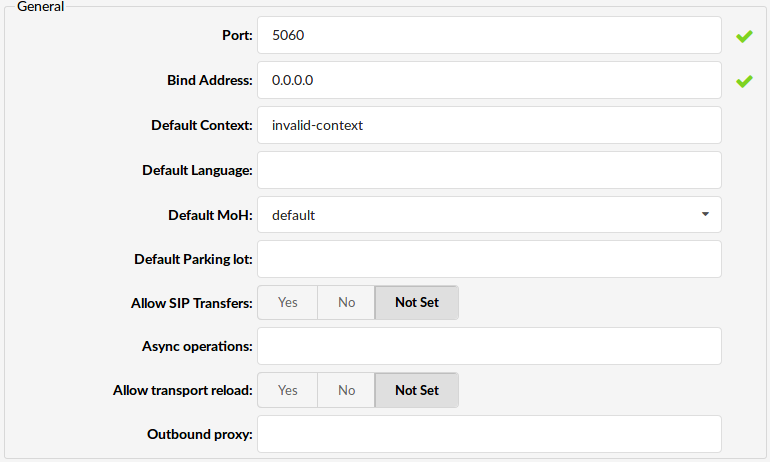
- Port:
Port for SIP server to bind to
(default value 5060,)
([0-9])
NOTE: If PBXware is operating behind NAT, and you would like to change values for Port and External IP you also have to set External TCP port.
- Bind Address:
IP address for SIP server to bind to (0.0.0.0 binds to all interfaces)
(default value 0.0.0.0,)
([0-9])
- Default Context:
Default context for incoming calls
(E.g. For security reasons it is recommended to keep this field set at 'invalid-context')
([a-z][0-9])
- Default Language:
Default language settings for all users/peers
(E.g. Set this option to 'en' (English) for example)
([a-z])
- Default MoH:
Set the default MOH (Music on Hold) class for all SIP calls
(E.g. Set 'default', for example, to play 'default' MOH class to all SIP calls when placed on hold for example)
(Select box)
- Default Parking lot:
Sets the default parking lot for call parking.
This may also be set for individual users/peers. Parkinglots are configured in features.conf
([1-9][a-z])
- Allow SIP Transfers:
Disable all transfers (unless enabled in peers or users). Default is enabled.
(E.g. Yes, No, Not Set)
(Option buttons)
- Async operations:
- Allow transport reload:
(E.g. Yes, No, Not Set)
(Option buttons)
- Outbound proxy:
This option will set PBXware to send outbound signaling to this proxy, instead directly to the peer
E.g. proxy.provider-domain.com
type ([a-z]1-9|)
- Use loose routing for outbound proxy (6.7 beta)
By selecting Yes for this option, you will ensure “Loose routing” is used with Outbound Proxy, which will add “\;lr” flag after your Outbound Proxy address in SIP INVITE packets.
In case you manually entered this flag in the Outbound proxy field after your proxy address (I.e. your-outbound-proxy.com;lr ), enabling or disabling Use Loose routing for outbound proxy should not have any effect.
This was implemented to ensure future compatibility and prevent any issues for customers that had this workaround in place to enable Loose routing for outbound proxy, before this feature was available.
(E.g. Yes, No, N/A)
¶ TCP Settings

- Enable TCP:
Enable server for incoming TCP connections. (Default value: No)
E.g. Yes, No, N/A
- External TCP Port:
This option allows you to define external port number for incoming TCP connections.
Default port used for TCP connections is 5060. ([0-9])
- TCP Keep-Alive:
Enables or disables sending \r\n\r\n packets to TCP endpoints to prevent NAT from closing the port due to inactivity.
By default, this option is set to Not Set.
(E.g. Yes, No, Not Set)
- TCP Keep-Alive Interval
Specifies the time interval (in seconds) between sending \r\n\r\n packets to TCP endpoints to prevent NAT from closing the port due to inactivity.
Enter time in seconds after which \r\n\r\n packets will be sent. Default value is 20 seconds. ([0-9])
- TCP Idle Timeout (7.6)
Defines the maximum duration, in milliseconds, that an inactive TCP connection is kept open before being automatically terminated. This setting helps manage system resources by closing connections that are no longer in use.
The value must be between 500 and 99999 milliseconds. The system default is 10000 ms.
(E.g. 5000)
¶ TLS Settings
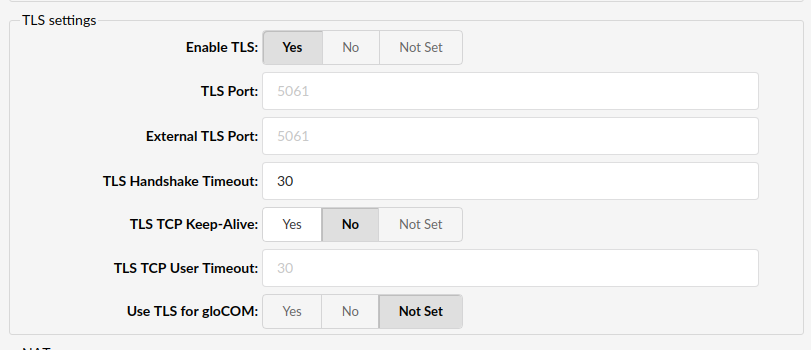
- Enable TLS:
Enable the server for incoming TLS (secure) connections
(E.g. Yes, No, Not Set)
(Options button)
NOTE: The default option is 'No'.
- TLS Port:
This port overrides any TCP/UDP settings in SIP protocol settings and applies for all users (external and internal).
(E.g. 5061)
([0-9])
NOTE: The default port used for TCP connections is 5061.
- External TLS Port:
This option allows you to define an external port number for incoming TLS connections.
(E.g. 5061)
([0-9])
NOTE: The default port used for TCP connections is 5061.
- TLS Handshake Timeout:
Control TLS handshake timeout
(E.g. 30)
([0-9])
- TLS TCP Keep-Alive:
Enable TLS TCP Keep-Alive socket option in order for kernel to remove stuck and established TCP connections.
(E.g. Yes, No, Not Set)
(Options button)
- TLS TCP User Timeout:
Enable TLS TCP_USER_TIMEOUT socket option for faster removal of stuck and established TCP connections.
(E.g. 30)
([0-9])
- Use TLS for gloCOM:
Set 'Yes' to force gloCOM Mobile/Desktop to use SIP TLS.
(E.g. Yes, No, Not Set)
(Options button)
¶ NAT

- External IP:
External IP/Public/Internet address system uses.
If your system is behind NAT, set this option to Public/Internet IP address system uses when registering with other proxies over the Internet. In case this field is not populated users will experience one way audio registering from WAN
([0-9])
- External Host (DynDNS):
DynDNS address system uses
If your system is behind NAT, along with the External IP address you may use the DynDNS service. Set this field to DynDNS host.
([0-9])
- Local network:
If the system is used in local network, set the local network address here
(E.g. 192.168.0.0/255.255.0.0)
- NAT:
Global SIP NAT setting which affects all users/peers.
Options:
- yes - forces RFC 3581 behavior and enables symmetric RTP support
- no - only enables RFC 3581 behavior if the remote side requests it and disables symmetric RTP support
- force_rport - forces RFC 3581 behavior and disables symmetric RTP support
- comedia - enables RFC 3581 behavior if the remote side requests it and enables symmetric RTP support
(Option buttons)
NOTE: Previously, a PBXware administrator needed to manually check and set the following information in the ‘NAT’ field found in the ‘Settings’ -> ‘SIP’ section in PBXware:
-
Enter the address into the ‘External IP address (:port)’ field
-
Enter the address into the ‘Local networks (separated by newline)’ field
We have added support to recognize the local and external IP addresses automatically even when the system is behind NAT. However, if the system has no connection with the outside world and can’t reach Google’s STUN server, this implementation will not be carried out successfully. After the system is started, all the required information will be obtained and stored.
Once the information is obtained and stored successfully, it will be added as ‘placeholders’ to the ‘External IP address (:UDP port)’ and ‘Local networks (separated by newline)’ fields located in the ‘NAT’ section of ‘Protocol -> SIP’ in PBXware. These 'placeholders' will be later on used for establishing peer-to-peer communication in case the administator did not populate these fields with any other values. If the PBXware administrator populates those fields with certain values, the entered values will have an advantage over the fetched values. However, even if those fields already contained some values, this will not break the functionality.
¶ Security

- Authenticate OPTION requests:
Enabling this option will authenticate OPTIONS requests just like INVITE requests are. By default this option is disabled.
Options: Yes, No, N/A
¶ RTP Timers

- RTP timeout:
Max RTP timeout
(E.g. All calls (if not on hold) will be terminated if there is no RTP activity for the number of seconds set here (60 for example))
([0-9])
- RTP hold timeout:
Max RTP hold timeout.
NOTE: This field must be a higher number than set under 'RTP timeout'
(E.g. All calls on hold will be terminated if there is no RTP activity for the number of seconds set here (300 for example))
([0-9])
- RTP keep-alive:
Send keep-alives in the RTP stream to keep NAT open (default is off - zero).
(E.g. 0)
([0-9])
¶ SIP Timers
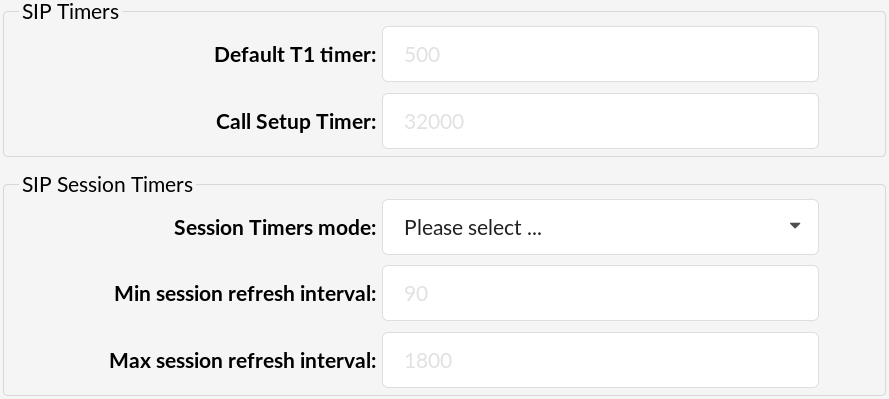
- Default T1 Timer:
Default T1 timer.
Defaults to 500 ms or the measured round-trip time to a peer (qualify=yes).
- Call Setup Timer
Call setup timer.
If a provisional response is not received in this amount of time, the call will autocongest. Defaults to 32000 ms.
¶ SIP Session Timers
- Session Timers mode:
Session-Timers feature operates in the following three modes:
originate: Request and run session-timers always
accept: Run session-timers only when requested by other UA
refuse: Do not run session timers in any case
The default mode of operation is 'accept'.
- Minimum session refresh interval:
Minimum session refresh interval in seconds.
Defaults to 90 secs.
(|0-9|)
- Max session refresh interval:
Maximum session refresh interval in seconds.
Defaults to 1800 secs.
(|0-9|)
¶ DTMF

- DTMF Mode:
Choices are inband, rfc2833, info or auto:
- inband: The device that you press the key on will generate the DTMF tones. If the codec is not ulaw or alaw then the DTMF tones will be distorted by the audio compression and will not be recognised. If the phone is set for RFC2833 and asterisk is set for inband then you may not hear anything.
- rfc2833: http://www.ietf.org/rfc/rfc2833.txt
- info: See SIP method info and SIP info DTMF or http://www.ietf.org/rfc/rfc2976.txt
- auto: Asterisk will use rfc2833 for DTMF relay by default but will switch to inband DTMF tones if the remote side does not indicate support of rfc2833 in SDP. This feature was added on Sep 6, 2005 and is not available in Asterisk 1.0.x.
NOTE:
Inband DTMF won't work unless the codec is ulaw or alaw (G711). Use out of band DTMF aka rfc2833 or info.
(Select box)
- Relax DTMF:
Relax DTMF handling
(E.g. Set this field to 'Yes' if having problems with DTMF modes)
(Option buttons)
¶ Quality of Service

- TOS SIP:
(Select Box)
- TOS Audio:
(Select Box)
- TOS Video:
(Select Box)
Available options: CS0, CS1, CS2, CS3, CS4, CS5, CS6, CS7, AF11, AF12, AF13, AF21, AF22, AF23, AF31, AF32, AF33, AF41, AF42, AF43, EF
- 802.1p CoS SIP:
(Select Box)
- 802.1p CoS Audio:
(Select Box)
- 802.1p CoS Video:
(Select Box)
Available Options: 0-7
¶ Remote Party ID
The From header provides basic caller ID data but it is too easily modified, blocked or spoofed to be of use to the network. The Remote Party ID header is added by one of the network servers so it should provide a much more reliable and trustworthy identification than the From header which can be set by users at the client device. Another approach is described in RFC 3325. It explains the requirements for provision of an authenticated caller ID within a trusted network using the P-Asserted-Identity (PAI) header to convey the authenticated identity of a caller along with a separate Privacy header to show if this data must be hidden.

- Trust Remote-Party-ID:
Defines whether PBXware allow Remote-Party-ID header
(Option button)
- Send Remote-Party-ID:
Should 'Remote-Party-ID' be added to uri.
Options:
- Use Remote-Party-Id - Use the "Remote-Party-ID" header to send the identity of the remote party
- Use P-Asserted-Identity - Use the "P-Asserted-Identity" header to send the identity of the remote party
(Select Box)
¶ Misc

- Send Diversion Header:
New PBXware version includes new SIP header which will display standard caller ID details along the information on number call is forwarded from.
"From" and "Via" information are enabled by default but can be disabled by setting this option to No. (Option: Yes, No).
- Max-Forwards value:
Max-Forwards header limits the number of hops a request can make on the way to its destination. It consists of an integer that is decremented by one at each hop. If the Max-Forwards value reaches 0 before the request reaches its destination, it is rejected with a 483 (Too Many Hops) error response.
Default value is 70
(|0-9|)
- Generate inband ringing:
Inband means that DTMF is transmitted within the audio of the phone conversation, i.e. it is audible to the conversation partners. Set whether the system generates in-band ringing.
(E.g. You're recommended to set this option to 'Never')
(Select box)
- Compact Headers:
You can set compact headers to yes or no. If it's set to yes, the SIP headers will use a compact format, which may be required if the size of the SIP header is larger than the maximum transmission unit (MTU) of your IP headers, causing the IP packet to be fragmented. Do not use this option unless you know what you are doing.
(E.g. You're recommended to set this option to 'No' unless required otherwise)
(Option buttons)
¶ Authentication

- User Agent:
Set the 'User Agent' string
(E.g. 'Custom string')
([a-z][0-9])
- Realm:
Realm for digest authentication
(E.g. 'Custom string')
([a-z][0-9])
¶ Registration
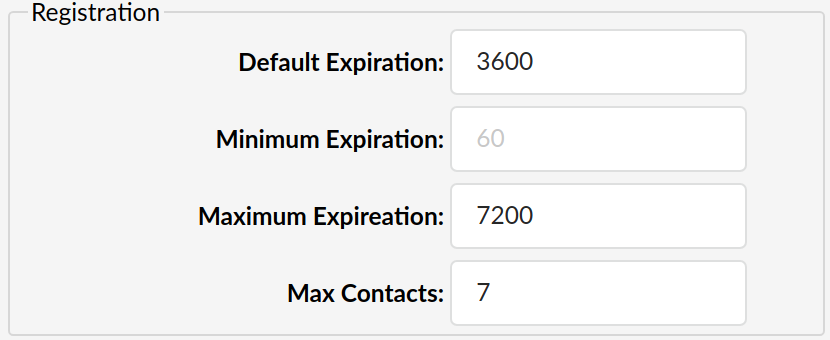
- Default Expiration:
Default duration (in seconds) for incoming/outgoing registrations.
Default value 3600 seconds.
([0-9])
- Minimum Expiration:
Minimum duration (in seconds) for incoming registrations
Default value 60 seconds.
([0-9])
- Maximum Expiration:
Maximum duration (in seconds) for incoming registrations.
Default value 7200 seconds.
([0-9])
- Max Contacts
Maximum number of contacts per extension. This number is set as default globally.
This can be overwritten by changing max contacts number per Extension.
([0-9])
¶ MWI

- MWI From: header:
When sending MWI NOTIFY requests, use this setting in the From: header as the "name" portion. Also fill the "user" portion of the URI in the From: header with this value if no fromuser is set. Default: empty
([a-z][0-9])
- Outgoing MWI Expiry:
Expiry time for outgoing MWI subscriptions (seconds).
Default value 3600.
(|0-9|)
- MWI Task Processor Queue Size:
This option is giving us information about the number of queue task processor for a number of messages which it should process
¶ Subscriptions

- Allow Subscriptions:
Disable support for subscriptions. Default is Yes.
(E.g. Yes, No, N/A)
(Option buttons)
¶ Codecs

- Auto-Framing (RTP Packetization):
If auto framing is turned on, the system will choose packetization level based on remote ends preferences.
(E.g. Yes, No, N/A)
(Option buttons)
¶ Session Description Protocol

- T.38 support
Setting this field to any value will enable T.38 Fax support on SIP calls with different options. Default value is off.
- Session name
This field allows you to change the SDP session name string, Like the useragent parameter, the default user agent string also contains the Asterisk version.
([A-Z, 0-9])
- Session owner
This field allows you to change the username field in the SDP owner string, This field MUST NOT contain spaces.
([A-Z, 0-9])
¶ Threadpool
Asterisk threadpool can be tweaked to get better performance.
NOTE: This requires more asterisk knowledge to do it right, and changing this is not recommended unless you know what are you doing.
In asterisk logs you could find message like:
The "name" task processor queue reached "number" scheduled tasks.
In that case you probably suffering from threadpool overload, and below parameters gives you possibility to improve performance.
Worst case scenario is that PJSIP dialogs starts to drop.

- Threadpool Initial Size
Initial size of the threadpool. Default value is 10.
([0-9])
- Threadpool Auto increment
When more threads are needed, how many should be created. Default value is 5.
([0-9])
- Threadpool Idle Timeout
Number of seconds a thread should be idle before dying. 0 means threads never time out. Default value is 120.
([0-9])
- Threadpool Max Size
Maximum number of threads in the Stasis threadpool. Default value is 100.
([0-9])
¶ Additional Config
This option is used for providing additional config parameters for SIP configuration files. Values provided here will be written into these configuration files.

¶ IAX
IAX (Inter asterisk exchange) is a simple, low overhead and low bandwidth VoIP protocol designed to allow multiple PBXwares to communicate with one another without the overhead of more complex protocols.
¶ General
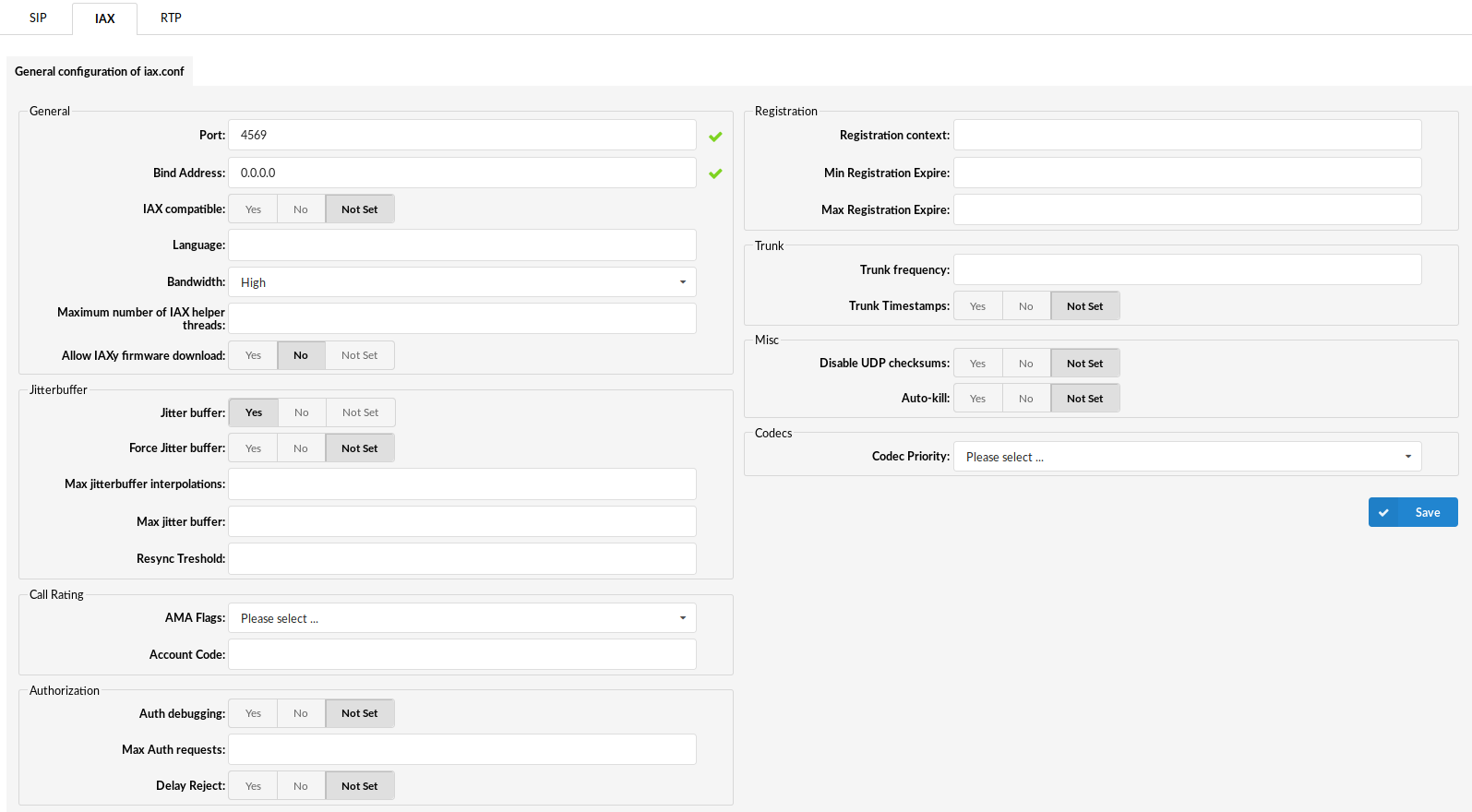
- Port:
IAX bind port
(E.g. 4569, (default))
([0-9])
- Bind Address:
This allows you to bind IAX to a specific local IP address instead of binding to all addresses. This could be used to enhance security if, for example, you only wanted IAX to be available to users on your LAN.
(E.g. 0.0.0.0, (default))
([0-9])
- IAX compatible:
Should layered switches or some other scenario be used
(E.g. Set to yes if you plan to use layered switches or some other scenario which may cause a delay when doing a lookup in the dial plan)
(Select box)
- Language:
Default language settings for all users/peers
(E.g. Set this option to 'en' (English), for example)
([a-z])
- Bandwidth:
Set the bandwidth to control which codecs are used in general
(E.g. Select between low, mid, or high)
(Select box)
- Maximum number of IAX helper threads:
Establishes the number of extra dynamic threads that may be spawned to handle I/O.
(E.g. 150)
([0-9])
- Allow IAXy firmware download:
Controls whether this host will serve out firmware to IAX clients which request it.
(E.g. Yes, No, N/A)
(Option buttons)
¶ JitterBuffer

- Jitter Buffer:
Turn off the jitter buffer for this peer
(E.g. Yes, No, N/A)
(Option buttons)
- Force Jitter Buffer:
Should we force jitter buffer (default value 10)
(E.g. Jitter buffer is usually handled by the UADs/Phones. But in case, if these do this poorly, the jitter buffer can be enforced on PBXware side)
([0-9])
- Max. jitterbuffer interpolations:
The maximum number of interpolation frames the jitter buffer should return in a row
(E.g. 1000)
([0-9])
- Max. Jitter buffer:
A maximum size for the jitter buffer. Setting a reasonable maximum here will prevent the call delay from rising to silly values in extreme situations; you'll hear SOMETHING, even though it will be jittery.
(E.g. 1000)
([0-9])
- Resync Treshold:
Resync the threshold for noticing a change in delay measured
(E.g. 1000)
([0-9])
¶ Call Rating

- AMA Flags:
AMA = Automated Message Accounting.+
These flags are used in the generation of call detail records (e.g 'default')
- default: Sets the system default.
- omit: Do not record calls.
- billing: Mark the entry for Call Rating
- documentation: Mark the entry for documentation
(Select box)
- Account code:
Default account for CDRs (Call Detail Records)
(E.g. lars101)
([a-z][0-9])
¶ Authorization

- Auth debugging:
Should authentication be debugged
(E.g. Setting this option to 'Yes' will increase the amount of debugging traffic)
(Option buttons)
- Max Auth requests:
Maximum number of outstanding authentication requests waiting for replies. Any further authentication attempts will be blocked
(E.g. 10)
([0-9])
- Delay Reject:
Set this option to 'Yes' for increased security against brute force password attacks
(E.g. Yes)
([0-9])
¶ Registration

- Registration context:
If the specified PBXware will dynamically create and destroy a NoOp priority 1 extension for a given peer who registers or unregisters with us
(E.g. iaxregistration)
([a-z][0-9])
- Min Registration Expire:
Minimum amounts of time that IAX peers can request as a registration expiration interval (in seconds).
(E.g. 60)
([0-9])
- Max Registration Expire:
Maximum amounts of time that IAX peers can request as a registration expiration interval (in seconds).
(E.g. 60)
([0-9])
¶ Trunk

- Trunk frequency:
How frequently to send trunk msgs (in ms)
(E.g. 20)
([0-9])
- Trunk Timestamps:
Should we send timestamps for the individual sub-frames within trunk frames
(E.g. Yes)
(Option buttons)
¶ Misc

- Disable UDP checksums:
Should checksums be calculated
(E.g. Yes)
(Option buttons)
- Auto-kill:
If no response is received within 2000ms, and this option is set to yes, cancel the whole thing
(E.g. Yes)
(Option buttons)
¶ Codecs

- Codec Priority:
This option controls the codec negotiation of an inbound IAX calls.
Example:
- caller - Consider the callers preferred order ahead of the host's.
- host - Consider the host's preferred order ahead of the caller's.
- disabled - Disable the consideration of codec preference altogether (this is the original behaviour before preferences were added)
- reqonly - Same as disabled, but does not consider capabilities if the requested format is not available the call will only be accepted if the requested form
(Read only)
¶ Additional Config

This option is used for providing additional config parameters for IAX configuration files.
Values provided here will be written into these configuration files.
¶ RTP
¶ General

- RTP Start Port:
Start Port used for RTP
- RTP End Port:
End Port used for RTP
- RTP Checksums:
Whether to enable or disable UDP checksums on RTP traffic
- Strict RTP Protection:
This will drop RTP packets that do not come from the recognized source of the RTP stream. Strict RTP qualifies RTP packet stream sources before accepting them upon initial connection and when the connection is renegotiated (e.g., transfers and direct media).
Initial connection and renegotiation start a learning mode to qualify stream source addresses. Once Asterisk has recognized a stream it will allow other streams to qualify and replace the current stream for 5 seconds after starting learning mode. Once learning mode completes the current stream is locked in and cannot change until the next renegotiation.
This option is enabled by default.
- Strict RTP Probation Interval (seconds):
Number of packets containing consecutive sequence values needed to change the RTP source socket address. This option only comes into play while using strictrtp=yes.
Consider changing this value if rtp packets are dropped from one or both ends after a call is connected.
This option is set to 4 by default.
¶ Opus
- Opus Adaptive Bitrate::
It is used for mobile devices to perform better audio in case of bad network.
¶ Providers
PBXware comes with a range of pre-configured VoIP and PSTN service providers in order to allow an easy way of adding trunks into the system. This screen allows adding a custom provider.
NOTE: Since PBXware edition 5.1, Woomera / BRI is not supported any more.
In addition, 'Import Providers' allows for an update of currently pre-configured service providers.

- Provider:
Name of the provider
(E.g. Generic Analog)
(Display)
- Protocol:
Protocol which provider uses
(E.g. DAHDI)
(Display)
- Type:
Service type
(E.g. pstn/voip)
(Display)
 Edit the Provider configuration
Edit the Provider configuration
(E.g. Click to edit the Provider configuration)
(Button)
 Delete Provider configuration
Delete Provider configuration
(E.g. Click to delete Provider configuration from the system)
(Button)
¶ Add Custom Provider
- Configuration
- Choose Type:
Service type (Voip or PSTN)
- Protocol:
Protocol provider uses. Depending on service type, SIP, IAX and DAHDI are offered.
- Name
Name of the provider (E.g. Generic Analog)
¶ PSTN
¶ DAHDI
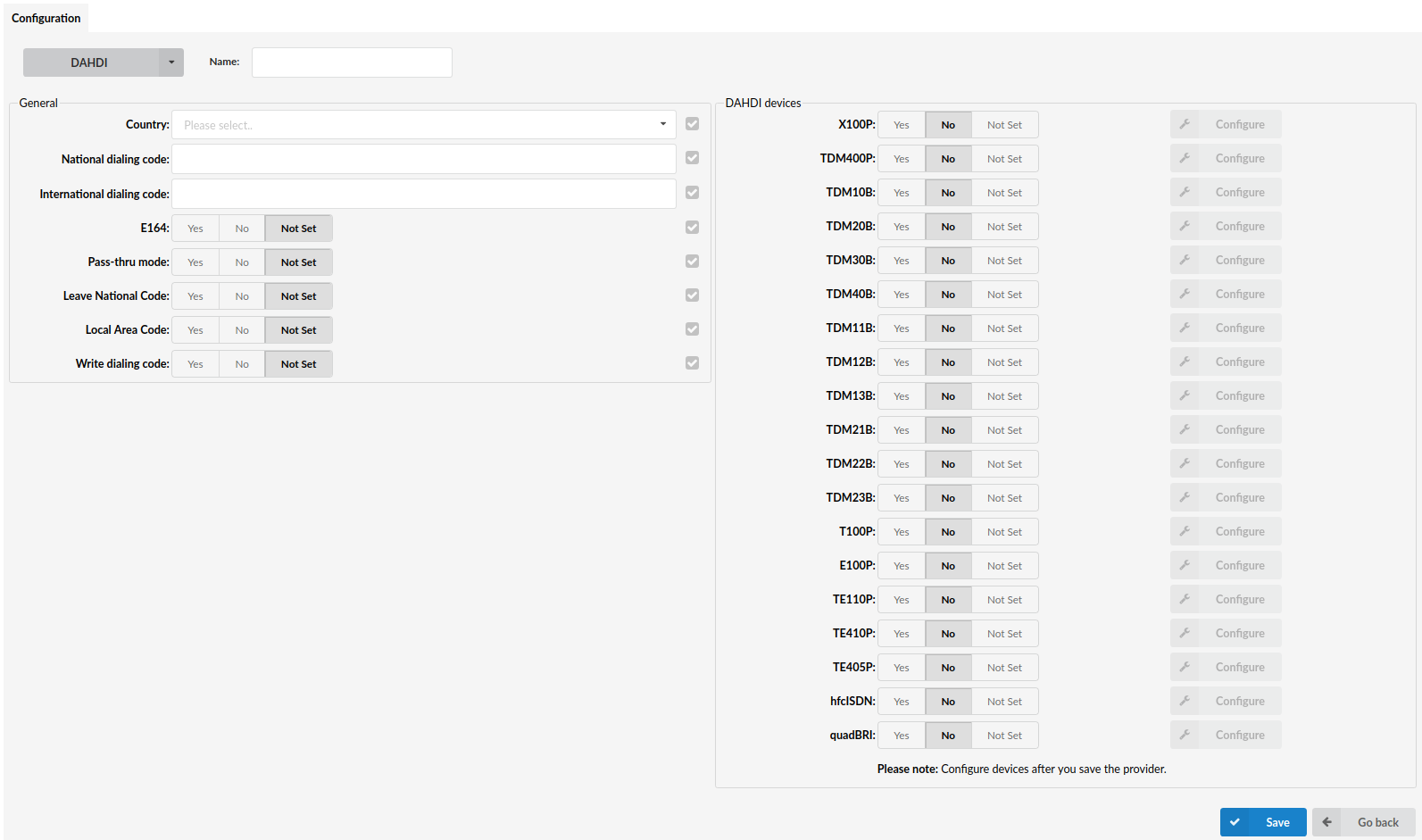
- Country:
Destination of the trunk connection
(E.g. United States)
(Select box)
- National Dialing Code:
National dialing code at the Provider destination
(E.g. For USA 1, United Kingdom, Germany 0)
(0-9)
- International Dialing Code:
International dialing code at the Provider destination
(E.g. For USA 011, United Kingdom, Germany 00)
([0-9])
- E164 Accepted:
Does the Provider support dialing destinations in the E164 format
(E.g. Enabling this option will reformat any dialed number into the following form COUNTRY_CODE+AREA_CODE+DIALED_NUMBER. E.g. If the user dials 55510205, system will dial 121255510205)
(Option buttons)
- Pass-thru mode:
If this option is enabled, the number which is dialed is passed through trunk without modification
(Option buttons)
- Leave National Code:
In some countries, the national code is stripped automatically. If set to 'Yes', the national code will not be stripped from the dialed number.
NOTE: Before setting this option to 'Yes', go to 'Settings: Tenants' and enable this option as well).
(E.g. John dials 121255510205. With this option enabled)
([0-9])
- Local Area Code:
Add the local area code to the dialed number if required by your service provider. (By default, the local area code is stripped when dialing)
(E.g. The user dials 55510205, and the local area code is 212. If the call goes through this trunk, PBXware will dial 21210205)
([0-9])
- Write dialing code:
Should the National and International prefix be written into configuration files
(TIP: Enable this option if required by the provider)
([0-9])
- DAHDI Devices:
Select which DAHDI device system will be used.
Offered options are:
- X100P
- TDM400P
- TDM10B
- TDM20B
- TDM30B
- TDM40B
- TDM11B
- TDM12B
- TDM13B
- TDM21B
- TDM22B
- TDM23B
- T100P
- E100P
- TE110P
- TE410P
- TE405P
- hfcISDN
- quadBRI
(Option buttons)
TIP
Please configure DAHDI devices after you save the provider by clicking the 'Configure' button next to a selected device.
¶ VoIP
This is where you select which type of VoIP you are going to a create a custom provider for.
¶ SIP
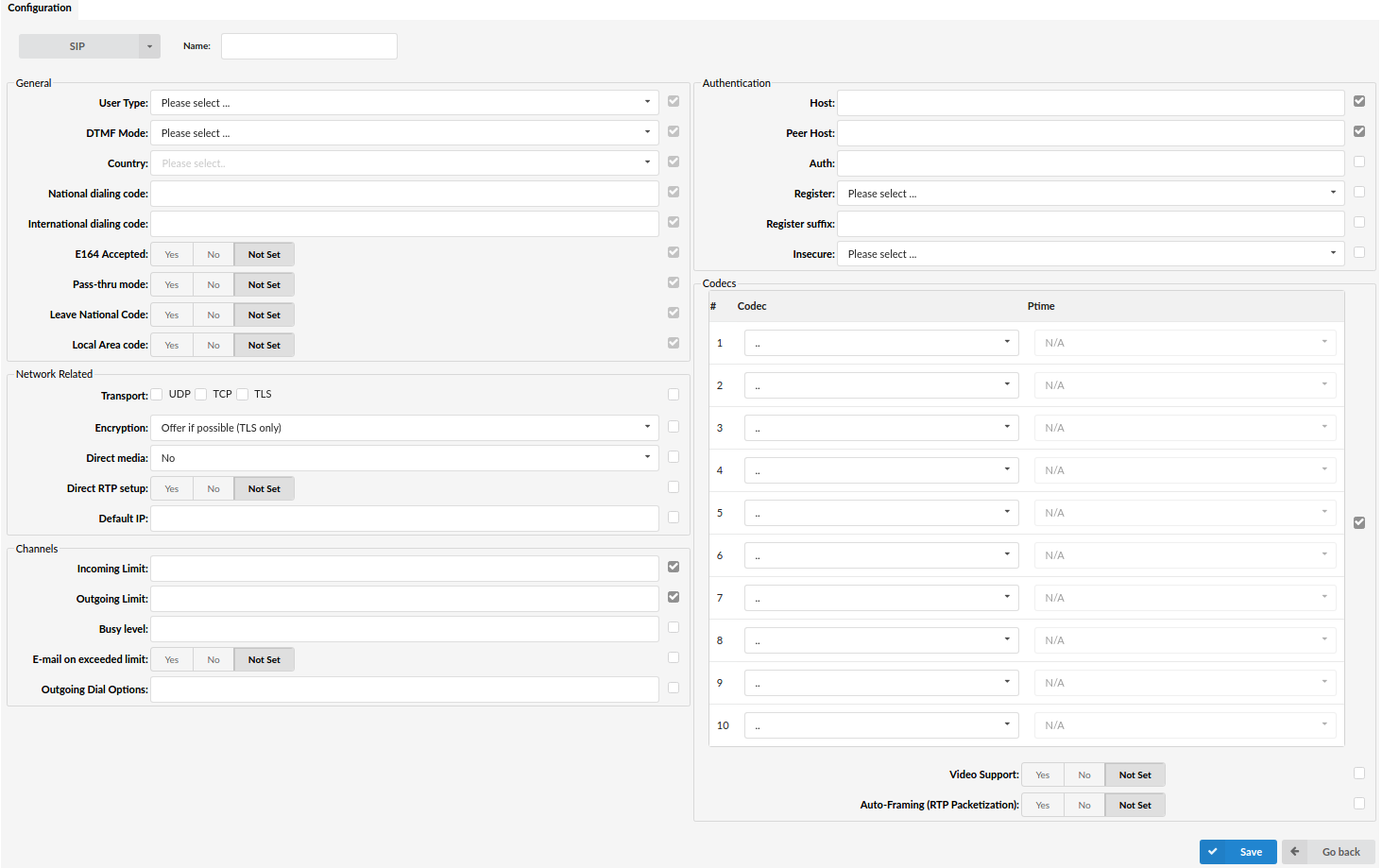
¶ General
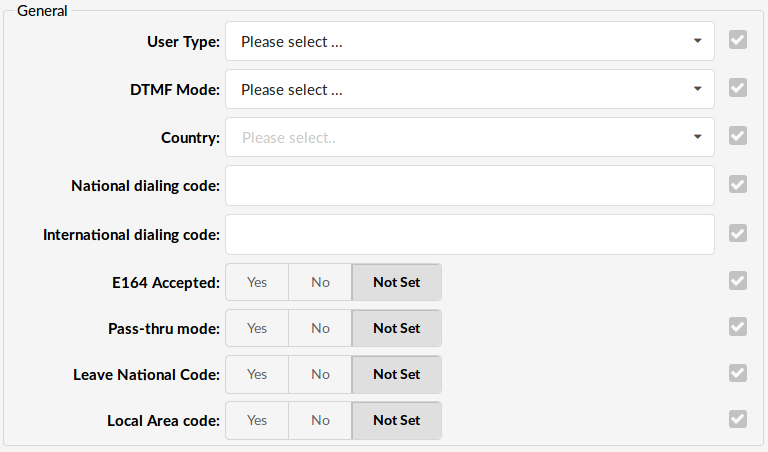
- User Type:
User's relationship to the system
- user - Provider accepts incoming calls only
- peer - Provider makes outgoing calls only
- friend - Provider does both incoming and outgoing calls
(Select box)
- DTMF Mode (Dual Tone Multi-Frequency):
DTMF mode used by the provider. A specific frequency (consisting of two separate tones) to each key so that it can easily be identified by a microprocessor
Example:
- inband - inband audio (requires 64 kbit codec - alaw, ulaw)
- rfc2833 - default
- info - SIP INFO messages
(Select box)
- Country:
Destination of the trunk connection
(E.g. USA)
(Select box)
- National Dialing Code:
National dialing code used at the Provider destination
(E.g. For USA 1, United Kingdom and Germany 0)
([0-9])
- International Dialing Code:
International dialing code used at the provider destination
(E.g. For USA 011, United Kingdom and Germany 00)
([0-9])
- E164 Accepted:
Does the trunk support dialing destinations in E164 format
(E.g. Enabling this option will reformat any dialed number into the following form COUNTRY_CODE+AREA_CODE+DIALED_NUMBER. E.g. If the user dials 55510205, system will dial 121255510205)
(Option buttons)
- Pass-thru Mode:
If this option is enabled, the number which is dialed is passed through trunk without modification
(Option buttons)
- Leave National Code:
In some countries, the national code is stripped automatically. If set to 'Yes', national code will not be stripped from the dialed number.
NOTE: Before settings this option to 'Yes', go to 'Settings: Servers' and enable this option as well.
(E.g. John dials 121255510205. With this option enabled national code won’t be stripped from the rest of the number.)
([0-9])
(Option buttons)
- Local Area Code:
Add a local area code to the dialed number if required by your service provider. (By default, local area code is stripped when dialing)
(E.g. User dials 55510205, local area code is 212. If the call goes through this trunk, PBXware will dial 21210205)
([0-9])
(Option buttons)
¶ Network Related
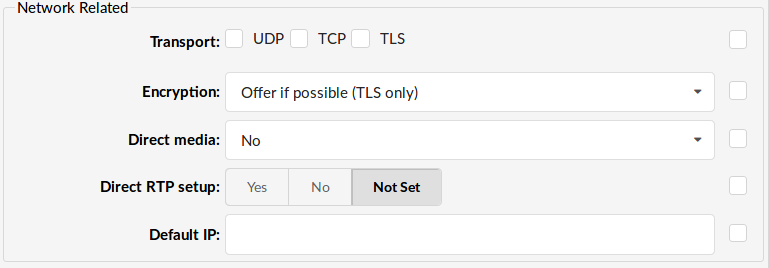
- Transport:
Type of transfer protocol that will be used on PBXware.
UDP (User Datagram Protocol) - is used primarily for establishing low-latency and loss-tolerating connections between applications on the internet. UDP enables process-to-process communication. With UDP, computer applications can send messages, in this case referred to as datagrams, and it is considered as a best-effort mode of communications. UDP is considered a connectionless protocol because it doesn't require a virtual circuit to be established before any data transfer occurs.
TCP (Transmission Control Protocol) - provides reliable, ordered, error-checked delivery of a stream of octets between programs running on computers connected to an intranet or the public Internet. TCP sends individual packets and is considered a reliable transport medium.
TLS (Transport Layer Security) - cryptographic protocol that provide communication security over the Internet.[1] They use asymmetric cryptography for authentication of key exchange, symmetric encryption for confidentiality, and message authentication codes for message integrity.
(Select box)
- Encryption:
This option enables or disables encryption in PBXware transport.
Offered options are:
- Offer if possible (TLS only)
Offers encryption only if it is possible and only with TLS protocol.
- Required
Encryption always required.
- Offer (TLS only)
Always offers encryption but only with TLS.
- Direct media:
Should you allow RTP voice traffic to bypass Asterisk.
Options:
- No - this option tells the Asterisk to never issue a reinvite to the client
- Yes - send reinvite to the client
- No NAT only - allow reinvite when local, deny reinvite when NAT
- Use UPDATE - use UPDATE instead of INVITE
- No NAT, Update - use UPDATE when local, deny when NAT
NOTE: All enhanced services for the extension have to be disabled
(E.g. Some devices do not support this, especially if one of them is behind a NAT)
(Option buttons / Select box)
- Direct RTP setup:
Here you can enable or disable the new experimental direct RTP setup.
Setting this value to yes sets up the call directly with media peer-2-peer without re-invites. Will not work for video and cases where the callee sends RTP payloads and fmtp headers in the 200 OK that does not match the callers INVITE. This will also fail if directmedia is enabled when the device is actually behind NAT.
(Option buttons)
- Default IP:
IP address to be used until registration
(E.g. 192.168.1.1)
(IP Address)
¶ Channels
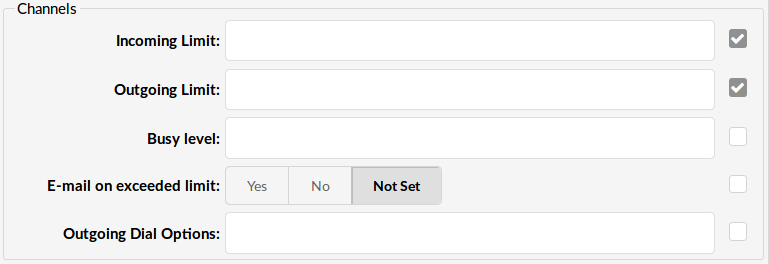
- Incoming Limit:
Number of simultaneous incoming calls that the Provider can handle
(E.g. 4 = four simultaneous incoming calls. Any additional calls will get the busy sound)
([0-9])
- Outgoing Limit:
Number of simultaneous outgoing calls that the Provider can handle
(E.g. 4 = four simultaneous outgoing calls. Any additional calls attempting to use this Provider will be rejected or will be redirected to other Providers depending on what is set in the system/extensions)
([0-9])
- Busy level:
Limits the number of concurrent incoming active calls.
- Apply Busy Level for Incoming Calls
Whether the busy level will be applied for Incoming calls.
(Option buttons)
- Busy destination for Incoming calls
If an extension has a Busy Level set and the Busy Level is matched then the system will try to contact the Busy Level Destination.
This option can be used only if the Busy level is set to Yes.
([0-9])
- Busy destination voicemail
Whether the busy level destination will be a voicemail.
(Option buttons)
- Email on exceeded limit
Send an e-mail when the incoming/outgoing limit is reached
(E.g. Yes, No, N/A)
(Option buttons)
- Outgoing Dial Options
Advanced dial options for all outgoing calls
By default this field is empty.
Note: Check below for a detailed list of all available dial options.
([a-z])
- Dial Options
- t - Allows the called user to transfer the call by hitting #
- T - Allows the calling user to transfer the call by hitting #
- r - Generates a ring tone for the calling party, passing no audio from the called channel(s) until one answers. Use with care and don't insert this by default into all of your dial statements as you are killing call progress information for the user. You probably do not need to use this. Asterisk will generate ring tones automatically where it is appropriate to do so. 'r' makes it go to the next step and additionally generates ring tones where it is probably not appropriate to do so.
- R - Indicates ringing to the calling party when the called party indicates ringing, pass no audio until answered. This is available only if you are using kapejod's bristuff.
- m - Provides Music on Hold to the calling party until the call is answered. This is mutually exclusive with option 'r'. Use m(class) to specify a class for the Music on Hold.
- o - Restores the Asterisk v1.0 Caller ID behavior (send the original caller's ID) in Asterisk v1.2 (default: send this extension's number)
- j - Asterisk 1.2 and later: Jump to priority n+101 if all of the requested channels are busy (just like in Asterisk 1.0.x)
- M (x) - Executes the macro (x) upon call connection (i.e. when the called party answers)
- h - Allows the called party to hang up by dialing *
- H - Allows the caller to hang up by dialing *
- C - Resets the CDR (Call Detail Record) for this call. This is like using the NoCDR command
- P (x) - Use the Privacy Manager, using x as the database (x is optional)
- g - When the called party hangs up, exit to execute more commands in the current context.
- G (contextextenpri) - If the call is answered, this transfers both parties to the specified priority. The calling party is transferred to priority x and the called party to priority x+1
- A (x) - Play an announcement (x.gsm) to the called party.
- S (n) - Hang up the call n seconds AFTER the called party picks up.
- d - This flag trumps the 'H' flag and intercepts any DTMF while waiting for the call to be answered and returns that value on the spot. This allows you to dial a 1-digit exit extension while waiting for the call to be answered - see also RetryDial
- D (digits) - After the called party answers, send digits as a DTMF stream, then connect the call to the originating channel.
- L (x[:y][:z]) - Limit the call to 'x' minutes, warning when 'y' minutes are left, repeated every 'z' minutes). Only 'x' is required, 'y' and 'z' are optional. The following special variables are optional for limited calls: (pasted from app_dial.c)
- + LIMIT_PLAYAUDIO_CALLER - yes|no (default yes) - Plays sounds to the caller.
- + LIMIT_PLAYAUDIO_CALLEE - yes|no - Plays sounds to the called party.
- + LIMIT_TIMEOUT_FILE - File to play when time is up.
- + LIMIT_CONNECT_FILE - File to play when the call begins.
- + LIMIT_WARNING_FILE - File to play as a warning if 'y' is defined. If LIMIT_WARNING_FILE is not defined, then the default behavior is to announce ('You have [XX minutes] YY seconds').
- f - forces CallerID to be set for the extension of the line making/redirecting the outgoing call. For example, some PSTNs don't allow Caller IDs for extensions other than the ones that are assigned to you.
- w - Allow the called user to start recording after pressing *1 or whatever is defined in features.conf, requires Set(DYNAMIC_FEATURES=automon)
- W - Allow the calling user to start recording after pressing *1 or whatever is defined in features.conf, requires Set(DYNAMIC_FEATURES=automon)
¶ Authentication
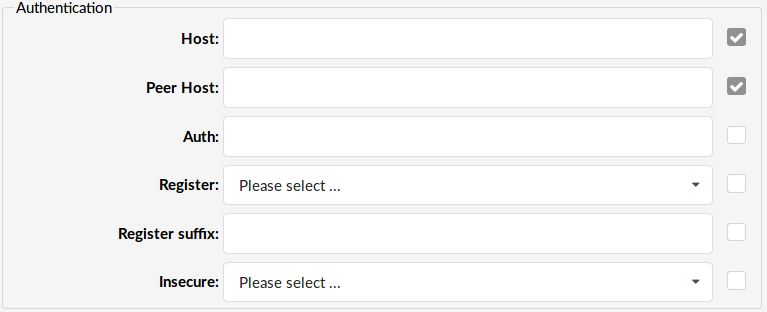
- Auth:
Global credentials for outbound calls, i.e. when a proxy challenges your PBXware for authentication these credentials override any credentials in peer/register definition if realm is matched.
(E.g. john:dfgERGf@pbxware)
([a-z][0-9])
- Incoming IP addresses (new line separated)
If your trunk provider has multiple IP addresses from which it is sending traffic, all those IP’s need to be listed here, new line separated.
- Register:
Method for registering to the remote server. Providers may require a different method of registration to their server. User can choose the following options:
- Not required
- With phone number
- With username
- With authname
- With authname@host
- With authname@trunk-name
(Select box)
- Register suffix:
Service provider may request different registration methods for their services. Select the proper method, as required by the provider
(E.g. 1234567)
([0-9])
- Insecure:
Which of the selected options are not used for authentication.
Example:
- Port - Ignores the port number where the request came from
- Invite - Does not require authentication of incoming INVITEs
- Port-Invite - Does not require initial INVITE to authenticate and ignore the port where the request came from
- Very - Ignore authentication (user/password)
(Select box)
- Register expiration time (sec)
How long the registration can take before the session expires.
(E.g. 10)
- Register max retries
How many times it is allowed to register.
¶ Codecs
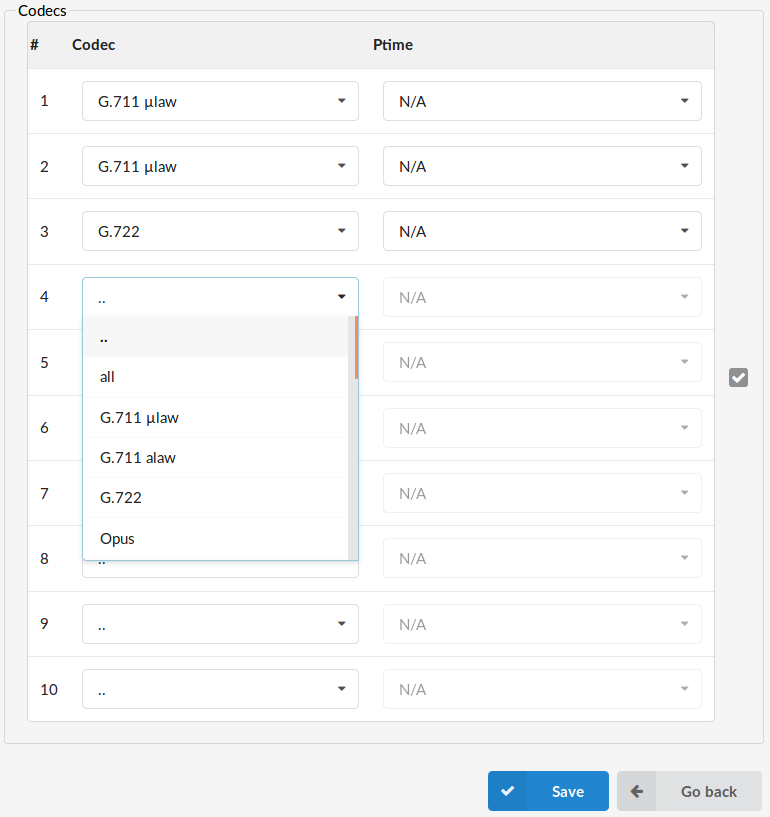
Available Codecs:
- ITU G.711 ulaw - 64 Kbps, sample-based, used in US
- ITU G.711 alaw - 64 Kbps, sample-based, used in Europe
- Opus
- ITU G.722
- ITU G.723.1 - 5.3/6.3 Kbps, 30ms frame size
- ITU G.726 - 16/24/32/40 Kbps
- ITU G.726 AAL2
- ITU G.729 - 8 Kbps, 10ms frame size
- GSM - 13 Kbps (full rate), 20ms frame size
- iLBC - 15Kbps,20ms frame size: 13.3 Kbps, 30ms frame size
- Speex - 2.15 to 44.2 Kbps
- SpeeX 16
- SpeeX 32
- LPC10 - 2.5 Kbps
- H.261 Video - Used over ISDN lines with resolution of 352x288
- H.263 Video - Low-bit rate encoding solution for video conferencing
- H.263+ Video - Extension of H.263 that provides additional features that improve compression over packet switched networks.
- H.264 Video - Offers great balance between quality and size
Note: If the H.264 codec is used for video calls, ensure that the H.264 Payload type on your UAD is set to 99 to match the Asterisk Payload type. Otherwise, you could encounter issues with video decoding.
Note: N/A means not available.
- Video Support:
This option enables or disables PBXware video support.
Note: PBXware natively supports SIP video but in order to use it, some settings will need to be enabled on the extension settings page as well as on the device itself.
(Option buttons)
- Auto-Framing (RTP Packetization)
Automatically adjust the RTP packet size with the registered device.
(Option buttons)
¶ Jitter Buffer
-
Jitter buffer
- Inherit - inherited jitter buffer settings from the tenant configuration.
- Fixed - Set a fixed jitter buffer on the channel.
- Adaptive - Set an adaptive jitter buffer on the channel.
- Disabled - Remove a previously set jitter buffer from the channel.
-
Max lenght (ms)
Length in milliseconds for the buffer. By default it is 200 ms.
- Re-sync threshold
The length in milliseconds over which a timestamp difference will result in resyncing the jitter buffer. By default it is 1000ms.
- Target extra
This only affects the adaptive jitter buffer. It represents the amount of time in milliseconds by which the new jitter buffer will pad its size. By default it is 40.
¶ IAX
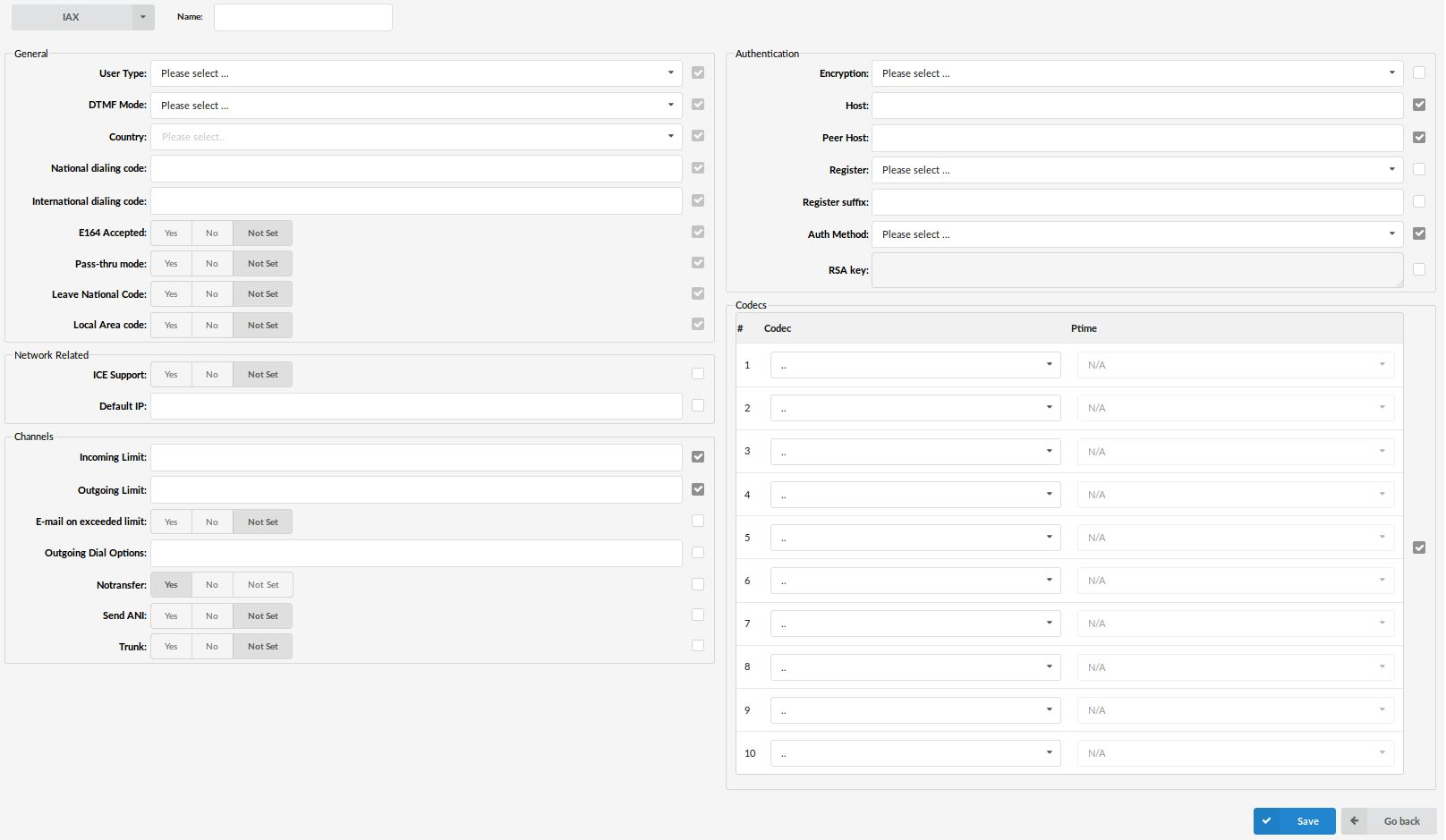
- User type:
User's relationship to the system
- user - Provider accepts incoming calls only
- peer - Provider makes outgoing calls only
- friend - Provider does both incoming and outgoing calls
(Select box)
- DTMF Mode (Dual Tone Multi-Frequency):
DTMF mode used by the provider. A specific frequency (consisting of two separate tones) to each key so that it can easily be identified by a microprocessor.
Example:
- inband - inband audio(requires 64 kbit codec - alaw, ulaw)
- rfc2833 - default
- info - SIP INFO messages
(Select box)
- Country:
Destination of the trunk connection.
(E.g. USA)
(Select box)
- National Dialing Code:
National dialing code used at the Provider destination
(E.g. For USA 1, United Kingdom, Germany 0)
([0-9])
- International Dialing Code:
International dialing code used at the provider destination
(E.g. For USA 011, United Kingdom, Germany 00)
([0-9])
- E164 Accepted:
Does the trunk support dialing destinations in the E164 format
(E.g. Enabling this option will reformat any dialed number into the following form COUNTRY_CODE+AREA_CODE+DIALED_NUMBER. E.g. If the user dials 55510205, system will dial 121255510205)
(Option buttons)
- Pass-thru Mode:
If this option is enabled, the number which is dialed is passed through the trunk without modification
(Option buttons)
- Leave National Code:
In some countries, the national code is stripped automatically. If set to 'Yes', the national code will not be stripped from the dialed number.
NOTE: Before setting this option to 'Yes', go to 'Settings: Servers' and enable this options as well.
(E.g. John dials 121255510205. With this option enabled)
([0-9])
(Option buttons)
- Local Area Code:
Add a local area code to the dialed number if required by your service provider. (By default, local area code is stripped when dialing)
(E.g. User dials 55510205, local area code is 212. If the call goes through this provider, PBXware will dial 21210205)
([0-9])
(Option buttons)
¶ Network Related

- Default IP:
IP address to be used until registration
(E.g. 192.168.1.1)
(IP Address)
¶ Channels
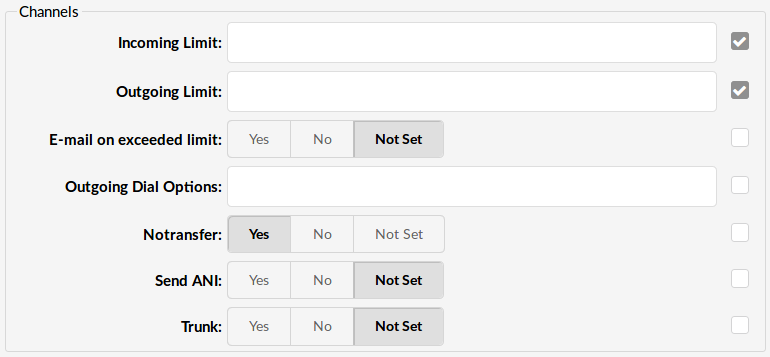
- Incoming Limit:
Number of simultaneous incoming calls that the Provider can handle
(E.g. 4 equals to four simultaneous incoming calls. Any additional calls will get the busy sound)
([0-9])
- Outgoing Limit:
Number of simultaneous outgoing calls the Provider can handle
(E.g. 4 equals to four simultaneous outgoing calls. Any additional calls attempting to use this Provider will be rejected or will be redirected to other Providers depending on what is set in the system/extensions)
([0-9])
- Busy level
Limits the number of concurrent incoming active calls.
- Apply Busy Level for Incoming Calls
Whether the busy level will be applied for Incoming calls.
(Option buttons)
- Busy destination for Incoming calls
If an extension has a Busy Level set and the Busy Level is matched then the system will try to contact the Busy Level Destination.
This option can be used only if the Busy level is set to Yes.
([0-9])
- Busy destination voicemail
Whether the busy level destination will be a voicemail.
(Option buttons)
- E-mail on exceeded limit
Send an e-mail when the outgoing limit is reached
(E.g. Yes, No, N/A)
(Option buttons)
- Outgoing Dial Options
Advanced dial options for all outgoing calls. By default this field is empty.
Note: Check below for a detailed list of all available dial options.
([a-z])
- Notransfer:
Disable native IAX transfer
(Option buttons)
- Send ANI:
ANI - Automatic number identification
Should ANI ("super" Caller ID) be sent over this Provider
(E.g. Set 'Yes' to enable)
(Option buttons)
- Trunk:
Use IAX2 trunking with this host
(E.g. Set 'Yes' to enable)
(Option buttons)
- Dial Options
- t - Allows the called user to transfer the call by hitting #
- T - Allows the calling user to transfer the call by hitting #
- r - Generates a ring tone for the calling party, passing no audio from the called channel(s) until one answers. Use with care and don't insert this by default into all of your dial statements as you are killing call progress information for the user. You probably do not need to use this. Asterisk will generate ring tones automatically where it is appropriate to do so. 'r' makes it go to the next step and additionally generates ring tones where it is probably not appropriate to do so.
- R - Indicates ringing to the calling party when the called party indicates ringing, pass no audio until answered. This is available only if you are using kapejod's bristuff.
- m - Provides Music on Hold to the calling party until the call is answered. This is mutually exclusive with option 'r'. Use m(class) to specify a class for the Music on Hold.
- o - Restores the Asterisk v1.0 Caller ID behavior (send the original caller's ID) in Asterisk v1.2 (default: send this extension's number)
- j - Asterisk 1.2 and later: Jump to priority n+101 if all of the requested channels are busy (just like in Asterisk 1.0.x)
- M (x) - Executes the macro (x) upon call connection (i.e. when the called party answers)
- h - Allows the called party to hang up by dialing *
- H - Allows the caller to hang up by dialing *
- C - Resets the CDR (Call Detail Record) for this call. This is like using the NoCDR command
- P (x) - Use the Privacy Manager, using x as the database (x is optional)
- g - When the called party hangs up, exit to execute more commands in the current context.
- G (contextextenpri) - If the call is answered, this transfers both parties to the specified priority. The calling party is transferred to priority x and the called party to priority x+1
- A (x) - Play an announcement (x.gsm) to the called party.
- S (n) - Hang up the call n seconds AFTER the called party picks up.
- d - This flag trumps the 'H' flag and intercepts any DTMF while waiting for the call to be answered and returns that value on the spot. This allows you to dial a 1-digit exit extension while waiting for the call to be answered - see also RetryDial
- D (digits) - After the called party answers, send digits as a DTMF stream, then connect the call to the originating channel.
- L (x[:y][:z]) - Limit the call to 'x' minutes, warning when 'y' minutes are left, repeated every 'z' minutes). Only 'x' is required, 'y' and 'z' are optional. The following special variables are optional for limited calls: (pasted from app_dial.c)
- + LIMIT_PLAYAUDIO_CALLER - yes|no (default yes) - Plays sounds to the caller.
- + LIMIT_PLAYAUDIO_CALLEE - yes|no - Plays sounds to the called party.
- + LIMIT_TIMEOUT_FILE - File to play when time is up.
- + LIMIT_CONNECT_FILE - File to play when the call begins.
- + LIMIT_WARNING_FILE - File to play as a warning if 'y' is defined. If LIMIT_WARNING_FILE is not defined, then the default behavior is to announce ('You have [XX minutes] YY seconds').
- f - forces CallerID to be set for the extension of the line making/redirecting the outgoing call. For example, some PSTNs don't allow Caller IDs for extensions other than the ones that are assigned to you.
- w - Allow the called user to start recording after pressing *1 or whatever is defined in features.conf, requires Set(DYNAMIC_FEATURES=automon)
- W - Allow the calling user to start recording after pressing *1 or whatever is defined in features.conf, requires Set(DYNAMIC_FEATURES=automon)
¶ Authentication
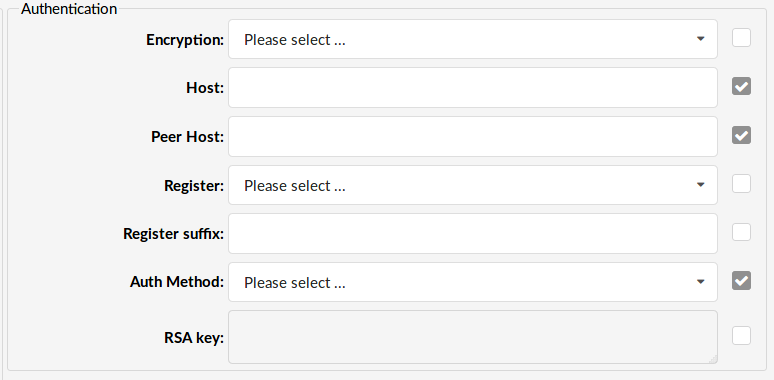
- Encryption:
Should the encryption be used when authenticating with the peer
(Select box)
- Host:
Provider IP address
( E.g. Enter host IP, 192.168.1.1 for example or set 'dynamic' if host is behind dynamic IP address)
([0-9][a-z])
- Peer Host:
IP of a peer host system sends the calls to
(E.g. 192.168.1.1)
((IP Address)
- Register:
Method for registering to the remote server Providers may require a different method of registration to their server. User can choose the following options:
(Select box)
- Register suffix:
Service provider may request different registration methods for their services. Select the proper method as required by the provider
(E.g. 1234567)
([0-9])
- Auth Method:
Authentication method required by provider.
The least secure is "plaintext", which sends passwords cleartext across the net.
"md5" uses a challenge/response md5 sum arrangement, but still requires both ends have plain text access to the secret.
"rsa" allows unidirectional secret knowledge through public/private keys. If "rsa" authentication is used, "inkeys" is a list of acceptable public keys on the local system that can be used to authenticate the remote peer, separated by the ":" character.
rs4
([a-z][0-9])
- RSA key:
RSA authentication key
(E.g. If Auth Method is set to RSA, then provide the RSA key here)
([a-z][0-9])
¶ Codecs
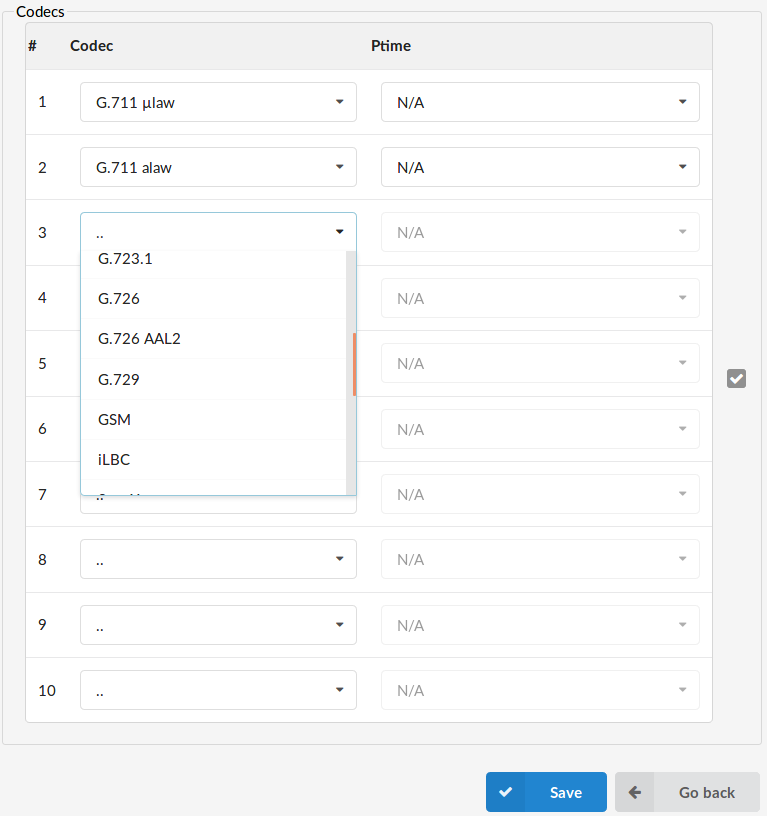
Available Codecs:
- ITU G.711 ulaw - 64 Kbps, sample-based, used in US
- ITU G.711 alaw - 64 Kbps, sample-based, used in Europe
- ITU G.722 - 48, 56 and 64 Kbps, sample-based
- Opus - 6 Kbps- 510 Kbps, five sampling rates from 8 kHz to 48 kHz
- ITU G.723.1 - 5.3/6.3 Kbps, 30ms frame size
- ITU G.726 - 16/24/32/40 Kbps
- ITU G.726 AAL2
- ITU G.729 - 8 Kbps, 10ms frame size
- GSM - 13 Kbps (full rate), 20ms frame size
- iLBC - 15Kbps,20ms frame size: 13.3 Kbps, 30ms frame size
- Speex - 2.15 to 44.2 Kbps
- SpeeX 16
- SpeeX 32
- LPC10 - 2.5 Kbps
- H.261 Video - Used over ISDN lines with resolution of 352x288
- H.263 Video - Low-bit rate encoding solution for video conferencing
- H.263+ Video - Extension of H.263 that provides additional features that improve compression over packet switched networks.
- H.264 Video - Offers great balance between quality and size
Note: If the H.264 codec is used for video calls, ensure that the H.264 Payload type on your UAD is set to 99 to match the Asterisk Payload type. Otherwise, you could encounter issues with video decoding.
Note: N/A means not available.
¶ Jitter Buffer
-
Jitter buffer
- Inherit - inherited jitter buffer settings from the tenant configuration.
- Fixed - Set a fixed jitter buffer on the channel.
- Adaptive - Set an adaptive jitter buffer on the channel.
- Disabled - Remove a previously set jitter buffer from the channel.
-
Max lenght (ms)
Length in milliseconds for the buffer. By default it is 200 ms.
- Re-sync threshold
The length in milliseconds over which a timestamp difference will result in resyncing the jitter buffer. By default it is 1000ms.
- Target extra This only affects the adaptive jitter buffer. It represents the amount of time in milliseconds by which the new jitter buffer will pad its size. By default it is 40.
¶ Single Sign-On
Single Sign-On (SSO) is an authentication process that allows users to access multiple applications or services using only one set of login credentials. The primary goal of SSO is to simplify the user experience by reducing the number of times a user has to log in when accessing different systems or services.
Providers

The Providers page displays all configured SSO providers, including the legacy Google and Microsoft integrations (which cannot be deleted) and any custom OIDC providers added through the Generic OIDC option. From this page, you can view each provider's status (enabled or disabled) and manage or remove custom OIDC entries.
- Add new provider:
Configuring the new SSO Generic OpenID Connect provider.
Note: The Generic OIDC Provider option supports Google, Microsoft, and other OIDC-compliant identity providers through a unified, configurable interface.
The legacy Google and Microsoft integrations remain available for backward compatibility.
The Generic OIDC Provider
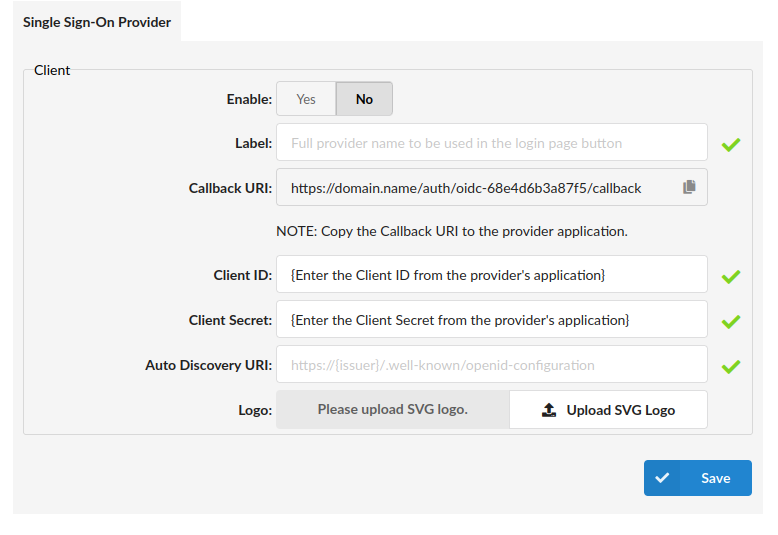
-
Enable:
Enable or disable the provider. When enabled, the provider will be displayed on the PBXware login page. -
Label:
Enter the label for the provider, which will appear on the login page. -
Callback URI:
The callback URI is automatically generated based on the server settings and must be used in the provider's application as a Redirect URL.
Note: The profile, openid, and email scopes must be selected on the provider's side when creating a new application.
-
Client ID:
Provide the Client ID obtained from the provider's application. -
Client Secret:
Provide the Client Secret obtained from the provider's application. -
Auto Discovery URI:
Fill out the Auto Discovery URI using the placeholder as a template, depending on the provider that is being configured.
Note: Some providers do not support the ./well-known/openid-configuration endpoint and cannot be configured.
- Logo:
Upload an SVG logo to display on the PBXware login page for this SSO option by clicking the "Upload SVG Logo" button.
Generic OpenID Connect providers can be edited and deleted, while the default Google and Microsoft Entra ID providers can only be edited.
NOTE: To log in using a Generic OIDC Provider configured on the system, select the "Sign in with other..." option on the login page.
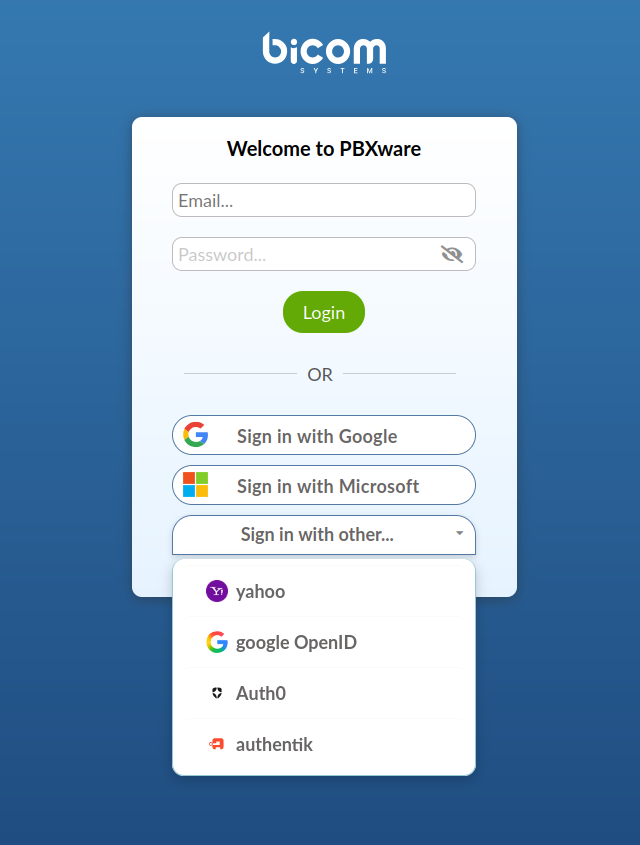
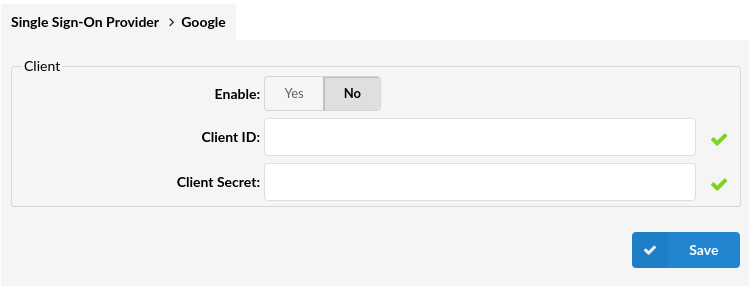
- Enable:
Enable the Google provider for Single Sign-On.
- Client ID:
The Client ID is obtained during the App configuration.
- Client Secret:
The Client Secret is obtained during the App configuration.
Microsoft Entra ID
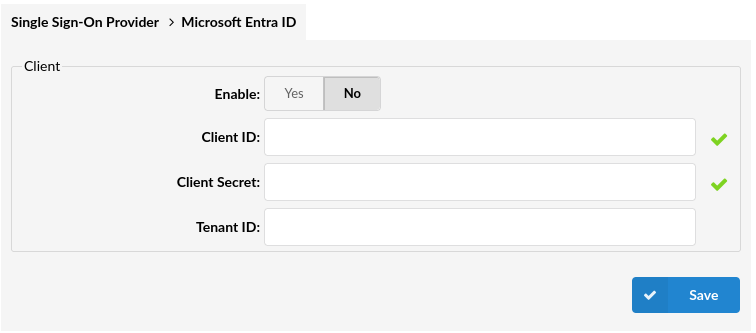
- Enable:
Enable the Microsoft Entra ID provider for Single Sign-On.
- Client ID:
The Client ID is obtained during the App configuration.
- Client Secret:
The Client Secret is obtained during the App configuration.
- Tenant ID:
Specify your Microsoft Entra ID Tenant ID, which can be copied from your Microsoft Entra ID instance. If left empty, the common tenant will be used, allowing users from any Microsoft Entra ID tenant to authenticate
¶ Default Trunks
The system uses its trunks to place calls to various destinations. In order to allow an organization to control its voice communications budget and to provide for termination backup, the default trunks allow setting primary, secondary, and tertiary trunks.
The system will use the primary trunk as its first choice for every destination called. If the primary trunk, for some reason, fails to terminate the call, the secondary trunk will be used by the system. If the secondary trunk, for some reason, fails to terminate the call, the tertiary trunk will be used by the system.
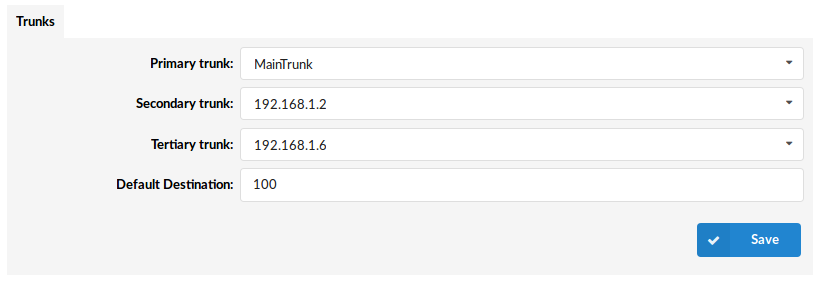
- Primary/Secondary/Tertiary Trunk:
Select default trunks on the system level.
(E.g. Service provider name)
(Select box)
NOTE: If the dialed number is busy, the system will recognize it and won't skip to other trunks in order to dial it.
- Default Destination:
Default destination to which trunks without a DID will be transferred
(E.g. If there is no DID for an incoming Trunk/Provider, all calls will be transferred to this system number (e.g. 2000)
([0-9])
Precedence
Setings:
- Default Trunks: All System calls go through the trunks defined here
- MiniLCR: Overrides 'Default Trunks' and sets a specific trunk for a destination
Extensions:
- Trunks: Overrides 'Settings: Default Trunks'
- Routes: Overrides 'Settings: MiniLCR'
¶ UAD
UADs (User Agent Devices) are various IP phones, softphones, ATA (Analog Telephone Adaptors), and IAD (Integrated Access Devices) used for system extensions. PBXware supports a wide range of UAD using SIP, IAX, MGCP, and DAHDI protocols.
Supported devices are already pre-configured with the most common settings in order to allow administrators an easy way of adding extensions. However, some PBXware installations have specific requirements, hence it is advisable to edit the selected UAD and set it to the required values. Additionally, if an installation needs to use an unlisted UAD, clicking on "Add User Agent" allows adding new UAD.
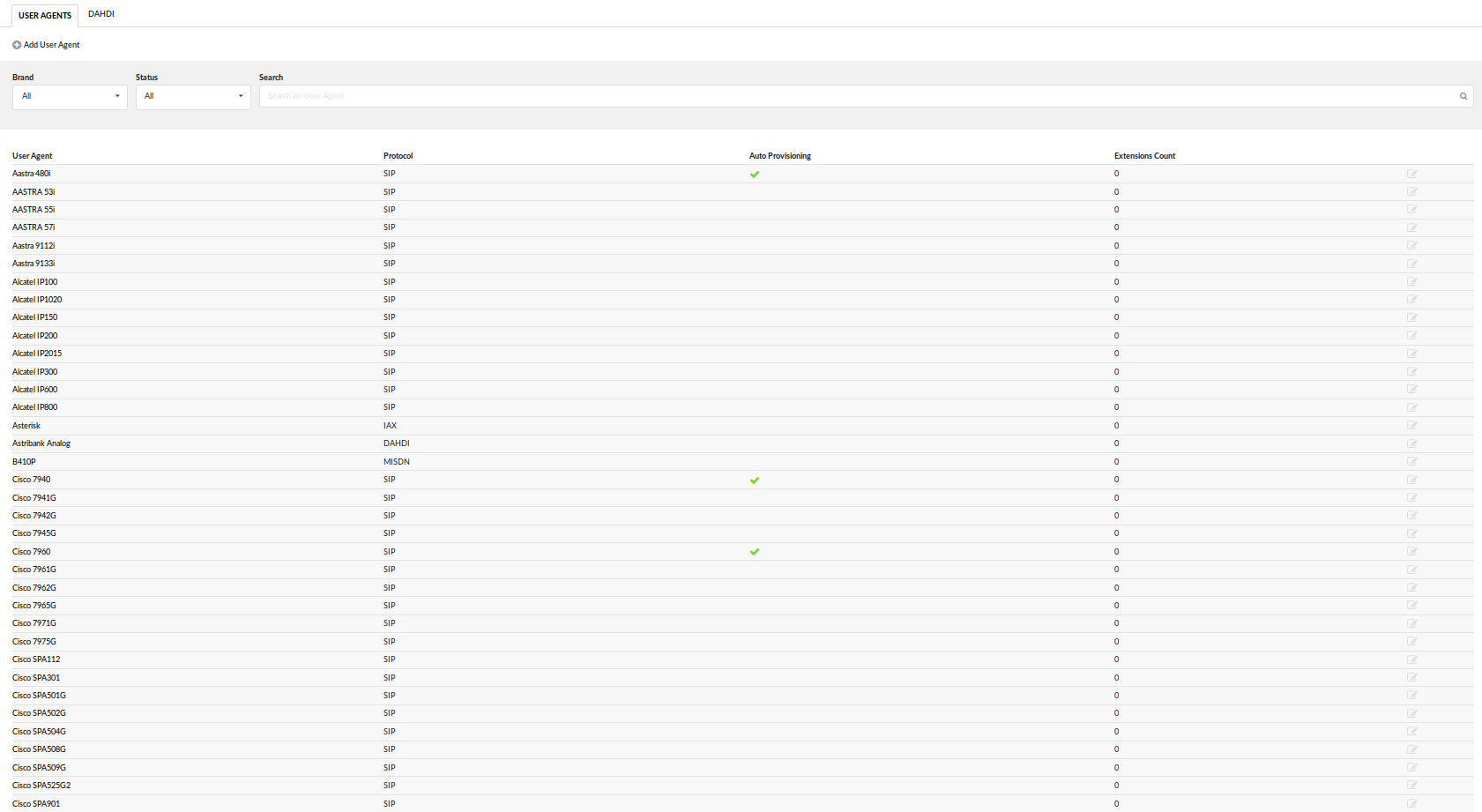
¶ Search
Searching through UADs is available in 3 ways:
- Brand - searching by the brands name
- Status - searching by the extension status on the network
- Search for user agent by typing its name
¶ End of Life
All end-of-life devices are now properly marked on the Bicom Systems Wikimedia site under the UAD section.
As for the PBXware GUI:
To view which devices are end-of-life, freely navigate to the Settings tab > select the UAD page and a selection box that says 'End of Life' will be shown. Simply choose 'Yes' if you wish to see the list of end-of-life devices.
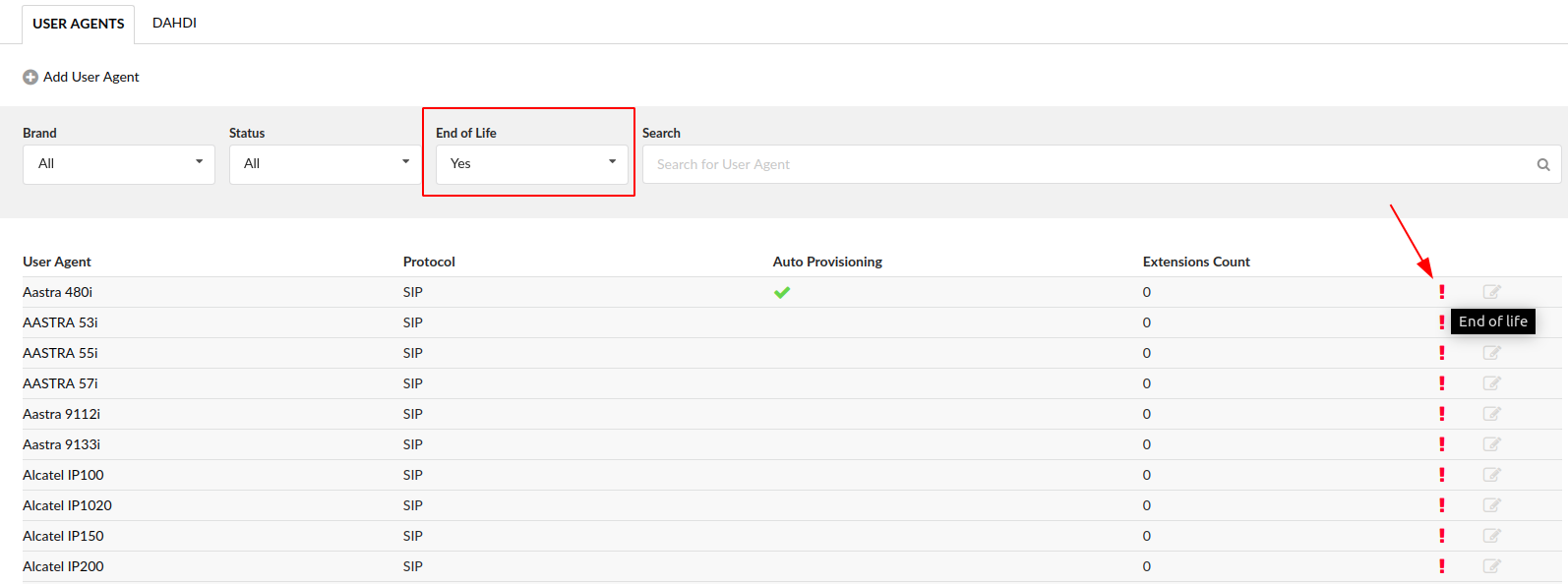
¶ Requirements
NOTE: With addition of multiple registration to a single extension, paging had to be modified. In PBXware 5 if more than one deskphone or third party softphone application is registered to a single PBXware extension at the same time, Speakerphone paging will be disabled for that extension. This is expected behavior and a tradeoff users must accept when registering more than one deskphone to their extension. Registration of Bicom Systems gloCOM applications, desktop and mobile, will not affect paging.
¶ Add/Edit
Click 'Add User Agent' to add a device or click on the 'Edit' icon next to one to change its settings.
- Protocol:
Select protocol UAD(User Agent Device) uses. Available options are SIP, IAX and DAHDI.
Note: Depending on the chosen protocol, adding/editing UAD will be different.
¶ SIP
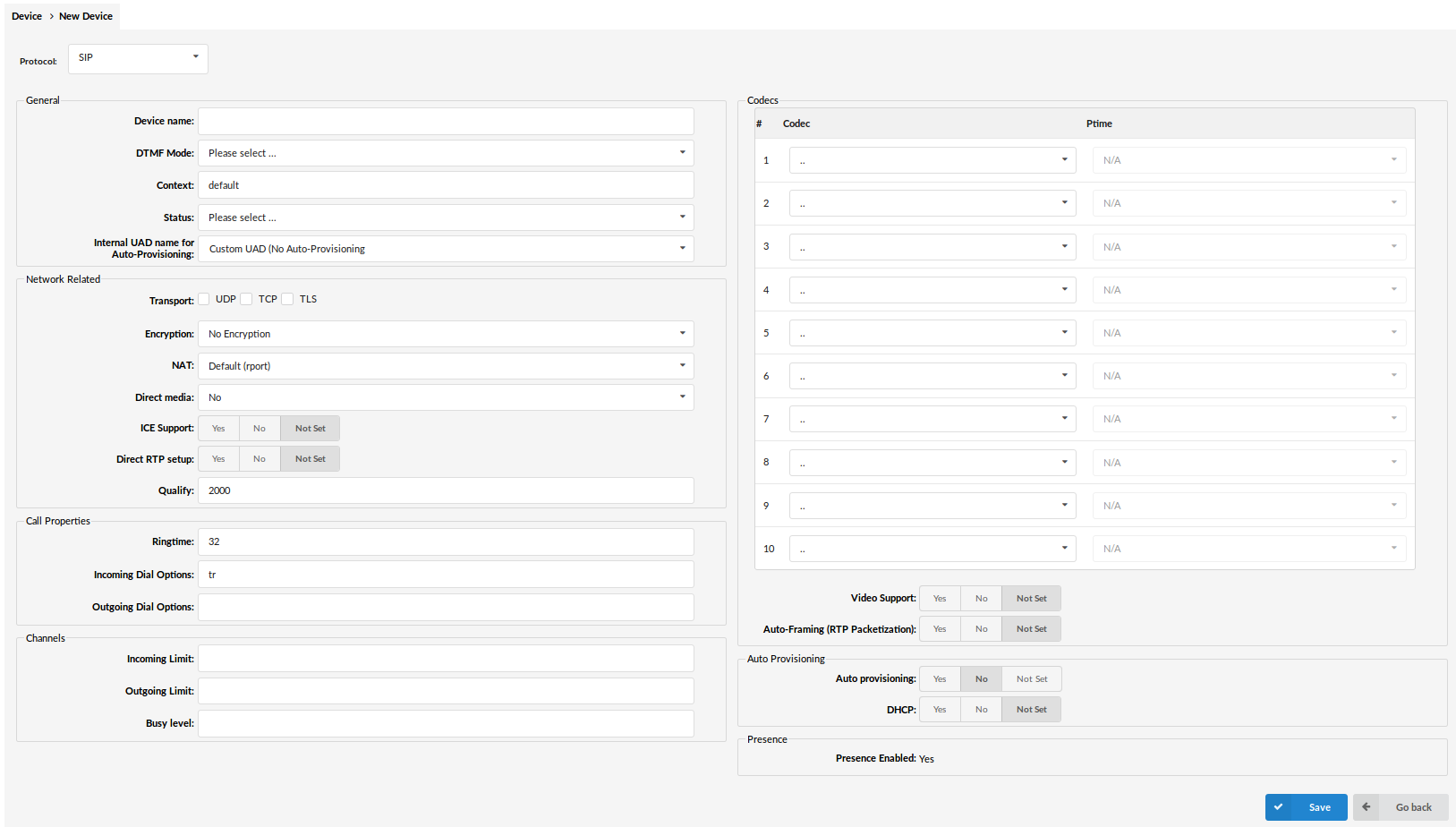
¶ General
- Device Name:
Unique device name
(E.g. Yealink VP59)
([a-z][0-9])
- DTMF Mode (Dual Tone Multi-Frequency):
A specific frequency consisting of two separate tones. Each key has a specific tone assigned to it so it can be easily identified by a microprocessor. Those are the tones generated on the keypad of your telephone device.
(E.g. Each phone has different 'DTMF Mode'. By default, this field is populated automatically for supported devices. If adding other UAD/Phone select between 'inband', 'rfc2833' or 'info' options.)
(Option buttons)
- Context:
Every system extension belongs to a certain system context. The context may be described as a collection/group of extensions. Default context used by the PBXware is 'default' and must not be used by custom extensions.
(E.g. default)
([a-z][0-9])
- Status:
Device status/presence on the network
If this field is set to 'Active', this UAD/Phone will be available in the 'UAD' select box by default when adding new extensions)
(Select box)
- Internal UAD name for Auto-Provisioning
This is where you define how the system will recognize the UAD internally
(E.g. yealink_vp59)
(Select box)
¶ Network Related
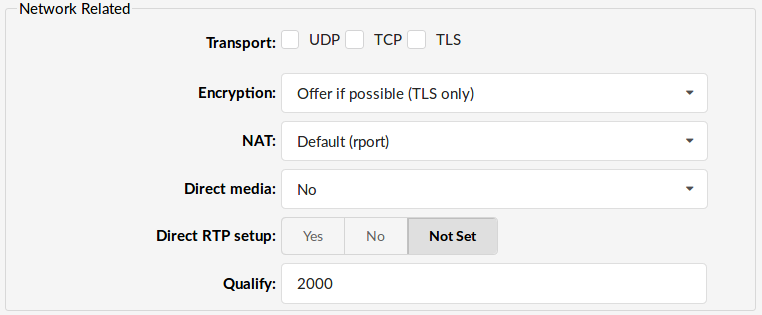
- Transport:
Type of transfer protocol that will be used on PBXware.
UDP (User Datagram Protocol) - is used primarily for establishing low-latency and loss-tolerating connections between applications on the internet.
UDP enables process-to-process communication. With UDP, computer applications can send messages, in this case referred to as datagrams, and is is considered a best-effort mode of communications. UDP is considered a connectionless protocol because it doesn't require a virtual circuit to be established before any data transfer occurs.
TCP (Transmission Control Protocol) - provides reliable, ordered, error-checked delivery of a stream of octets between programs running on computers connected to an intranet or the public Internet. TCP sends individual packets and is considered a reliable transport medium.
TLS (Transport Layer Security) - cryptographic protocol that provide communication security over the Internet.[1] It uses asymmetric cryptography for authentication of key exchange, symmetric encryption for confidentiality, and message authentication codes for message integrity.
(Checkbox)
- Encryption:
This option enables or disables encryption in PBXware transport.
Offered options are:
- Offer if possible (TLS only)
Offers encryption only if it is possible and only with TLS protocol.
- Required
Encryption always required.
- Offer (TLS only)
Always offers encryption but only with TLS.
- NAT (Network Address Translation):
Set the appropriate Extension - PBXware NAT relation
Example:
If Extension 1000 is trying to register with the PBXware from a remote location/network and that network is behind NAT, select the appropriate NAT settings here:
- Yes - Always ignore info and assume NAT
- No - Use NAT mode only according to RFC3581
- Default(rport) - force_rport - forces RFC 3581 behavior and disables symmetric RTP support
- Comedia RTP - enables RFC 3581 behavior if the remote side requests it and enables symmetric RTP support
(Option button)
- Direct media
This option tells the Asterisk server to never issue a reinvite to the client, if it is set to No.
Offered options:
- No
If this option is set to ‘No’ Asterisk will never issue a reinvite to the client.
- Yes
Asterisk will send reinvite to the client.
- No NAT only
- Yes UPDATE
- No NAT, Update
(Option button)
- Direct RTP setup:
Here you can enable or disable the new experimental direct RTP setup. Setting this value to yes sets up the call directly with media peer-2-peer without re-invites. Will not work for video and cases where the callee sends RTP payloads and fmtp headers in the 200 OK that does not match the callers INVITE. This will also fail if directmedia is enabled when the device is actually behind NAT.
(Option buttons)
- Qualify (ms)
Timing interval in milliseconds at which a 'ping' is sent to the UAD/Phone or trunk, in order to find out its status(online/offline).
Qualify is set to 8000 by default.
(E.g. Set this option to '2500' to send a ping signal every 2.5 seconds to the UAD/Phone or trunk.)
([0-9])
¶ Call Properties

- Area Code
Area code from which the UAD is operating.
(E.g. New York area code - 212)
- Ringtime (sec)
UAD/Phone ring time. This is a time in seconds that the UAD/Phone will ring before the call is considered unanswered.
Default value is 32 sec.
- Incoming Dial Options:
Advanced dial options for all incoming calls
Default value is tr.
(E.g. Please see below for a detailed list of all available dial options (default: tr))
Note: Please check below for a detailed list of all available dial options.
([a-z])
- Outgoing Dial Options:
Advanced dial options for all outgoing calls. Default value is empty.
Note: Please check below for a detailed list of all available dial options.
([a-z])
¶ Channels
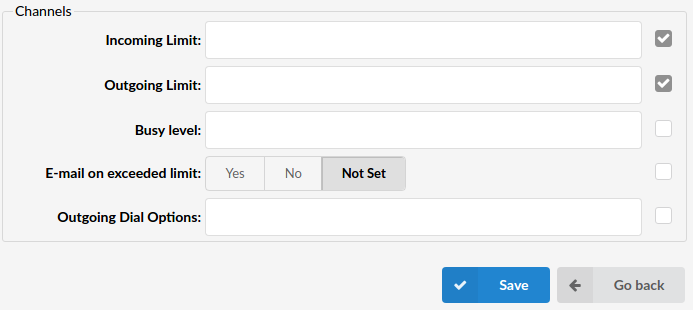
- Incoming Limit:
Maximum number of incoming calls
(E.g. 2)
([0-9])
- Outgoing Limit:
Maximum number of outgoing calls
(E.g. 2)
([0-9])
- Busy Level
Maximum number of concurrent incoming calls until user/peer is busy.
- Apply Busy Level for Incoming Calls
Whether the Busy level will be applied after the maximum number of concurrent incoming calls is reached.
(Option buttons)
- Busy destination for Incoming calls
Set the extension/number where the call will be redirected if busy level is applied.
(E.g. 101)
- Busy destination voicemail
Set ‘yes’ if you want to have voicemail as a busy destination.
(Option buttons)
¶ Codecs
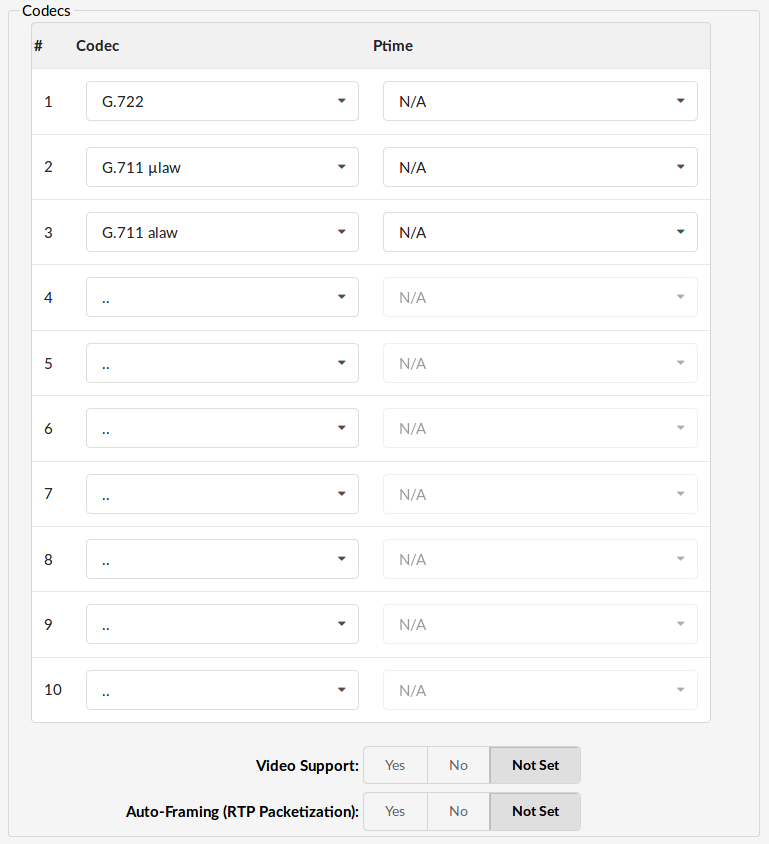
Set the codecs extension is allowed to use.
- Video Support
Set this option to Yes to enable SIP video support.
(Option buttons)
- Auto-Framing (RTP Packetization):
If autoframing is turned on, the system will choose packetization level based on remote ends preferences.
(E.g. Yes)
(Option buttons)
¶ Auto Provisioning

- Auto Provisioning:
Enable auto provisioning service for this particular model.
(E.g. Connect the UAD/Phone to PBXware without any hassle by providing the UAD/Phone MAC address (and optionally adding the Static UAD/Phone IP address and network details))
(Option buttons)
- DHCP (Dynamic Hosts Configuration Protocol):
Set whether the UAD/Phone is on a DHCP or a Static IP address
Set DHCP to ‘Yes’ if UAD/Phone is on a dynamic or DHCP to ‘No’ if UAD/Phone is on a static IP address. If on a static IP, you will have to provide more network details in the fields below.
(Option buttons)
¶ Presence

- Presence Enabled
Presence enables UAD to subscribe to hints which are used for BLF.
(Option buttons)
- Global Presence
(Option buttons)
¶ Additional Config
Additional configuration for Auto Provisioning on the following pages can use template variables.
- User Agent General Auto Provisioning Template
Here users can define custom configuration which will be served to all phones with the same model.
([a-z][0-9])
- User Agent Auto Provisioning Template:
This option is used for providing additional config parameters for SIP, IAX, and MGCP configuration files. Values provided here will be written into these configuration files.
([a-z][0-9])
The following variables can be used:
- %EXT_NUMBER% - Extension's Number
- %EXT_NAME% - Extension's Name
- %MAC_ADDRESS% - Extension's MAC address (the MAC from the auto provisioning request)
- %WAN_IP% - WAN Hostname/IP set in Servers > Edit
- %LAN_IP% - LAN Hostname/IP set in Servers > Edit
- %AUTH_USERNAME% - HTTP username
- %AUTH_PASSWORD% - HTTP username
- %VM_PIN% - Extension's voicemail PIN
- %EXT_SECRET% - Extension's Secret
- %EXT_LABEL% - Extension's Label
- %EXT_TITLE% - Extension's Title
¶ IAX
¶ General
- Device Name:
Unique device name
(E.g. AASTRA 480i)
([a-z][0-9])
- DTMF Mode (Dual Tone Multi-Frequency):
A specific frequency, consisting of two separate tones. Each key has a specific tone assigned to it so it can be easily identified by a microprocessor. Those are the tones generated on the keypad of your telephone device.
(E.g. Each phone has a different 'DTMF Mode'. By default, this field is populated automatically for supported devices. If adding another UAD/Phone select between 'inband', , 'rfc2833' or 'info' options)
(Option buttons)
- Context:
Every system extension belongs to a certain system context. Context may be described as a collection/group of extensions. The default context used by PBXware is 'default' and must not be used by custom extensions.
(E.g. default)
([a-z][0-9])
- Status:
Device status/presence on the network
(E.g. If this field is set to 'Active', this UAD/Phone will be available in the 'UAD' select box by default when adding new extensions)
(Select box)
¶ Network Related

- NAT (Network Address Translation)
Set the appropriate Extension - PBXware NAT relation.
If extension 1000 is trying to register with the PBXware from a remote location/network and that network is behind NAT, select the appropriate NAT settings here:
- yes - Always ignore info and assume NAT
- no - Use NAT mode only according to RFC3581
- Default (rport) - this setting forces RFC3581 behavior and disables symmetric RTP support.
- Comedia RTP - enables RFC3581 behavior if the remote side requests it and enables symmetric RTP support.
(Option buttons)
- Direct Media
This option tells the Asterisk server to never issue a reinvite to the client, if it is set to No. Select Yes if you want Asterisk to send reinvite to the client.
(Option button)
- Qualify (ms)
Timing interval in milliseconds at which a 'ping' is sent to a UAD/Phone or trunk in order to find out its status (online/offline).
In PBXware 6.0 'Qualify' is set to 8000 ms by default.
(E.g. Set this option to '2500' to send a ping signal every 2.5 seconds to UAD/Phone or trunk.)
([0-9])
¶ Call Properties

- Area Code:
Area code from which the UAD is operating.
(E.g. New York area code - 212)
- Ringtime (sec):
UAD/Phone ring time. This is a time in seconds that the UAD/Phone will ring before the call is considered unanswered.
(E.g. Time in seconds that the UAD/Phone will ring before the call is considered unanswered)
([0-9])
- Incoming Dial Options:
Advanced dial options for all incoming calls
The default value is 32s.
([a-z])
- Outgoing Dial Options:
Advanced dial options for all outgoing calls. Default value is empty.
Note: Please check below for a detailed list of all available dial options.
([a-z])
¶ Channels
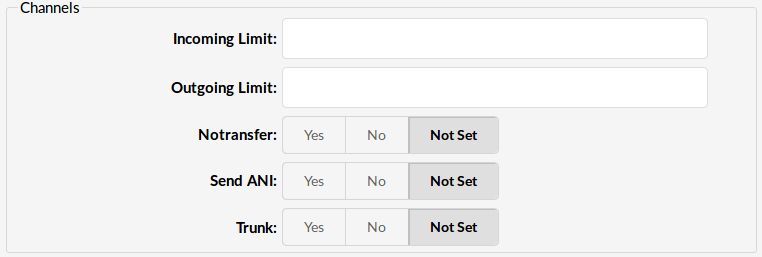
- Incoming Limit:
Maximum number of incoming calls
(E.g. 2)
([0-9])
- Outgoing Limit:
Maximum number of outgoing calls
(E.g. 2)
([0-9])
- Notransfer:
Disable native IAX transfer
(Option buttons)
- Send ANI:
ANI - Automatic number identification
Should ANI ("super" Caller ID) be sent over this Provider
(Option buttons)
- Trunk:
Use IAX2 trunking with this host
(Option buttons)
¶ Authentication

- Auth Method:
Which authentication method required by the provider
none - uses no authentication
plaintext - uses a plain text as an authentication
md5 - uses a challenge/response md5 sum arrangement, but still requires both ends have plain text access to the secret
rc4
rsa - allows unidirectional secret knowledge through public/private keys. If "rsa" authentication is used, "inkeys" is a list of acceptable public keys on the local system that can be used to authenticate the remote peer, separated by the ":" character
([a-z][0-9])
¶ Codecs

Set the codecs extension is allowed to use. N/A means ‘Not allowed’.
¶ Auto Provisioning
- Auto Provisioning:
Enable auto provisioning service for this particular model.
(E.g. Connect the UAD/Phone to PBXware without any hassle by providing the UAD/Phone MAC address (and optionally adding the Static UAD/Phone IP address and network details))
(Option buttons)
- DHCP (Dynamic Hosts Configuration Protocol):
Set whether the UAD/Phone is on a DHCP or a Static IP address
Set DHCP to ‘Yes’ if UAD/Phone is on a dynamic or DHCP to ‘No’ if UAD/Phone is on a static IP address. If on a static IP, you will have to provide more network details in the fields below.
(Option buttons)

¶ Presence

- Presence Enabled
Presence enables UAD to subscribe to hints which are used for BLF.
(Option buttons)
- Global Presence
(Option buttons)
¶ Additional Config
Additional configuration for Auto Provisioning on the following pages can use template variables.
- User Agent General Auto Provisioning Template
Here users can define custom configuration which will be served to all phones with the same model.
([a-z][0-9])
- User Agent Auto Provisioning Template:
This option is used for providing additional config parameters for SIP, IAX, and MGCP configuration files. Values provided here will be written into these configuration files.
([a-z][0-9])
The following variables can be used:
- %EXT_NUMBER% - Extension's Number
- %EXT_NAME% - Extension's Name
- %MAC_ADDRESS% - Extension's MAC address (the MAC from the auto provisioning request)
- %WAN_IP% - WAN Hostname/IP set in Servers > Edit
- %LAN_IP% - LAN Hostname/IP set in Servers > Edit
- %AUTH_USERNAME% - HTTP username
- %AUTH_PASSWORD% - HTTP username
- %VM_PIN% - Extension's voicemail PIN
- %EXT_SECRET% - Extension's Secret
- %EXT_LABEL% - Extension's Label
- %EXT_TITLE% - Extension's Title
¶ DAHDI
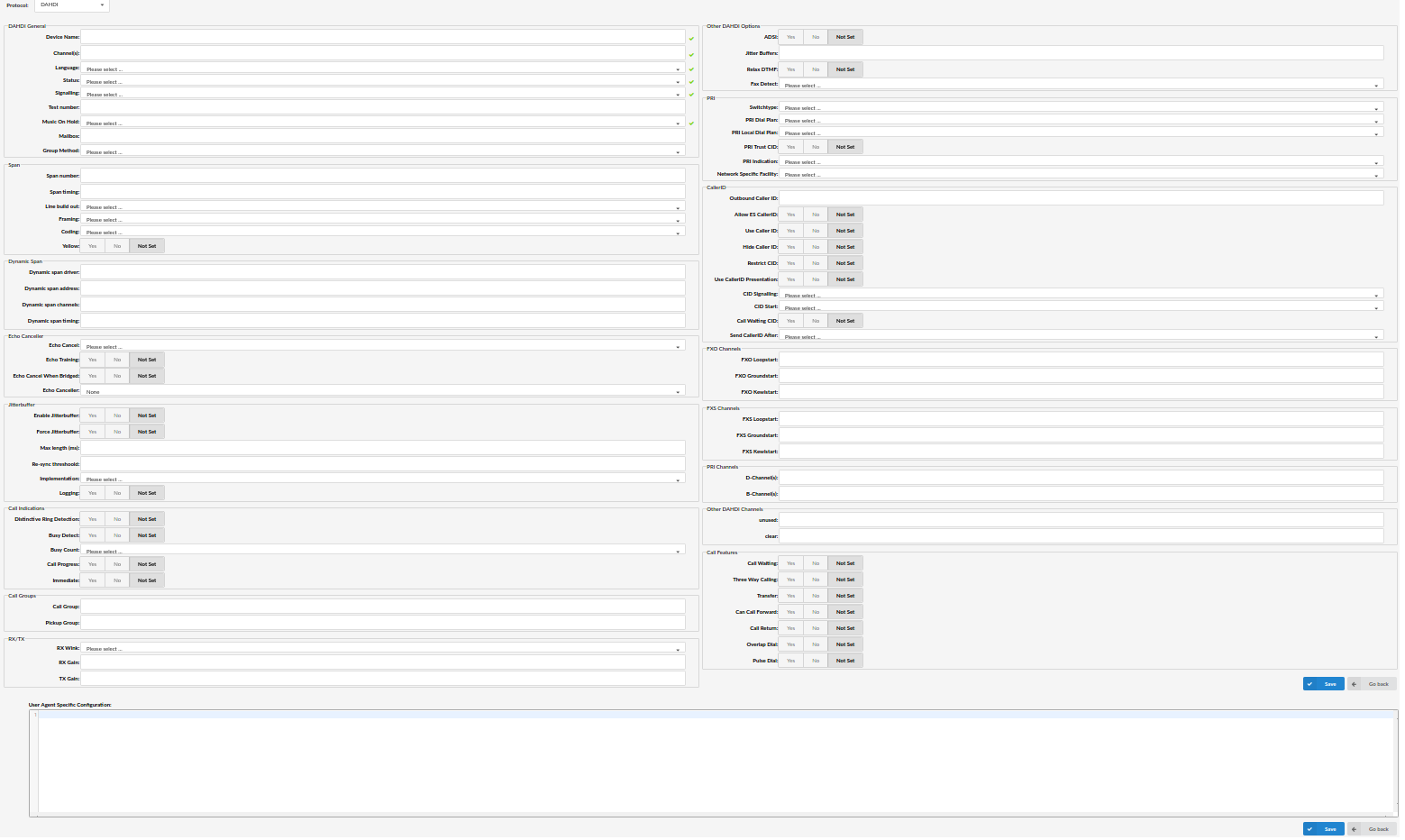
- Device Name:
Unique device name
(E.g. AASTRA 480i)
([a-z][0-9])
- Channels
Which card channels are used
(E.g. 1,4/1-4)
- Language:
Default language
(Select Box)
- Status:
Device status/presence on the network
(E.g. If this field is set to 'Active', this UAD/Phone will be available in the 'UAD' select box by default when adding new extensions)
(Select box)
- Signalling:
Signalling method
Available choices:
- E&M
- E&M Wink
- FXS Loopstart
- FXS Groundstart
- FXS Kewlstart
- FXO Loopstart
- FXO Groundstart
- FXO Kewlstart
- PRI CPE side
- PRI Network side
- BRI Network side
- BRI CPE PTMP
- BRI Network PTMP
(Select box)
- Test Number:
This number is used for trunk monitoring in Monitor->Monitor Settings->Monitor Trunks.
- Music On Hold:
Select which class of music to use for music on hold. If not specified the 'default' will be used
(Select box)
- Mailbox:
Define a voicemail context
(E.g. 1234, 1234@context)
([a-z][0-9])
- Group Method:
It specifies which group to dial, and how to choose a channel to use in the specified group. The four possible options are:
- g: select the lowest-numbered non-busy DAHDI channel (aka. ascending sequential hunt group).
- G: select the highest-numbered non-busy DAHDI channel (aka. descending sequential hunt group).
- r: use a round-robin search, starting at the next highest channel than last time (aka. ascending rotary hunt group).
- R: use a round-robin search, starting at the next lowest channel than last time (aka. descending rotary hunt group).
¶ PRI
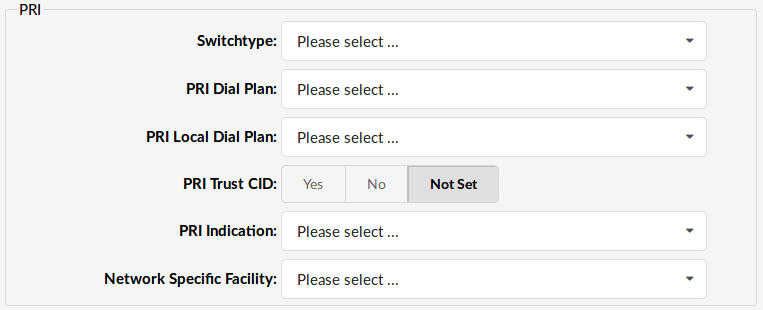
PRI - Primary Rate Interface
- Switchtype:
Set switch type
Supported switch types:
- National ISDN 2
- Nortel DMS100
- AT&T 4ESS
- Lucent 5ESS
- EuroISDN
- Old National ISDN 1
- Q.SIG
(Select box)
- PRI Dial Plan:
The ISDN-level Type Of Number (TON) or numbering plan, used for the dialed number. For most installations, leaving this as 'unknown' (the default) works in the most cases.
Set dial plan used by some switches
Available options:
- Unknown
- Private ISDN
- Local ISDN
- National ISDN
- International ISDN
(Select box)
- PRI Local Dial Plan:
Set numbering dial plan for destinations called locally
Available options:
- Unknown
- Private ISDN
- Local ISDN
- National ISDN
- International ISDN
(Select box)
- PRI Trust CID:
Trust provided caller id information
(Option buttons)
- PRI Indication:
How to report 'busy' and 'congestion' on a PRI
- outofband - Signal Busy/Congestion out of band with RELEASE/DISCONNECT
- inband - Signal Busy/Congestion using in-band tones
(Select box)
- Network Specific Facility:
If required by switch, select network specific facility
- none
- sdn
- megacom
- accunet
(Select box)
¶ Caller ID
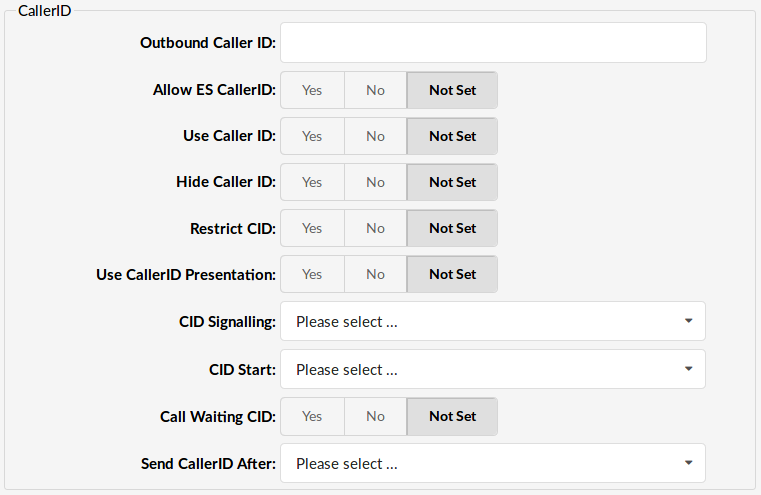
- Outbound Caller ID:
Caller ID set for all outbound calls where Caller ID is not set or supported by a device
(E.g. john@domain.com)
([0-9])
- Allow ES Caller ID:
Should the ES (Enhanced Services) Caller ID be allowed on this UAD.
NOTE: Caller ID can only be transmitted to the public phone network with supported hardware, such as a PRI. It is not possible to set external caller ID on analog lines
(E.g. 'asreceived', 555648788)
([a-z][0-9])
- Use Caller ID:
Whether or not to use caller ID
(Option buttons)
- Hide Caller ID:
Whether or not to hide outgoing caller ID
(Option buttons)
- Restrict CID
Whether or not to use the caller ID presentation for the outgoing call that the calling switch is sending
(Option buttons)
- Use CallerID Presentation:
Whether or not to use the caller ID presentation from the Asterisk channel for outgoing calls.
(Option buttons)
- CID Signalling:
Set the type of caller ID signalling
Example:
- bell - US
- v23 - UK
- dtmf - Denmark, Sweden and Netherlands
(Select box)
- CID Start:
What signals the start of caller ID
Example:
- ring = a ring signals the start
- polarity = polarity reversal signals the start
(Select box)
- Call Waiting CID:
Whether or not to enable call waiting on FXO lines
(Option buttons)
- Send CallerID After:
Some countries, like UK, have different ring tones (ring-ring), which means the caller id needs to be set later on, and not just after the first ring, as per the default.
(Select box)
¶ Echo Canceler

- Echo Cancel:
Enable/disable echo cancellation. It is possible to choose echo cancellation between 32, 64, 128 and 256 ms echo delays.
(Select box)
- Echo Training:
Mute the channel briefly, for 400ms, at the beginning of conversation, cancelling the echo. (Use this only if 'Echo Cancel' doesn't work as expected)
(Option buttons)
- Echo Cancel When Bridged:
Enable echo cancellation when bridged. Generally not necessary, and in fact undesirable, to echo cancel when the circuit path is entirely TDM
(Option buttons)
- Echo Canceller:
Types of echo cancellers:
- mg2
- oslec
- kb1
or none.
¶ Call Features
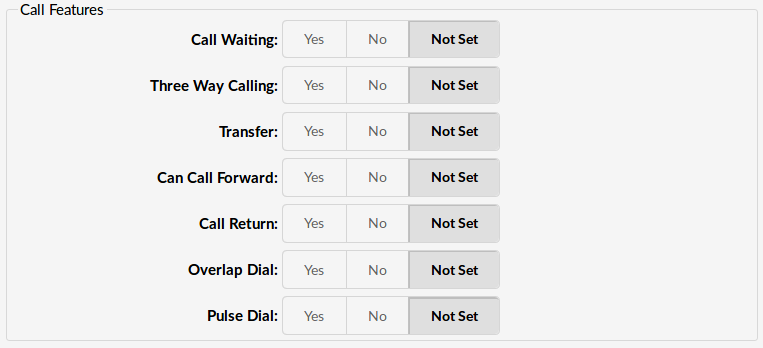
- Call Waiting:
Whether or not to enable call waiting on FXO lines
(Option buttons)
- Three Way Calling:
Support three-way calling. If enabled, call can be put on hold and you are able to make another call
(Option buttons)
- Transfer:
Support call transfer and also enable call parking.
Note: This option requires ‘Three Way Calling’ to be set to ‘Yes’.
(Option buttons)
- Can Call Forward:
Set this to ‘Yes’ to enable call forwarding.
(Option buttons)
- Call Return:
Whether or not to support Call Return. If this is set to ‘Yes’, when the user dials ‘*69’ the system calls last caller extension number.
(Option buttons)
- Overlap Dial:
Enable overlap dialing mode (sends overlap digits)
With overlap dial set to ‘No’, the gateway expects to receive the digits one right after the other coming in to this line with very little delay between digits. With overlap dial set to ‘Yes’ the device waits between digits.
(Option buttons)
- Pulse Dial:
Use pulse dial instead of DTMF. Used by FXO (FXS signalling) devices
(Option buttons)
¶ Call Indications
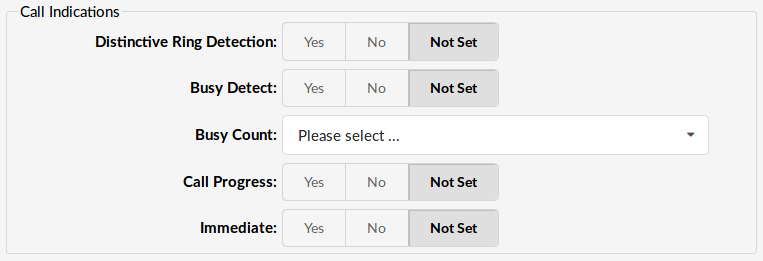
- Distinctive Ring Detection:
Whether or not to allow distinctive ring detection on FXO lines
(Option buttons)
- Busy Detect:
Enable listening for the beep-beep busy pattern
(Option buttons)
- Busy Count:
How many busy tones to wait before hanging up. Bigger settings lower the probability of random hangups.
Note: For this to work 'Busy Detect' has to be enabled
Possible options:
- 4
- 6
- 8
(Select box)
- Call Progress:
Easily detect false hangups
(Option buttons)
- Immediate:
Should channel be answered immediately or the simple switch should provide dialtone, read digits, etc
(Option buttons)
¶ Call Groups

- Call Group:
Set the Call Group to which the extension belongs.
(E.g. Similar to 'Context' grouping, only this option sets to which call group extension belongs(Allowed range 0-63))
([0-9][,-])
- Pickup Group:
Set groups extension as allowed to pickup.
(E.g. Similar to 'Context' grouping, only this option sets the Call Groups extension as allowed to pickup by dialing '*8'.)
([0-9][,-])
¶ RX/TX

TX and RX are abbreviations for Transmit and Receive.
- RX Wink:
Set timing parameters
Example:
- Pre-wink (50ms)
- Pre-flash (50ms)
- Wink (150ms)
- Receiver flashtime (250ms)
- Receiver wink (300ms)
- Debounce timing (600ms)
(Select box)
- RX Gain:
Receive signal decibel value.
(E.g. 2)
([0-9])
- TX Gain:
Transmit signal decibel value.
(E.g. 2)
([0-9])
¶ Other DAHDI Options

- ADSI (Analog Display Services Interface):
Enable remote control of screen phone with softkeys. (Only if you have ADSI compatible CPE equipment)
(Option buttons)
- Jitter Buffers:
Configure (set the number of) jitter buffers. Each one is 20ms long.
(E.g. 4)
([0-9])
- Relax DTMF:
If you are having trouble with DTMF detection, you can relax the DTMF detection parameters by setting this option to Yes.
(Option buttons)
- Fax Detect:
Enable fax detection
Possible options:
- both
- incoming
- outgoing
- no
(Select box)
¶ Span
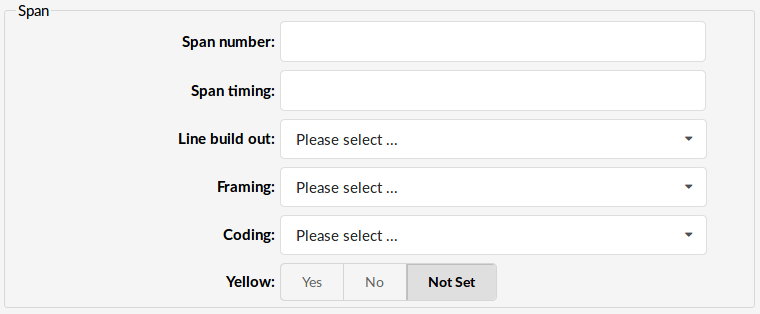
- Span number:
Number of the span
(E.g. 1)
([0-9])
- Span timing:
How to synchronize the timing devices
Example:
- 0 - do not use this span as a sync source
- 1 - use as the primary sync source
- 2 - set as the secondary, and so forth
([a-z])
- Line build out:
Length of the last leg of the connection and is set to zero if the length is less than 133 feet
Example:
- 0 db (CSU) / 0-133 feet (DSX-1)
- 133-266 feet (DSX-1)
- 266-399 feet (DSX-1)
- 399-533 feet (DSX-1)
- 533-655 feet (DSX-1)
- -7.5db (CSU)
- -15db (CSU)
- -22.5db (CSU)
(Select box)
- Framing:
How to communicate with the hardware at the other end of the line
Example:
- For T1: Framing is one of d4 or esf.
- For E1: Framing in one of cas or ccs.
(Select box)
- Coding:
How to encode the communication with the other end of line hardware.
Example:
- For T1: coding is one of ami or b8zs
- For E1: coding is one of ami or hdb3 (E1 may also need crc)
(Select box)
- Yellow:
Whether the yellow alarm is transmitted when no channels are open.
(E.g. Yes, No, N/A)
(Option buttons)
¶ Dynamic Span

- Dynamic span driver:
The name of the driver (e.g. eth)
([0-9][a-z])
- Dynamic span address:
Driver specific address (like a MAC for eth).
([0-9][a-z])
- Dynamic span channels:
Number of channels.
(E.g. 6)
([0-9])
- Dynamic span timing:
Sets timing priority, like for a normal span. Use "0" in order not to use this as a timing source, or prioritize them as primary, secondary, etc.
(E.g. 0)
([0-9])
¶ FXO Channels

FXO - Foreign Exchange Office.
- FXO Loopstart:
Channel(s) are signalled using FXO Loopstart protocol
Note: Check the values below.
([0-9])
- FXO Groundstart:
Channel(s) are signalled using FXO Groundstart protocol
Note: Check the values below.
([0-9])
- FXO Kewlstart:
Channel(s) are signalled using FXO Kewlstart protocol
Note: Check the values below.
([0-9])
Values for above fields are set as follows:
- 1 - for one card
- 1-2 - for two cards
- 1-3 - for three cards etc
- 2-3 (If your card has modules in this order FXS, FXO, FXO, FXS)
¶ FXS Channels

FXS - Foreign Exchange Subscriber
- FXS Loopstart:
Channel(s) are signalled using FXS Loopstart protocol
Note: Check the values below.
([0-9])
- FXS Groundstart:
Channel(s) are signalled using FXS Groundstart protocol
Note: Check the values below.
([0-9])
- FXS Kewlstart:
Channel(s) are signalled using FXS Kewlstart protocol
Note: Check the values below.
([0-9])
Values for the above fields are set as follows:
- 1 - for one card
- 1-2 - for two cards
- 1-3 - for three cards etc
- 2-3 (If your card has modules in this order FXS, FXO, FXO, FXS)
¶ PRI Channels
PRI uses B and D channels. B channels are used to carry the voice calls and D channel for signaling.
- D-Channel(s):
Set the number of D-Channel(s).
([0-9])
- B-Channel(s):
Set the number of B-Channel(s).
([0-9])
¶ Jitter Buffer
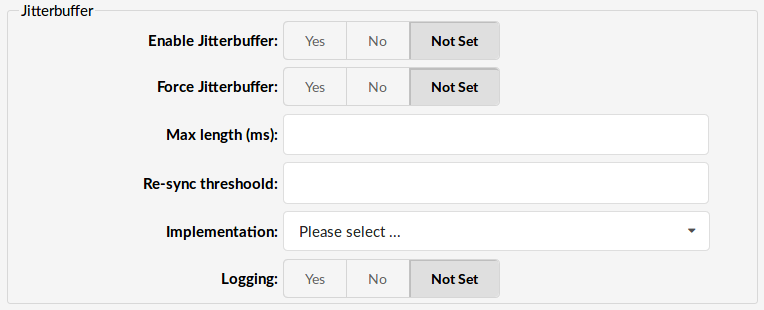
A jitter buffer temporarily stores arriving packets in order to minimize delay variations. If packets arrive too late then they are discarded. A jitter buffer may be mis-configured and be either too large or too small.
- Enable Jitterbuffer:
Enables the use of a jitterbuffer on the receiving side of a SIP channel. An enabled jitterbuffer will be used only if the sending side can create and the receiving side cannot accept jitter. The SIP channel can accept jitter, thus a jitterbuffer on the receive SIP side will be used only if it is forced and enabled.
(Option buttons)
- Force Jitterbuffer:
Should we force jitter buffer.
NOTE: Jitter buffer is usually handled by the UADs/Phones. If this operation is done poorly, the jitter buffer can also be enforced on the PBXware side.
(Option buttons)
- Max length (ms):
Max length of the jitterbuffer in milliseconds.
(E.g. 300)
([0-9])
- Re-sync threshold:
Resync the threshold for noticing a change in delay measured
(E.g. 1000)
([0-9])
- Implementation:
Jitter buffer implementation used on a receiving side of a SIP channel. Defaults to "fixed".
(E.g. adaptive)
(Select box)
- Target extra
- Logging:
Enables jitterbuffer frame logging. Defaults to "no".
(E.g. Yes, No, N/A)
(Option buttons)
¶ Other DAHDI Channels

- Unused:
([0-9])
- Clear:
([0-9])
¶ User Agent Specific Configuration
- Dial Options
- t - Allows the called user to transfer the call by hitting #
- T - Allows the calling user to transfer the call by hitting #
- r - Generates a ring tone for the calling party, passing no audio from the called channel(s) until one answers. Use with care and don't insert this by default into all of your dial statements as you are killing call progress information for the user. You probably do not need to use this. Asterisk will generate ring tones automatically where it is appropriate to do so. 'r' makes it go to the next step and additionally generates ring tones where it is probably not appropriate to do so.
- R - Indicates ringing to the calling party when the called party indicates ringing, pass no audio until answered. This is available only if you are using kapejod's bristuff.
- m - Provides Music on Hold to the calling party until the call is answered. This is mutually exclusive with option 'r'. Use m(class) to specify a class for the Music on Hold.
- o - Restores the Asterisk v1.0 Caller ID behavior (send the original caller's ID) in Asterisk v1.2 (default: send this extension's number)
- j - Asterisk 1.2 and later: Jump to priority n+101 if all of the requested channels are busy (just like in Asterisk 1.0.x)
- M (x) - Executes the macro (x) upon call connection (i.e. when the called party answers)
- h - Allows the called party to hang up by dialing *
- H - Allows the caller to hang up by dialing *
- C - Resets the CDR (Call Detail Record) for this call. This is like using the NoCDR command
- P (x) - Use the Privacy Manager, using x as the database (x is optional)
- g - When the called party hangs up, exit to execute more commands in the current context.
- G (contextextenpri) - If the call is answered, this transfers both parties to the specified priority. The calling party is transferred to priority x and the called party to priority x+1
- A (x) - Play an announcement (x.gsm) to the called party.
- S (n) - Hang up the call n seconds AFTER the called party picks up.
- d: - This flag trumps the 'H' flag and intercepts any DTMF while waiting for the call to be answered and returns that value on the spot. This allows you to dial a 1-digit exit extension while waiting for the call to be answered - see also RetryDial
- D (digits) - After the called party answers, send digits as a DTMF stream, then connect the call to the originating channel.
- L (x[:y][:z]) - Limit the call to 'x' minutes, warning when 'y' minutes are left, repeated every 'z' minutes). Only 'x' is required, 'y' and 'z' are optional. The following special variables are optional for limited calls: (pasted from app_dial.c)
- + LIMIT_PLAYAUDIO_CALLER - yes|no (default yes) - Plays sounds to the caller.
- + LIMIT_PLAYAUDIO_CALLEE - yes|no - Plays sounds to the called party.
- + LIMIT_TIMEOUT_FILE - File to play when time is up.
- + LIMIT_CONNECT_FILE - File to play when the call begins.
- + LIMIT_WARNING_FILE - File to play as a warning if 'y' is defined. If LIMIT_WARNING_FILE is not defined, then the default behavior is to announce ('You have [XX minutes] YY seconds').
- f - forces CallerID to be set for the extension of the line making/redirecting the outgoing call. For example, some PSTNs don't allow Caller IDs for extensions other than the ones that are assigned to you.
- w - Allow the called user to start recording after pressing *1 or whatever is defined in features.conf, requires Set(DYNAMIC_FEATURES=automon)
- W - Allow the calling user to start recording after pressing *1 or whatever is defined in features.conf, requires Set(DYNAMIC_FEATURES=automon)
¶ Touchless Provisioning
Touchless provisioning allows you to automatically provision the phone without the need to enter the provisioning settings in the phone's user interface. To provision the phone this way do the following:
-
Configure Touchless Provisioning (if not configured before).
-
Register the phone to the provider's redirection service. This is done by going to the Devices page, selecting the phone's MAC address and clicking register.
-
Reset the phone to factory defaults.
When adding a new extension or hot-desking device it will automatically be registered to the provider's redirection service. For it to be registered and be shown on the Devices page following requirements need to be met:
-
UAD set on the extension/hot desking device is from a provider that is on the Configuration list.
-
The location for the extension/hot desking device is set to Remote. Local devices can not be provisioned using this service.
-
Auto Provisioning option must be set to Yes. This only applies to Extensions.
When the phone is factory reset it will automatically pull all the data needed for provisioning and will be provisioned to the assigned extension.
Once the phone is provisioned it will be removed from the provider's redirection service.
¶ Devices
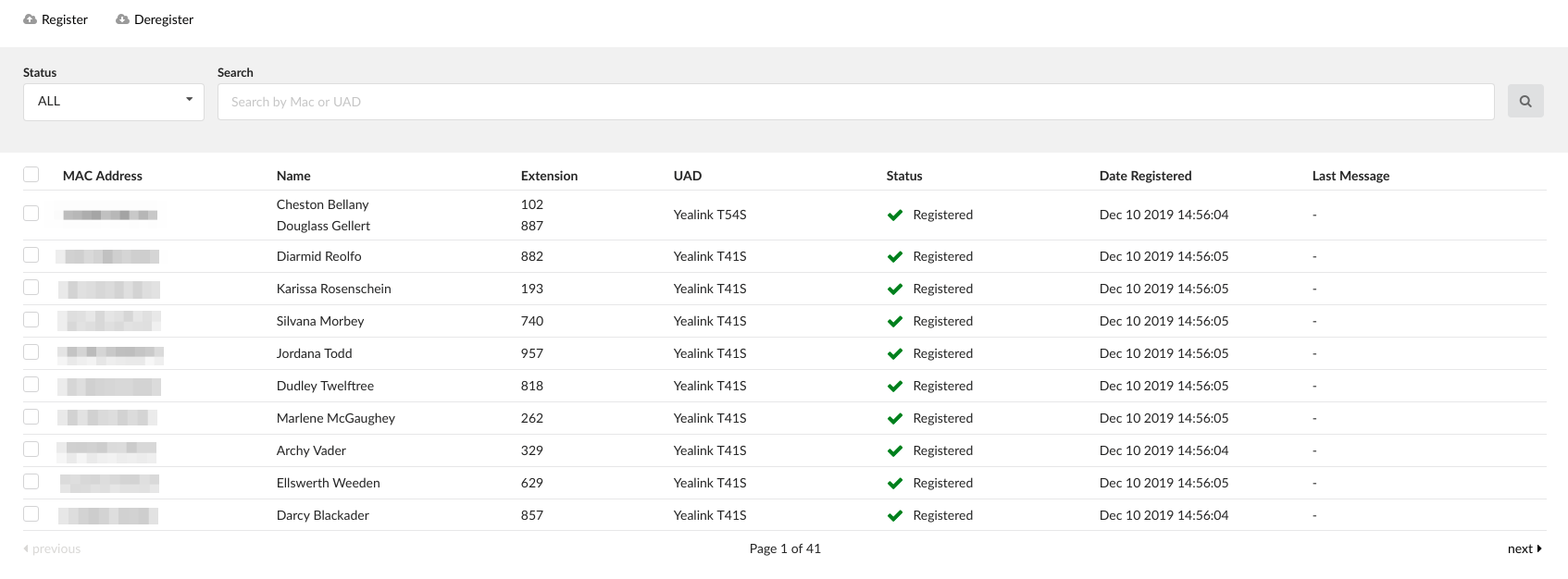
This page shows a list of all extensions/hot desking devices that can be provisioned using the Touchless Provisioning service.
- Register:
Once one or more MAC Addresses are selected, click the Register button to register the devices on the provider's redirection service.
When the devices are registered you can factory reset them and they will be provisioned to your server.
- Deregister:
Once one or more MAC Addresses are selected, click the Deregister button to remove the devices from the provider's redirection service.
- Status:
Used to filter the devices by their redirection service status.
- Registered: Shows all devices that are already registered on the provider's redirection service.
- None: Shows all devices that are NOT registered on the provider's redirection service.
- Search:
Used to filter the devices by MAC address or UAD.
- MAC Address:
Shows the device's MAC Address.
(Display)
- Name:
Shows the name(s) of extension(s) where the MAC address is assigned on.
(Display)
- Extension:
Shows the number(s) of extensions(s) where the MAC is assigned on.
(Display)
- UAD:
Shows the device's UAD type.
(Display)
- Status:
Status can have two values:
- Registered: The device is successfully registered on the provider's redirection service and is ready to be provisioned. To provision the phone all you need to do is factory reset it.
- None: The device is not registered on the provider's redirection service.
(Display)
- Date Registered:
Shows the date when the device was registered. Empty if the device is not registered.
(Display)
- Last Message:
In case a registration/deregistration request fails an error message will be shown here to indicate the problem.
If no error messages are present this field is empty.
(Display)
¶ Configuration

This page shows a list of all available providers whose phones can be provisioned with the Touchless Provisioning service. Currently supported providers are:
- Yealink
- Snom
A new provider can not be added manually. Existing providers can not be deleted.
- Provider:
Shows the provider's name.
(Display)
- Status:
Shows the provider's status.
Status can be one of the following:
- Disabled: Provider is disabled and not in use.
- Blacklisted Temporary: If the system fails to contact the provider it will flag it as temporary blacklisted and all requests for that provider will be queued. When the provider is back available the requests will go through.
(E.g. A provider can be temporarily blacklisted in case of a network issue etc.)
- Blacklisted: If the system recognizes that every single request for a provider will fail, the provider will be blacklisted, but all the requests will be queued.
(E.g. If invalid configuration credentials are entered then all requests will fail and the provider will be blacklisted until the problem is fixed.)
- Enabled: The provider is enabled and ready for use.
Note: Resaving the provider will always reset it's blacklisted status.
(Display)
- Message:
Shows the last error message that happened when sending requests to the provider. In case the provider is blacklisted this message will show us why that happened.
(Display):
¶ Yealink
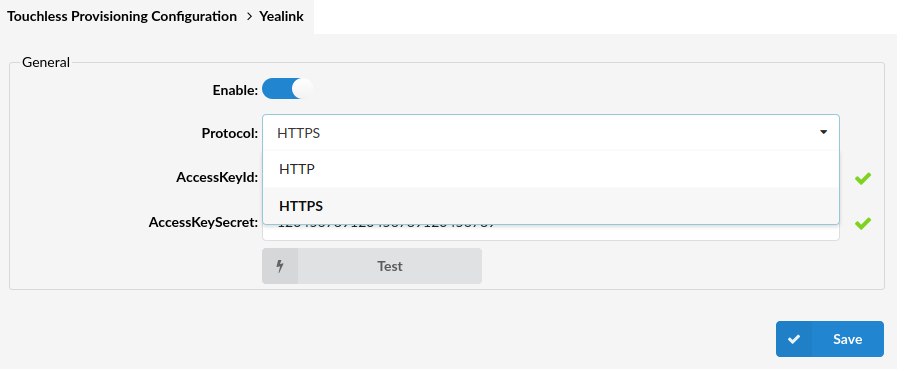
- Enable:
Enable/Disable the Yealink provider. If 'Disabled', then Yealink devices can not be provisioned using the Touchless Provisioning service.
- Protocol
Specify the protocol to be used.
(E.g. HTTP, HTTPS)
NOTE: If a user does not have a valid certificate, HTTPS can not be used for TLP.
- API Version:
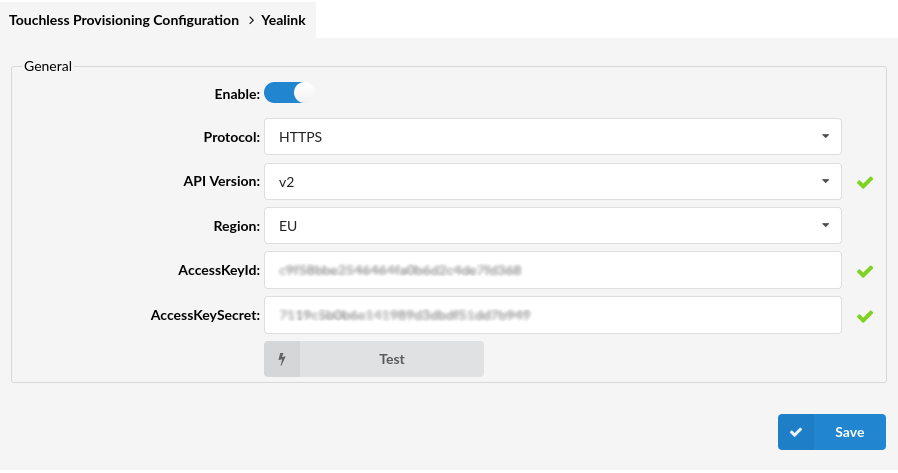
Selecting the API version will determine which Yealink RPS portal will be used.
- API Version V1 is for the previous Yealink RPS portal.
- API Version V2 is for the new Yealink YMCS portal.
By choosing API Version V2, a Yealink YMCS portal is selected and the new field Region will be displayed
- Region
Region selection depends on the type of Yealink YMCS portal used.
The selection available from dropdown is:
- EU
- US
- AU
- AccessKeyID
- AccessKeySecret
Both of the aforementioned fields are credentials required for the authentication with the Yealink RPS Service. Please refer to the description below on how to get these credentials.
- Test:
Click the button to test your configuration and accessibility to the Yealink RPS.
(E.g. 'Test finished successfully.')
(Button)
How to Get the Access Credentials V1
In order to provision Yealink phones by using the Touchless Provisioning service, the access credentials must be configured first.

To get these credentials, users need to have a Yealink RPS account. This account is free and can be acquired by contacting the Yealink support.
Once users have the Yealink RPS account, they can proceed with the following steps to get the credentials:
- Go to https://dm.yealink.com and enter the login username and password that the Yealink support provided.
- Once logged in, go to the System Settings tab and then click 'API Service'.
- Click the 'Acquire' button to generate a new pair of credentials.
- Copy the 'AccessKeyID' and 'AccessKeySecret' into the Touchless Provisioning Yealink Configuration.
- Click 'Save'.
Once the configuration is saved, click the 'Test' button. If users get the "Test finished successfully" message, then Yealink is ready to be used.
How to Get the Access Credentials V2
To provision Yealink phones by using the Touchless Provisioning service, the access credentials must be configured first.
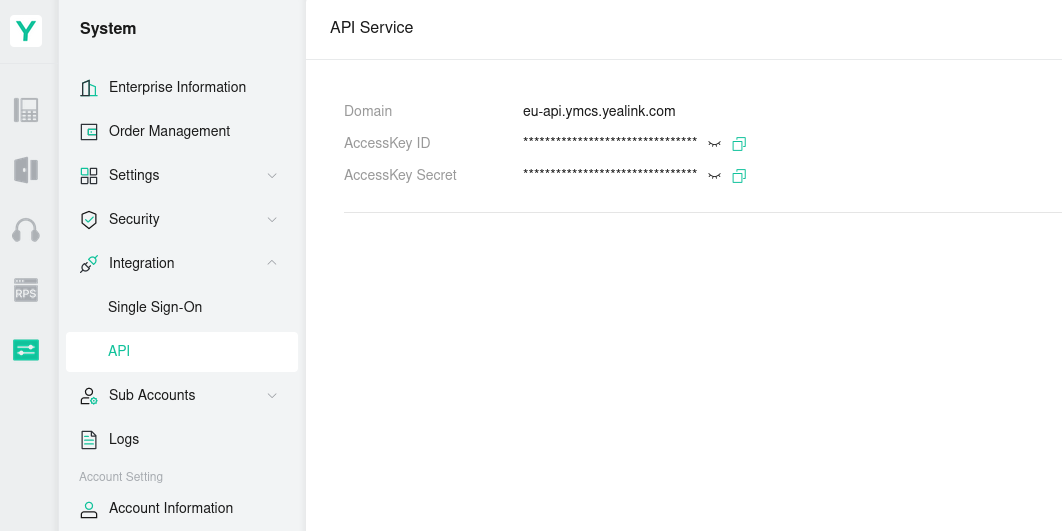
To get these credentials, users need to have a Yealink RPS account.
This account is free and can be acquired by contacting Yealink support.
Once users have the Yealink RPS account, they can proceed with the following steps to get the credentials:
- Go to https://dm.yealink.com enter the login username and password that the Yealink support provided and select the region.
- Once logged in, go to the System Settings > Integration tab and then click on 'API'.
- Click the 'Acquire' button to generate a new pair of credentials.
- Copy the 'AccessKeyID' and 'AccessKeySecret' into the Touchless Provisioning Yealink Configuration.
- Click 'Save'.
Once the configuration is saved, click the 'Test' button. If users get the "Test finished successfully" message, then Yealink is ready to be used.
Once the configuration is saved, click the 'Test' button. If users get the "Test finished successfully" message, then Yealink is ready to be used.
¶ Access Codes
Access codes provide the system user with access to essential system or enhanced services
¶ Voicemail

- Voicemail
Voice inbox access code. This number is dialed to access extension voice inbox (extension PIN required)
(E.g. From extension 1000 dial '*123' to access extension 1000 voice inbox. When asked for PIN, provide PIN set for this extension)
([0-9])
- General Voicemail
Access code for general voice mailbox. This number is used for checking your voice inbox from any system Extension
(E.g. Dial '*124'. Enter your Extension number and PIN when asked for it)
([0-9])
- Voicemail Transfer
Access code for transferring active calls to any system voice box
(E.g. During active conversation dial '*125 + $EXTENSION' to transfer calling party to system $EXTENSION number voice box)
([0-9])
¶ Agents

- Agent Dynamic Login
Access code used for dynamic Agent login
(E.g. Dial '*202 + $AGENT_NUMBER' from extension '1000' to login into Queue as an Agent. Provide Agent PIN number when asked for it. Dynamic login means that connection has to be active all the time - Agent is not to hangup his connection or a new login will be required).
([0-9])
- Agent Dynamic Callback Login/Logout
Access code used for dynamic callback Agent login
(E.g. Dial '*203 + $AGENT_NUMBER' from extension '1000' to login into Queue as an Agent. Provide Agent PIN number when asked for it. When the system asks for an extension which will be logged, the user can either supply one or just finish entry by confirming with '#'. Dynamic Callback login means that connection doesn't have to be active all the time - Agent is called back by the system).
([0-9])
- Agent Pause
When dialed, the agent is on pause and not receiving any calls.
(E.g. Dial '*204' to pause agent).
([0-9])
- Agent Not Ready
When dialed, the agent is on pause and not receiving any calls and listening to MOH.
(E.g. Dial '*205' to pause an agent and play MOH while paused).
([0-9])
- Agent Project Dial
When dialed, agent will make outbound call with Project Code
(E.g. *212 + $PROJECT_CODE + $NUMBER (*212*200*1000))
([0-9])
¶ Enhanced Services

- Last Caller
Access code for dialling the last Extension that was calling you
(E.g. If Extension '1000' was the last extension calling you, dial '*149' from your Extension. Message 'The number to call your line was $EXTENSION. To call this number press 1' will be played. Press '1' dial this destination).
([0-9])
- Instant Recording
Access code for instant call recording
(E.g. During active conversation dial '*159' to start recording conversation)
([0-9])
- Pause Recording
If making an outbound call or being logged in as an Agent, you have the ability to pause call recording using access code *90
(E.g. Whether you need to hide sensitive information like credit card numbers or anything else not being recorded, you can use this access code to pause the call recording in progress)
([0-9])
- UnPause Recording
If making an outbound call or being logged in as an Agent, you have the ability to unpause call recording using access code *91
(E.g. Whether you need to hide sensitive information like credit card numbers or anything else not being recorded, you can use this access code to unpause the call recording in progress)
([0-9])
- Monitoring
Access code for monitoring active calls
(E.g. If Extensions '1000' and '1001' are in conversation, dial '*199 + 1000' to listen the ongoing conversation)
([0-9])
¶ Speakerphone Paging

- Speakerphone Page
Access code for transmitting a message to multiple phones via their loudspeakers
(E.g. Dial '*399' to speakerphone all Extensions defined under Enhanced Services)
([0-9])
- Single Speakerphone Page
Access code for transmitting a message to phone loudspeaker
(E.g. Dial '*400 + $EXTENSION' to transmit a message to provided extension (phone) loudspeaker)
([0-9])
- Groups Speakerphone Page
Access code for transmitting a message to paging groups via their loudspeakers
(E.g. Dial '*600 + Paging Group' to transmit a message over intercom to all the extensions added to Paging group)
([0-9])
PBXware brings a feature in form of Two Way Speakerphone Paging. In order to start two way communication with preferred extension on the system dial *400 + * + $EXTENSION. For example, if you would like to initiate two way speakerphone paging with extension 1038 you will dial: *400*1038.
¶ Features

- Speed Dial
Speed Dial enables faster dialing by entering an access code and dual number speed dialing code. Speed Dialing Codes can be entered by clicking Settings: Servers and then clicking on Speed Dial button
(E.g. Dial '*130 + XX' where XX represents speed dialing code associated to some extension)
([0-9])
- Other Networks
Access code for accessing other PBXware networks
(E.g. Dial '*188 + $NETWORK + $EXTENSION' to dial number $EXTENSION or $NETWORK (e.g. '*188 8 1000').
NOTE: 'Trunk' and 'Other Network' must already be set)
([0-9])
- Listen to CDR recordings
Access code used when you want to listen to the last 9 Call Recordings from CDRs
(E.g. Dial '*170' access code followed by a number between 1 and 9, where 1 is most recent recorded conversation (excluding access code calls).
([1-9])
¶ Call Forwarding

- Enable Call Forwarding
Access code for enabling Call Forwarding Enhanced Service
(E.g. Dial '*71 + $EXTENSION' to forward all calls to $EXTENSION number. This number can be local Extension or Proper/Mobile number (e.g. '*71 1001' or '*71 55510205'))
([0-9])
- Disable Call Forwarding
Access code for disabling Call Forwarding Enhanced Service
(E.g. Dial '*72' to disable this service (Extension number not required))
([0-9])
¶ Group Hunt

- Toggle Do Not Disturb
Access Code for toggle "Do Not Disturb" Enhanced Service ON or OFF, the same as if user dialed *78/*79.
(*[0-9])
- Enable Do Not Disturb
Access Code for enabling "Do Not Disturb" Enhanced Service.
Dial *78 to enable "Do Not Disturb" and use set of rules defined for this service in extensions Enhanced Services.
(*[0-9])
- Disable Do Not Disturb
Access Code for disabling "Do Not Disturb" Enhanced Service.
Dial *79 to disable "Do Not Disturb" and use set of rules defined for this service in extensions Enhanced Services.
(*[0-9])
- Enable Group Hunt
Access Code for enabling "Group Hunt" Enhanced Service.
Dial *510 to enable "Group Hunt" and use set of rules defined for this service in extensions Enhanced Services.
(*[0-9])
- Disable Group Hunt
Access Code for enabling "Group Hunt" Enhanced Service.
Dial *511 to enable "Group Hunt" and use set of rules defined for this service in extensions Enhanced Services.
(*[0-9])
¶ Caller ID

- Block CallerID
Access code to block other users from seeing your CallerID
(E.g. Dial '*67' to block displaying your CallerID)
([0-9])
- Block CallerID once
Access code for blocking only first next call from displaying CallerID
(E.g. Dial '*81' to block only next call from seeing your CallerID)
([0-9])
- Unblock CallerID
Access code to unblock your CallerID after it has been blocked
(E.g. Dial '*68' to unblock your CallerID)
([0-9])
- Call with CallerID list number
Access code for changing caller ID number
(E.g. Dial '*65 + CallerID Number + Number_You_Want_To_Dial')
¶ Call Parking
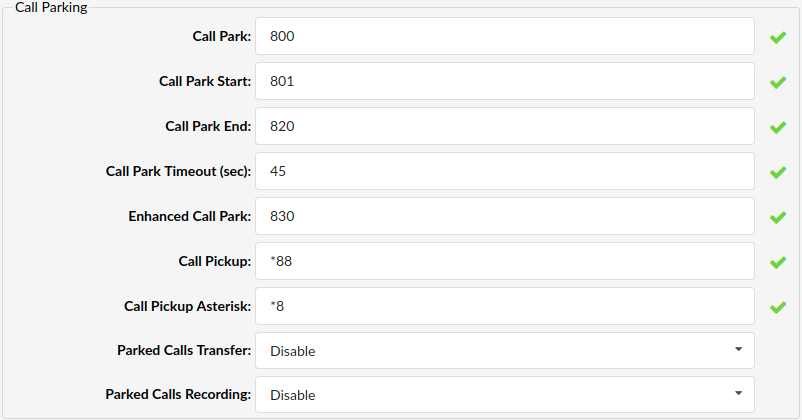
- Call Park
Access code for parking active calls
(E.g. During active conversation dial '#700'. The call will be parked on first available Call Park Extension (e.g. 701). Parked call can be picked up from any system Extension by dialing parked Extension ('701') NOTE: Extensions must have call pickup enabled in Enhanced Services in order to be able to pick up parked calls.
([0-9])
- Call Park Start
Start Extension for call parking service
(E.g. If set to '701' all calls will be parked on Extensions '701' to 'Call Park End')
([0-9])
- Call Park End
End Extension for call parking service
(E.g. If set to '720' all calls will be parked on Extensions 'Call Park Start' to '720')
([0-9])
- Call Park Timeout (sec)
Default timeout for Call Park is 45 seconds which means that once call is parked it will stay at assigned parking lot for 45 seconds after which call will return to extension which it was parked from.
- Enhanced Call Park
Access code for parking calls and sending them to preset Announce Extension which can be set in Settings->Servers
(E.g. During active conversation dial '#800'. The call will be parked and Announce Extension will ring for Timeout seconds. After that period call will be directed to Timeout Extension)
([0-9])
- Call Pickup
NOTE: The Call Pickup access code will be applied to phones if auto provisioning is used.
([0-9])
- Call Pickup Asterisk
([0-9])
- Parked Calls Transfer
Set this feature as Disable (default setting) or Enable it for both sides or for the pickup side only.
- Parked Calls Recording
Set this feature as Disable (default setting) or Enable it for Caller only, Callee only or Both sides.
¶ System Tests

- Music On Hold
Access code for playing Music On Hold sound files
(E.g. Dial '*388' to play 'default' Music On Hold class sound files)
([0-9])
- Echo Audio Read
Access code for echo audio test.
(E.g. Dial '*398' and talk. Everything you say is returned back so the server response time can be checked)
([0-9])
NOTE: Now user will be able to skip the audio prompt when doing Echo Test by pressing any DTMF, including "#".
¶ Greetings

- Record Greeting
Record the greeting or any other sound file that can be used in PBXware
(E.g. Dial '*301' and after the beep sound, say the message that you want to record.)
([0-9])
- Agent Greeting
Record the Agent greeting that the caller will hear before connecting to an Agent
(E.g. Dial '*302' and then enter the Agent number to record the Agent greeting.)
([0-9])
NOTE: In order for the Agent greeting to be played, users have to add the agentgreeting=yes command to the Queue's additional config. This applies both to Dynamic and Callback Agents. Please note that in case the command is missing, the Agent greeting will not be played.
- Change Greeting (greeting access code for specific destination types)
(e.g., Dial '*303xxx' where 'xxx' is an IVR, Ring Group, Queue, etc. When dialed, the user is prompted to record a new greeting. Once accepted, the greeting is set as the Destination's new greeting.)
- Overwrite Greeting (greeting access code for specific destination types)
(e.g., Dial '*304xxx' where 'xxx' is an IVR, Ring Group, Queue, etc. When dialed, the user is prompted to record a new greeting. Once accepted, the greeting is set as the Destination's new greeting and the old greeting, if existed, will be deleted.)
¶ Operation Times

- Open Operation Times
User will dial '*401' to open systems operation times
(E.g. If operation times is open, but not explicitly closed, it is automatically closed at 12 AM)
([0-9])
- Close Operation Times
User will dial '*402' to close systems operation times
(E.g. If user doesn't close operation times, it will be closed automatically at 12 AM)
([0-9])
- Reset Operation Times
User will dial '*403' to reset systems operation times and restore rules entered in settings.
- Midnight Reset
Users have the ability to set the operation times midnight reset option to Yes/No/Not Set.
By default this option is set to "Yes", meaning that the access codes will be reset at midnight. If set to "No", midnight reset will be skipped.
¶ Operation Times BLFs

- Open/Close: *404
Users can program a BLF key on their phone to *404 in order to monitor Operation Times status and to use it to enable or disable Operation Times rules.
For example, if a user stays in the office after the Operation Times rules activate for off hours, the BLF will notify the user of the changed state by turning on the BLF light or changing its color (behavior will depend on the device used). Once *404 is provisioned as BLF pressing the button will toggle Operation times ON or OFF, the same as if user dialed *401/*402.
([0-9])
- Close/reset: *405
To reset Operation Times rules, user will have to dial *405 manually.
([0-9])
NOTE: The System operation times ES has to be enabled for this to work.
¶ Follow Me

- Enable Follow Me
Access Code for enabling "Follow Me" Enhanced Service.
Dial *520 to enable "Follow Me" and use set of rules defined for this service in extensions Enhanced Services.
(*[0-9])
- Disable Follow Me
Access Code for disabling "Follow Me" Enhanced Service.
Dial *521 to disable "Follow Me" and use set of rules defined for this service in extensions Enhanced Services.
(*[0-9])
¶ Hot Desking

- Hot Desking
Access code used for Hot Desking Login
([0-9])
¶ Transfer

- Blind Transfer
Perform blind a transfer
(e.g. mobile phone) and transfer the call to it.
([0-9])
- Attended Transfer
Perform Attended Transfer
([0-9])
- Attended Transfer Abort
Dialing this access code aborts an attended transfer. Otherwise there is no way to abort an attended transfer.
([0-9])
- Attended Transfer Complete
Dialing this access code completes an attended transfer and drops out of the call without having to hang up.
([0-9])
¶ Wake-Up Call

- Wake-Up Call
*411 - dial this access code to set up a wake-up call for your extension and set your preferred time for the wake-up call. Once triggered and the user picks up the call, they can choose to cancel the wake-up call or snooze for 5,10 or 15 minutes.
- Operator Wake-Up Call
*412 - operator will dial this code and then enter the extension number to set up the wake-up call for it.
¶ OAUTH (7.4)
The OAuth section is designed for users to add custom OAuth Apps and Credentials, use them for the main SMTP or email-to-fax configuration, and authorize them with OAuth providers.
The option to use Google and Microsoft legacy apps is still available, so the users currently can choose to use a legacy app that is using bs-authorize. However, this option is transitional and will be disabled in the future.
Under the OAuth section, three sub-sections are available:
- OAuth
- Apps
- Credentials
¶ Apps
The apps section is reserved for users to create, edit, or remove custom Google or Microsoft apps. Legacy Google and Microsoft apps are placed in this section as well, though Legacy apps can not be edited, only removed.
NOTE: If a Legacy app is removed it can not be re-created!
The apps section displays the name of the OAuth App, the Provider that is being used by the App, selected scopes, and tenants assigned to the App. Status will display if the App is Enabled or Disabled.
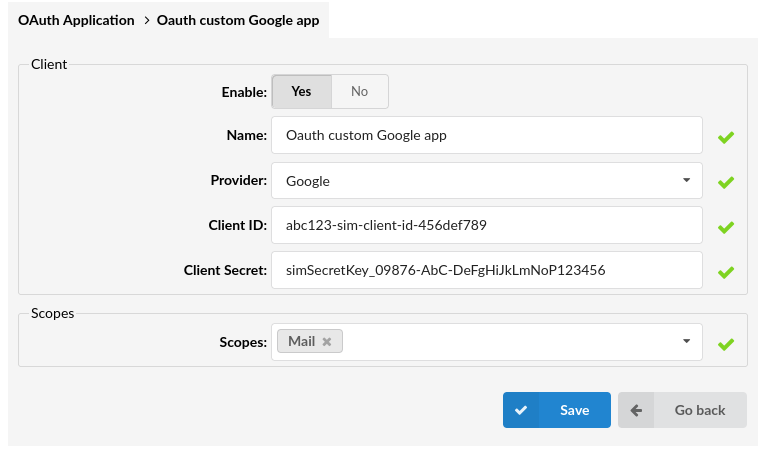
Add / Edit OAuth App
- Enable
Enable or disable the OAuth application.
- Name
Name of the OAuth application
- Provider
Dropdown to select the available providers for the application. (Google or Microsoft).
- Client ID
Client ID obtained from the OAuth application created with Provider service.
- Client Secret
Client Secret obtained from the OAuth application created with Provider service.
- Scopes
Dropdown to select the scopes for the application. Two scopes are available for selection from the dropdown menu: Mail and Storage. Scopes selected here will be available as a preference in the credentials section when the application is selected.
NOTE: Apps should only request the minimum scopes necessary to perform their functionality. If the app is going to be used for email notifications, users should only use the ‘mail’ scope. This improves security and reduces user friction.
¶ Credentials
Credentials page allows users to Add / Edit credentials for the created OAuth Apps. (Legacy apps included)
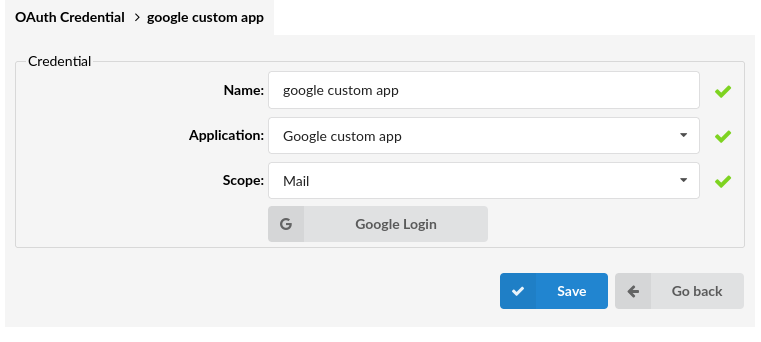
OAuth Credential
- Name
Name of the Credential entered by the user
- Applications
Select the available applications from the dropdown menu. By default Legacy google app is selected.
- Scope
Dropdown to select the scopes. Scopes available for selection are the ones configured on the Application selected.
- Login
User authentication by using Google / Microsoft's secure OAuth system to log in and authenticate users based on their existing Google credentials.
¶ Dispatchable Locations (7.1)
The Dispatchable Locations page contains the list of all the locations with their parameters, which are used for validation. In order to prevent errors when adding addresses, each address is validated through the USPS (United States Postal Service) API, and only addresses that have been successfully validated can be used when making emergency calls.
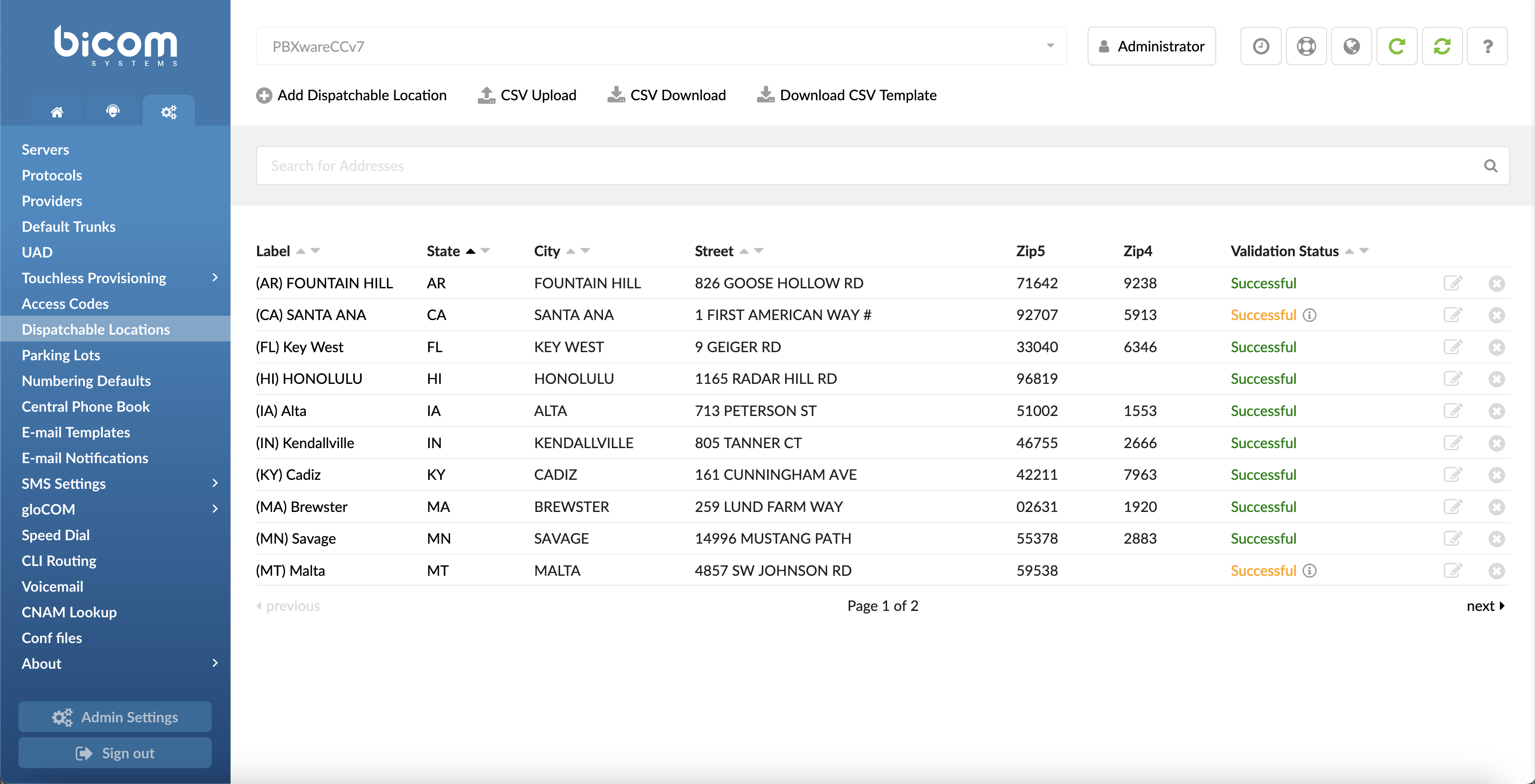
If the dispatchable location is not validated successfully, an info icon will be displayed next to the Failed status, with additional information on why the validation is marked as failed.
- Add Dispatchable Location
This option allows you to create new Dispatchable Location entry.
- CSV Upload
You can use CSV Upload to create multiple Dispatchable Location entries easily at the same time, by uploading a .csv file with all the necessary configuration details.
CSV file must follow this format:
label,state,city,house_number,direction,street_name,street_suffix,zip5,zip4,floor,room,allow_everyone,departments,extensions,mac_addresses_labels
To upload your CSV file, click the 'Browse' button, select a .csv file from your computer, click 'Open', and then click the 'CSV Upload' button.
Please note, when uploading a CSV file, all the entries currently available on the system will be deleted, so make sure you have all the necessary dispatchable locations added in the CSV file you are uploading.
NOTE: It is very important to know that due to the way data is handled when CSV upload is used, the Default Deskphone Location entries under the system settings will be removed and will have to be manually re-assigned.
- CSV Download
CSV Download will provide you with CSV file with configuration for all Dispatchable Locations currently set up on the system. You can use this file to create the same locations on another system or you can use it to add new locations on top of already existing entries to create new locations using CSV Upload option.
- Download CSV Template
Download CSV Template will provide you with a CSV file with all the necessary headers you can use to create new dispatchable locations using CSV Upload Option.
- Label (Required)
The custom name assigned to the dispatchable location. (i.e. Main Office)
- State (Required)
The state the dispatchable location is located in.
- City (Required)
Name of the city the dispatchable location is located in.
- House Number (Required)
The exact house number for the location
- Leading Street Direction (Optional)
The direction in which the street traffic is oriented.
- Street Name (Required)
A street name in which the dispatchable location is in. A valid street name must be entered. Once the entry is validated, it will be formatted in the proper way.
- Street Suffix (Optional)
A street suffix for the address dispatchable location is in. (i.e. street, avenue, lane, drive etc.)
- ZIP5 (Required)
ZIP code of the area dispatchable location is located in.
- ZIP4 (Optional)
Additional 4-digit ZIP code that provides more specific location details.
- Validation Status
The validation status can be Failed and ‘Successful’ marked by the color and the info symbol.
When the address is fully validated, the Successful will be marked in green, and on the address edit for a new field, "Validated Street" will be displayed.
If the address is correct but the Street suffix or a Street Direction is not entered correctly, the Successful will be marked in orange with additional information on what must be corrected for the address to be fully validated.
-
Edit
Press this button to edit the Dispatchable Location. -
Delete
Press this button to delete the Dispatchable Location.
¶ Add/Edit Dispatchable Location
¶ General
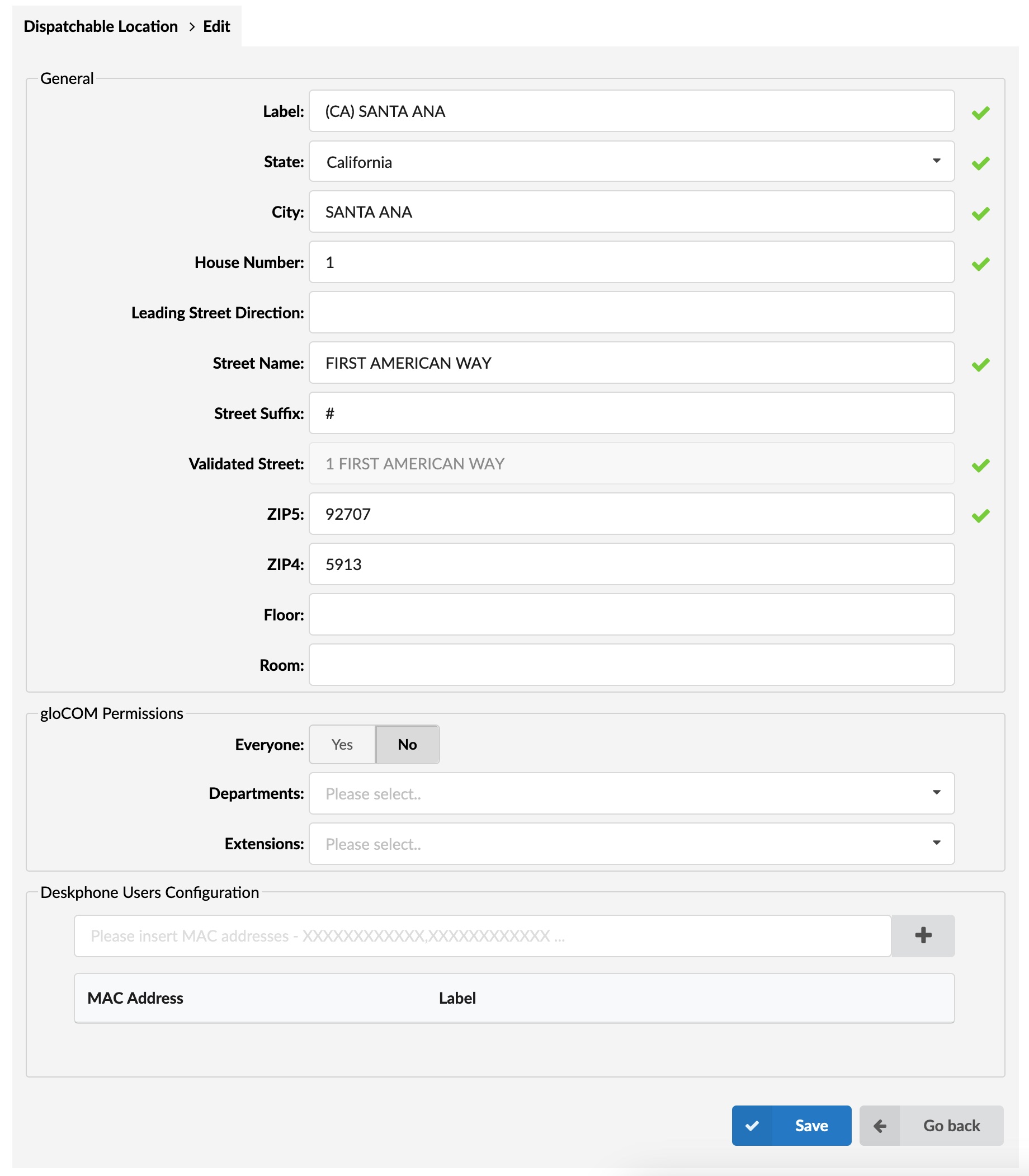
- Label (Required)
Label field is used for easier organization and filtering purposes. (i.e. Main Office)
- State (Required)
The state the dispatchable location is located in. Select the state from the dropdown menu.
- City (Required)
Name of the city the dispatchable location is located in. A correct city name located in the selected state must be entered.
- House Number (Required)
The exact house number for the location
- Street Name (Required)
A street name in which the dispatchable location is in. A valid street name must be entered. Once the entry is validated, it will be formatted in the proper way.
- Street Suffix (Optional)
A street suffix for the address dispatchable location is in. (i.e. street, avenue, lane, drive etc.)
- Leading Street Direction Type (Optional) (7.6)
The type of the leading street direction. This is an optional field, and from the dropdown users can choose Pre-Directional, Post-Directional or leave it empty.
- Leading Street Direction (Optional)
The direction in which the street traffic is oriented.
- ZIP5 (Required)
The ZIP code of the area dispatchable location is in. A valid 5-digit ZIP code of the area must be entered.
- ZIP4 (Optional)
Additional 4-digit ZIP code that provides more specific location details.
NOTE: If an invalid ZIP5 or ZIP4 is entered, both will be auto-populated according to the address entered above.
- Floor (Optional)
The exact floor number the device is located on.
- Room (Optional)
The exact number or name of the room the device is located in.
¶ gloCOM Permissions
PBXware administrator can define which location gloCOM users will be able to use.
The following permissions are available for selection:
- Everyone
Whether the location will be assigned to every gloCOM user on the system.
When YES is selected, all gloCOM users on the server will be able to use the location.
If 'Everyone' is set to Yes, Departments and Extensions dropdown selection will be disabled.
When NO is selected, only specifed gloCOM extensions and departments will be able to use this location.
- Departments
Departments dropdown selection menu allows you to assign the location to one or more departments. When a specific department is selected only gloCOM extensions which are members of the selected department will be able to use this location.
- Extensions
Departments dropdown selection menu allows you to assign the location to one or more extensions. Only selected extensions will be able to use and this location.
NOTE: Assigning gloCOM permissions does not mean that the location is assigned to a specific gloCOM user, it just means that the location will be available in the gloCOM App under the Emergency Locations tab but the user is still responsible for selecting the correct location.
¶ Deskphone Users Configuration
Deskphone Users Configuration can be used to assign UAD’s MAC address to the specific dispatchable location. Each MAC address can only be assigned to a single location at once, as deskphone can be in one location only.
NOTE: If the same MAC address is assigned to another dispatchable location the following warning will be displayed: “The MAC address 'XXXXXXXXXXXX' is already associated with the Dispatchable Location 'ID_Number'!”
NOTE: To send the information about the selected location and match the specific MAC Address, devices must be auto-provisioned.
Every address is validated using USPS (United States Postal Service) API and only successfully validated addresses can be assigned and used by Glocom users and deskphones.
¶ Parking Lots

Parking Lots allows users to park a call to a specific parking lot.
- Parking Lot
Displays the name of a parking lot
(E.g. Test)
(Display)
- Parking Extension
Displays the number of a parking Extension
(E.g. 800)
(Display)
- Parking Positions
Displays the number range of parking positions in a form of XXX-XXX
(E.g. 810-820)
(Display)
- Last Destination
Displays the number of an Extension that represents the Last Destination
(E.g. 100)
(Display)
NOTE: In case no one picks up the parked call, the call will go to 'Last Destination' after the time specified in the 'Timeout (sec)' field exceeds.
 Click this button to edit the configuration of a selected parking lot.
Click this button to edit the configuration of a selected parking lot.
(Button)
 Click this button to delete a selected parking lot.
Click this button to delete a selected parking lot.
NOTE: Upon clicking the button, the following warning message will appear: "Are you sure you want to remove XYZ*?"*. If users click the Cancel button, then the action will be abandoned. On the contrary, if OK is clicked, the selected parking lot will be deleted.
For more information, please refer to the screenshot.

(Button)

(Button)
¶ Add/Edit Parking Lot
¶ Parking Lot
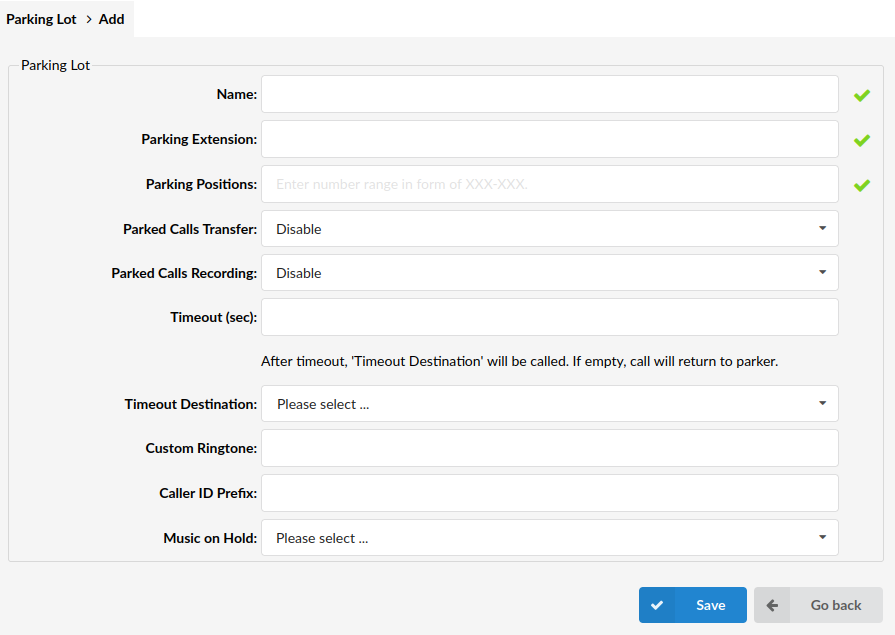
- Name
Set a name of the parking lot
(E.g. Test)
([a-z][0-9])
- Parking Extension
Set a number of the parking Extension
(E.g. 900)
([0-9])
NOTE: If a user wants to park the call, they will transfer the call to the Extension entered in this field.
- Parking Positions
Set a range of the parking positions that will be available
(E.g. 901-920)
([0-9])
NOTE: A user needs to dial one of the numbers listed here to pick up the parked call.
- Parked Calls Transfer
Select who can transfer the parked call
(E.g. 'Disable'/'Enable (Both sides)/'Enable (Pickup only)')
(Select box)
NOTE: Default is 'Disable'.
- Parked Calls Recordings
Select who can start recording on the parked call
(E.g. 'Disable'/'Enable (Both sides)/'Enable (Pickup only)')
(Select box)
NOTE: Default is 'Disable'.
- **Timeout (sec)**
Set the time in seconds and define how long the call should stay at the assigned parking lot after which the call will be redirected to the Timeout Destination
(E.g. 25)
([0-9])
- Timeout Destination
Set 'Timeout Destination' that should ring after the time set in the ‘Timeout (sec)’ field passes
(E.g. 100)
(Select box)
- Custom Ringtone
If users are directing calls to an Extension on which a supported UAD is registered, they can set a Custom Ringtone with which the phone will ring.
(E.g.)
([a-z][0-9])
- Caller ID Prefix
Set the Caller ID Prefix
(E.g. +)
NOTE: This Caller ID prefix will be set when the call is redirected to the Timeout Destination.
- Music on Hold
Select a MoH class that will be played to callers parked on this parking lot
(E.g. testclass)
(Select box)
¶ Numbering Defaults
Numbering defaults sets the way PBXware will assign network numbers to Extensions, Conferences, etc.
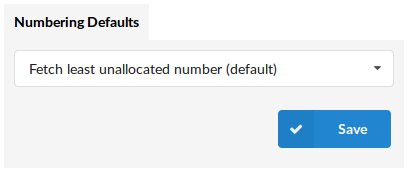
Fetch least unallocated number (default):
This option takes the least number on the system that is not used by the system and assigns it to a new Extension you're trying to create, for example.
Fetch next unallocated number:
If the last allocated number was assigned to extension 2010, the next IVR that you're trying to add, for example, will be given number 2011. The system will not try to give you an unallocated number 1022, for example.
Fetch random:
Use this option in case you want to assign numbers in a non-sequential order. If you create a new Queue, for example, PBXware will assign it a number 2350, for example. And if you try to create a new Extension right after that, PBXware might assign it a number 9838, for example.
¶ Central Phone Book
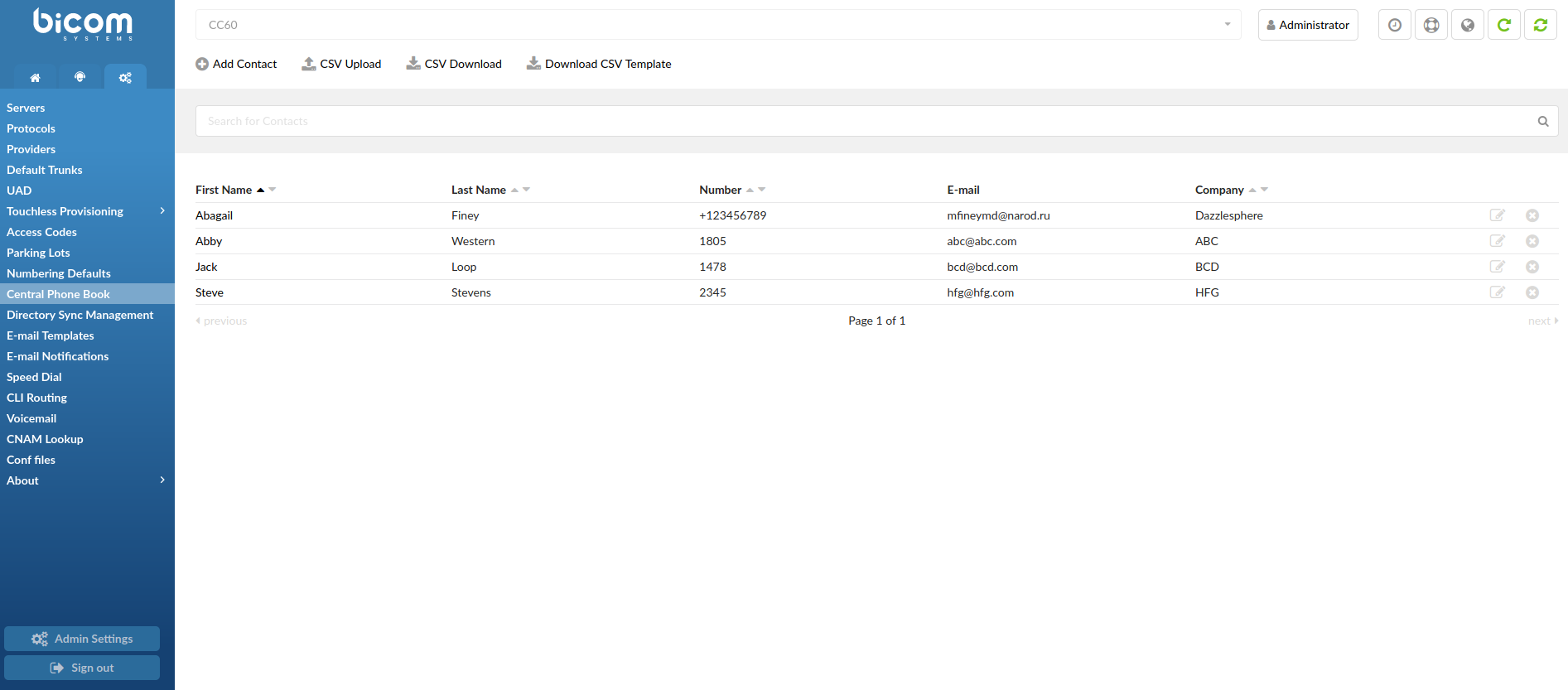
Two different types of contacts can be added:
- Global - sent to all phones and managed here
- Personal - sent to one user only together with global contacts and managed from the Extensions page
NOTE: Yealink, Cisco, and Polycom phones can work with Central Phone Book.
PBXware allows its users to manage CSV files in few different ways:
- CSV Upload
Upload a predefined list of contacts to the contacts list
(Button)
Please refer to the example of a CSV file with 5 contacts:
| 1 | Chevy,,Yesipov,cyesipov0@example.com,Jacobi and Sons,mobile:50011,work:600111 |
| 2 | Jeanine,,Tiddeman,jtiddeman1@ihg.com,Walsh Group,mobile:50012,work:600112 |
| 3 | Erasmus,,Curlis,ecurlis2@sbwire.com,Nolan-Kris,mobile:50013,work:600113 |
| 4 | Caresa,,Bremmell,cbremmell3@php.net,Mayert Inc,mobile:50014,work:600114 |
| 5 | Romy,,Hedling,rhedling4@latimes.com,"Ankunding,Weissnat",mobile:50015,work:600115 |
NOTE: If a value (first_name, last_name etc.) has a comma, it has to be put under quotes. In the example of a CSV file shown above, the 5th contact with its company name has a comma - "Ankunding, Weissnat".
NOTE: In case the number type is not 'Work', 'Mobile', 'Home', or 'Fax', the number will be skipped. Also, the number type is case insensitive which means that all of these examples are acceptable - 'Work', 'WORK', and/or 'wOrK'.

NOTE: Upon uploading a new CSV file, all existing contacts on the system will be deleted, which ensures that a user's contact list stays up-to-date. However, in order to prevent any potential and unintentional data loss, upon uploading a new CSV file, the warning message will appear saying "CSV upload will delete existing records. Do you want to proceed?". If a user presses 'OK', it will result in a new CSV file being uploaded and all previous contacts being deleted.
For more information, please refer to the screenshot.
- CSV Download
Download all the global/personal contacts as a CSV file
(Button)
- Download CSV Template
Download a CSV template which can be used to create a CSV file with contacts and upload it instead of adding contacts one by one
(Button)
- Search bar
Search contacts by entering specific information into the search bar
([0-9][+])
NOTE: Contacts can be searched by using the '+' (plus) sign.
NOTE: On the Central Phone Book page, 1000 (one thousand) is the maximum number of contacts that can be displayed. To narrow down the range of contacts, the search bar should be used.
The Central Phone Book list contains all global/personal contacts with following details:
- First Name
Contact's first name
(E.g. Abagail)
(Display)
- Last Name
Contact's last name
(E.g. Finey)
(Display)
- Number
Contact's number
(E.g 1805)
(Display)
Contact's e-mail address
(E.g. mfineymd@narod.ru)
(Display)
- Company
Contact's company
(Dazzlesphere)
(Display)
 Edit the configuration of the Contact.
Edit the configuration of the Contact.
(E.g. Click the 'Edit' button to edit the Contact's configuration.)
(Button)
 Delete the Contact from the system.
Delete the Contact from the system.
(E.g. Click the 'Delete' button to delete the Contact from the system.)
(Button)
¶ Add/Edit Contact
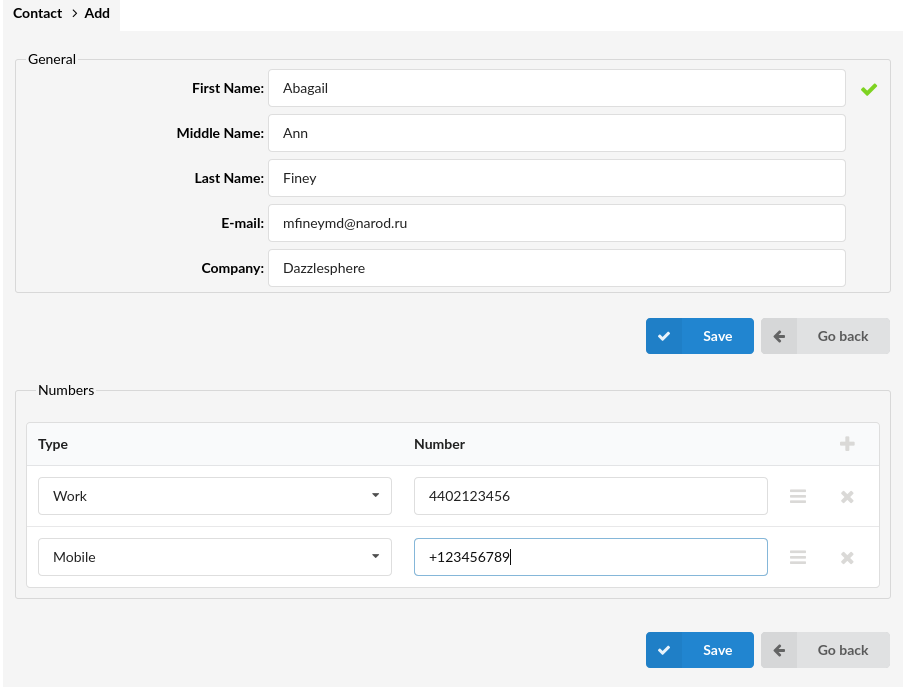
¶ General
- First Name
Contact's first name
(E.g. Abagail)
([a-z])
- Middle Name
Contact's middle name
(E.g. Ann)
([a-z])
- Last Name
Contact's last name
(E.g. Finey)
([a-z])
Contact's e-mail address
(E.g. mfineymd@narod.ru)
([a-z][0-9])
- Company
Contact's company
(E.g. Dazzlesphere)
([a-z])
¶ Numbers
- Type
Number type
(E.g. Work)
(Select box)
- Number
Contact's phone number
(E.g. 061111111)
([0-9])
NOTE: Central Phone Book accepts numbers starting with the '+' (plus) sign.
¶ Microsoft Teams
The Microsoft Teams Integration is reserved for enabling/disabling Microsoft Teams Presence Sync. It synchronizes Microsoft Teams' presence status with the Bicom client application (gloCOM Desktop, gloCOM Web, and gloCOM GO) extension's presence.
¶ Settings

- Enable Presence Sync
Enable or disable the Enable Presence Sync.
- OAuth2 Read Credential
Select the available read credential from the dropdown menu.
- OAuth2 Update Credential
Select the available update credential from the dropdown menu.
¶ Directory Sync Management
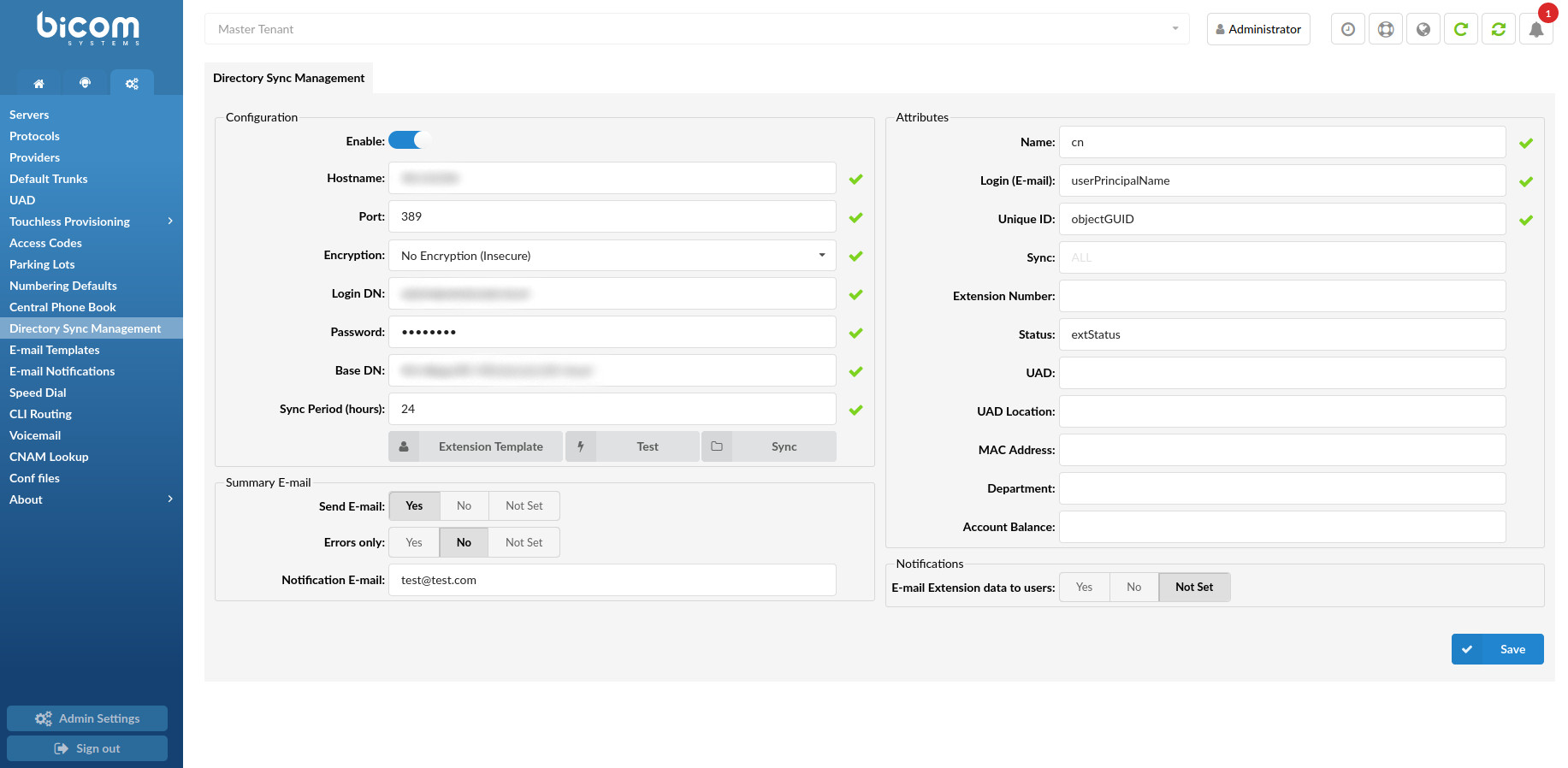
Directory Sync Management (DSM) is an application which allows users/clients to connect to the LDAP server in order to validate users by using LDAP, or Lightweight Directory Access Protocol. LDAP can be generally understood as ‘the communication language’ used by applications to communicate with various directories. In order to improve user experience, DSM enables them to sync Extensions in a faster way by using Extension Template and selecting generic configuration settings for Extensions. Users may also select personalized settings for certain Extensions and apply different changes if needed.
On PBXware, DSM configuration can be enabled on 'Settings' -> 'Directory Sync Management'.
Upon pressing the 'Enable' toggle button, this message will be displayed at the top of the page:

(Display)
Additionally, the 'Test' and 'Sync' buttons will be replaced with:

(Button)
NOTE: For DSM configuration to operate successfully, it is necessary to populate all required fields on the page and 'Save' settings.
All fields found in the 'Configuration' section are required. If one of the required fields is not populated, the warning message will pop up. Please refer to the screenshots below.
¶ Configuration
- Enable: Clicking the toggle button will allow users to enable the DSM service. If Disabled, DSM will not sync any Extensions.
(E.g. Enable/Disable)
(Toggle button)
- Hostname: Enter Hostname/IP of the LDAP server.
In case 'Hostname' is used, there is no need to enter ldap:// or ldaps://. For instance, if the hostname is ldap.myserver.com, a user can just put that hostname in the field and does not need to set it as ldap://ldap.myserver.com. The protocol used (secure or not secure) is set in the 'Encryption' field.

(E.g. 10.1.0.111)
([0-9])
NOTE: In case the Extensions have been previously synced, the 'Hostname' and 'Base DN' fields will be disabled and cannot be changed due to security reasons and avoidance of any unfavorable changes. These fields will be re-enabled when all the synced Extensions are deleted from that server. The synced Extensions cannot be deleted through the PBXware GUI, but have to be removed on the LDAP server. With the next sync executed, they will be removed from PBXware. This allows the users to have full control over the Extensions on the LDAP server without the need to enter the PBXware GUI.
- Port: Enter one of the default ports: 389 for LDAP or 636 for LDAPS. If 'No Encryption (Insecure)' or 'STARTTLS' is used, the port is usually 389, while 'SSL/TLS' uses 636.

As security is an important part of network protocols, it is necessary to mention that using LDAPS ensures a higher level of security since it provides the encryption of LDAP data.
(E.g. 389)
([0-9])
- Encryption: Select the type of 'Encryption' that will be used when communicating with the LDAP server. The options are SSL/TLS and STARTTLS. Using 'Encryption' is not obligatory, however it is highly recommended due to the fact that the 'No Encryption (Insecure)' field may result in transmission being exposed to attackers.
(E.g. SSL/TLS)
(Select box)
- Login DN: Enter login username/e-mail of an LDAP server administrator or a user with correct privileges.

(E.g. admin@mydomain.com)
([a-z][0-9])
NOTE: The account must have the permission to execute a SEARCH request on the LDAP server. Both 'Login DN' and 'Password' have to be valid credentials.
- Password: Enter the password used for authentication of the administrator's account or a user with correct privileges.

(E.g. ******)
([a-z][0-9])
- Base DN: Represents the starting point on the LDAP server where the search for users will start. 'DN' in ‘Base DN’ stands for 'Distinguished Name'. The following is an example of a Group Base DN.

(E.g. CN=Users,CN=Builtin,DC=MyDomain,DC=com)
([a-z][0-9])
NOTE: The string structure of the search query in LDAP may be composed of the following values:
- 'DC' stands for ' Domain Component'
- 'OU' stands for 'Organizational Unit'
- 'CN' stands for 'Common Name'.
- Sync Period (hours): Define the sync period for automatic sync (in hours). The sync is done periodically (or manually). For example, if the sync period is set to 6, it means that users will be synced from the LDAP server every six hours.

(E.g. 6)
([0-9])
The 'Configuration' section has three additional buttons: 'Extension Template', 'Test', and 'Sync'.

Click this button to open a frame where you will be able to set a template for users who are to be synced.
(Button)
NOTE: 'Extension Template' is used to define the default Extension options that can not be managed through LDAP. The template will be used exclusively when adding a new user to PBXware. Setting the template will not affect the existing Extensions on the system, but it will have an effect on the new ones only. If editing an already existing synced user, it can be done through the user interface in the same way that any other Extension on the system would be edited.
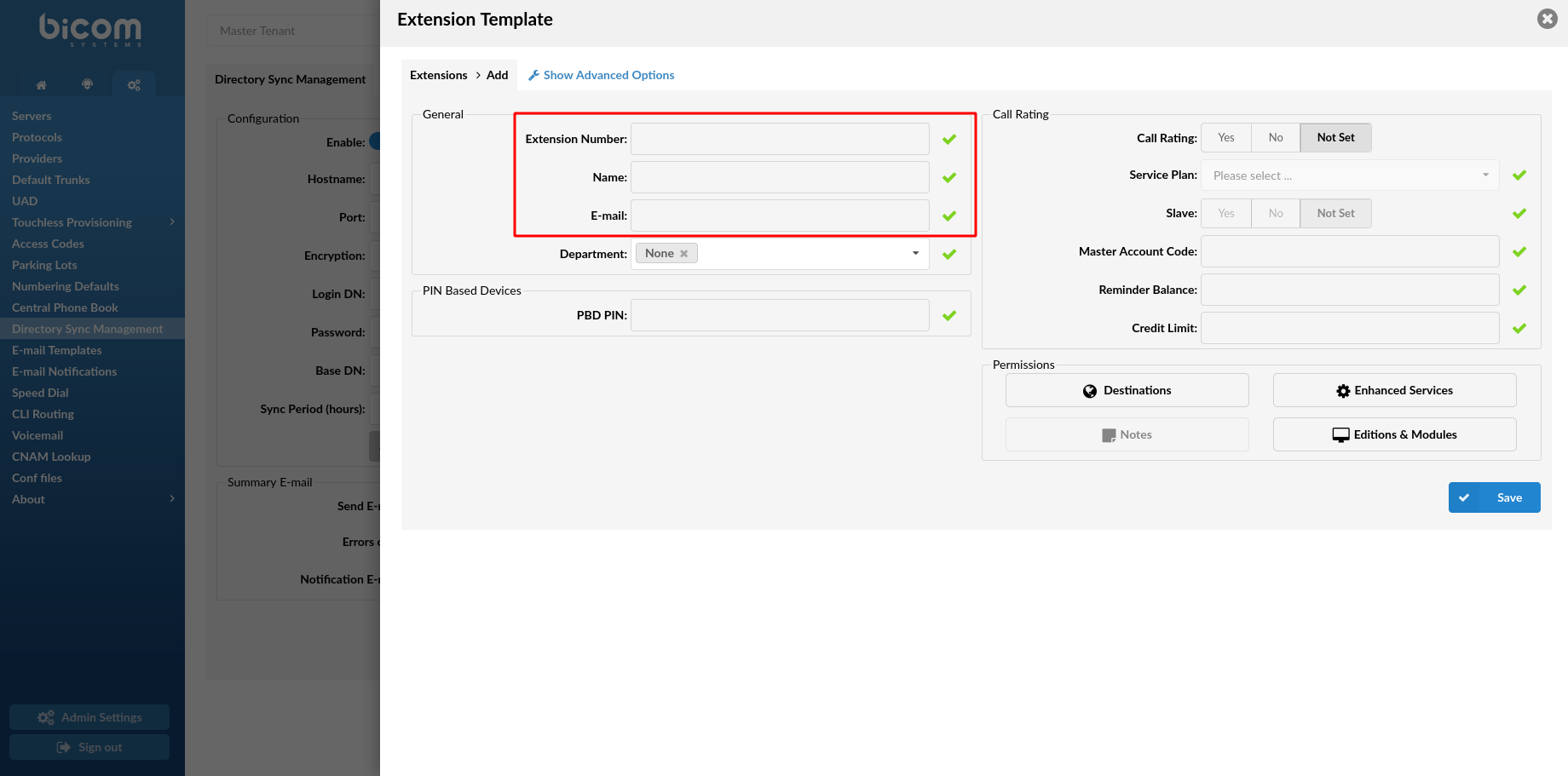
As shown in the screenshot, 'Extension Number', 'Name', and 'E-mail' fields are uneditable due to the fact that these fields are edited on the LDAP server. Extensions may not share the same 'Extension Number' or an 'E-mail address', therefore it is not possible to use these fields as generic settings for synced Extensions.

Click this button to run a test and check whether it is possible to connect to the LDAP server.
(Button)
NOTE: Providing that the administrator's login credentials are valid and that the account has a permission to make a search request, the test will successfully pass and the approval message will be shown. However, in case that any of the mentioned criteria are not met, the test will fail and the warning message will be shown.

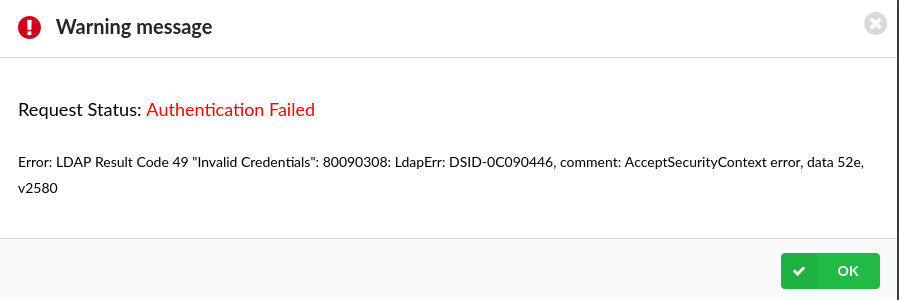
As 'Test' checks whether the connection with the LDAP server can be established or not, the warning message has detailed information regarding the error and as such, it points to the error related with the LDAP, not PBXware.

Click this button to start users' sync manually.
(Button)

NOTE: Syncing will not restart the 'Sync Period'. This means that if a user starts a sync 10 minutes before it would be automatically triggered, the automatic sync will not restart the timer to X hours again, but it will start the sync itself in 10 minutes.

Since syncing will apply major changes to the system, upon clicking the button, the warning message will be shown asking to confirm the action. If the action of syncing is confirmed, the interface will provide users with more information and the approval message will pop up.
Users will be able to see that 'Sync is in progress' and the button for stopping the Sync will be displayed. Please refer to the screenshot.
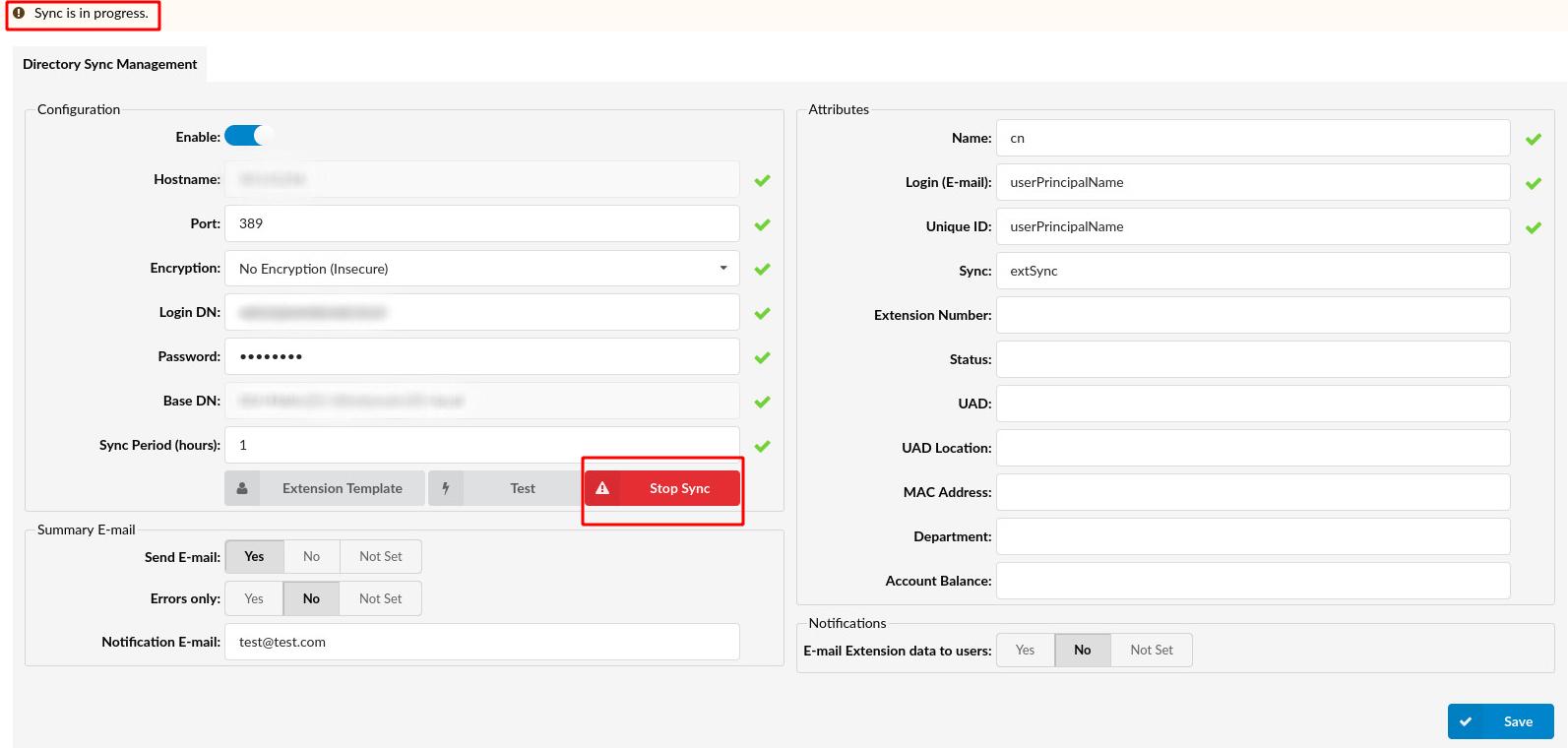
If users decide to 'Stop Sync' at any time, they may press the 'Stop Sync' button and the warning message will be shown asking for the confirmation of the action: "Are you sure you want to stop Directory Sync?". If proceeded with 'OK', the approval message will pop up saying that "Directory Sync stopped".
¶ Summary E-mail

- Send E-mail: If 'Yes' is selected, users will receive a summary e-mail to the defined e-mail address. By default, the E-mail template includes the Date, number of Added/Edited/Deleted Extensions, and number of failed syncs. In case the number of failed syncs is larger than zero, the e-mail is sent together with an attachment containing the error message explaining why each sync failed.
(E.g. Yes)
(Option button)
- Errors only: Send an e-mail if there are any errors (failed syncs).
NOTE: This field does not mean that only errors will be sent in the summary e-mail, but it means that the e-mails will be sent only if there are errors (failed syncs). Therefore, if set to 'Yes', then the notification e-mail will be sent only if there are failed syncs. If all syncs are completed successfully, the e-mail will not be sent.
(E.g. No)
(Option button)
- Notification E-mail: Enter the e-mail address to which the 'Summary E-mail" will be sent.
(E.g. test@test.com)
([a-z][0-9])
¶ Attributes
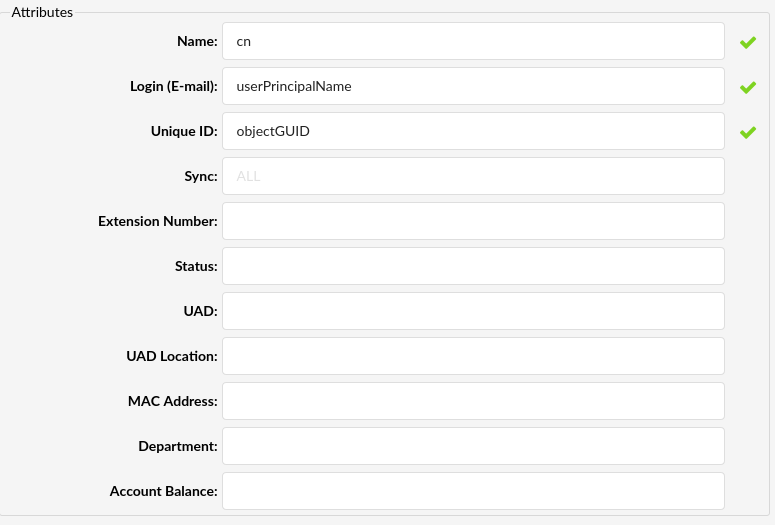
The ‘Attributes’ section allows users to uniquely define the characteristics of the object. Each object has a certain set of attributes which can be changed manually. Attributes are used for mapping the LDAP attributes with the Extensions options found on the system.
NOTE: The first three fields are the required ones. If one of the required fields is not populated, the warning message will pop up. Please refer to the screenshots below.
- Name: Define the Extension Name.
On LDAP servers, this attribute is usually the cn (Common Name) attribute, however any other attribute can be used for the Extension Name.

(E.g. cn)
([a-z][0-9])
- Login (E-mail): Define the name of the attribute used when users are authenticating via LDAP.

This attribute is also used when the synced users are logging into OSC (Online Self Care) and gloCOM application. The 'userPrincipalName' attribute, which is used as an example here, usually looks like an e-mail address.
NOTE: The e-mail provided has to be unique on the system.
-
First Case Scenario: There is an Extension on the system with the 'test@test.com' e-mail, and a user wants to sync a new Extension with the same e-mail. In this case, the sync will fail.
-
Second Case Scenario: There is an already synced Extension on the system with the 'testing@testing.com' e-mail, and a user wants to create a new one with the same e-mail. In this case, the Extension creation will fail.
(E.g. userPrincipalName)
([a-z][0-9])
- Unique ID: Define the name of the attribute which will have a unique value.
NOTE: In order for the application to work optimally, this attribute must be defined for each user and it should not be changed. It has to be defined as a unique value for each user. This is to ensure that all syncs are properly executed and it is possible to recognize when an Extension should be added/modified/deleted.

(E.g. For the Windows server: objectGUID -> This attribute is unique for each user and used to identify different users.)
([a-z][0-9])
- Sync: Define whether a user will be synced or not.
NOTE: All users from the 'Base DN' folder will be synced by default. Also, if the 'Sync' field is left undefined, then all users found on the LDAP server will be synced. If the value is defined, then a user who has the value of this attribute set to 1 will be synced. On the contrary, if the value of this attribute is not set or if it is not 1, then that user will not be synced.
| Sync Values | |
|---|---|
| 1 | A user is synced. |
| Other Values | A user is not synced. |
([0-9])
- Extension Number: The attribute that defines the Extension Number for a specific user. If not set, then the user will get the first available Extension number.
NOTE: It must be numerical and in the bounds of the Extension's digit length. In case, the attribute is set, but the user does not have a set value or s(he) has an invalid value entered, then the sync will not happen. It will fail for this particular user. Also, if this field is populated with 'extNumber' and the 'Sync' button is pressed, this will not be successful. For this to be applied, after populating the field with 'extNumber', a user has to click 'Save' and then 'Sync'.
([a-z][0-9])
- Status: The attribute that defines the Extension status.
Values for this attribute on the LDAP server should be one of the following:
| Status Values | |
|---|---|
| 0 | Not Active |
| 1 | Active |
| 2 | Suspended |
NOTE: The default value is 1.
([0-9])
- UAD: The attribute that defines the UAD that should be set on the Extension.
The value of this attribute has to be the UAD ID (the same usage as the API).
NOTE: Default value is 50 (Generic SIP).
([0-9])
- UAD Location: The attribute that sets the UAD Location.
Values for this attribute on the LDAP server should be one of the following:
| UAD Location Values | |
|---|---|
| 0 | Local |
| 1 | Remote |
NOTE: Default value is 0.
([0-9])
- MAC Address: The attribute that defines the Extension’s MAC Address.
The value of the attribute on the LDAP server must be a valid MAC address containing only numbers and letters.
| Not Allowed Characters | - | _ | : |
([0-9])
- Department: The attribute that defines the Extension’s Department.
The value of the attribute on the LDAP server must be a valid department ID otherwise the field will be ignored.
([a-z][0-9])
- Account Balance: The attribute that defines the initial 'Account Balance' for the synced user.
The balance will be set when the Extension is created and will not be updated if the value on the LDAP server changes.
NOTE: This attribute will be applied only if an Extension is added through DSM. Any modifications done to the Extension will not change the 'Account Balance' (even if the attribute is renamed to another one). The renamed one, however, will be applied to newly created Extensions.
([0-9])
¶ Notifications

- E-mail Extension data to users: Select whether to receive an e-mail when creating an Extension.
(E.g. Not Set)
(Option button)
NOTE: If set to 'Yes', the synced users will receive an e-mail with their Extension details when the Extension is created. This is the same as the 'Save & Email' option on the 'Extension' section -> 'Edit'.
¶ E-mail Templates
Users can select a specific template for the e-mails sent by the system. By default, several macros are used and it is easy for users to modify the templates.
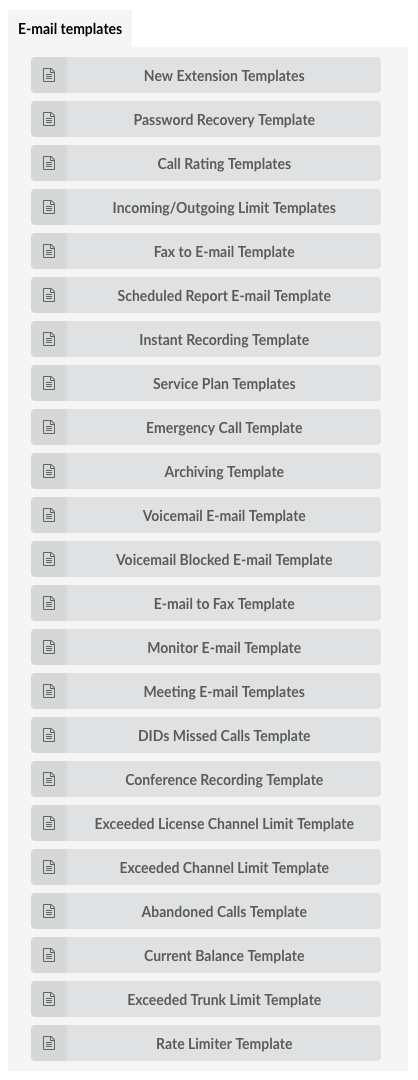
NOTE: The settings can be reset to default by clicking the 'Reset' button.
¶ New Extension Templates
Set e-mail templates which are used to send basic information about a newly created Extension.
NOTE: After introducing PBXware 4, the system started providing users with an e-mail and user password used for gloCOM registration. However, in some cases, when phones were not auto-provisioned, users still required their desk phone registration details to be sent which was not possible at that moment.
For this reason, we have added variables for a SIP User ID - %USERNAME% and the Extension Secret - %SECRET% that can be used to add the information to the e-mail template if required. We have also introduced the variable %PROXY% to e-mail templates that reference the value of gloCOM SIP Proxy in Tenant Settings.
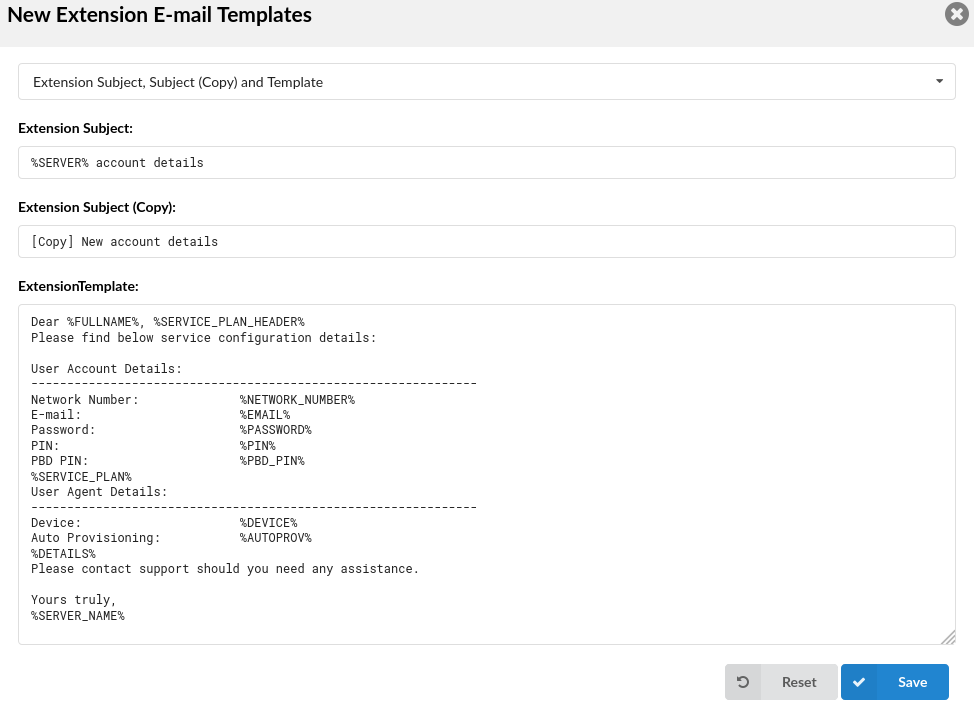
| New Extension Templates | |||||||||
|---|---|---|---|---|---|---|---|---|---|
| Variable | Meaning | ||||||||
| SUBJECT | %SERVER% | Server/Tenant Name | |||||||
| TEMPLATE | %FULLNAME% | Extension Name | |||||||
| %SERVICE_PLAN_HEADER% | Service Plan (Name) | ||||||||
| %NETWORK_NUMBER% | Extension Number | ||||||||
| %EMAIL% | E-mail of an Extension | ||||||||
| %DID% | DID numbers assigned to the Extension (max. 5 DIDs exposed) | ||||||||
| %PASSWORD% | User Password | ||||||||
| %PIN% | PIN | ||||||||
| %PBD_PIN% | PBD PIN | ||||||||
| %SERVICE_PLAN% | Service Plan of an Extension | ||||||||
| %DEVICE% | UAD | ||||||||
| %AUTOPROV% | Auto Provisioning | ||||||||
| %DETAILS% | Extension Details (E-mail, Password, Server) | ||||||||
| %SERVER_NAME% | Server/Tenant Name |
¶ Password Recovery Template (5.4)
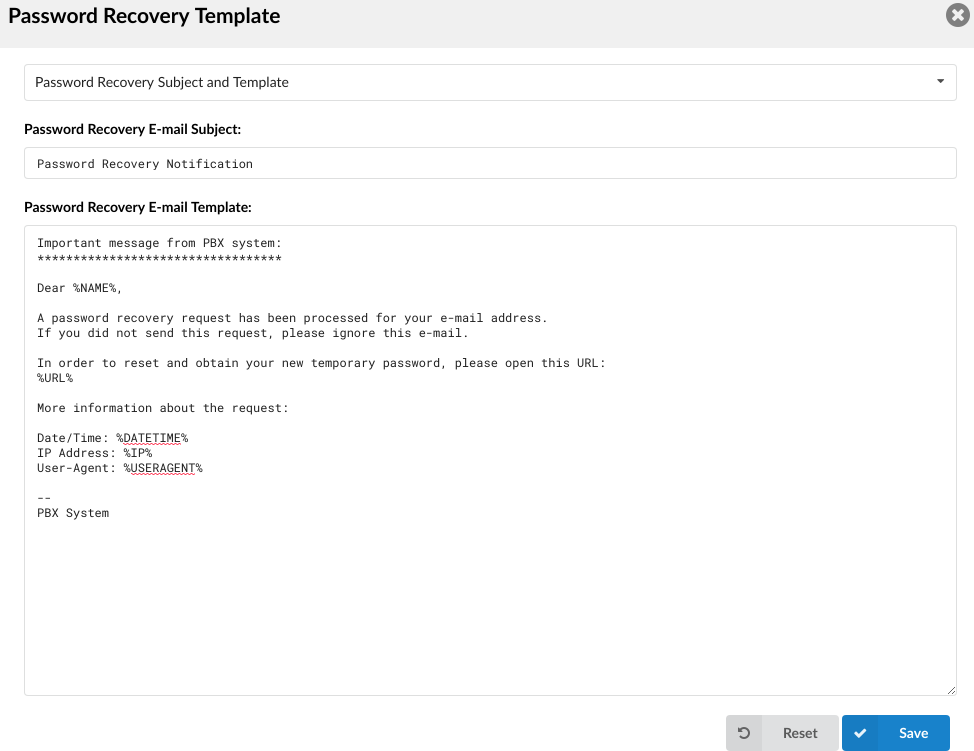
The ability to change the e-mail template for Forgot my password when users request a password change.
| Password Recovery Template | |||||||||
|---|---|---|---|---|---|---|---|---|---|
| Variable | Meaning | ||||||||
| TEMPLATE | %NAME% | Name | |||||||
| %URL% | URL for Password Recovery | ||||||||
| %DATETIME% | Date/Time of a Password Recovery Request | ||||||||
| %IP% | IP Address of a Request | ||||||||
| %USERAGENT% | User Agent Used for a Request |
¶ Call Rating Templates
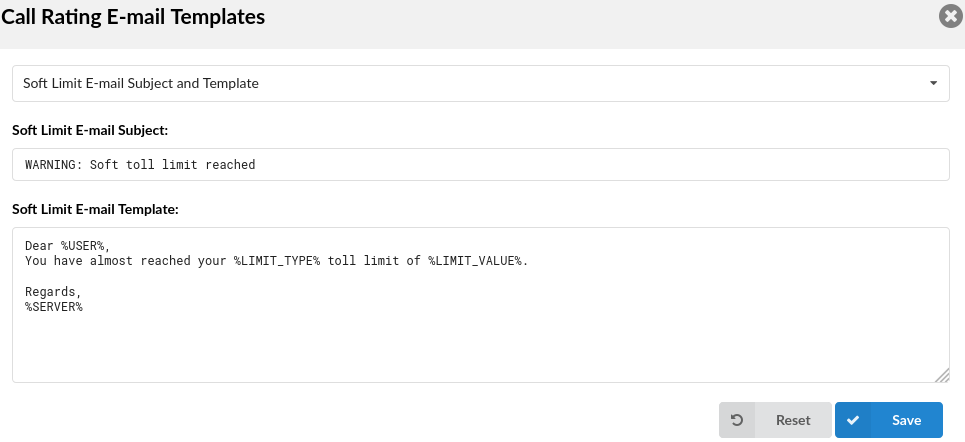
This is used to set an e-mail template for Extensions' soft and hard call rating limits.
NOTE: %CALLERID% is added to e-mail templates in 'Subject' and will be replaced with a Caller ID number.
| Call Rating Templates | |||||||||
|---|---|---|---|---|---|---|---|---|---|
| Variable | Meaning | ||||||||
| TEMPLATE | %USER% | Extension Name | |||||||
| %LIMIT_TYPE% | Limit Type | ||||||||
| %LIMIT_VALUE% | Limit Value | ||||||||
| %SERVER% | Server/Tenant Name |
¶ Incoming/Outgoing Limit Templates
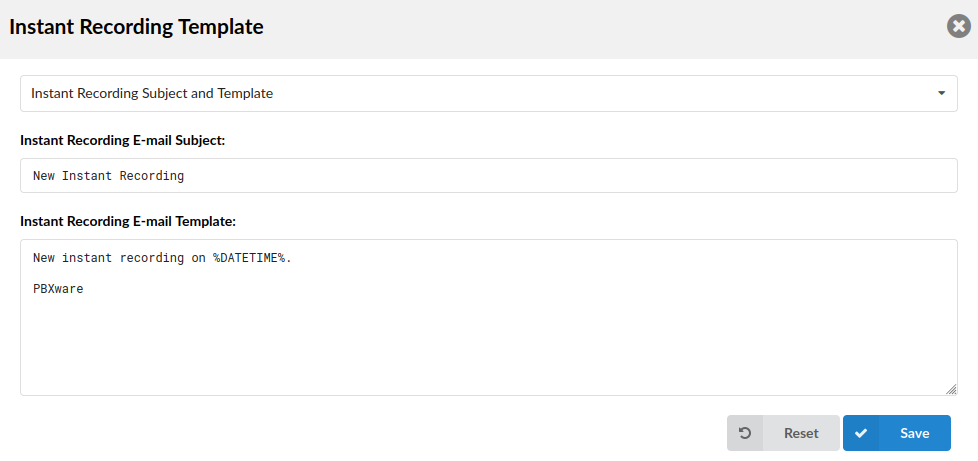
Set the e-mail template used for sending e-mails when an Extension reaches its limit for incoming/outgoing number of channels.
NOTE: %CALLERID% is added to e-mail templates in 'Subject' and will be replaced with a Caller ID number.
| Incoming/Outgoing Limit Templates | |||||||||
|---|---|---|---|---|---|---|---|---|---|
| Variable | Meaning | ||||||||
| SUBJECT | %LIMIT_TYPE% | Incoming/Outgoing Limit | |||||||
| TEMPLATE | %USER% | Extension Name | |||||||
| %LIMIT_TYPE% | Incoming/Outgoing Limit | ||||||||
| %SERVER% | Server/Tenant Name |
¶ Fax To E-mail Template
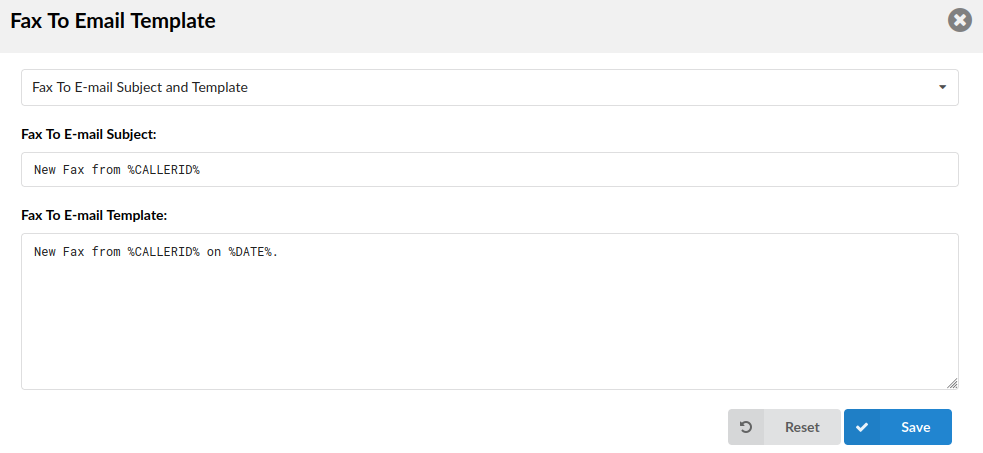
Set the e-mail template used for sending fax to e-mail when a fax is received.
NOTE: %CALLERIDNAME% will be replaced with a Caller ID Name. %DESTNUM% will be replaced with the DID number.
NOTE: Please note that this feature - '%RSID%' is part of the beta release and is only visible to beta testers. Once the stable version is released, it will be available for general use.
NOTE: %RSID% can be added to the subject of a template and to a template itself.
| Fax To E-mail Template | |||||||||
|---|---|---|---|---|---|---|---|---|---|
| Default Variables | Meaning | Can Be Applied to | |||||||
| %CALLERID% | CallerID | Subject; Template | |||||||
| %DATE% | Date of a Fax | Template | |||||||
| Other Available Variables | Meaning | Can Be Applied to | |||||||
| %RSID% | Remote Station ID | Subject; Template | |||||||
| %CALLERIDNAME% | CallerID Name | Template | |||||||
| %DESTNUM% | DID number | Template |
¶ Scheduled Report Email Template
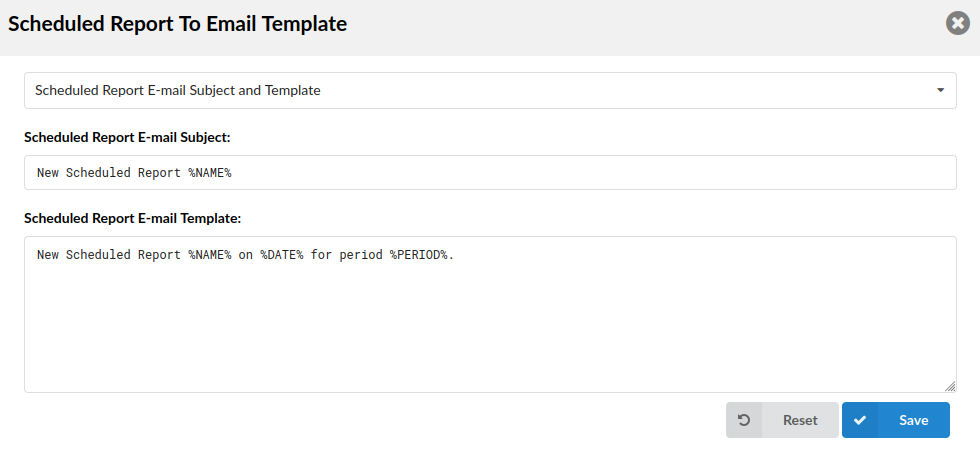
Scheduled Report Email Template
Set the e-mail template used for sending scheduled reports from a Queue.
| Scheduled Report Email Template | |||||||||
|---|---|---|---|---|---|---|---|---|---|
| Variable | Meaning | ||||||||
| SUBJECT | %NAME% | Name of a Scheduled Report | |||||||
| TEMPLATE | %NAME% | Name of a Scheduled Report | |||||||
| %DATE% | Date of a Scheduled Report | ||||||||
| %PERIOD% | Period That It Observed |
¶ Instant Recording Template

Set the e-mail template used for sending out instant recording e-mails.
NOTE: %CALLERID% is added to e-mail templates in 'Subject' and will be replaced with a Caller ID number.
| Instant Recording Template | |||||||||
|---|---|---|---|---|---|---|---|---|---|
| Variable | Meaning | ||||||||
| TEMPLATE | %DATETIME% | Date/time of an Instant Recording |
¶ Service Plans Template
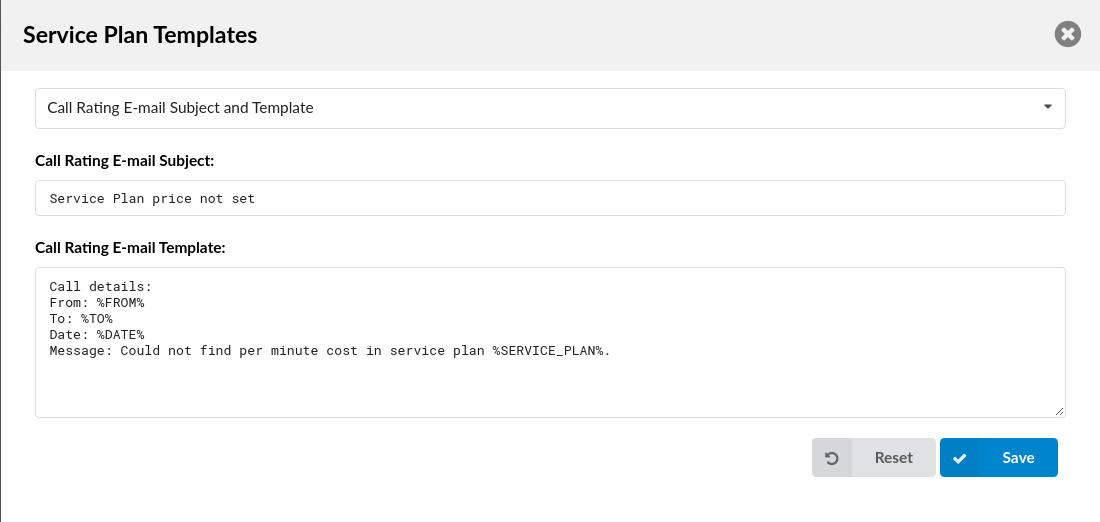
Set the e-mail template used for sending e-mails when a service plan price is not set.
NOTE: %CALLERID% is added to e-mail templates in 'Subject' and will be replaced with a Caller ID number.
| Service Plans Templates | |||||||||
|---|---|---|---|---|---|---|---|---|---|
| Variable | Meaning | ||||||||
| TEMPLATE | %FROM% | From | |||||||
| %TO% | To | ||||||||
| %DATE% | Date | ||||||||
| %SERVICE_PLAN% | Service Plan of an Extension |
¶ Emergency Call Template
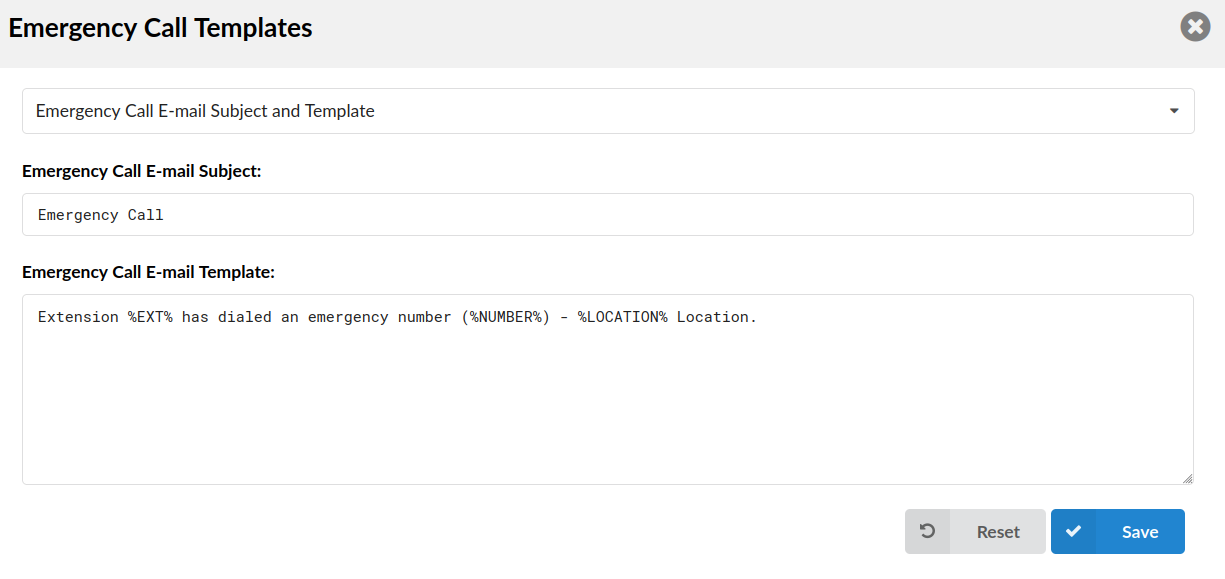
Set the e-mail template used for sending e-mails when a new Emergency Call is created.
NOTE: %CALLERID% is added to e-mail Templates in 'Subject' and will be replaced with a Caller ID number. %TENANT_CODE% and %SERVER_NAME% can be added to the 'Subject' field and the body of an e-mail.
| Emergency Call Template | |||||||||
|---|---|---|---|---|---|---|---|---|---|
| Variable | Meaning | ||||||||
| TEMPLATE | %EXT% | Extension Number | |||||||
| %NUMBER% | Emergency Number | ||||||||
| %LOCATION% | Location | ||||||||
| %FULLNAME% | Name associated with the extension that made the call to the Emergency services number. |
NOTE: In version 6.7.5 we added the new variable %FULLNAME%, which can be used with the Emergency Call E-mail template:
%FULLNAME% - Name associated with the extension that made the call to the Emergency services number.
E-mail notification sample:
John Doe from extension 215 has dialed an emergency number (911).
¶ Archiving E-mail Template
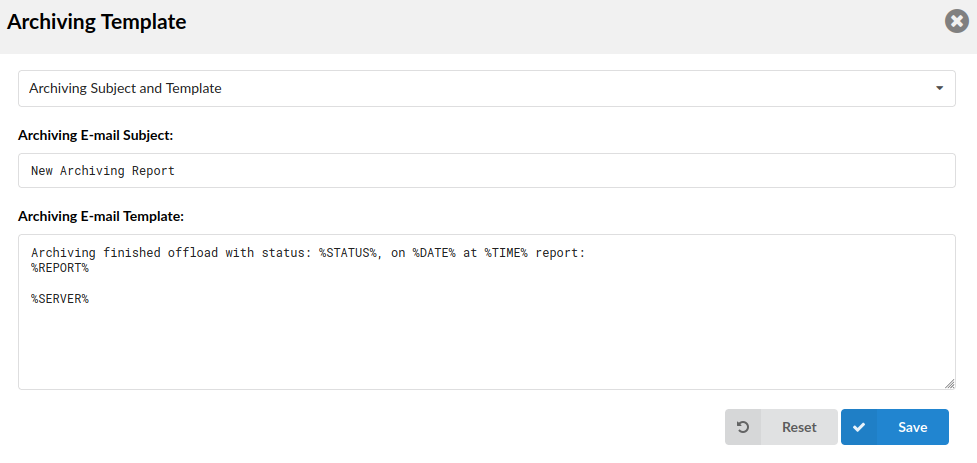
Set the e-mail template used for sending e-mails when the Archiving status changes.
| Archiving Template | |||||||||
|---|---|---|---|---|---|---|---|---|---|
| Variable | Meaning | ||||||||
| TEMPLATE | %STATUS% | Status of Offload | |||||||
| %DATE% | Date of Finishing | ||||||||
| %TIME% | Time | ||||||||
| %REPORT% | Report | ||||||||
| %SERVER% | Server/Tenant Name |
¶ Voicemail E-mail Template
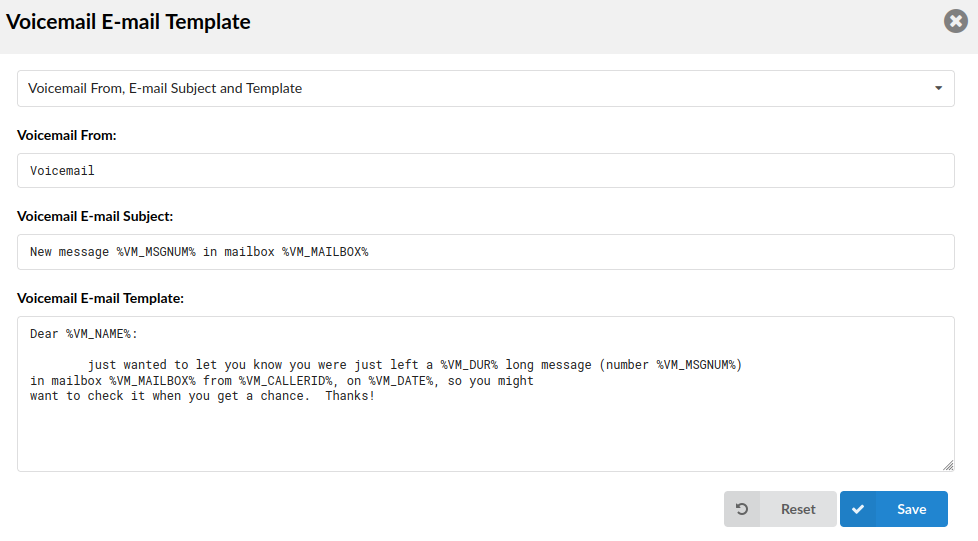
Set the e-mail template used for sending e-mails when a new voicemail is received.
| Voicemail E-mail Template | |||||||||
|---|---|---|---|---|---|---|---|---|---|
| Variable | Meaning | ||||||||
| SUBJECT | %VM_MSGNUM% | Number of a Voicemail Message | |||||||
| %VM_MAILBOX% | Voicemail Mailbox | ||||||||
| TEMPLATE | %VM_NAME% | Voicemail Name | |||||||
| %VM_DUR% | Duration of a Voicemail Message | ||||||||
| %VM_MSGNUM% | Number of a Voicemail Message | ||||||||
| %VM_MAILBOX% | Voicemail Mailbox | ||||||||
| %VM_CALLERID% | Caller ID of a Voicemail Sender | ||||||||
| %VM_CIDNUM% | Caller ID Number of a Voicemail Sender | ||||||||
| %VM_CIDNAME% | Caller ID Name of a Voicemail Sender (If available) | ||||||||
| %VM_DID% | DID number call came in from | ||||||||
| %VM_DATE% | Date of a Voicemail | ||||||||
| %VM_FILE% | Name of the file (eg. msg000.WAV) | ||||||||
| %VM_DELETE% | Information if voicemail will be deleted | ||||||||
| %VM_LOCAL_DATE% | Localized date according to selected locale | ||||||||
| %VM_TIME% | Time formatted according to selected locale | ||||||||
| %SERVER% | Server's Unique ID number | ||||||||
| %SERVER_NAME% | Server name |
NOTE: In version 6.7.1 we have added a new e-mail template variable used in Voicemail to E-mail notification message.
The new variable is %VM_DID% and it provides the information on DID number the incoming call came from. Information will be displayed in Dialed DID field, but If an incoming call comes from a local extension, this field will be empty.
NOTE: In version 6.7.5 we have added two new variables that can be used with the Voicemail notification E-mail template:
%SERVER% - Unique Server/Tenant ID number
%SERVER_NAME% - Server/Tenant nameWith both variables added to the template, this is what should be displayed once the e-mail is received:
Server: 2
Server name: Your-Company-Name
¶ Voicemail Blocked E-mail Template
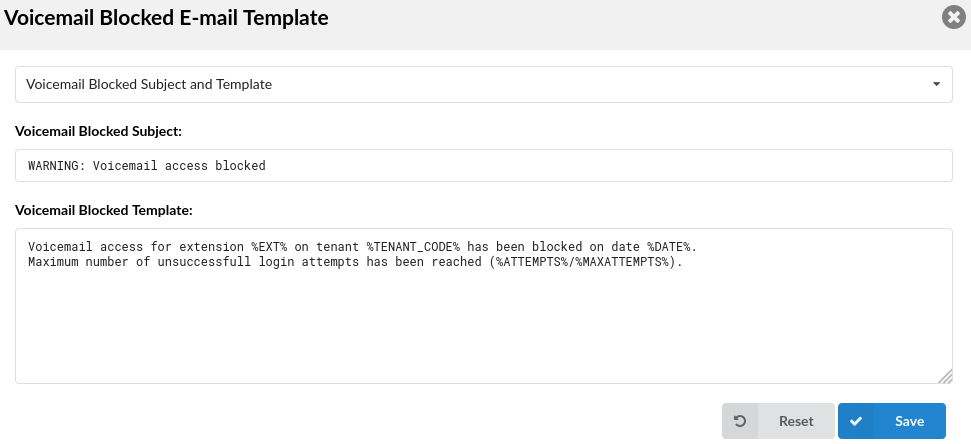
Set the e-mail template used for sending e-mails when a new voicemail is blocked.
NOTE: Please note that emails regarding voicemail blocked notifications will be sent to all Administrators set under 'Site Accounts' > 'Administrators'.
| Voicemail Blocked E-mail Template | |||||||||
|---|---|---|---|---|---|---|---|---|---|
| Variable | Meaning | ||||||||
| TEMPLATE | %EXT% | Extension Number | |||||||
| %DATE% | Date of a Blocking Voicemail | ||||||||
| %ATTEMPTS% | Number of Attempts | ||||||||
| %MAXATTEMPTS% | Number of Max. Attempts |
¶ E-mail to Fax Template
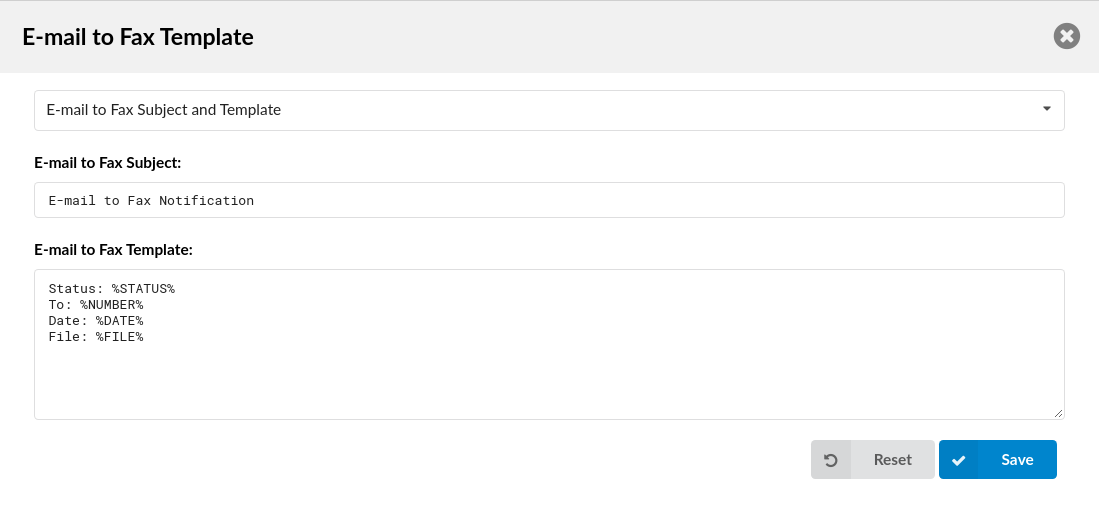
Set the e-mail template used for sending e-mails when a new e-mail to fax is sent.
| E-mail to Fax Template | |||||||||
|---|---|---|---|---|---|---|---|---|---|
| Variable | Meaning | ||||||||
| TEMPLATE | %STATUS% | Sent Fax Status | |||||||
| %NUMBER% | Extension number to which the fax was sent | ||||||||
| %DATE% | Date | ||||||||
| %FILE% | File to be sent |
¶ Monitor E-mail Template
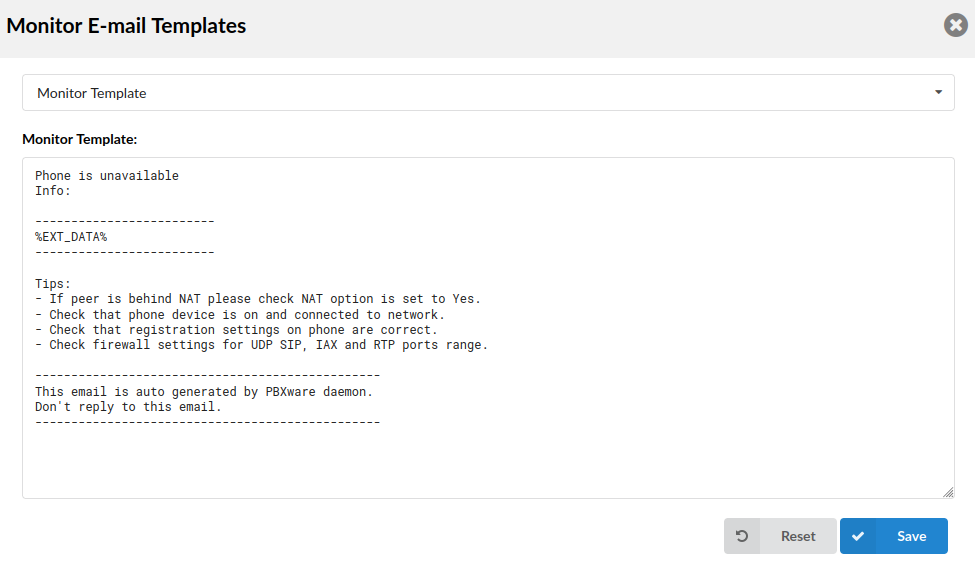
Set the e-mail template to receive additional information regarding monitoring.
| Monitor E-mail Template | |||||||||
|---|---|---|---|---|---|---|---|---|---|
| Variable | Meaning | ||||||||
| TEMPLATE | %EXT_DATA% | Extension Data |
¶ Meeting E-mail Templates
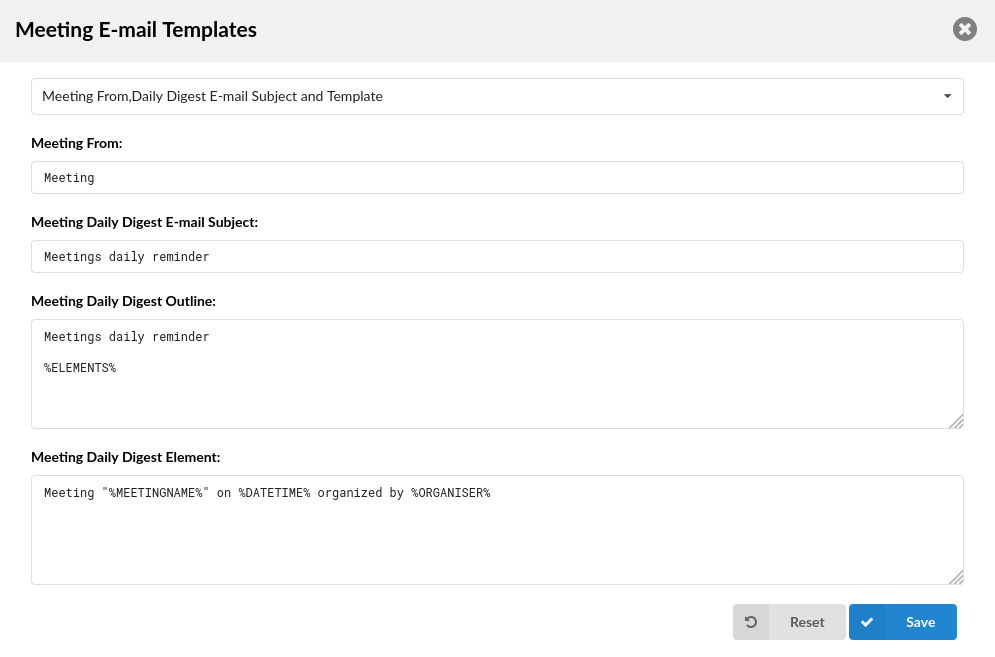
Set the e-mail template used for sending e-mails when a new meeting is created, updated, or canceled.
NOTE: %DURATION% represents the meeting's time duration. %DIDS% shows DIDs to dial, if joining the meeting's audio conference only. %DID_LINKS% is similar to DIDs, but formatted as a tel:// link. The link contains the appropriate user information which the dialing client can use to send DTMF signals i.e. 'Meeting Number' and 'Participant Number' so that the user does not have to type them.
¶ Meeting Daily E-mails

Set the e-mail template used for sending daily meeting e-mails containing information on any scheduled meetings for the day. For daily meetings, the Outline and Element templates work together to form an e-mail.
NOTE: The list of upcoming meetings for that day will get placed where the %ELEMENTS% tag is. The Element template describes a single entry in the list, which will get repeated accordingly.
| Meeting Daily E-mails | |||||||||
|---|---|---|---|---|---|---|---|---|---|
| Variable | Meaning | ||||||||
| OUTLINE | %ELEMENTS% | Elements of a Meeting | |||||||
| ELEMENT | %MEETINGNAME% | Meeting Name | |||||||
| %DATETIME% | Date/Time of a Meeting | ||||||||
| %ORGANISER% | Organiser of a Meeting | ||||||||
| %APPNAME% | Name of the application | ||||||||
| %ELEMENTS% | Elements of a Meeting | ||||||||
| %YEAR% | Current Year | ||||||||
| %MEETINGNUMBER% | Number of a Meeting | ||||||||
| %TIME% | Meeting Start Time | ||||||||
| %JOINLINK% | Link to web application meeting link |
¶ Meeting Invite E-mails
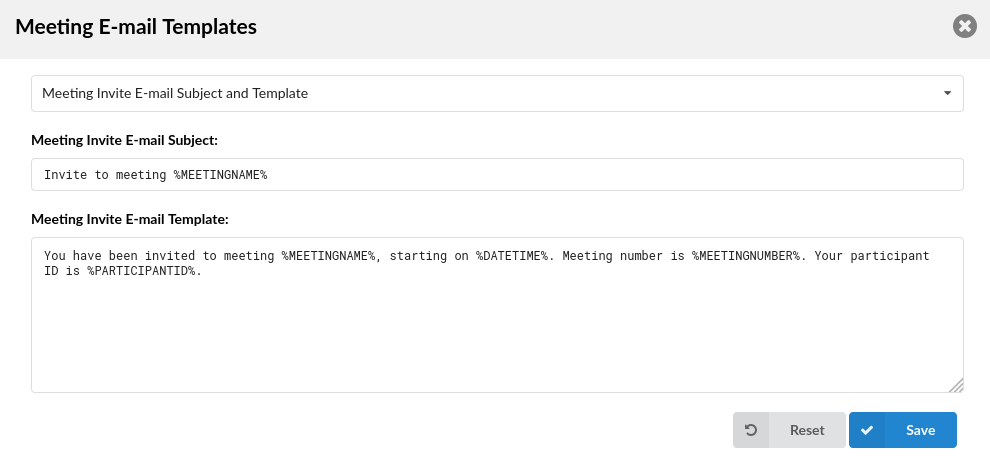
Set the e-mail template used for sending e-mails to participants when a new meeting is created.
| Meeting Invite E-mails | |||||||||
|---|---|---|---|---|---|---|---|---|---|
| Variable | Meaning | ||||||||
| SUBJECT | %MEETINGNAME% | Name of a Meeting That You Were Invited To | |||||||
| TEMPLATE | %MEETINGNAME% | Name of a Meeting That You Were Invited To | |||||||
| %DATETIME% | Start Time of a Meeting | ||||||||
| %MEETINGNUMBER% | Number of a Meeting | ||||||||
| %PARTICIPANTID% | Your Participant's ID | ||||||||
| %APPNAME% | Name of the application | ||||||||
| %ORGANISER% | Meeting Organiser | ||||||||
| %JOINLINK% | Link to web application meeting link | ||||||||
| %DURATION% | Duration of the meeting | ||||||||
| %DID_LINKS% | Link to Call-in number | ||||||||
| %YEAR% | Current Year | ||||||||
| %MEETINGDESCRIPTION% | Meeting Description |
¶ Meeting Update E-mail Template
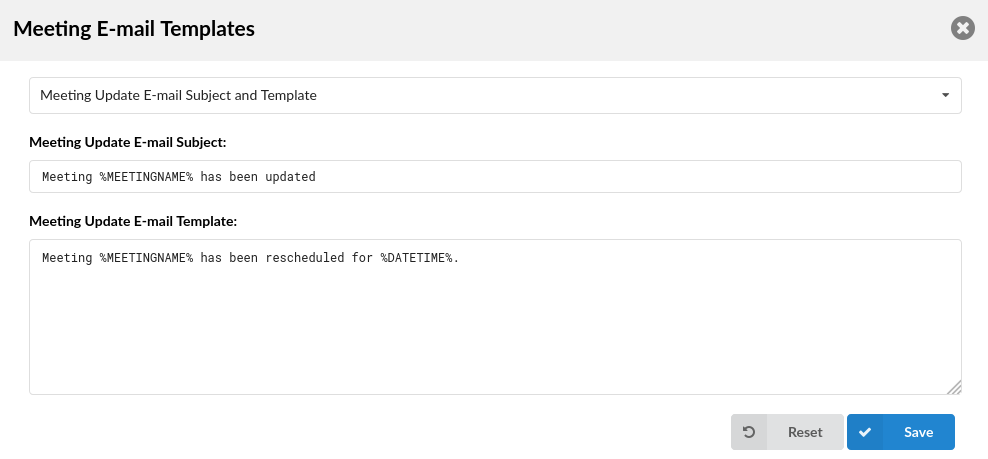
Set the e-mail template used for sending e-mails to participants when the meeting has been updated.
| Meeting Update E-mails | |||||||||
|---|---|---|---|---|---|---|---|---|---|
| Variable | Meaning | ||||||||
| SUBJECT | %MEETINGNAME% | Name of a Meeting That Has Been Updated | |||||||
| TEMPLATE | %MEETINGNAME% | Name of a Meeting That Has Been Updated | |||||||
| %DATETIME% | New Start Time of a Meeting | ||||||||
| %APPNAME% | Name of the application | ||||||||
| %ORGANISER% | Meeting Organiser | ||||||||
| %MEETINGNUMBER% | Number of a Meeting | ||||||||
| %DURATION% | Duration of the meeting | ||||||||
| %PARTICIPANTID% | Your Participant's ID | ||||||||
| %DID_LINKS% | Link to Call-in number | ||||||||
| %YEAR% | Current Year | ||||||||
| %MEETINGDESCRIPTION% | Meeting Description |
¶ Meeting Canceled E-mail Template
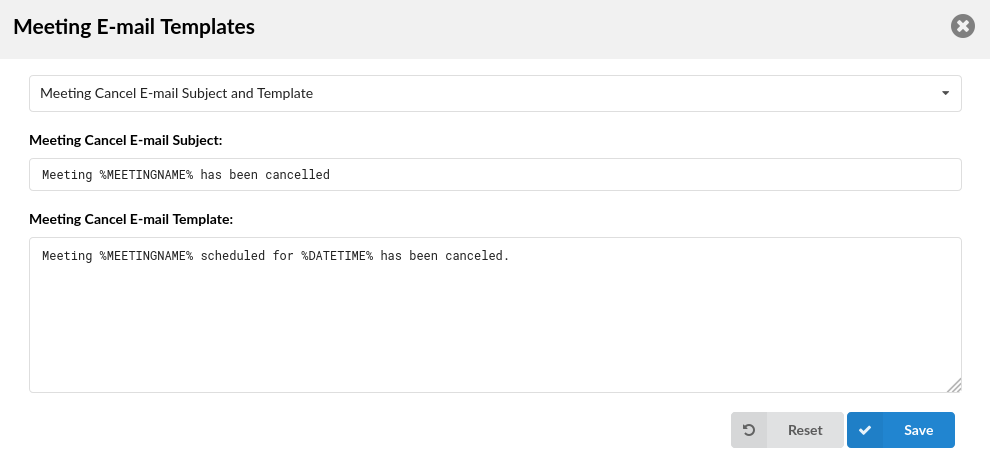
Set the e-mail template used for sending e-mails to participants when the meeting has been canceled.
| Meeting Cancel E-mails | |||||||||
|---|---|---|---|---|---|---|---|---|---|
| Variable | Meaning | ||||||||
| SUBJECT | %MEETINGNAME% | Name of a Meeting That Has Been Canceled | |||||||
| TEMPLATE | %MEETINGNAME% | Name of a Meeting That Has Been Canceled | |||||||
| %DATETIME% | Start Time of a Canceled Meeting | ||||||||
| %APPNAME% | Name of the application | ||||||||
| %MEETINGNUMBER% | Number of a Meeting | ||||||||
| %DURATION% | Duration of the meeting | ||||||||
| %PARTICIPANTID% | Your Participant's ID | ||||||||
| %YEAR% | Current Year | ||||||||
| %MEETINGDESCRIPTION% | Meeting Description |
¶ DIDs Missed Calls Template
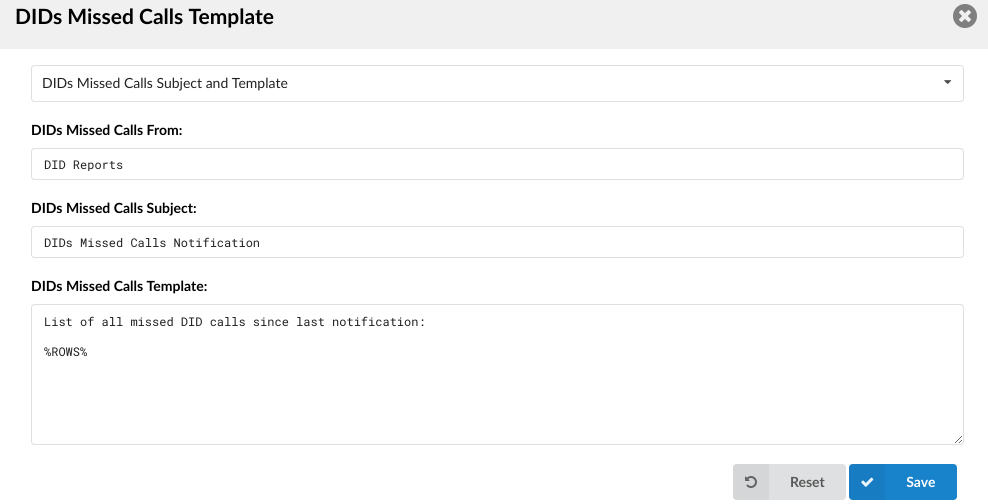
Set the e-mail template to be generated for any missed calls on a DID.
| DIDs Missed Calls Template | |||||||||
|---|---|---|---|---|---|---|---|---|---|
| Variable | Meaning | ||||||||
| TEMPLATE | %ROWS% | Rows of All Missed DID Calls |
¶ Conference Recording Template
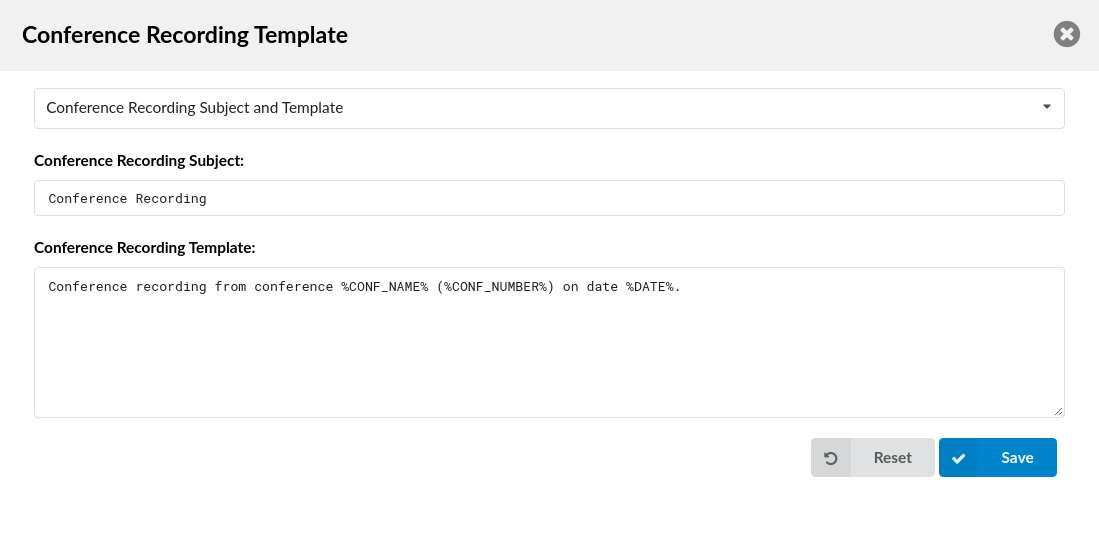
Set the e-mail template used for sending e-mails when a new conference recording is created.
| Conference Recording Template | |||||||||
|---|---|---|---|---|---|---|---|---|---|
| Variable | Meaning | ||||||||
| TEMPLATE | %CONF_NAME% | Conference Name | |||||||
| %CONF_NUMBER% | Conference Number | ||||||||
| %DATE% | Date of a Conference Recording |
¶ Directory Sync Summary Template
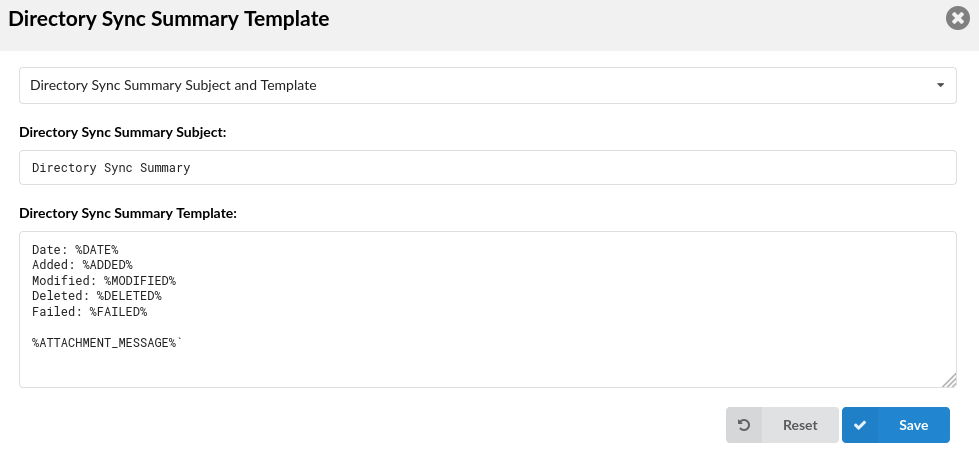
Set the e-mail template to be generated for any changes, errors, or failed Extension syncs. The %ATTACHMENT_MESSAGE% variable refers to the .txt file that will be sent together with the e-mail. It contains further information about why the sync failed or the problem arose.
NOTE: The %SERVER% variable can be added to the e-mail template.
| Directory Sync Summary Template | |||||||||
|---|---|---|---|---|---|---|---|---|---|
| Variable | Meaning | ||||||||
| TEMPLATE | %DATE% | Conference Name | |||||||
| %ADDED% | Added | ||||||||
| %MODIFIED% | Modified | ||||||||
| %DELETED% | Deleted | ||||||||
| %FAILED% | Failed | ||||||||
| %ATTACHMENT_MESSAGE% | Attachment Message |
¶ Exceeded License Channel Limit Template (7.4)
Set the e-mail template that is triggered when the system reaches the maximum channel limit defined in the license. It enables users to customize the e-mail message that will be sent upon reaching this limit.
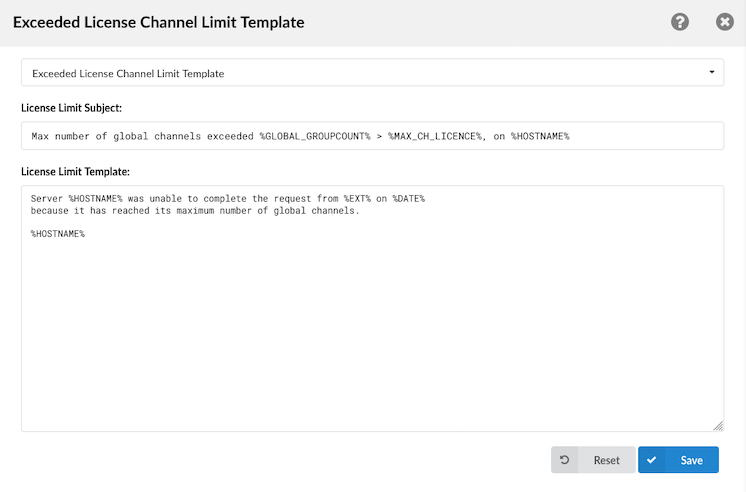
NOTE: This template has a one-hour limit, meaning a new e-mail will only be sent once per hour.
Below is a list of variables that can be used in this template.
| Exceeded License Channel Limit Template | |||||||||
|---|---|---|---|---|---|---|---|---|---|
| Variable | Meaning | ||||||||
| SUBJECT | %GLOBAL_GROUPCOUNT% | Global Channels Count | |||||||
| %MAX_CH_LICENCE% | Maximum Number of Channels On the License | ||||||||
| %HOSTNAME% | Hostname | ||||||||
| TEMPLATE | %HOSTNAME% | Hostname | |||||||
| %EXT% | Extension Number | ||||||||
| %DATE% | Date and Time |
¶ Exceeded Channel Limit Template (7.4)
Set up the e-mail template to send notifications when any channel limits in the Server settings are exceeded.
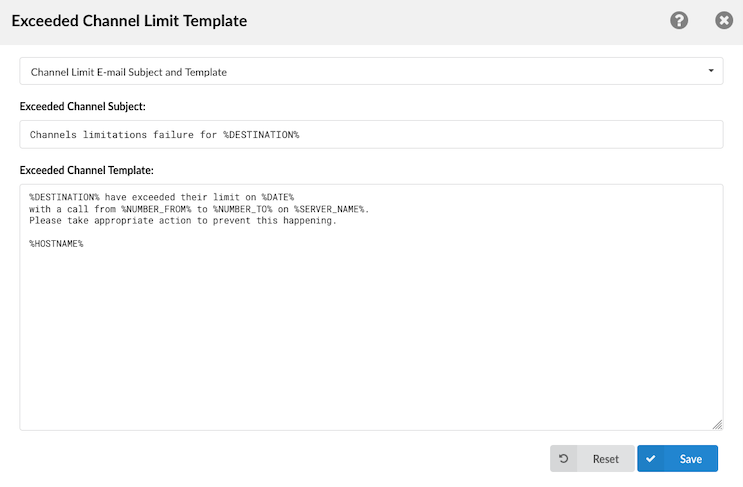
NOTE: This template has a one-hour limit, meaning a new e-mail will only be sent once per hour.
Below is a list of variables that can be used in this template.
| Exceeded Channel Limit Template | |||||||||
|---|---|---|---|---|---|---|---|---|---|
| Variable | Meaning | ||||||||
| SUBJECT | %DESTINATION% | Destination Channel | |||||||
| TEMPLATE | %DESTINATION% | Destination Channel | |||||||
| %DATE% | Date and Time | ||||||||
| %NUMBER_FROM% | Number of an extension that generated the call | ||||||||
| %NUMBER_TO% | Called Number | ||||||||
| %SERVER_NAME% | Server Name | ||||||||
| %HOSTNAME% | Hostname |
¶ Abandoned Calls Template (7.4)
Set the e-mail template used for sending e-mails when abandoned calls occur on the Enhanced Ring Group. An e-mail will be sent to the address specified in the 'Notification Email Address' field under the 'Abandoned Calls Notification' section in the Enhanced Ring Group settings.
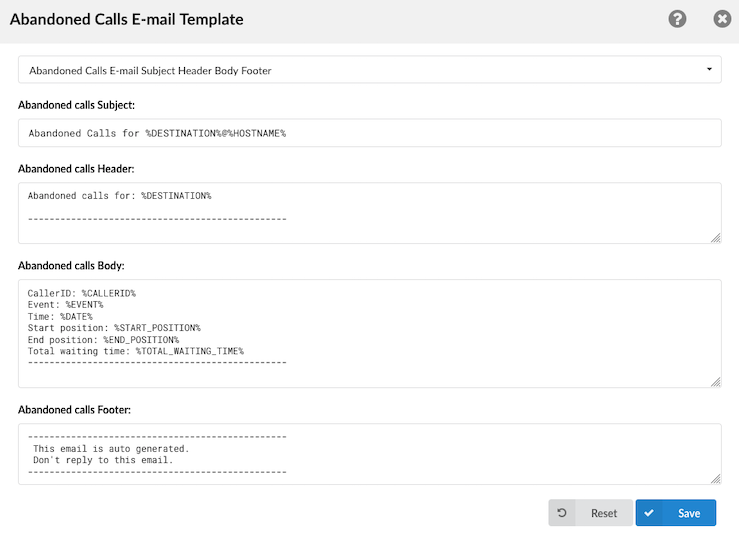
NOTE: This template has a one-hour limit, meaning a new e-mail will only be sent once per hour.
Below is a list of variables that can be used in this template.
| Abandoned Calls Template | |||||||||
|---|---|---|---|---|---|---|---|---|---|
| Variable | Meaning | ||||||||
| SUBJECT | %DESTINATION% | Enhanced Ring Group name | |||||||
| %HOSTNAME% | Hostname | ||||||||
| HEADER | %DESTINATION% | Enhanced Ring Group name | |||||||
| BODY | %CALLERID% | Caller ID | |||||||
| %HOSTNAME% | Hostname | ||||||||
| %EVENT% | Event | ||||||||
| %DATE% | Date and Time | ||||||||
| %START_POSITION% | Start Position | ||||||||
| %END_POSITION% | End Position | ||||||||
| %TOTAL_WAITING_TIME% | Total Waiting Time of the caller |
¶ Current Balance Template (7.4)
Set the e-mail template used for sending e-mails to notify the user when the reminder balance is reached.
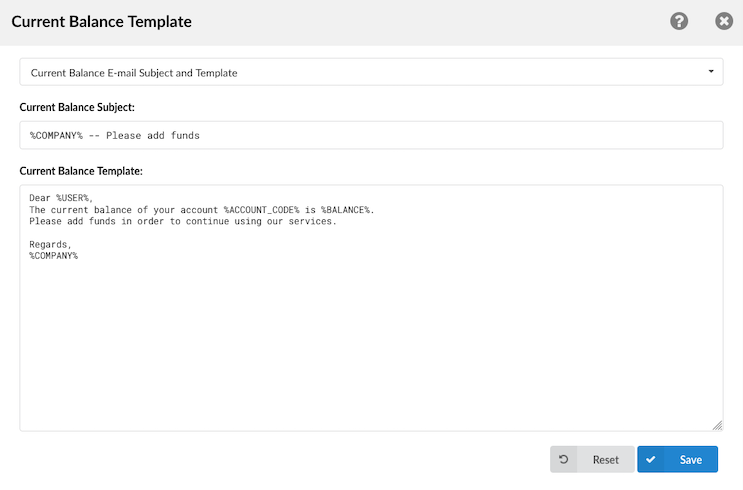
Below is a list of variables that can be used in this template.
| Current Balance Template | |||||||||
|---|---|---|---|---|---|---|---|---|---|
| Variable | Meaning | ||||||||
| SUBJECT | %COMPANY% | Server Name | |||||||
| TEMPLATE | %USER% | Extension Name | |||||||
| %ACCOUNT_CODE% | Account Code | ||||||||
| %BALANCE% | Current Balance | ||||||||
| %COMPANY% | Server Name |
¶ Exceeded Trunk Limit Template (7.4)
Set the e-mail template used for sending e-mails when the outgoing limit in the 'Channels' section on the trunk is exceeded. If an option 'E-mail on exceeded limit' in the 'Channel' section on the trunk is set to 'No', e-mails will not be sent even if outgoing limit is exceeded.
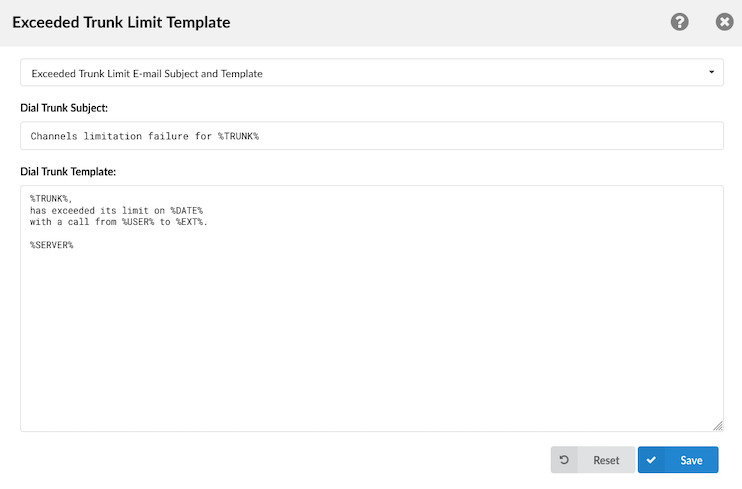
NOTE: This template has a one-hour limit, meaning a new e-mail will not be sent more than once per hour.
Below is a list of variables that can be used in this template.
| Exceeded Trunk Limit Template | |||||||||
|---|---|---|---|---|---|---|---|---|---|
| Variable | Meaning | ||||||||
| SUBJECT | %TRUNK% | Trunk Name | |||||||
| TEMPLATE | %TRUNK% | Trunk Name | |||||||
| %DATE% | Date and Time | ||||||||
| %USER% | Extension number that initiates a call | ||||||||
| %EXT% | Called Number | ||||||||
| %SERVER% | Server Number |
¶ Rate Limiter Template (7.4)
Set the e-mail template used for sending notifications when an extension exceeds the rate limit for sequential calls. Sequential calls refer to multiple calls made in quick succession to the same number. Once this limit is exceeded, the extension will be restricted from calling the same number.
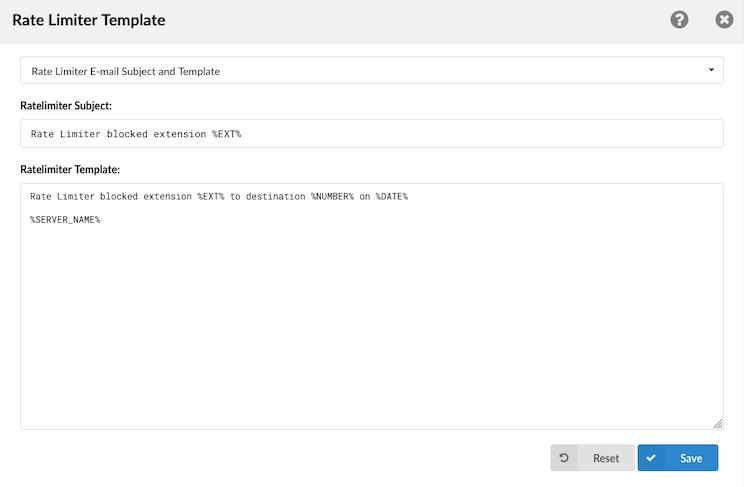
NOTE: The default rate limit is six, meaning that after six sequential calls, the extension will be restricted from calling the same number. The rate limiter is applied when an extension makes sequential calls to numbers with five or more digits.
Below is a list of variables that can be used in this template.
| Rate Limiter Template | |||||||||
|---|---|---|---|---|---|---|---|---|---|
| Variable | Meaning | ||||||||
| SUBJECT | %EXT% | Extension number that initiates a call | |||||||
| TEMPLATE | %EXT% | Extension number that initiates a call | |||||||
| %NUMBER% | Called Number | ||||||||
| %DATE% | Date and Time | ||||||||
| %SERVER_NAME% | Server Name |
¶ E-mail Notifications
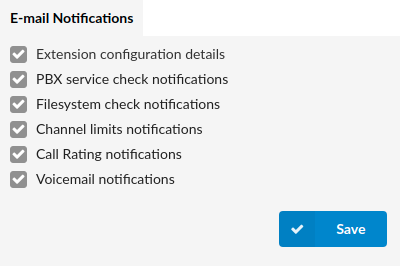
Here you can choose which notifications will you receive on email.
- Extension configuration details
Check this option if you want to receive configuration details of extensions you create on your system.
- PBX service check notifications
Whether you want to receive notifications on PBX services.
- Filesystem check notifications
Whether you want to receive filesystem notifications.
- Channel limits notifications
Check this option if you want to receive notifications on your channel limits.
- Call Rating Notifications
Whether you want to receive notifications on Call Rating.
- Voicemail Notifications
Whether you want to receive notifications on Voicemail.
¶ SMS Settings
¶ Notifications
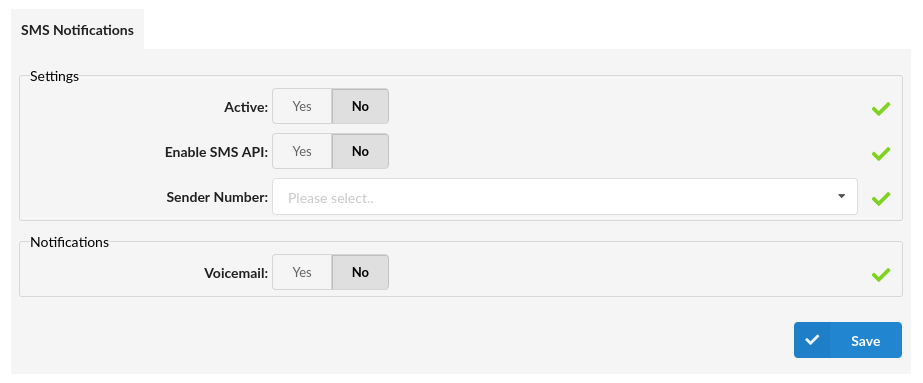
The Notifications settings page within SMS Settings is used to configure and manage how the system sends SMS alerts for specific events, such as voicemails.
- Active
This feature allows users to enable/disable SMS notifications. To enable them, set this option to ‘Yes’.
- Enable SMS API
This feature is used to control whether sending SMS notifications via API is allowed or not. Set this option to ‘Yes’ in order to enable it.
NOTE: In order to send the notifications via API, the action should also be allowed for the API Key that will be used with the request.
-
Sender Number
This field is used to specify the SMS number from which SMS notifications will be sent. This field should be populated with one of the SMS numbers you have available in the SMS numbers list, and it should be a valid SMS number. -
Voicemail
When enabled (set to ‘Yes’), this option sends an SMS notification to the assigned SMS number whenever a new voicemail is received on the user's extension. To function properly, the extension must have a valid SMS number associated with it.
¶ Templates

The SMS Templates section lists available SMS notifications PBXware sends on different events. Just like with E-mail templates, administrators can modify the content of each notification and adapt it to their needs.
- SMS Voicemail Template
The SMS Voicemail template allows you to modify the content of the SMS Voicemail notifications sent to the user’s mobile number when a new Voicemail is received on their PBXware extension.
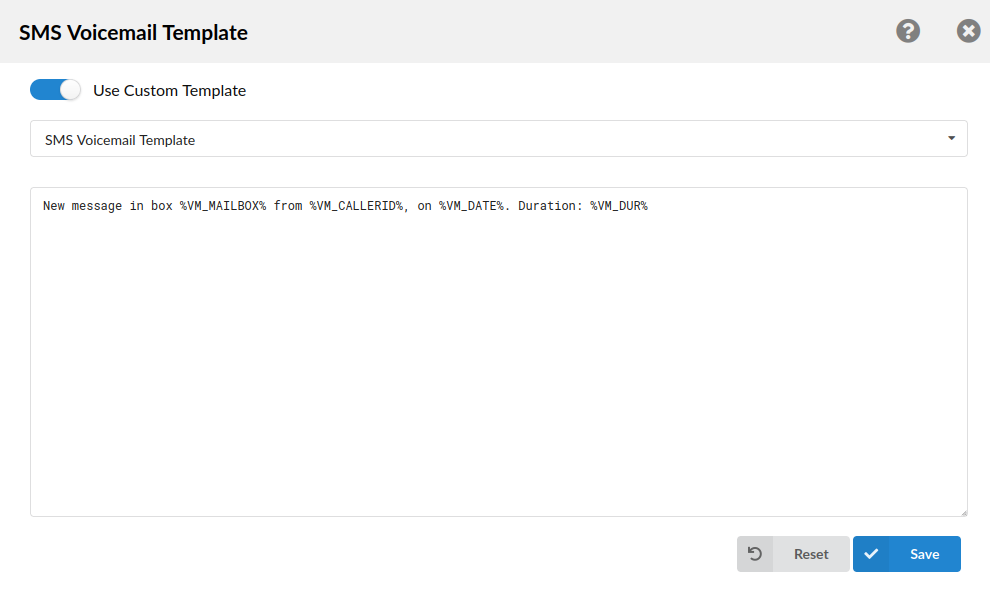
¶ Options (7.3)
In version 7.3, a new section named Options was added under the Settings → SMS Settings menu.
This section allows PBXware administrators to enable or disable the Opt-In and Opt-Out SMS features. When configured, these features give recipients of SMS messages sent from PBXware the ability to opt out of receiving further messages or to opt back in if they had previously opted out. Both Opt-In and Opt-Out options are disabled by default.
NOTE: Please be aware that you cannot use the same keywords for both Opt-In and Opt-Out options. If the same keyword is entered in both fields, the system will display a warning message and prevent saving the configuration.
Once the Use Opt-In/Out or Use Help option is enabled, their corresponding configuration fields (Opt-In keywords, Help keywords, and response messages) become available for further customization.
Starting from version 7.5, a new Help option was introduced in the same section. When enabled, this feature allows administrators to define custom keywords (referred to as Help keywords) that recipients can use to receive an automated help response, such as support contact details, working hours, or links to external resources.
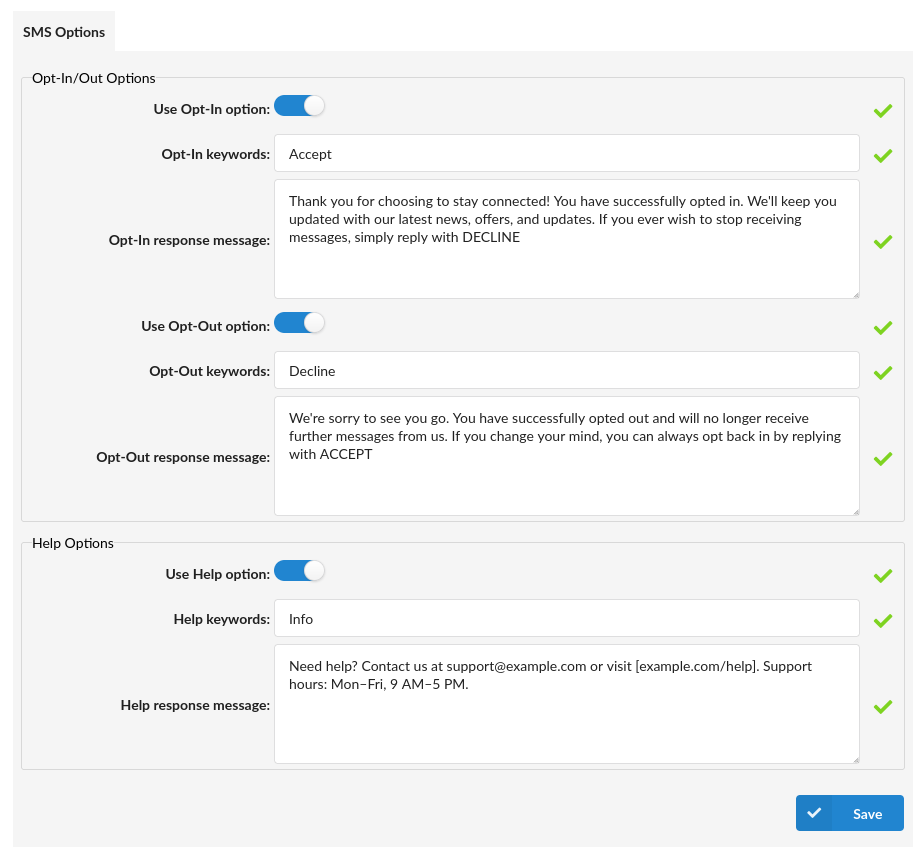
Use Opt-In Option
The Opt-In Option toggle button enables or disables the use of the Opt-In feature.
Opt-In keywords
This field allows you to configure one or more keywords, that the SMS message receivers can reply with if they wish to subscribe to the message list. The keyword can consist of a single word, multiple words separated with commas, some phrases, or a combination of these. For example, you can set up a keyword, such as "ACCEPT", to be used to opt into an SMS message list.
NOTE: Opt-In keywords are not case-sensitive, so if you set up a keyword "ACCEPT" Opt-In will be triggered regardless of whether the end-user replies with ACCEPT, Accept or accept.
Opt-In response message
This field allows you to create an Opt-In response message to be sent to new subscribers. This type of message can contain a welcome message and information on how users can unsubscribe from the messaging list.
Both Opt-In keywords and Opt-In response message fields are mandatory and must be populated. Otherwise, an error message will be displayed once you try to save changes.
Use Opt-Out Option
The Opt-Out Option toggle button enables or disables the use of the Opt-Out feature.
Opt-Out keywords
This field allows you to configure one or more keywords that the SMS message receivers can reply with if they wish to unsubscribe from receiving SMS messages. The keyword can consist of a single word, multiple words separated with commas, some phrases, or a combination of these. For example, you can set up a keyword such as "DECLINE" to be used to opt out of receiving SMS messages.
NOTE: Opt-Out keywords are not case-sensitive, so if you set up a keyword "DECLINE", Opt-out will be triggered regardless of whether the end-user replies with DECLINE, Decline or decline.
Opt-Out response message
This field allows you to create an Opt-Out response message to be sent to subscribers who would like to stop receiving SMS messages. This type of message can confirm a successful unsubscription and provide information on how users can re-subscribe to the messaging list in case they change their minds.
Both Opt-Out keywords and Opt-Out response message fields are mandatory and must be populated. Otherwise, an error message will be displayed once you try to save changes.
NOTE: We strongly suggest that you avoid using standard Opt-In and Opt-Out keywords like:
Opt-in: START, YES, UNSTOP
Opt-out: STOP, STOPALL, UNSUBSCRIBE, CANCEL, END, QUIT
The problem with using standard keywords is that you are risking matching the keywords your SMS Service Provider already uses in their management system. As a result, the number replying to your SMS messages could be blocked by your SMS Service Provider, not by PBXware, without your knowledge. For the best results, please consult your service provider or their representatives to confirm which keywords their management system uses, so you can avoid them.
Opt-Out scope (7.6)
In version 7.6, a new functionality named Opt-Out scope was added for the Opt-Out feature. The Opt-Out scope setting defines how the system handles Opt-Out requests from recipients who reply to SMS messages with a predefined Opt-Out keyword. When the recipient replies with an Opt-Out keyword, this setting determines whether the Opt-Out applies to a specific SMS number or to all SMS numbers on the system. It can be set to one of the following values: Global or SMS Number.
- Global
When set to Global, replying with an Opt-Out keyword will block the recipient's number from receiving SMS messages from all SMS numbers on the system. This means the recipient's number will be added to the Blocklist with the "From Number" set to "ALL".
- SMS Number
When set to SMS Number, the Opt-Out action will block the recipient's number from receiving SMS messages from only the specific SMS number that the recipient replied to. The recipient's number will be added to the Blocklist with the "From Number" set to that particular SMS number. That recipient's number can still receive messages from other SMS numbers on the system.
Use Help Option
The Help Option toggle button enables or disables the use of the Help feature.
Help keywords
This field allows you to configure one or more keywords that recipients of Bulk SMS messages can reply with to request additional information or support. The keyword can be a single word, multiple words separated by commas, phrases, or a combination of these. For example, you can set a keyword like HELP or SUPPORT to trigger an automatic help response.
NOTE: Help keywords are not case-sensitive. For example, if you configure the keyword HELP, the system will respond whether the user replies with HELP, Help, or help.
Help response message
This field allows you to define a custom message that will be automatically sent to users who reply with a valid Help keyword. This message typically includes contact information, support hours, links to resources, or any other helpful details.
Both Help keywords and Help response message fields are mandatory when the Help option is enabled. If either field is left empty, the system will display an error message when attempting to save changes.
NOTE: If you use the keyword HELP, please be aware that this is a generic keyword recognized by many SMS providers. Some providers may automatically send their own Help response message when this keyword is used. If you also configure a Help response message within PBXware, both messages may be delivered to the recipient. To avoid confusion or duplicate responses, consider using a custom keyword instead of HELP, unless you are certain that your provider does not send automatic replies.
Use Footer Option
The Use Footer option toggle button enables or disables the Apps SMS Footer feature.
Footer text
This field allows the SMS footer message to be entered, which will be used as the footer text for the SMS/MMS messages. It can take up to 160 characters.
¶ gloCOM
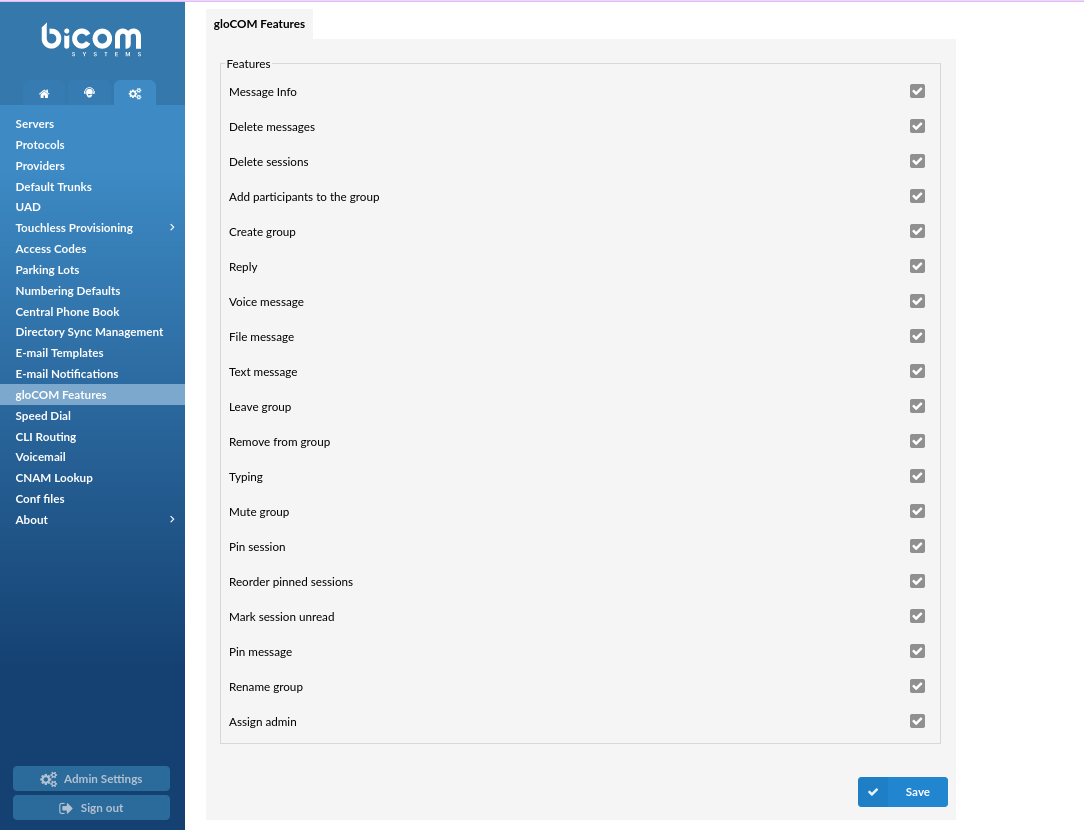
¶ Chat Features
This page allows administrators to select which gloCOM features will be available to users in gloCOM chat.
List of the gloCOM features that can be enabled or disabled:
- Update group icon
- Message reactions
- Create shared group
- Mention message
- Message Info
- Delete messages
- Delete sessions
- Assign admin
- Rename group
- Pin message
- File message
- Text message
- Voice message
- Reply
- Create group
- Add participants to the group
- Leave group
- Remove from group
- Typing
- Mute group
- Pin session
- Reorder pinned sessions
- Mark session unread
- Transform Group
- Create Thread (7.2)
NOTE: Create Thread must be enabled in the PBXware license.
¶ Settings
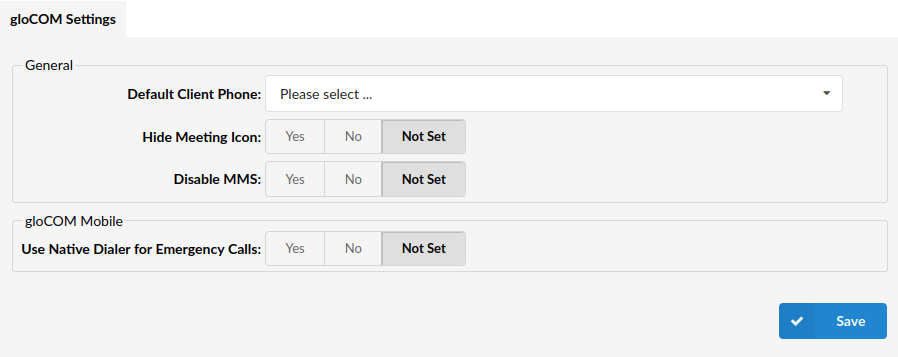
- Default Client Phone (7.3)
This feature allows the PBXware administrator to enforce which gloCOM phone type will be used when gloCOM desktop apps register to the system.
For example, if Deskphone is selected, the gloCOM desktop app will always register in Deskphone mode, and the user will need a deskphone registered to the extension to be able to make calls.
Users can still change the phone type once the gloCOM desktop app is registered to the PBXware.
Please note that the extension level setting will have priority over the system-level setting for this option.
Available options: Please select, Softphone, Deskphone.
- Hide Meeting Icon (7.3)
This option allows you to hide the Meeting icon from being visible in the gloCOM desktop application. This can be useful for organisations that prefer using 3rd party applications for conference and/or video calls. To prevent the Meeting icon from being accessible in the gloCOM app, set this option to Yes.
By default, this option will be configured as Not Set, which should have a Meeting icon visible in gloCOM. Available options are Yes, No, and Not Set.
- Disable MMS (7.3)
If the 'Disable MMS' is enabled, gloCOM users will not be able to send MMS messages and the MMS icon will be removed from the gloCOM.
This option has three available settings 'Yes, No, and Not Set'.
'Disable MMS' uses the standard inheritance logic where 'Disable MMS' on the Extension has the highest priority, followed by the 'Disable MMS' on Tenant, and then the System (Master Tenant) level.
¶ Speed Dial
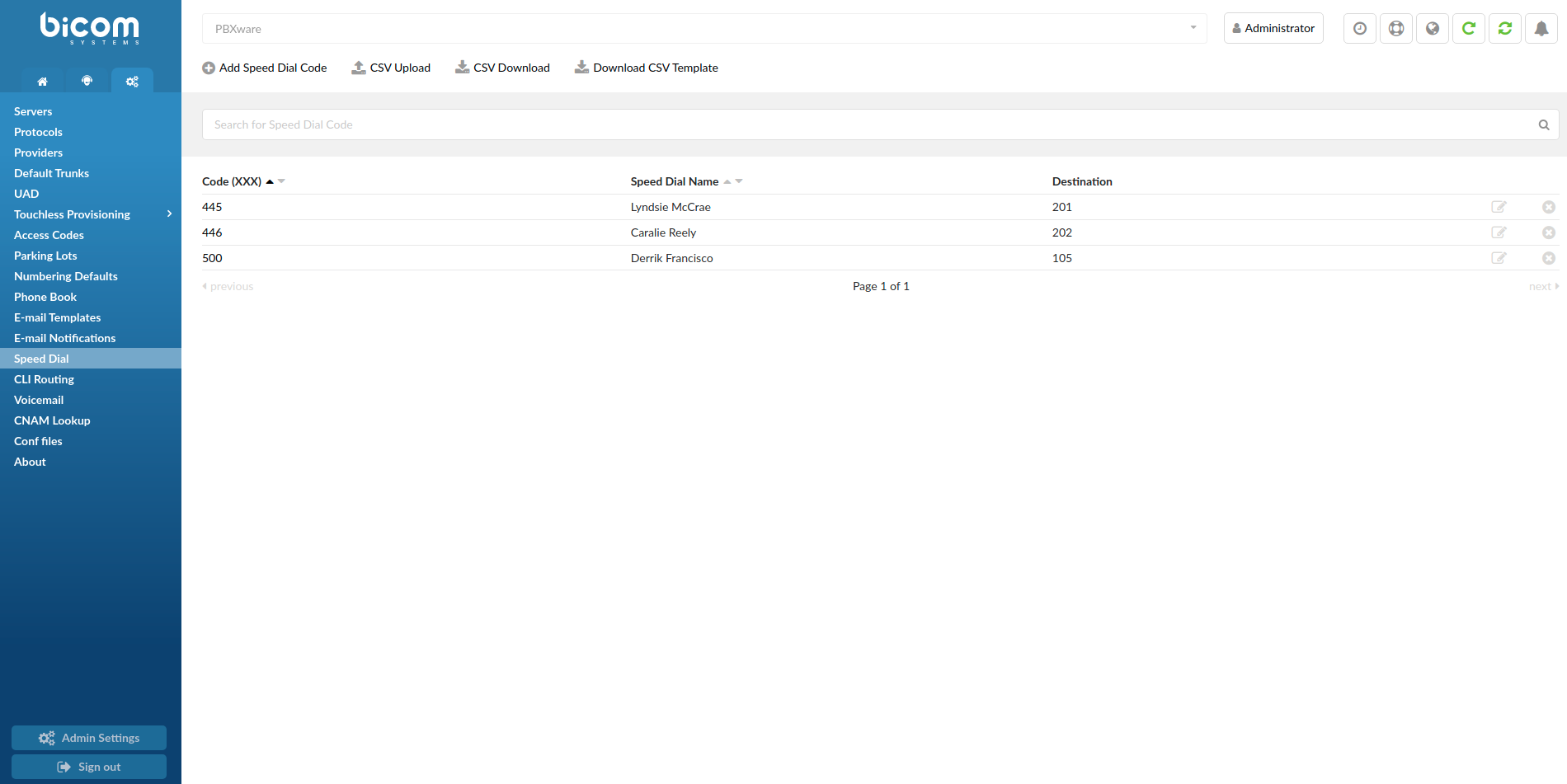
Speed Dial is used with the *130 Access Code. When you dial *130XX, where XX is a Speed Dial Code, you will dial the extension associated with that code.
- CSV Upload
Click on this button to upload Speed Dial Code configuration from a csv file.
To see which fields need to be set download the CSV template by clicking on the "Download CSV Template" button.
(Button)
- CSV Download
Click on this button to download Speed Dial Code configuration as a csv file.
(Button)
- Download CSV Template
Download CSV Template button will present you with a file that already contains necessary headers which should help you create the CSV file easier.
(Button)
- Search
Search is performed by Code and Speed Dial Name
This screen contains information about all Speed Dial Codes on system with following infromation:
- Code (XXX)
Up to three digit code which is entered after the Speed Dial Access Code, *130 as default
(E.g. 22)
(Display)
- Speed Dial Name
Short description of the Destination to which this Code points.
(E.g. Sales-John)
(Display)
- Destination
Destination to which this Code is pointing.
(E.g. 1005)
(Display)
 Click to edit Speed Dial Code configuration
Click to edit Speed Dial Code configuration
(Bitton)
 Click to delete Speed Dial Code from the system
Click to delete Speed Dial Code from the system
(Button)
¶ Add/Edit Special Dial Code

- Code(XXX)
Code which is entered after the Speed Dial Access Code
(E.g. 2)
([0-9])
- Name
Short description of the Destination to which this Code points.
(E.g. Sales-John)
([a-z][0-9])
- Destination
Destination to which this Code is pointing.
(E.g. 1005)
([0-9])
¶ CLI Routing

This option allows adding rules which send the calls to different destinations based on Caller IDs. For example, if the caller's ID begins with 203, you can send all those calls to the IVR, if the CallerID is specifically number 063456789 then send that call to extension 4444 etc...
- CSV Upload
Click on this button to upload CLI Routing configuration from csv file
(Button)
- CSV Download
Click on this button to download CLI Routing configuration to csv file
(Button)
- Download CSV Template
Download CSV Template button will present you with a file that already contains necessary headers which should help you create CSV file easier
(Button)
- Search
Search is performed by Caller ID
This screen shows all CLI Routing Rules configured on system with following options:
- Caller ID
The Caller ID which is matched in the rule.
(E.g. 063456789)
(Display)
- Destination
The type of destination to which the call will be directed.
(E.g. IVR)
(Display)
- Extension
Extension of the destination or selection where the call should go.
(E.g. 2222)
(Display)
- Match Type
How the Caller ID is matched.
(E.g. If we set Match explicitly to ‘yes’ here will be written ‘Explicit Match’. If we set this option to ‘No’ or ‘Not Set’ here will be written ‘Begins With’.)
(Display)
- Edit
 Edits the CLI Routing configuration
Edits the CLI Routing configuration
(Button)
- Delete
 Deletes CLI Routing Rule from the system
Deletes CLI Routing Rule from the system
(Button)
¶ Add/Edit CLI Routing Rule
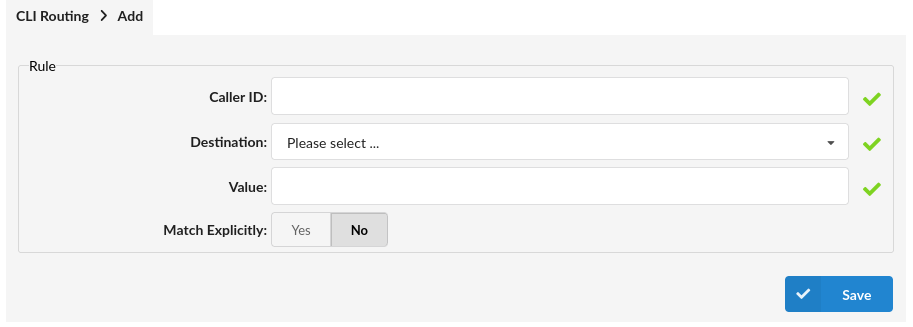
- Caller ID
The Caller ID which is matched in the rule.
(E.g. 063456789)
([a-z][0-9])
- Destination
The type of destination to which the call will be directed.
(E.g. Queue)
(Select box)
- Extension
Value of the destination or selection where the call should go.
(Select box)
- Match Explicitly
Should the system match Caller ID explicitly or treat all calls that begin with it.
(E.g. Yes, No, Not Set)
(Option buttons)
¶ Voicemail
Calls are diverted to Voicemail when user is unavailable, has the phone powered off or when a call is transferred to a voicemail by user. The phone alerts user to indicate the receipt of a message.
Once the user is transferred to party's voice box 'Please leave a detail message after the tone. If you would like to speak to the operator, press 0' message will be heard.
User has two options:
-
To leave a voice message that is ended by pressing # key or by hanging up
-
To reach an operator by dialing 0
If 0 is dialed 'Press 1 to accept this recording, otherwise please continue to hold' message will be heard.
User has two options:
-
Press 1 to save your message and dial the operator. 'Please hold while i try that extension' message played.
-
Continue to hold to delete your message and dial the operator. 'Message deleted, please hold while i try that extension' message played.
¶ General Voicemail
General fields are most required by voicemail.
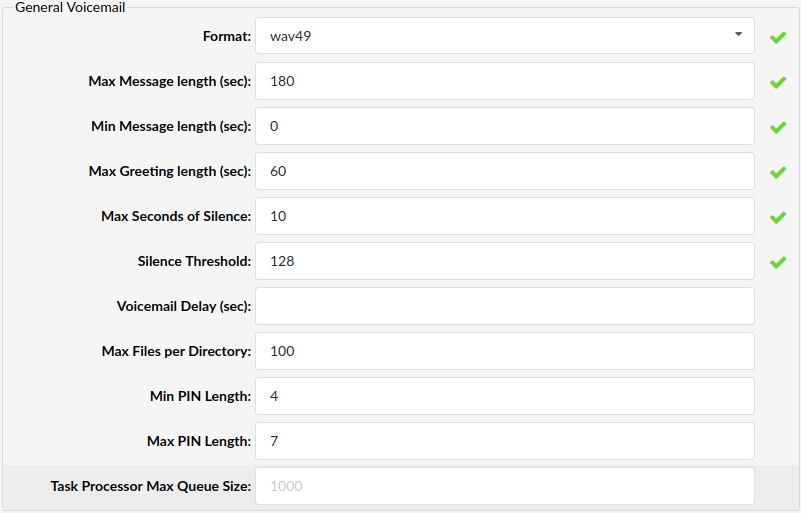
- Format
Audio format in which voice messages are recorded
(E.g. If 'wav49' is selected here, all voice messages will be saved in this format. See below for disk usage)
(Select box)
- Max Message Length (sec)
Maximum length of a voice message in seconds
(E.g. By default this field is set to '180' seconds (3 minutes)
([0-9])
- Min Message Length (sec)
Minimum length of a voice message in seconds
(E.g. Default value set to '3' seconds. Messages that last less are discarded)
([0-9])
- Max Greeting Length (sec)
Maximum length in seconds of the user recorded voicemail greeting message
(E.g. Default values set to '60' seconds)
([0-9])
- Max Seconds of Silence
Maximum length in seconds of silence in a voice message
(E.g. Default value set to '10' seconds. Silence longer than set here will end a voice message)
([0-9])
- Silence Threshold
Silence detection threshold
(E.g. Default value set to '128'. The higher the number, more background noise is added)
([0-9])
- Voicemail Delay (sec)
Delay a number of seconds before asking user for 'Password'
(E.g. If you hear a partial sound file played asking the user for the password, set '1' or '2' here to add a second or two of silence before the sound file is played).
([0-9])
- Max Files per Directory
Maximum number of voicemail messages per voicemail directory
(E.g. Each voice box has following directories (INBOX, Old, Work, Family, Friends, Cust1, Cust2, Cust3, Cust4, Cust5). Set this field to '100' to allow a 100 voice messages per each voice directory)
([0-9])
- Min PIN Length
Defines the minimum length of PIN used for Voicemail
(E.g. 4)
([0-9])
- Max PIN Length
Defines the maximum length of PIN used for Voicemail
(E.g. 4)
([0-9])
- Task Processor Max Queue Size
Defines the maximum size of queue for Voicemail Task Processor
(E.g. 1000)
([0-9])
Disk Space Used By Voicemail Recording
With continuous tone for 60 seconds:
- wav49 = 91.0kb
- wav = 863.0kb
- gsm = 91.0kb
With continuous silent tone (without sound) for 60 seconds:
- wav49 = 0.38kb
- wav = 3.0kb
- gsm = 0.32kb
¶ E-mail Settings

Customize the display of emails that notify users of new voicemail messages.
- Server E-mail
This email address is used to identify from whom the email was sent
(E.g. test@test.com)
([a-z][0-9])
NOTE: If this field is set to 'pbxe@domain.com', the following line is added in the email header '"$FROM": string pbxe@domain.com'.
- Send Attachment
Send the voice message as an attachment to the user's email
(E.g. Once B gets a new voice message if this option is set to 'Yes', the message sound file will be attached to the new voicemail notification email.)
(Option buttons)
- Skip[PBX]: in subject
Define whether 'PBX' should be skipped in the voicemail title
(E.g. If set to 'No', "Subject: [PBX']: New message M in mailbox B" will be displayed in the email subject line.)
(Option buttons)
- Convert to MP3
Select whether to convert voicemails to the mp3 format when sending them via emails
(Option buttons)
NOTE: The default format is WAV.
- Charset
Charset that is in use on PBXware.
To display an HTML page correctly, a web browser must know which character set to use.
([a-z][0-9])
NOTE: Please note that the default value is 'ISO-8859-1'.
¶ Run Application
Run custom applications on certain voicemail actions

- On Voicemail
Run a custom application when a new voicemail is received
(E.g. Set this field to '/usr/bin/myapp' to execute 'myapp' application when a new voicemail arrives)
([a-z][0-9])
- On Password Change
Run a custom application when your voicemail password is changed
(E.g. Set this field to '/usr/bin/myapp' to execute 'myapp' application when your voicemail password changes)
([a-z][0-9])
¶ ADSI

- ADSI Feature Number
The ADSI feature descriptor number to download to
(E.g. 0000000F)
([A-F][0-9])
- ADSI Security code
The ADSI security lock code
(E.g. 9BDBF7AC)
([A-F][0-9])
- ADSI Application version
The ADSI voicemail application version number
(E.g. 1)
([0-9])
¶ Main Voicemail Menu

- Play Envelope message
Announces the Date/Time and the Extension number from which the message was recorded.
(E.g. Once voice box is checked for new messages, if this option is set to 'Yes', 'Received at {DATE}. The from phone number {NUMBER}' will be played, giving more details about the message originator).
(Option buttons)
- Say Caller ID
Announce the extension number from which the voice message was recorded.
(E.g. If this option is set to 'Yes', when checking voicemail, 'From phone number {$NUMBER}' message will be heard).
(Option buttons)
- Skip ms on playback
Interval in milliseconds to use when skipping forward or reverse while a voicemail message is being played
(E.g. If this field is set to '3000', when listening to a voice message it will skip 3 seconds on rewind/fast forward)
([0-9])
- Max login attempts
Maximum number of login retries before user gets disconnected
(E.g. By default, this field is set to '3'. After 3 unsuccessful login attempts, the user gets disconnected)
([0-9])
NOTE: PBXware 6 has introduced a new lockout feature for Voicemails. It is directly related to the 'Max login attempts' option meaning that if a user fails to enter their voicemail PIN correctly after e.g., 3 tries, that voicemail will be blocked until an administrator unblocks it.
- On Delete, play next message
After a voice message has been deleted, should the system automatically play the next message from the voice inbox
(E.g. Select 'Yes' to automatically playback the next voice message after you've deleted the old one)
(Option buttons)
¶ Advanced Features
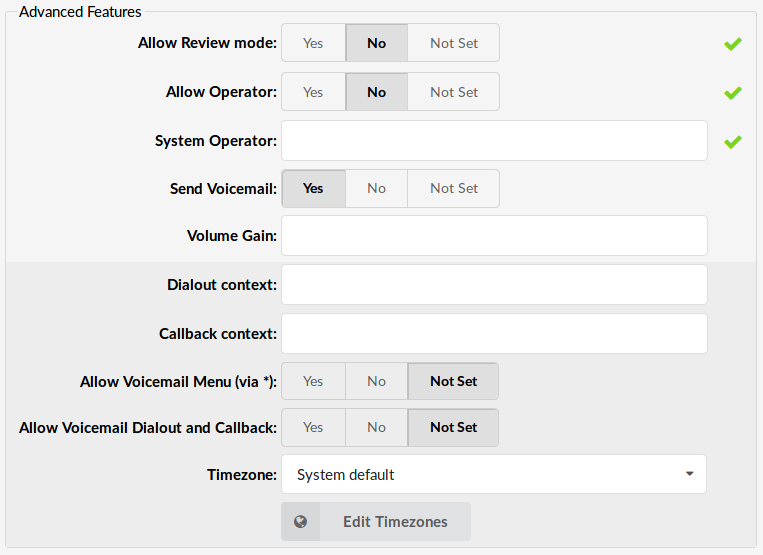
- Allow Review mode
Allow B to review the voice message before committing it permanently to A's voice box.
Example:
B leaves a message on A's voice box, but instead of hanging up, he presses '#'. Three options are offered to B:
- Press 1 to accept this recording
- Press 2 to listen to it
- Press 3 to re-record your message
(Option buttons)
- Allow Operator
Allow B to reach an operator from within the voice box.
Example:
B leaves a message on A's voice box, but instead of hanging up, B presses '#'.
'Press 0 to reach an operator' message is played (Once '0' is pressed, the user is offered the following options):
- Press 1 to accept this recording (If selected, 'Your message has been saved. Please hold while I try that extension' is played and operator is dialed)
- Or continue to hold (If B holds for a moment, 'Message deleted. Please hold while I try that extension' is played and operator is dialed)
(Option buttons)
- System Operator
Local extension number that acts as an operator.
(E.g. If A's voice box has an option 'Allow Operator' set to 'Yes', all users dialing '#0' inside the voice box will reach this operator extension).
([0-9])
- Send Voicemail
Change the context from which to send voicemail
(E.g. Select 'Yes' to enable and provide new values to 'Dialout context' and 'Callback context' fields)
(Option buttons)
- Volume Gain
Set the gain you want to apply to VoiceMail recordings.
(E.g. Enter 2 to amplify the recordings).
([0-9])
- Dialout context
Context to dial out from
(E.g. Set this field to 'fromvm', for example)
([a-z][0-9])
- Callback context
Context to call back
(E.g. Set this field to 'tomv'. If not listed, calling the sender back will not be permitted)
([a-z][0-9])
- Allow Voicemail Menu (via *)
Allow caller to access Voicemail Menu by dialing *.
(E.g. When reaching extensions voicemail to leave a message, pressing * will present you with login for extensions Voicemail box).
(Option buttons)
- Allow Voicemail Dialout and Callback
Allow caller to use Voicemail Dialout and Callback from voicemail menu by entering extensions PIN.
(Option buttons)
- Timezone
Timezone that system will use to inform users when voicemail message was received. Timezone selected here will also be used for setting up timezone for auto provisioned devices.
(Select box)

When you click on this button, new window with options to configure timezons will be opened
(Button)
¶ Edit Timezones

- Timezone:
Timezone name
(E.g. Bosnia and Herzegovina)
(Display)
 Click to edit timezone configuration
Click to edit timezone configuration
(Bitton)
 Click to delete a timezone from the system
Click to delete a timezone from the system
(Button)
¶ Add/Edit Timezones
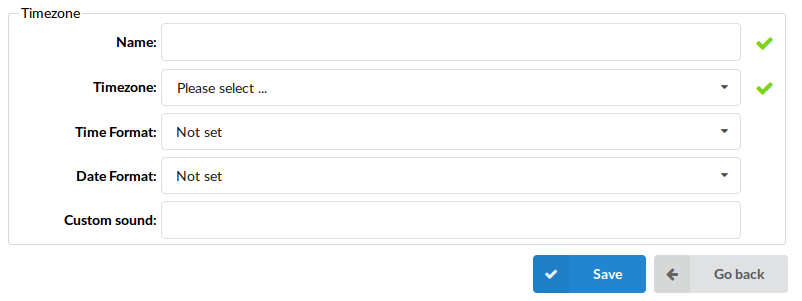
- Name:
Unique timezone name
(E.g. The name provided here will be visible when setting the correct voicemail timezone. Type 'Zenica' here for example)
([a-z][0-9])
- Timezone:
Set the correct timezone
(E.g. If you have set 'Name'='Zenica' (a town in Bosnia) select the closest timezone to Zenica here (e.g. 'Europe/Sarajevo'))
(Select box)
- Time format:
Set the appropriate time format:
Example:
Depending on your selected 'Timezone' you may choose between the following options:
- 12 Hour clock
- 12 Hour clock including minute
- 12 Hour clock AM/PM
- 12 Hour clock AM/PM, including minute
- 24 Hour clock
- 24 Hour clock including minute
- AM/PM 12 hour syntax
- Dutch syntax
- German syntax
- Greek syntax
- Italian syntax
- Norwegian syntax
- Swedish syntax
(Select box)
- Date format:
Set the correct date format
Example:
Depending on the selected 'Timezone', you may choose between the following options
- Month/Day/Year
- Day of Week/Month/Day/Year
- Day/Month/Year
- Day of Week/Day/Month/Year
(Select box)
- Custom sound:
This file is played before the voicemail arrival time
(E.g. Enter sound file name, without the extension (e.g. 'arlington') here)
([a-z][0-9])
¶ Transcription

- Enable Service
Whether transcription will be enabled
(Option buttons)
- Transcribe by Default
This option will determine if the transcription is enabled on all extensions by default
(Option buttons)
- Service
Choose which service will be used for Speech to Text for Voicemails
(Select box)
NOTE: In order for Speech-to-Text transcription to work Delete After E-mailing has to be disabled on the extension, otherwise no transcription will be generated.
¶ IBM Watson
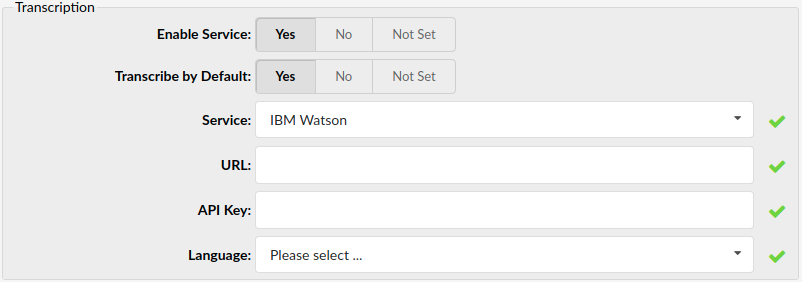
If you select IBM Watson under Service following additional options are available:
- URL
Enpoind with which system will comunicate
- API Key
API Key used for authentication
- Language
Which language the transciption service expects (in which language autio file should be)
(Select box)
¶ Google Speech
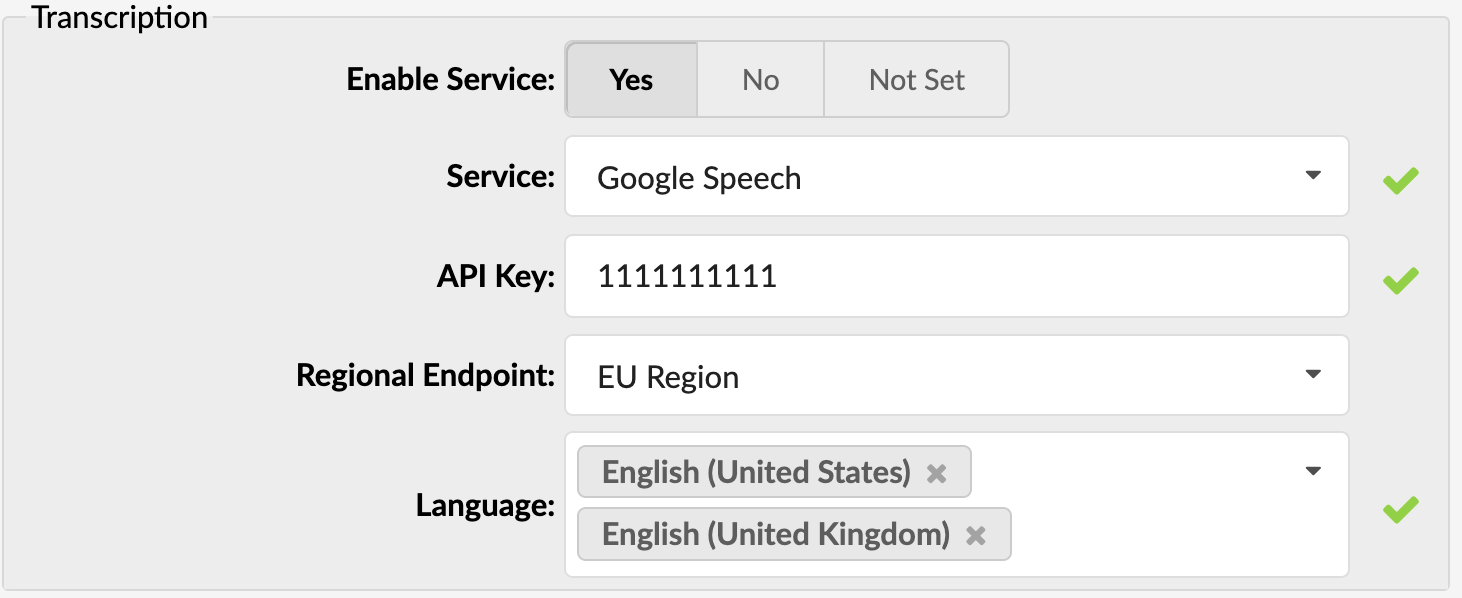
If you select Google Speech under Service following additional options are available:
- API Key
API Key used for authentication
- Regional Endpoint
Google's regional endpoints ensure compliance by keeping data within specified jurisdictions. If your data’s location must be controlled in order to comply with local regulatory requirements, make sure to select the endpoint that matches your region. In addition, Google's Speech-to-Text service provides regional endpoints to optimise performance and reduce latency for users in different geographical locations.
Available selections are EU region and US region.
- Language
Which language the transciption service expects (in which language autio file should be)
(Select box)
¶ OpenAI
If you select OpenAI under Service following additional options will become available:

- API Key
Enter your OpenAI API key to authorize the transcription service.
- Language
Choose the language spoken in the voicemail for accurate transcription.
- Prompt
Provide a style or tone guide for the transcription to influence formatting and vocabulary.
¶ Service credentials acquisition
¶ IBM Watson
In order to get the credentials for IBM Watson’s speech-to-text service an IBM Cloud account is required (free account works as well but limits the amount of requests that can be done). After logging into your IBM Cloud account select Watson from the menu that opens after clicking on the button in the top left corner:

In the page that opens under Watson Services select Browse Services (2). From the offered services select Speech to text (2) then press the Add Service button (3).
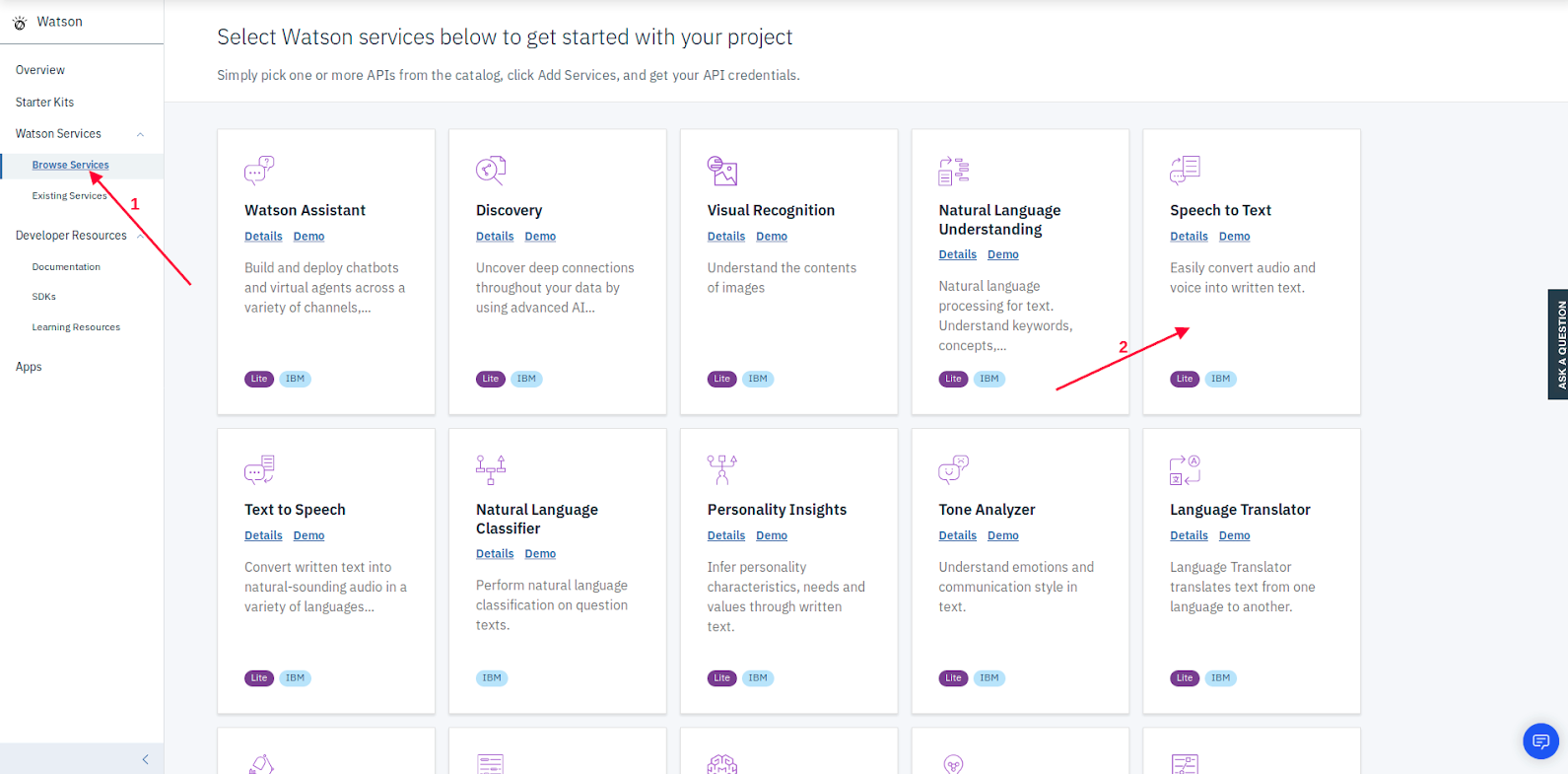
On the next page under theService Name enter the project name (1). Afterwards select the resource group (2), if multiple are available, as well as the deployment region (3).
You can also add an optional tag to your project (4).
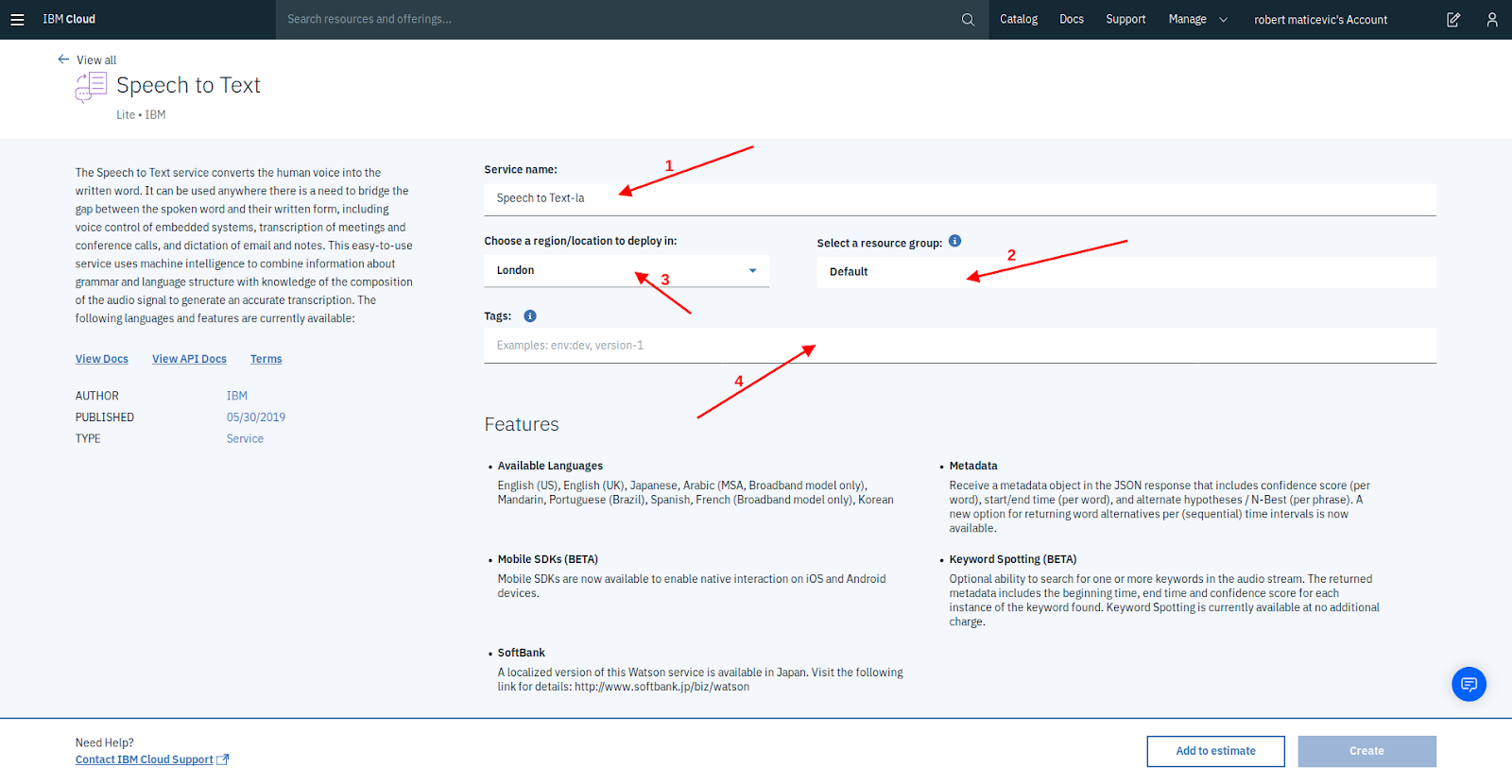
After these options are filled in scroll to the bottom of the page, there you will select your pricing plan (1) and press Create (2) to create your project.
Once the project is created go to the credentials page of the project (1).
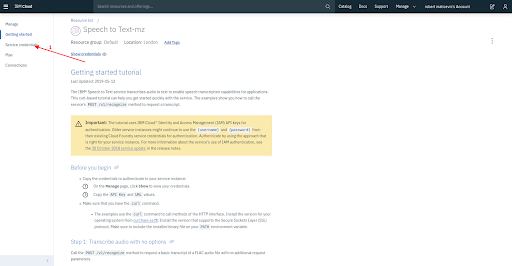
There will be a set of auto generated credentials to be used or new credentials can be made by pressing the New Credentials button (1).
To use either custom or auto-generated credentials press View credentials (2).
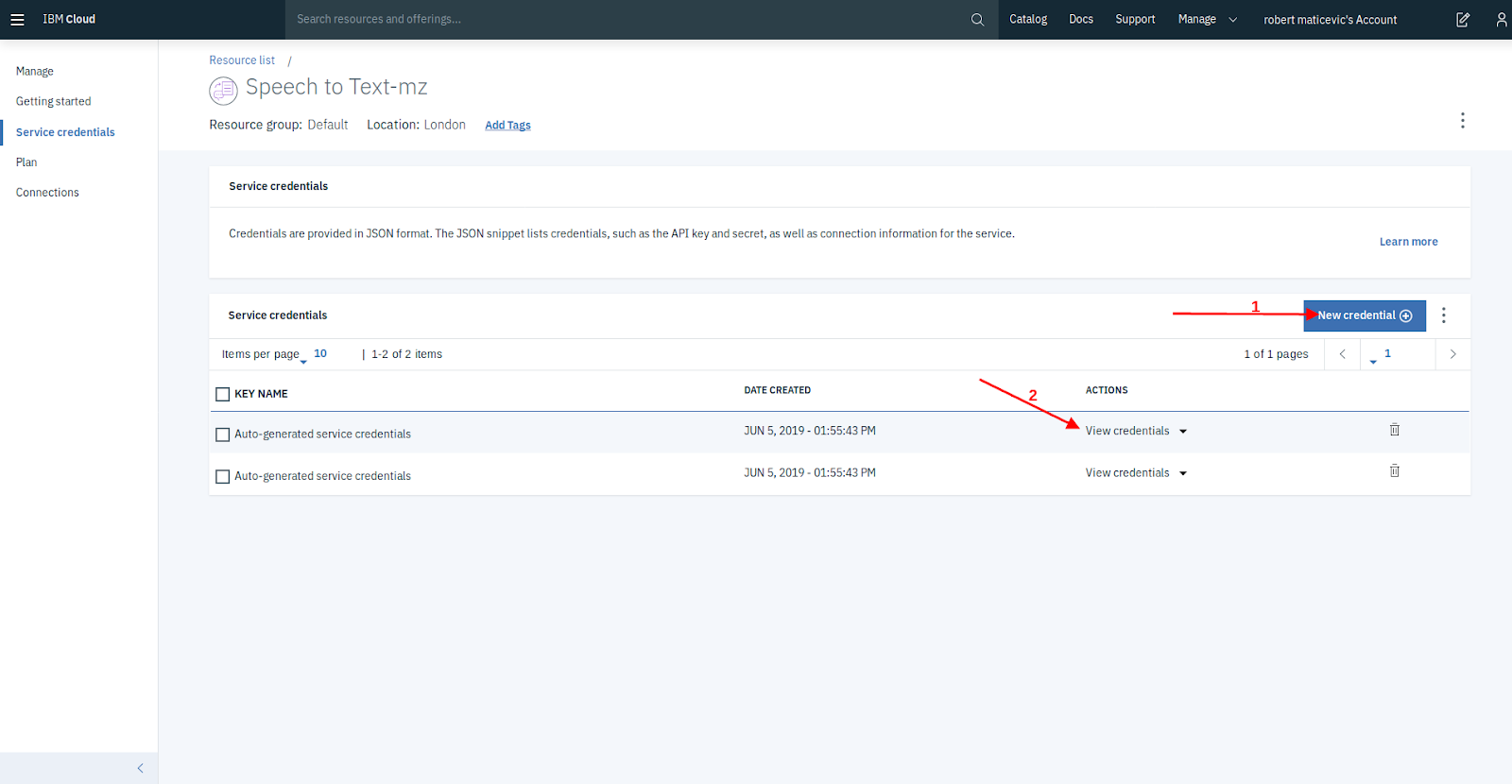
In case new credentials are created the following window will appear where you enter the credentials name (1) and role (2).
Optionally the service credential ID (2) and configuration parameters (4) can be added.
Once the mandatory fields are set press Add (5).
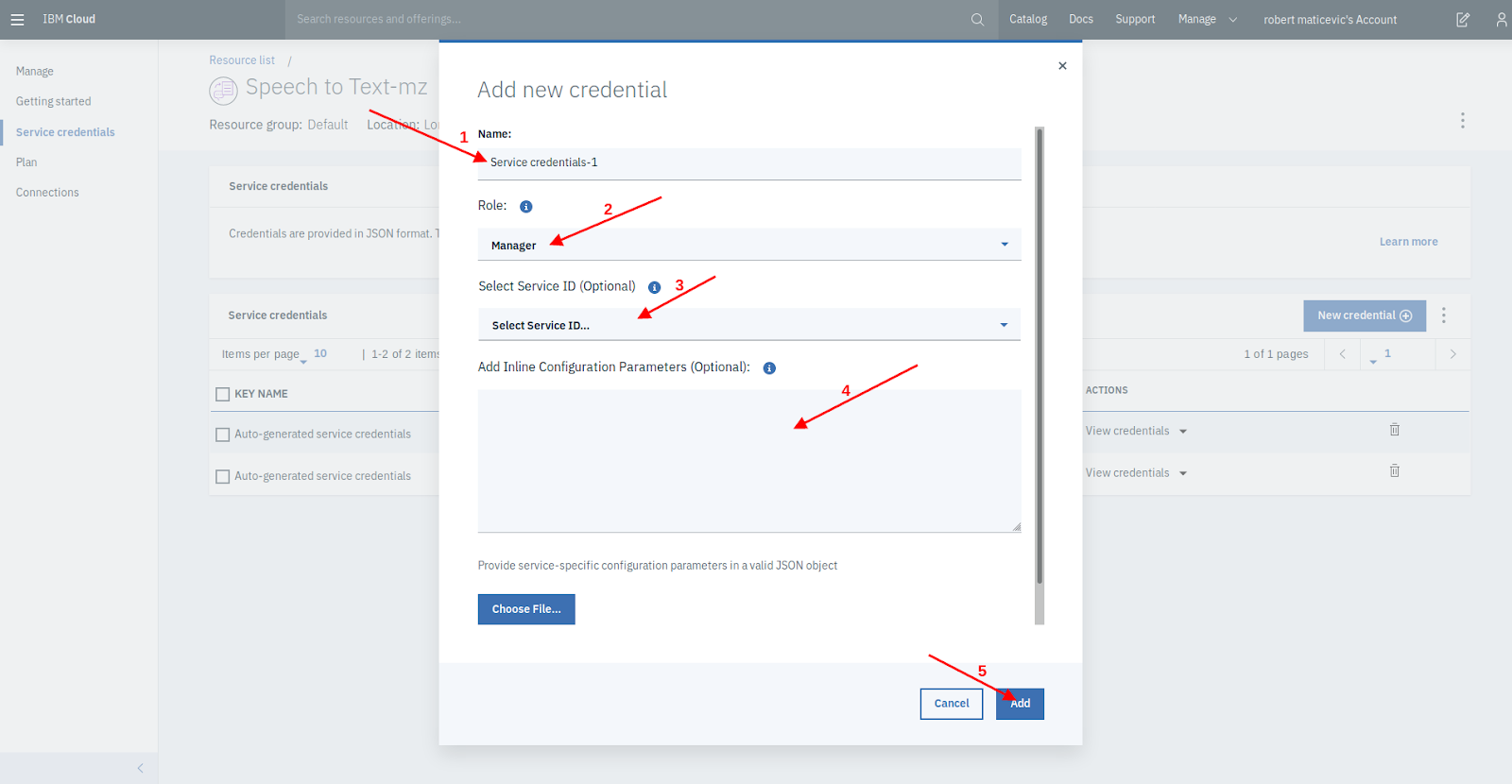
Once a service credential is open for view, only 2 fields are needed for voicemail transcription: apikey (1) and url (2).
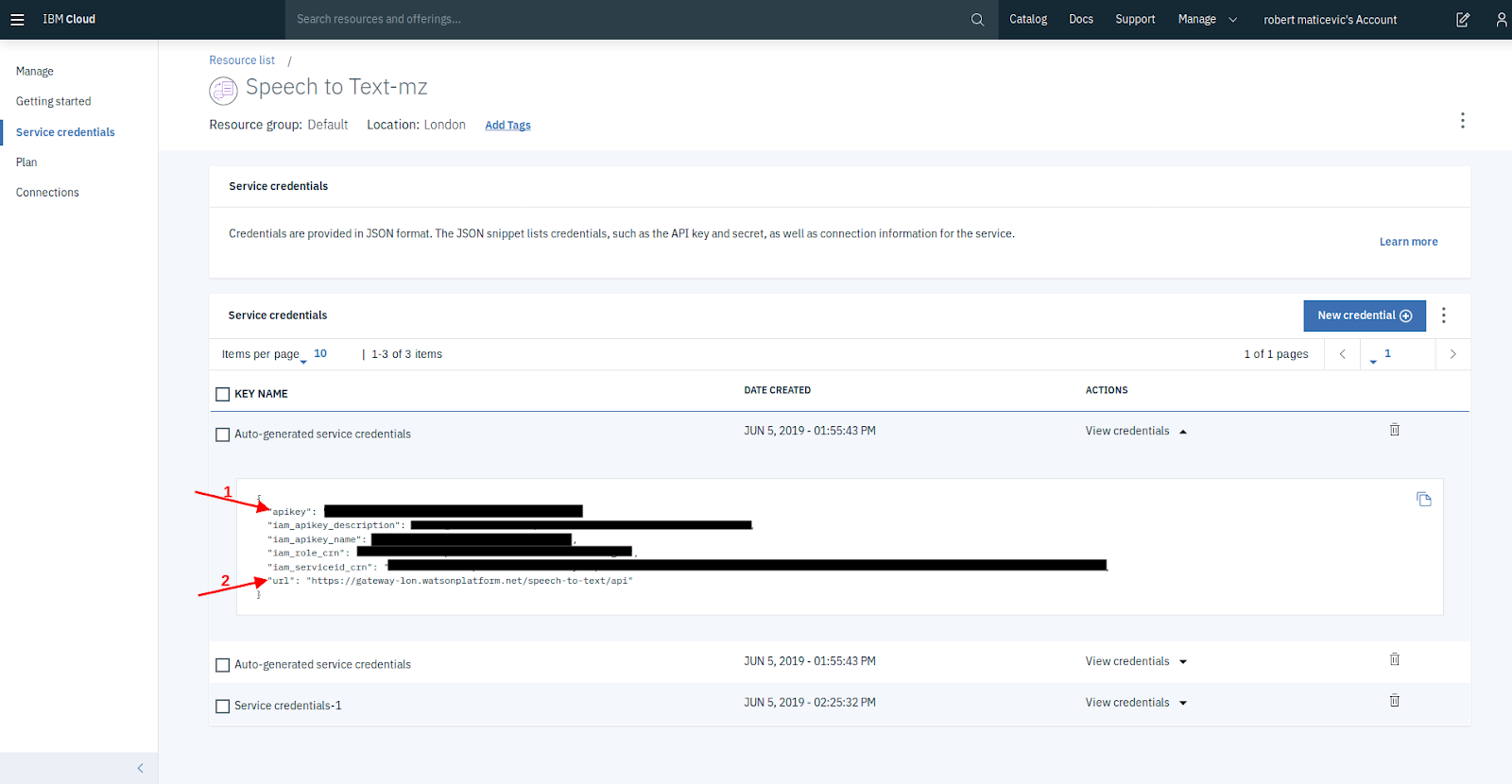
¶ Google Speech
Log into google cloud console with an existing account. From the menu on the left select APIs and Services:
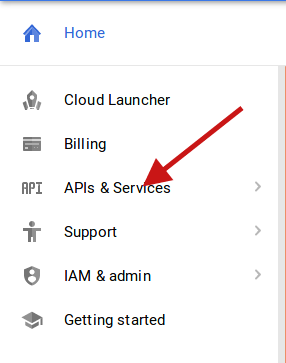
Either click Library or ENABLE APIS AND SERVICES:

From here either manually find the Google Cloud Speech API or using the search field and select it. On the Google Cloud Speech API page click the enable button:
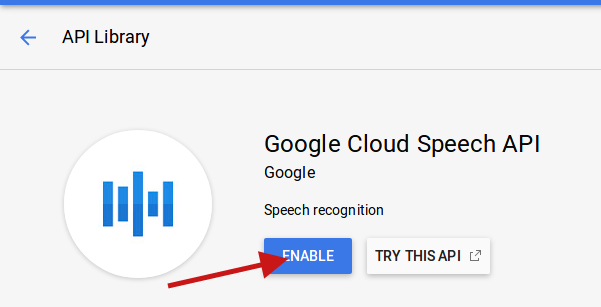
After enabling the api press the MANAGE button that replaced the enable button. On the manage page go to the Credentials section (1) and press Create credentials (2) and select API key (3):
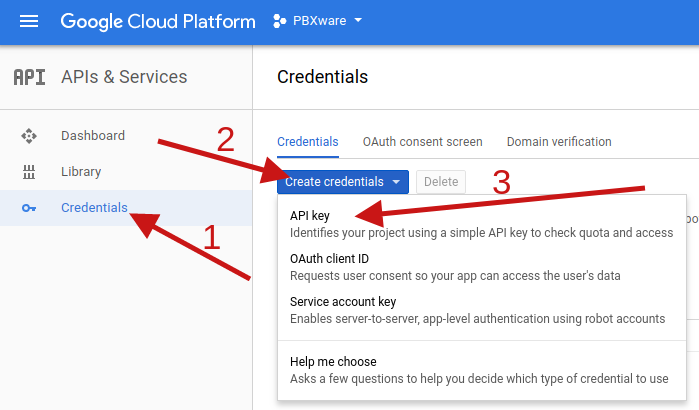
A popup window will appear containing the generated key press the copy icon (1) to copy the API key needed for this feature. Some restrictions can be placed on individual keys (IP address, ios/android apps..) can be placed on the key by pressing the REStRICT KEY button (2).
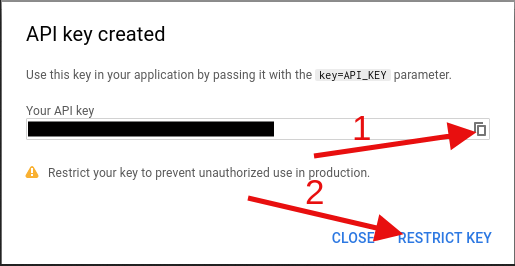
Already created keys can be accessed from the same page in the API keyssection (the site might need to be refresh in order for keys to display). IP restriction is recommended and can be set and can be set by selecting IP addresses (1) in the in the Key restriction section of the API key options. Addresses are added separately by typing them in the IP address input field (2) and pressing enter confirm each one. Already added addresses will display above the input field (3) where they can be edited or removed by deleting the rows content or pressing the appropriate x button (4).
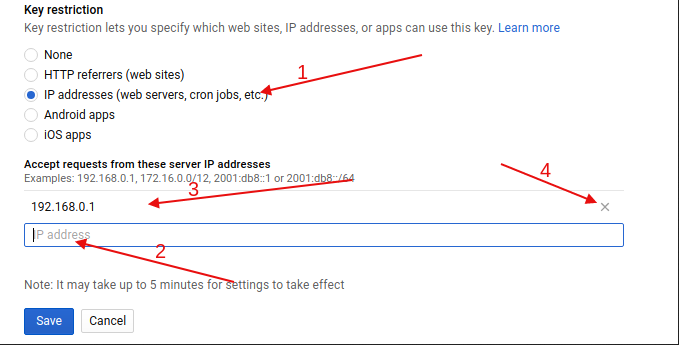
Usedge
Transcript can be added in Voicemail E-mail Template as shown below.
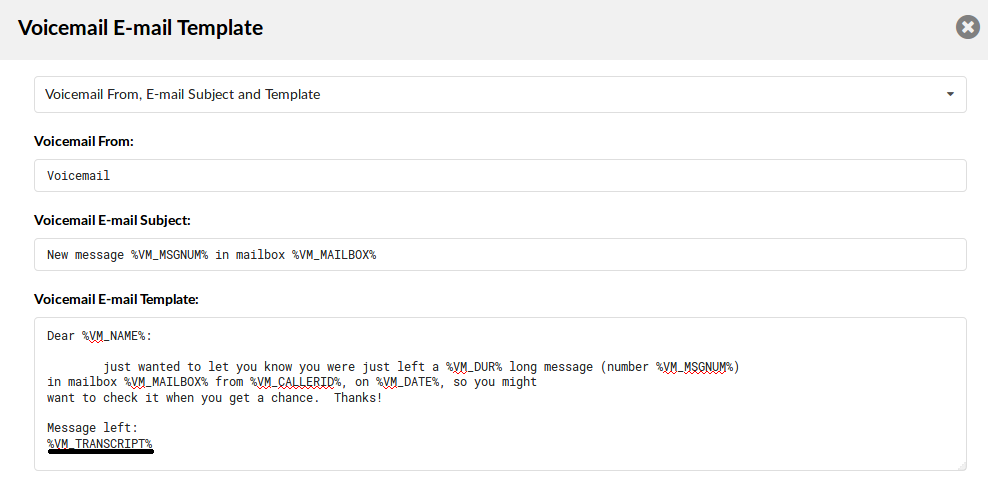
In order to make this feature easier to be used the default HTML template got updated, adding an additional row with the transcript. That row will be omitted if no transcript is available. An additional option has been added to all e-mail templates that enables the template to be reset to the default one. This reset will affect all the templates for the resource it is used on (eg: if voicemail e-mail templates get reset it will affect the plain text template, html template, and pager template). A warning message will pop up where confirmation for the reset is required in order to evade accidental resets.
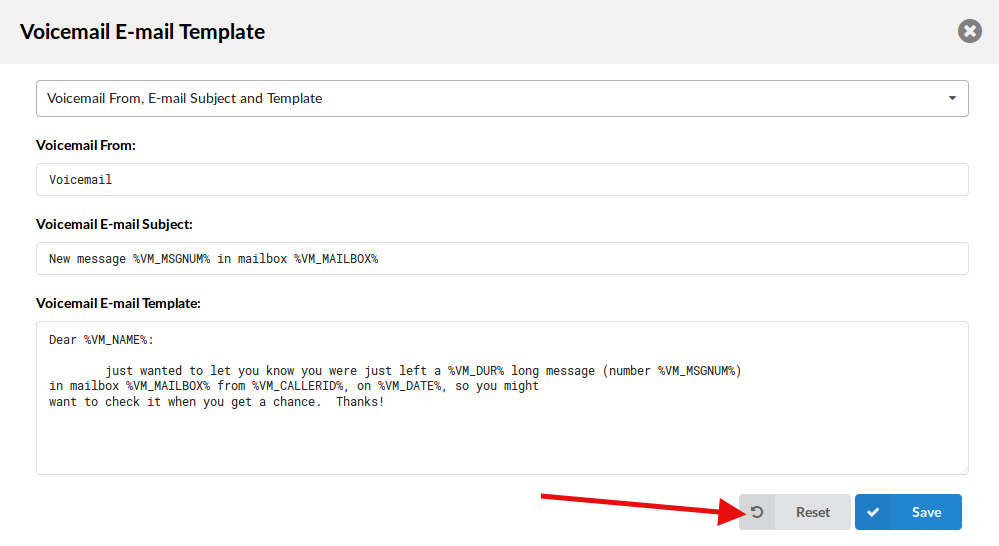
To see the transcript in OSC click the speech bubble left of the message number:
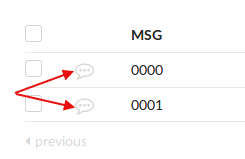
In case no transcript is available (like voicemails created without this option) that field will be empty. The transcript will appear in a popup above the speech bubble and disappear after the first click outside the popup.
¶ OpenAI
An OpenAI account is required to get the credentials for OpenAI’s speech-to-text service. After logging into your OpenAI account, select Settings from the menu by clicking the button in the top right corner. (1)

From the menu select API Keys (2).
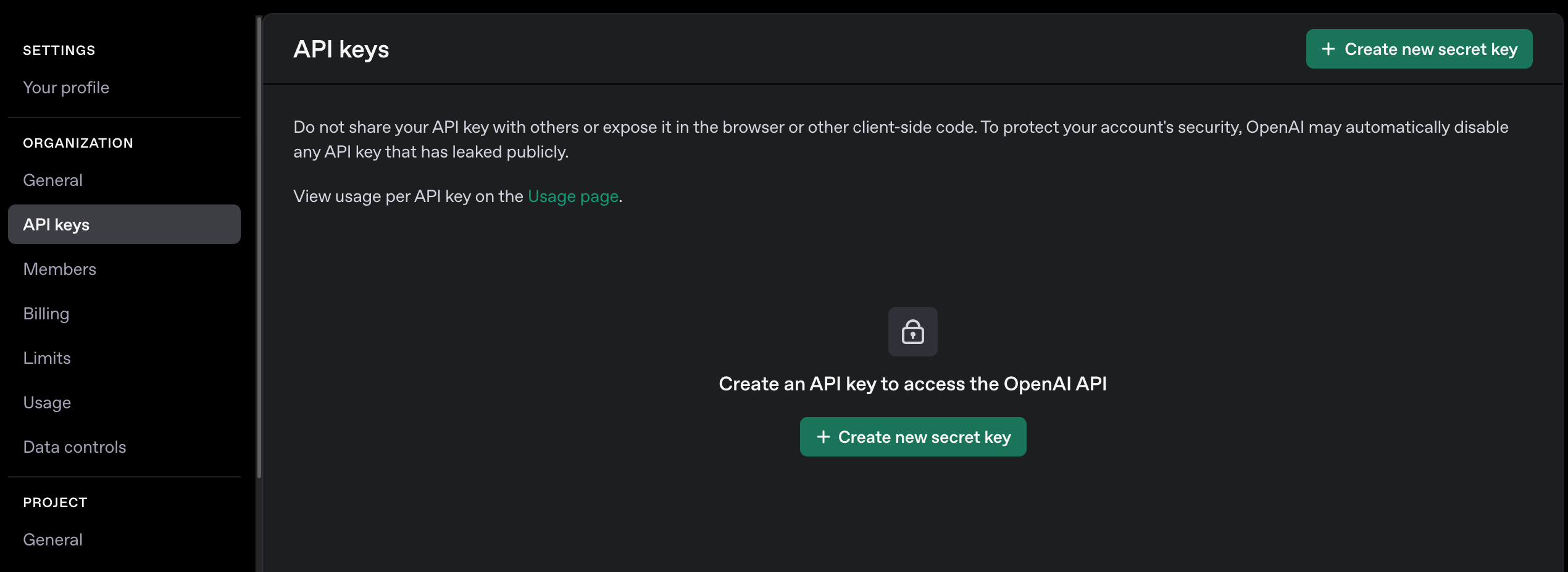
From the API Keys, select Create new secret key, enter the name (Optional), select the project, add the permissions, and click the Create new secret key button (3).
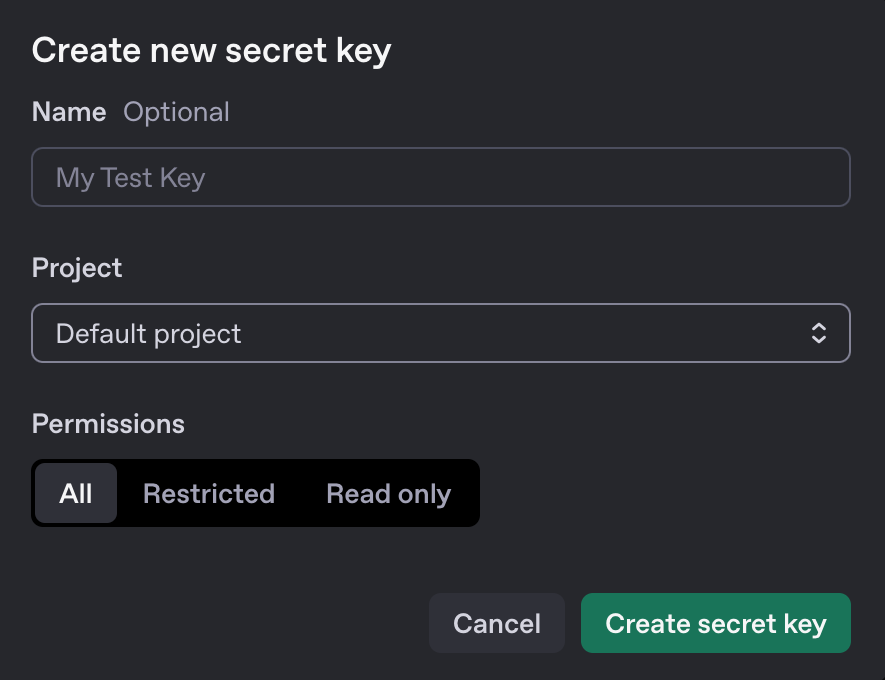
Once the API secret is created, Copy the secret key. Once 'Done' is clicked, the secret will be hidden, so if not copied, the API secret will have to be re-created to use it. (4)
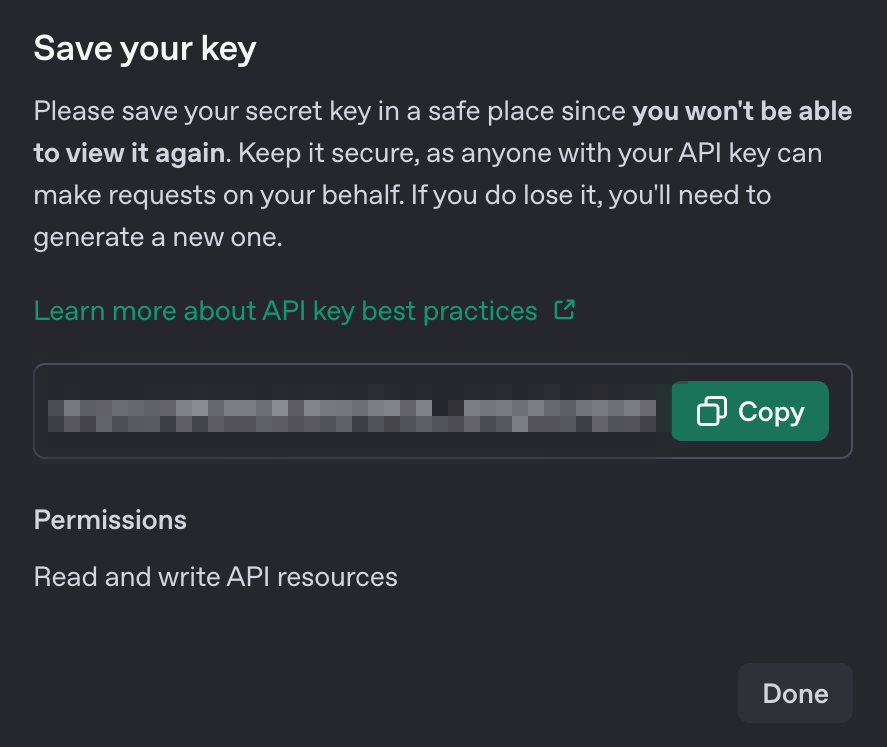
¶ CNAM Lookup
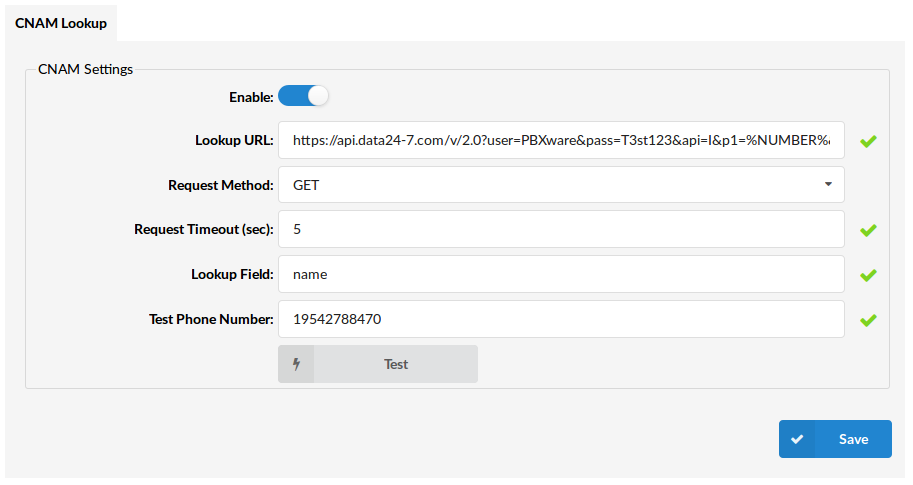
CNAM is an acronym which stands for Caller ID Name.
CNAM lookup provides the option to search and display caller name based on the CallerID.
CNAM Settings:
The following options are available and required:
- Enable - must be set to yes in order to use the service when a call comes to the system.
- Lookup URL - a valid URL given by a CNAM provider; the phone number in the URL must be replaced with “%NUMBER%”.
- Request method - preferred method for getting a response from a CNAM provider, defined by the provider itself (“get” or “post”).
- Request timeout (sec) - time limit in seconds for getting response from a CNAM provider
- Lookup field - a CNAM database field given by a provider that holds the caller data we want to display (example “name”).
- Test phone number - Any familiar number to be used for testing purposes.
A test request will be performed on every “save” and “test” action and the response will be displayed at the bottom of the CNAM settings form.
Possible CNAM lookup providers to be used:
Example of CNAM lookup link for this provider:
Example of CNAM lookup link for this provider:
Example of CNAM lookup link for this provider:
Please check with your provider to make sure that CNAM lookup link is in correct format.
¶ Configuration Files
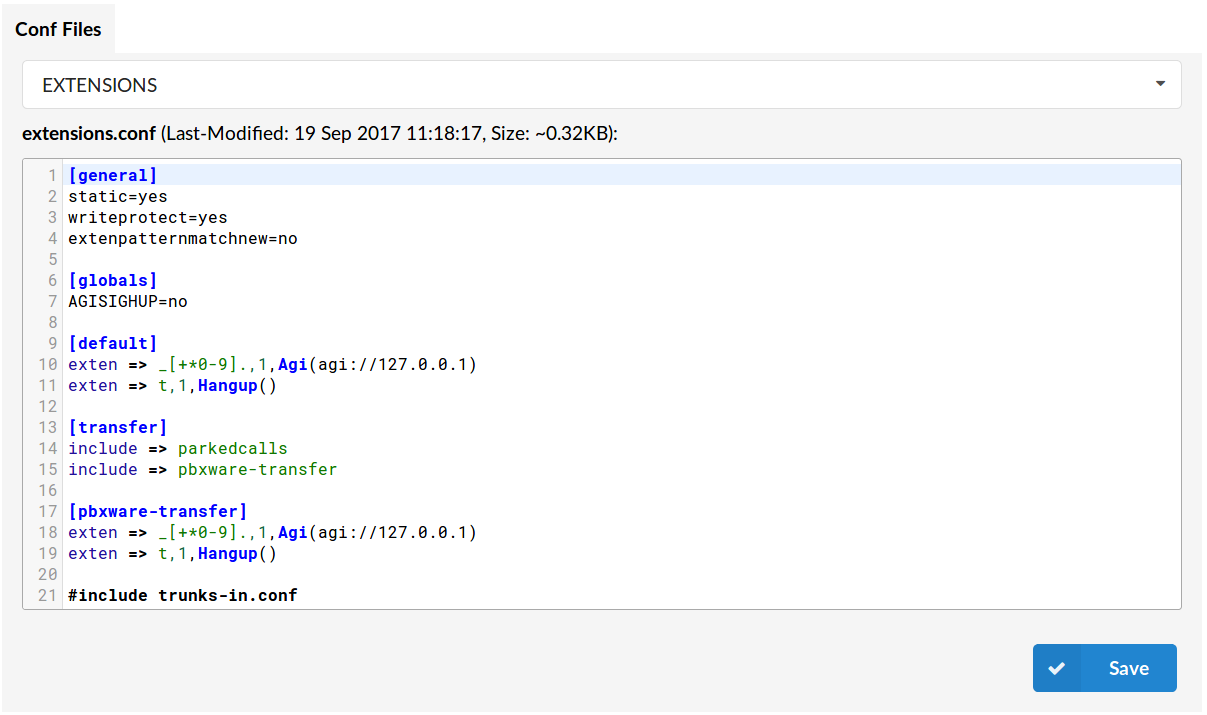
System configuration files are accessible through this section. Only trained users should modify configuration files.
First, select a configuration file from the dropdown menu. The file will open in a big text box from where it can be modified. Once the file is changed, click on the 'Save' button.
If there is a message saying 'Configuration files not updated' visible, click on the 'Import current file' or 'Import All Files' button to update the files. This error usually happens if the configuration file is changed through the system console (shell).
TIP Once any kind of file update is done, be sure to Reload PBXware to apply the changes.
E.g.: An assistant rolls calls into conference rooms and when the buttons light up on the executive phones, the executive would know the call is now in the conference room.
The config needs to be set as follows (example for CC, Conference 119):
- [default]
- exten => 119,hint,confbridge:119
¶ Notes (7.2)
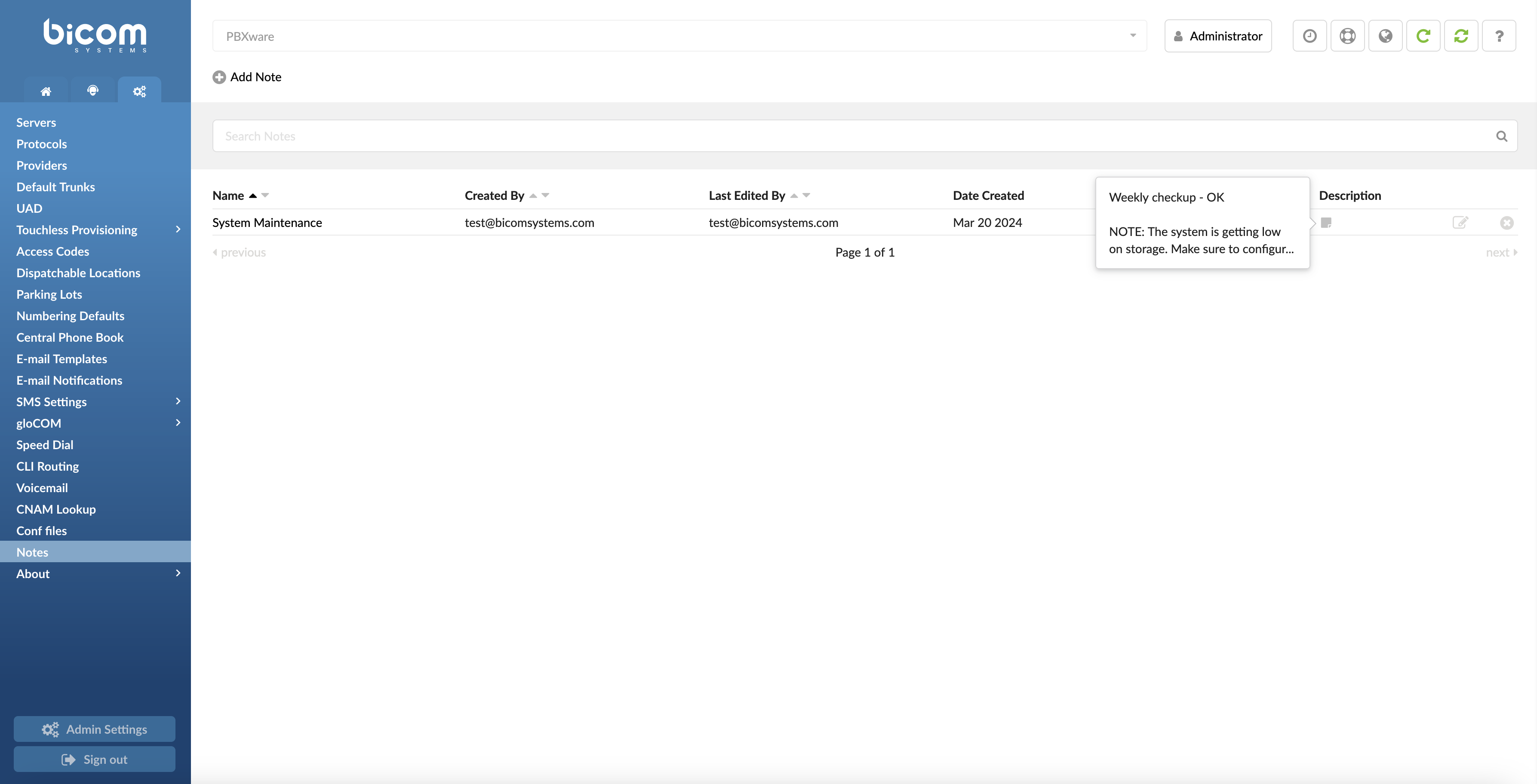
Notes section is the new feature added in PBXware version 7.2 and allows administrators to easily share notes, important information and/or short instructions related to the system maintenance with other PBXware administrators.
-
Add Note
Clicking the Add Note button will open the Add note dialog page. -
Search
Use the Search field to filter notes using note name or name of the user that created a note or was the last to edit it. -
Name
Short description of the note’s content. -
Created By
E-mail address of the administrator that created the note. -
Last Edited By
E-mail address of the administrator that last edited note. -
Date Created
The date note was created. -
Date Edited
The date note was edited last time. -
Description
Note content. When the mouse pointer is positioned over the description icon, the note content will be displayed in the popup.
NOTE: To further improve filtering the information stored in the notes section, the notes can be displayed in the ascending or descending order based by Name, Created By and Last Edited By fields. To sort the notes based by Name for example, administrator can click the black triangle icons next to the Name.
Clicking the Add Note button will open the new note creation dialog which will allow users to define the Name and the Description in the note.
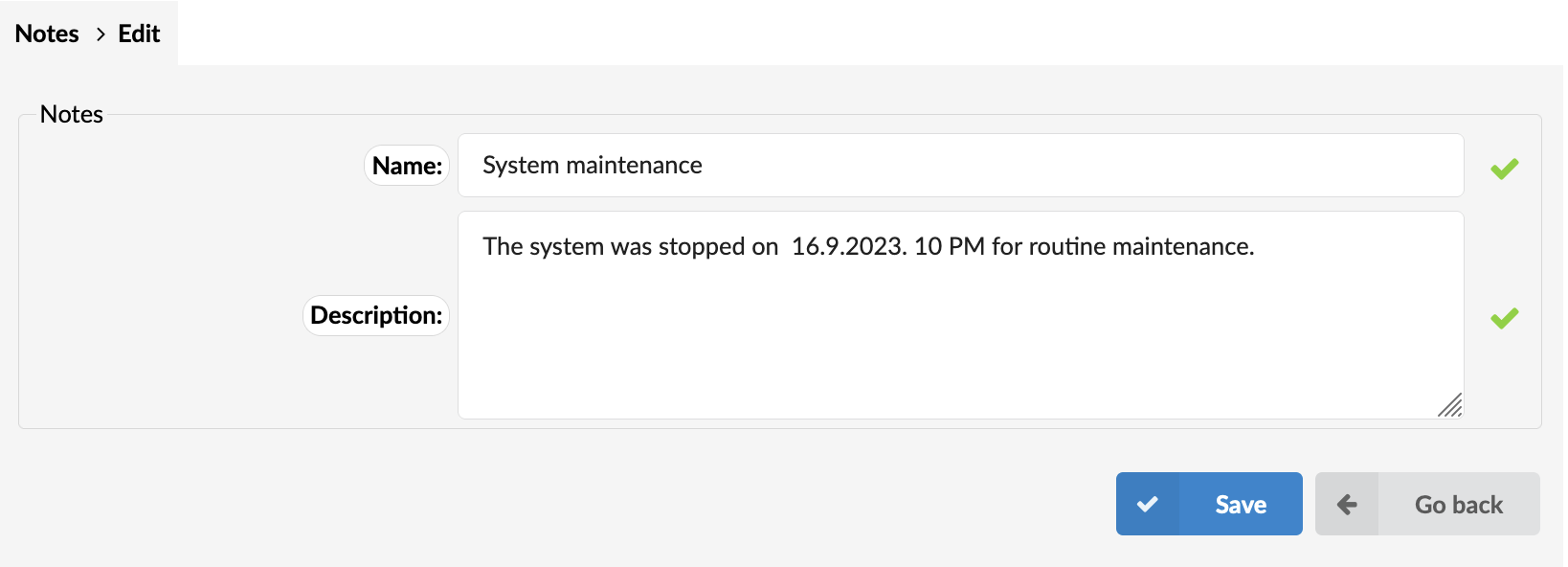
-
Name
Short description of the note’s content. -
Description
Note content that can be any type of information that needs to be shared with other PBXware administrators.
¶ About
The About section provides detailed information on the system's edition, current release versions, including other licensing and application information. For better layout, the page is divided into two separate sections:
- License
- Versions
¶ Licence
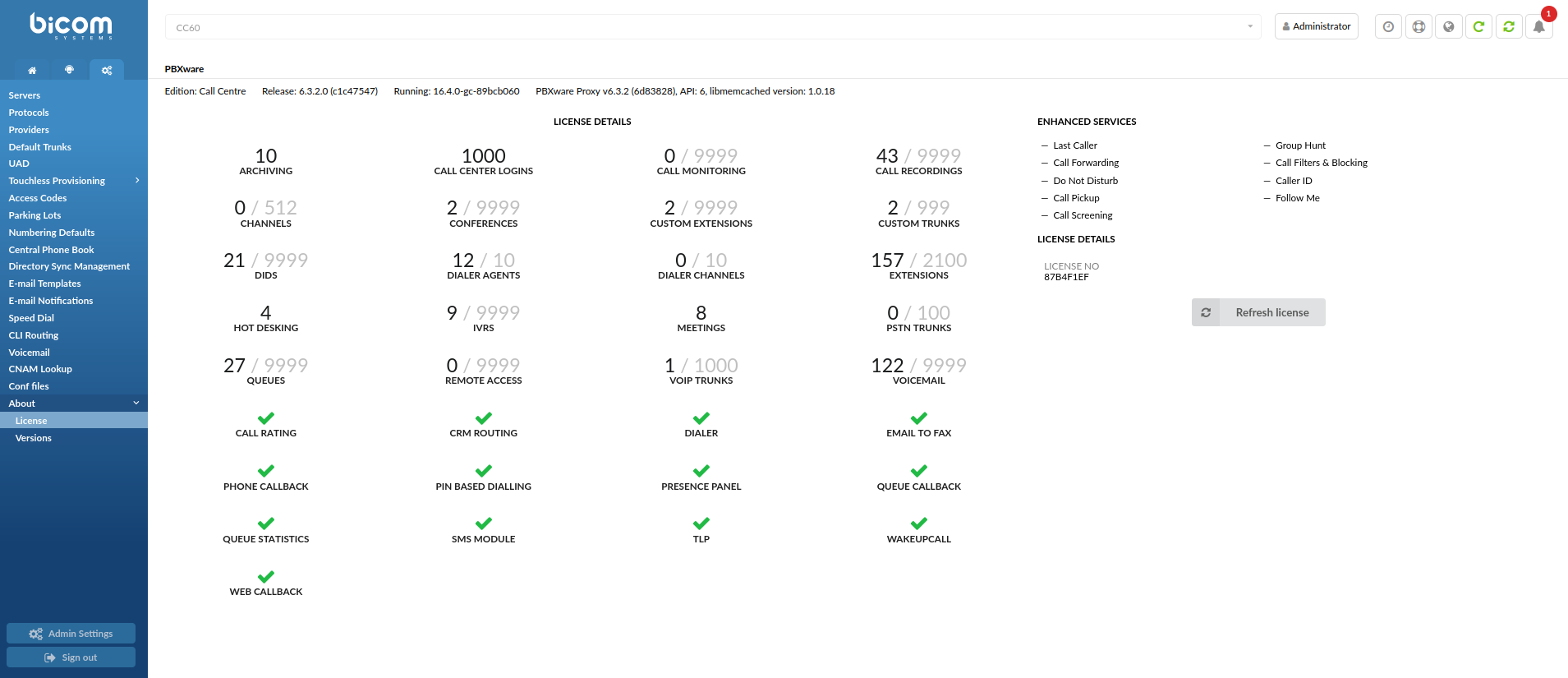
The Licence section displays the system's edition, version, Enhanced Services and licensing details.
- PBXware
This line identifies the PBXware Edition, Release, and Asterisk running.
(E.g. Edition: Call Center Release: 6.1.2.0 (d4ccf434) Running: 16.4.0-gc-11e60f76 PBXware Proxy v6.1.1 (b5e8561), API: 6, libmemcached version: 1.0.18)
(Display)
- Licence Details:
Licence details section displays all enabled features on the licence, for example:
- Channels
- DIDs
- Extensions
- Hot Desking
- Dialer Agents
- Custom Trunks
- Wakeup Call
- Meetings
- SMS Module
(E.g. 33/9999 DIDs, 10/10 Dialer Agents, 10/9999 Queues...)
(Display)
- Enhanced Services:
This section identifies the system's Enhanced Services:
(E.g. Last Caller, Group Hunt, Call Forwarding...)
(Display)
- License Details:
Displays license details.
(E.g. License No: 87B4F1EF)
(Display)
NOTE: If 'Branding' is enabled, only license number is visible.

Updates the licence information, if any.
(E.g. Click the 'Refresh licence' button to update the licence information.)
(Button)
¶ Versions
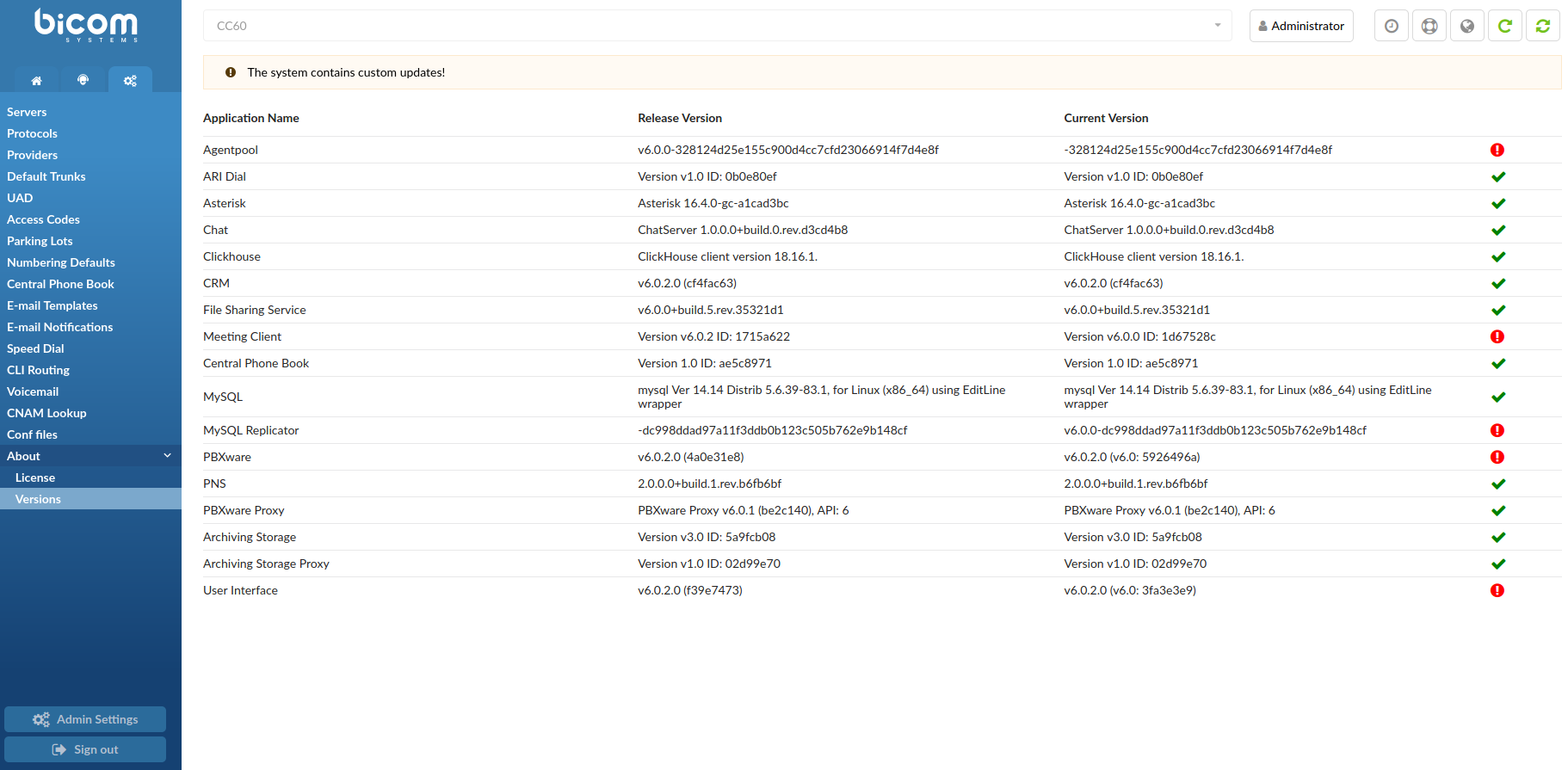
The Versions section displays information on 'Application Name', 'Release Version', and 'Current Version'. By having this layout, users may detect if an application version is different from the release version, which would indicate that the application has custom changes on the system.
- Application Name
Displays the name of the application.
(E.g. ARI Dial)
(Display)
- Release Version
Displays the release version of the specified application.
(E.g. Version v1.0 ID: 0b0e80ef)
(Display)
- Current Version
Displays the current version of the specified application on the system.
(E.g. Version v1.0 ID: 0b0e80ef)
(Display)
 When the check mark is shown, it implies that the Release Version and Current Version are the same .
When the check mark is shown, it implies that the Release Version and Current Version are the same .
(E.g. 'ARI Dial' -> Release Version: Version v1.0 ID: 0b0e80ef & Current Version: Version v1.0 ID: 0b0e80ef)
(Display)
![]() When the exclamation icon is shown, it implies that the Release Version and Current Version are not the same.
When the exclamation icon is shown, it implies that the Release Version and Current Version are not the same.
(E.g. 'Meeting Client' -> Release Version: Version v6.0.2 ID: 1715a622 & Current Version: Version v6.0.0 ID: 1d67528c).
(Display)

NOTE: Apart from the exclamation icon being shown, there is a message displayed at the top of the page, saying: "The system contains custom updates!". This enables users to check whether there are any custom codes on his/her system.